This was the return flight for a very unusual trip, the Shikoku 88 Temples Pilgrimage which I present in the bonuses of this FR and that of the incoming flight:
CDG – KIX: AF292 (B777-200ER) Economy upgraded to Business – it’s there
KIX – CDG: AF291 (B777-200ER) Eco – you are here
(The length of this FR is very unusual, too. You have been warned!)
I had used only one of my spare days for use in case of trouble, for bad weather reason, and after spending two days with my Japanese friends in Osaka, it was time to consider flying back to Paris. My FB award ticket was modifiable for a very modes 45 EUR fee, but AF did not seem to be aware of that.
Ce tarif ne vous permet pas de modifier vos vols = "This fare does not allow you to modify your flights".
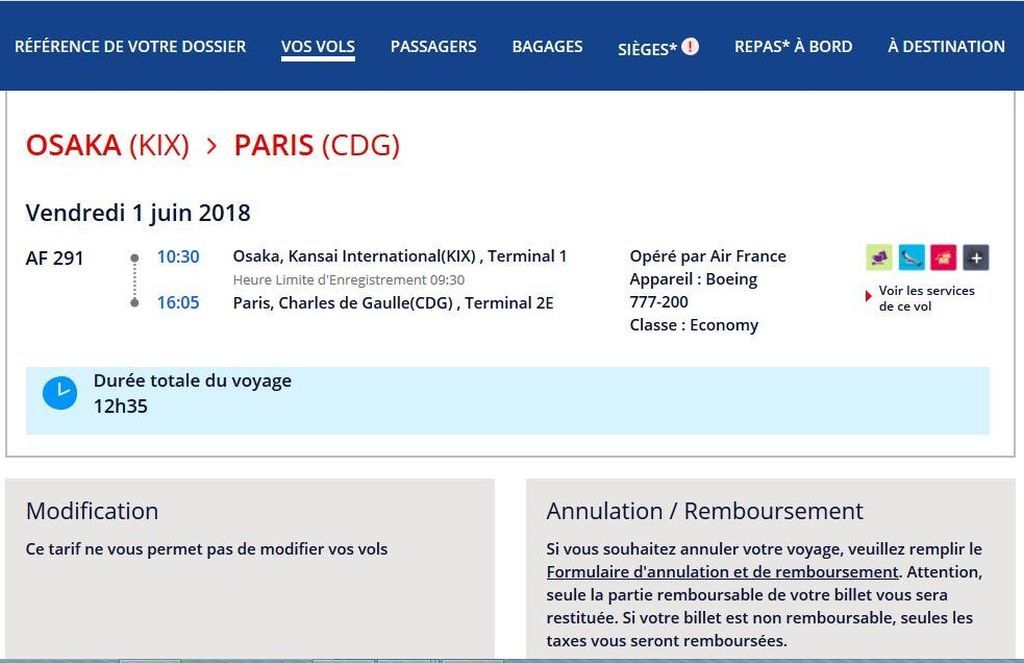
I only needed to call AF’s hotline, which transferred me to FB’s hotline, where an operator had no objections to my request. The flight on 31 May was full, but there were seats on 30 May. After a standard authentication dialogue, the change was done efficiently and politely, and since I was already at STD-15h, I checked in on line immediately thereafter. Spend “upwards from” 319 EUR or 53,200 miles to travel in Premium Economy? No, thanks.

Of course, when you change your flight the day before, no matter your Elite status, the duo seats are already reserved but I nevertheless considered myself to be lucky: there were four window seats left, including two not overwing. They would have adverse lighting conditions during most of the flight, but that would also be above Siberia where there are few noteworthy features.
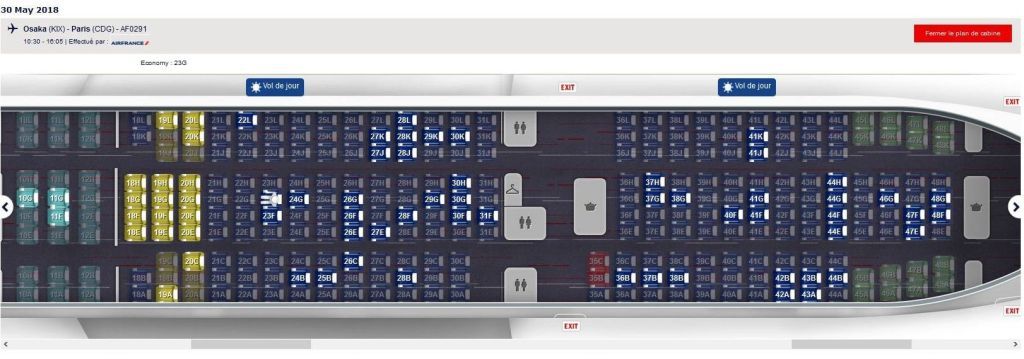
Seats 43A and 42A also provided hope for an empty middle seat, and I chose 43A. Unlike on the way in, being in the front rows of the Economy cabins did not have much value to me: my European passport would let me through immigration reasonably fast in CDG and I had no time constraint upon arrival: I did not consider the “Plus seats” in yellow which would have been for free due to my FB-Platinum status, but were overwing which would preclude taking pictures of the landscape.

It was a week day: the friend who had hosted me for my last night in Japan could not drive me to the airport, which I reached in a more conventional way by a regular train for a modest 1,190 JPY fare, which was cheaper and more comfortable than the RER-B trains serving CDG on half the distance. There were evidently mostly airport staff on board – there are faster, even more comfortable but more expensive through trains. Train punctuality can be taken for granted in Japan and I reached KIX at STD-3h as planned because I wanted to enjoy the lounge, knowing that my Flying Blue Elite+ would not be forever. There was zero waiting at the Skypriority check in counters, which was no surprise that early before the flight.
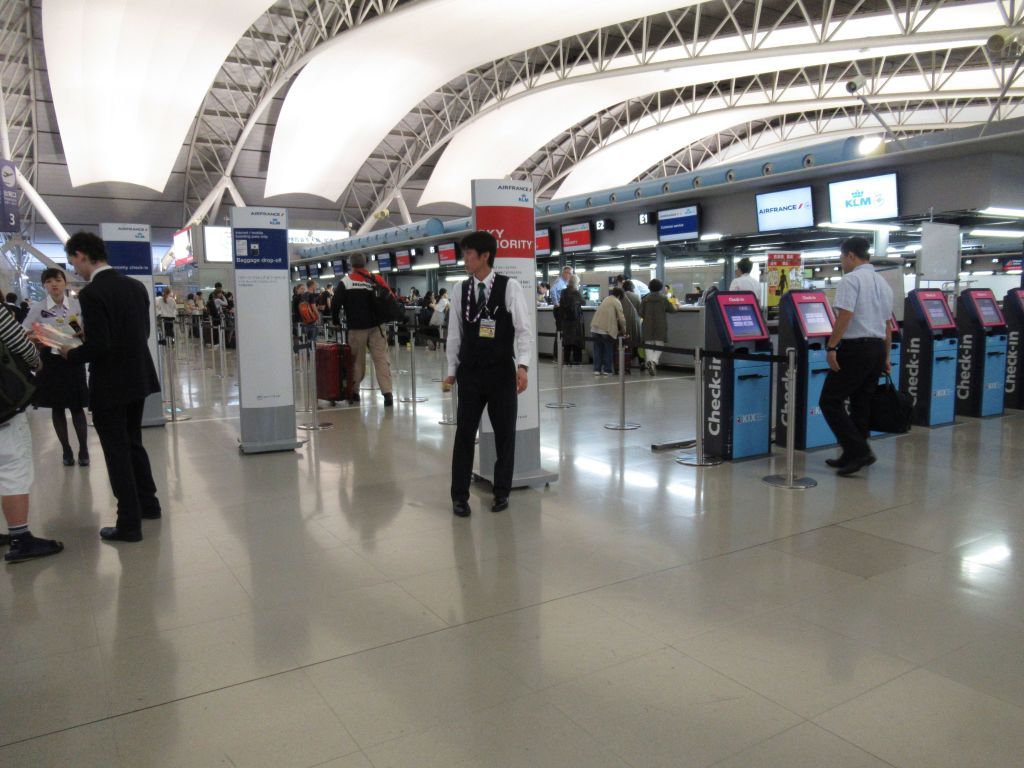
Among other Flying Blue Elite+ perk useful for this flight was an additional piece of checked luggage, which was an unusual one: my pilgrim’s walking stick which I would have been sorry to be forced to abandon, or pay a fee worth several times its price.
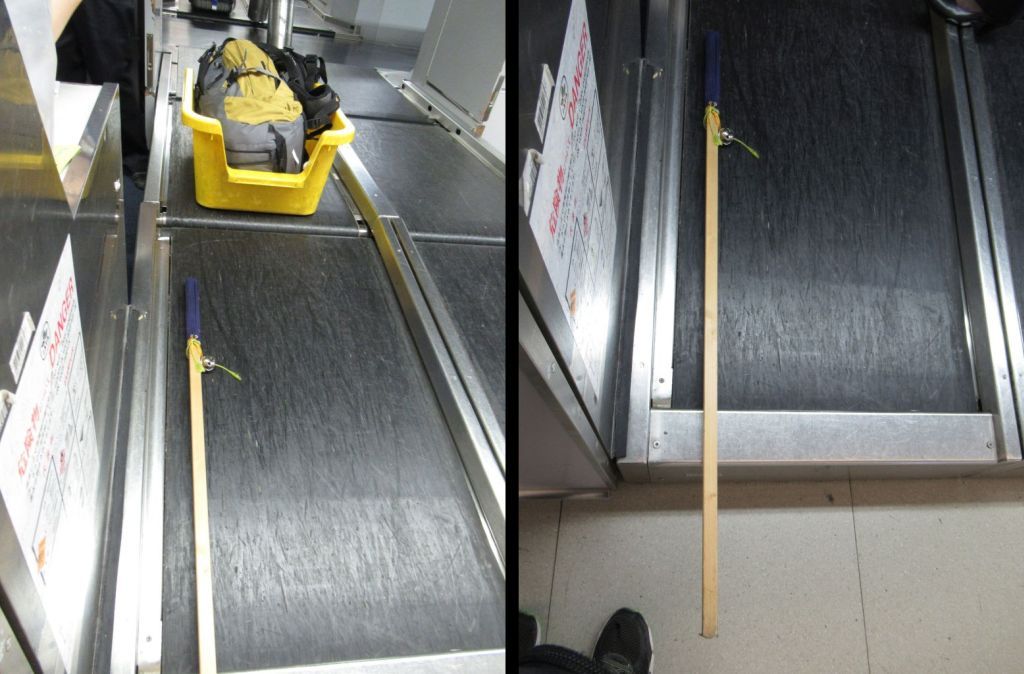
Contrary to my expectations, this checked luggage of unusual dimensions was not alone on this flight: another pilgrim connecting onward to MRS had already checked in, and the check-in staff affixed the luggage tag the same way.
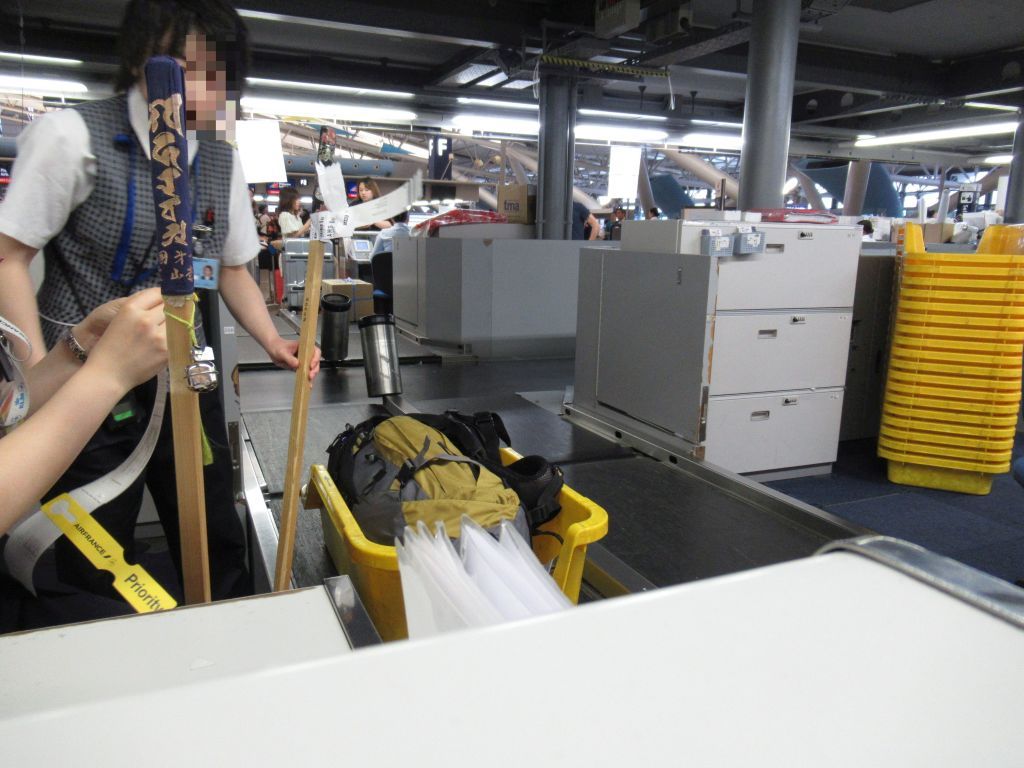
I hadn’t had any technical problem carrying a walking stick on a 1,200 km distance, especially since its weight was actually much less than one kilo.
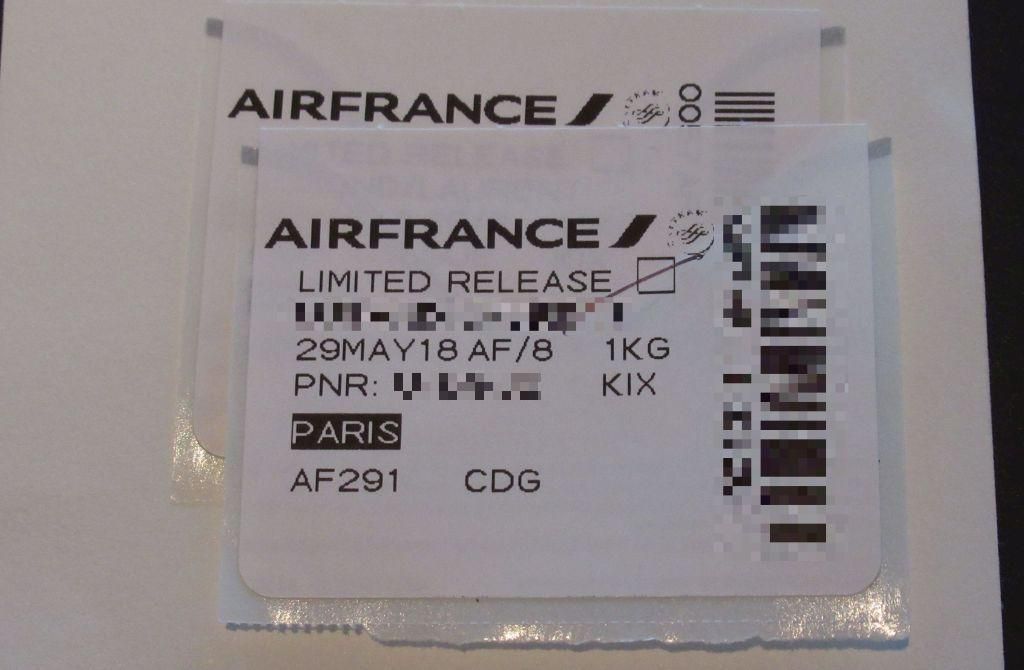
On the other hand, AF wasn’t sure about its ability in this regard: after assuring me that it would be taken great car of, the staff had me sign the responsibility waver on the back of the luggage tag.
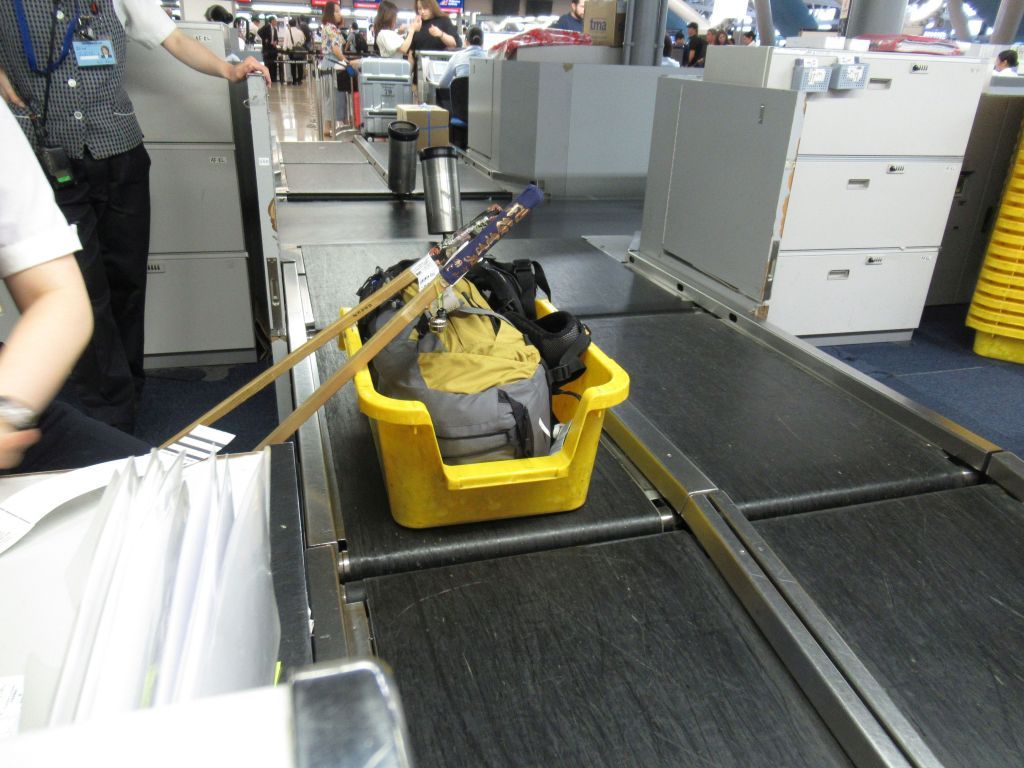
Note that AF could have countered that my own handling of my walking stick had been severe. See the difference of length between mine on the left and a new one in the same shop where I had bought it six weeks earlier: both my shoe soles and my walking stick’s end suffered from the two million steps recorded by my cell phone!

Overall, thirteen minutes after leaving the train, I was without luggage too heavy or too long to be carried on board and facing a dilemma: which security check would be fastest? The “Not busy” one, or the “less busy” one? I chose the former, and even though the latter was maybe actually “Less busy than Not busy”, it was a welcome change from my Flight AF291 six months earlier when we had entered the terminal an hour later (there had been an incredible waiting line which was more like those in an amusement park in peak season).
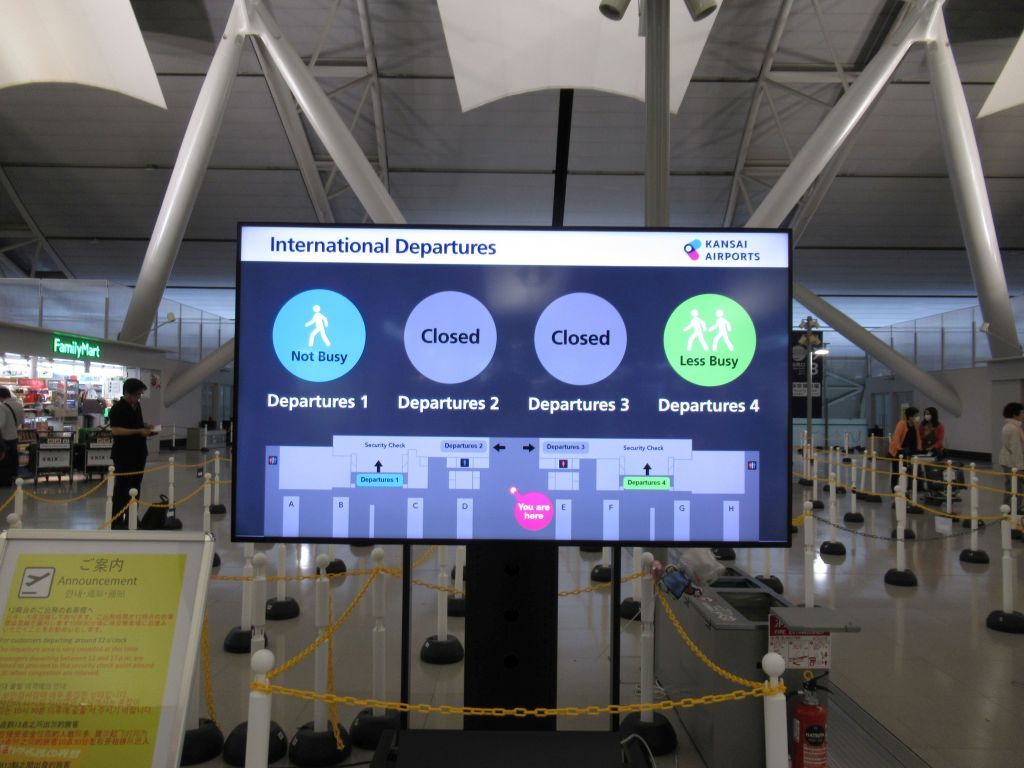
I was airside in precisely 9 minutes this time.
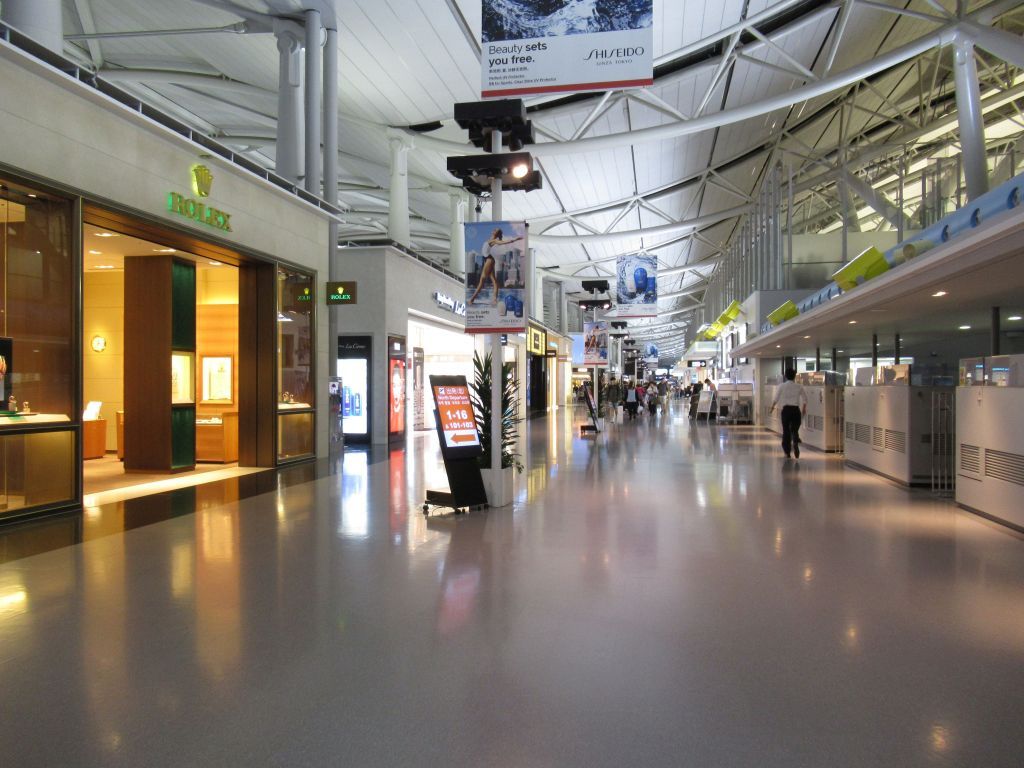
The lounge used by Skyteam airlines (« Airside Lounge »: and accurate but not very creative name) is just before the people mover serving the south wing’s international flights. It is a minor inconvenience because it is a short way of predictable duration: the situation is unrelated to that of a landside lounge.
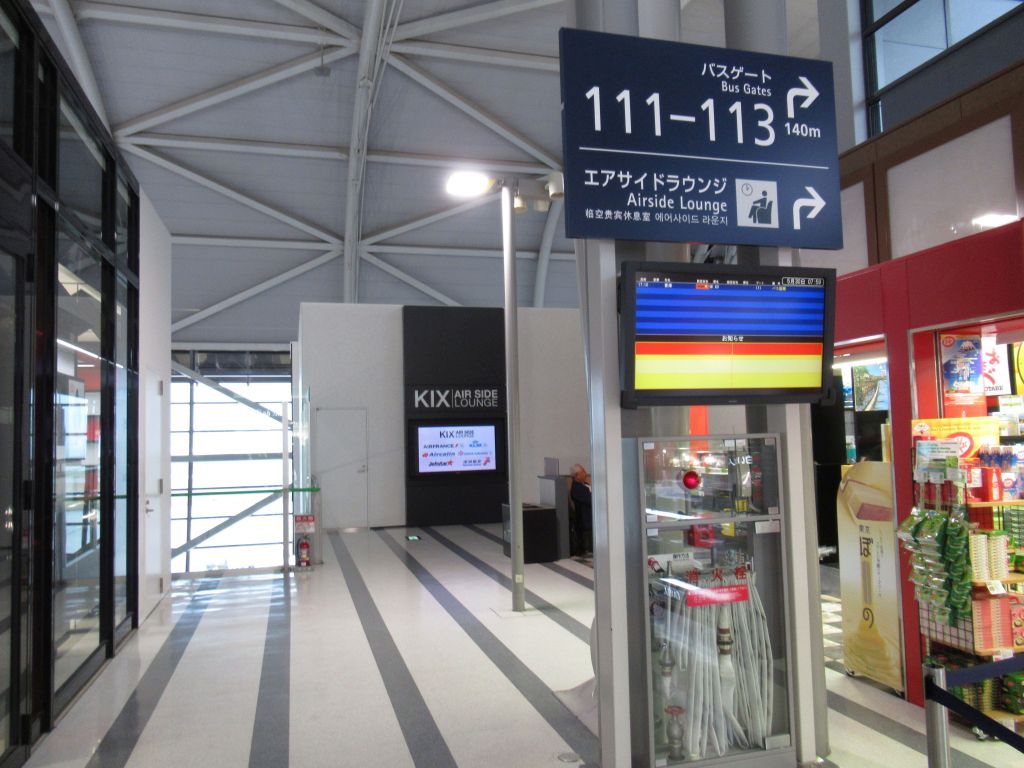
I had a very old memory of another windowless and crowded lounge in KIX: this one was not huge, but alongside windows overlooking the apron and one of the runways.

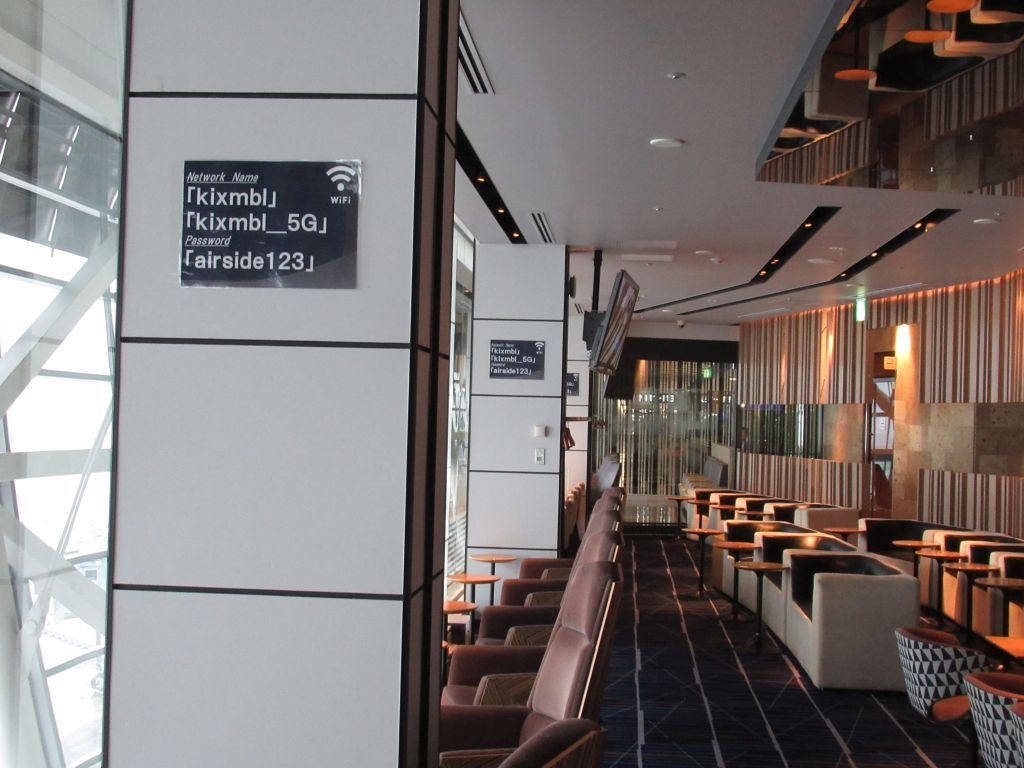
The lounge ends on the far side with a full height mirror which enlarges the visual space.
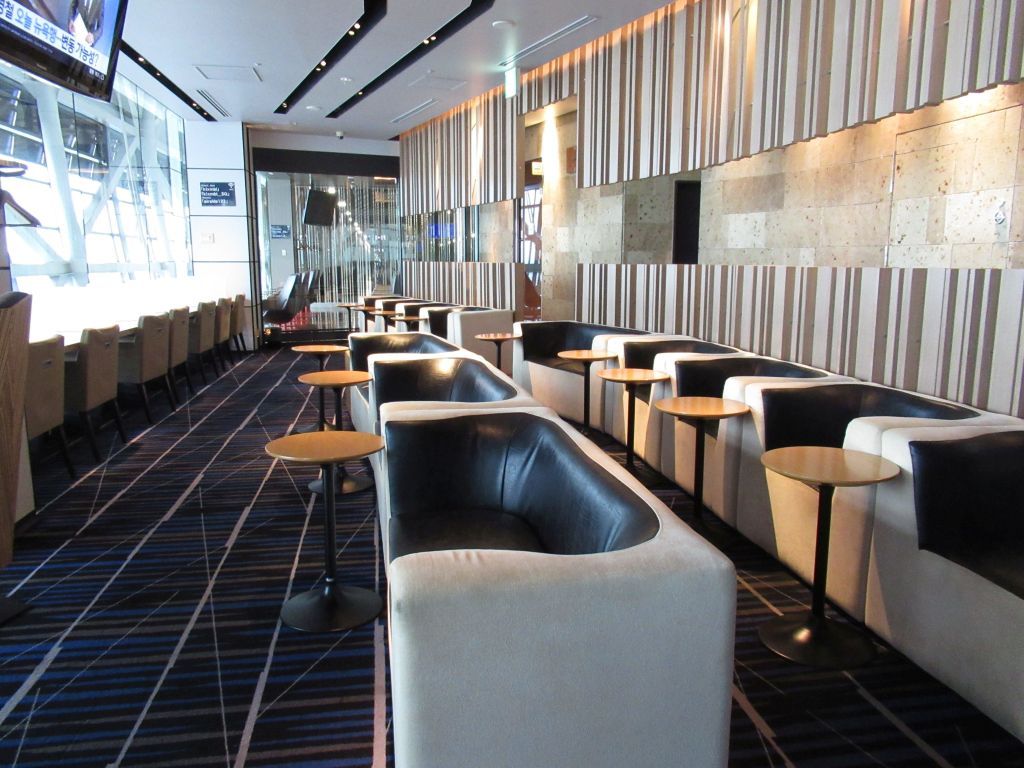
The toilets were on the opposite side and all the cleaner that the lounge was then quasi empty: only one couple had arrived before me. (Passengers kept arriving before boarding time: the lounge did not become crowded but all the most desirable seats from my perspective were eventually taken)
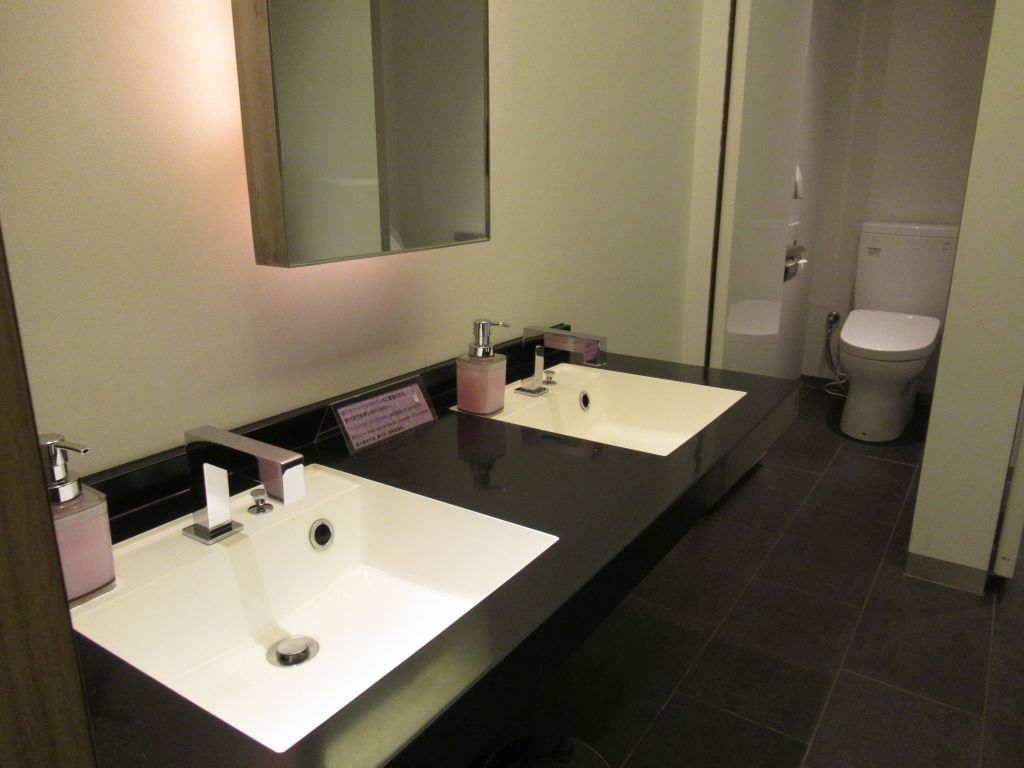
If by the end of your visit in Japan, you have not yet understood how the Japanese toilets work, it is too late: the remote controls are in Japanese only, with especially cryptic pictograms.
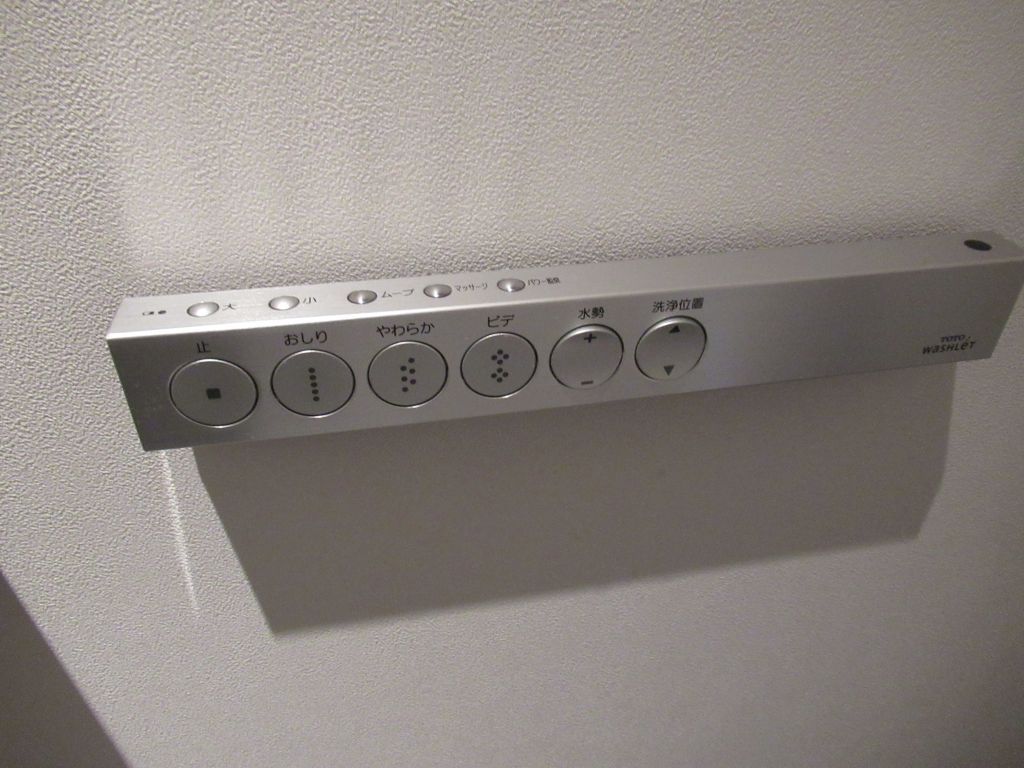
There are showers and since I was among the first passengers in the lounge, the waiting time was probably nil, but I did not feel the need to take one. On the other hand, I requested and obtained a tooth brushing kit which was available upon request.
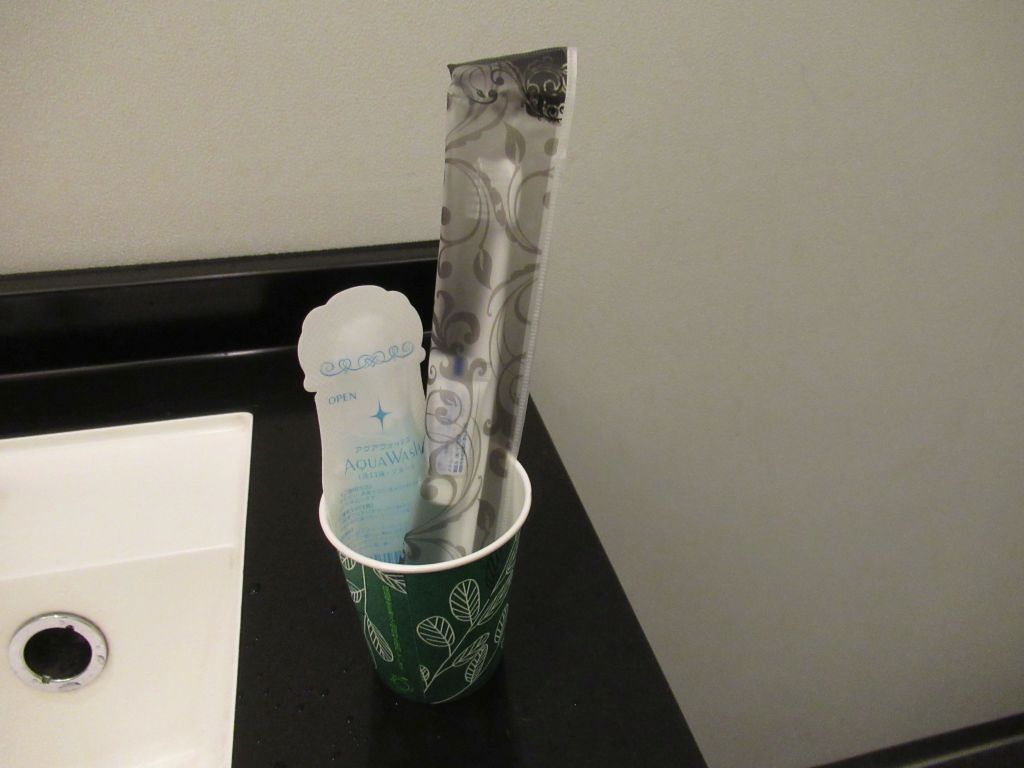
There was a reasonably linguistically diverse selection of newspapers and magazines. I did not take a picture of the ones with ideograms, but there was a good supply too.
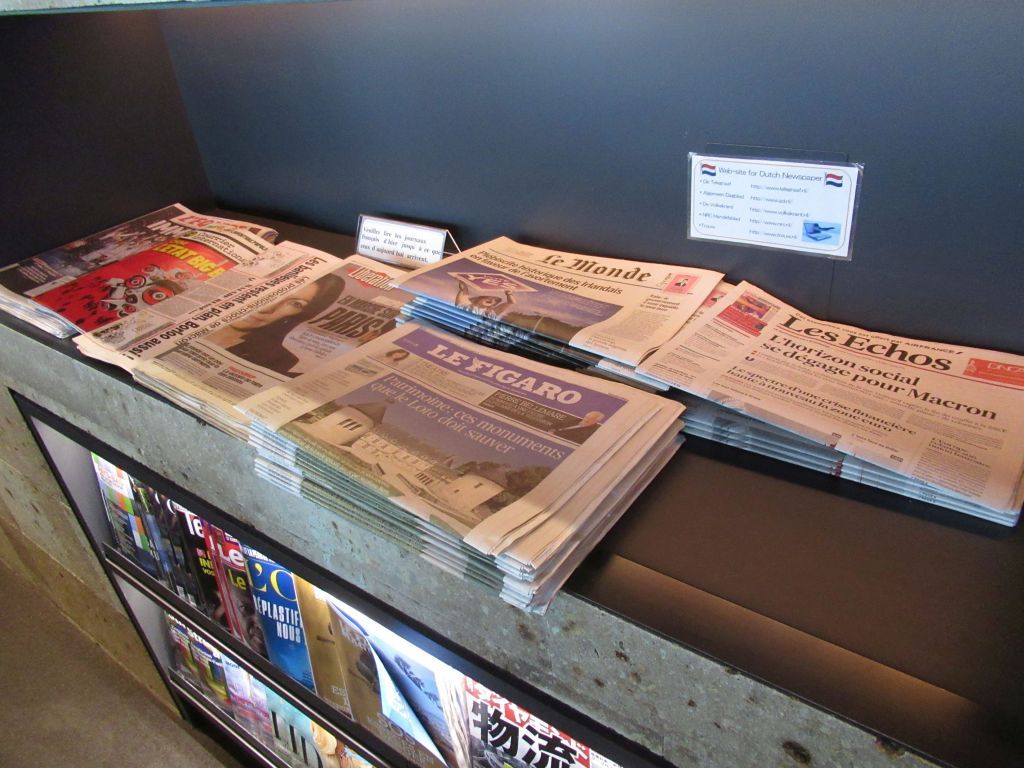
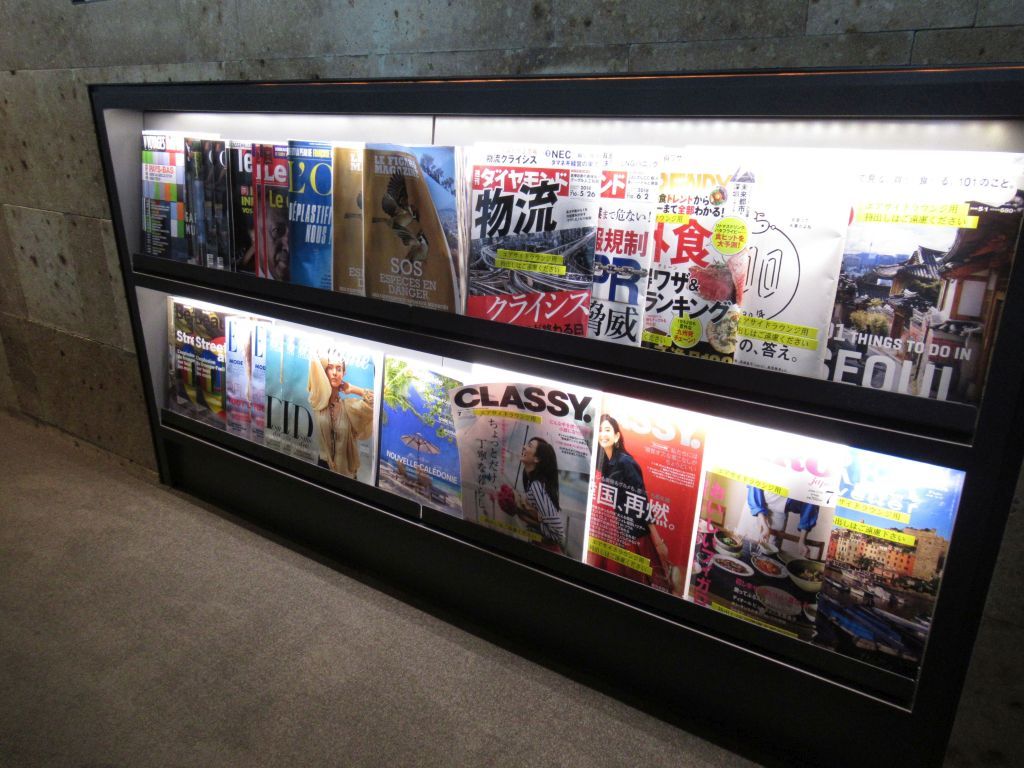
The catering was better than in the lounge of a Japanese airline at home, and less than what you would often get in Europe. (Lounges in the US do not even try to enter the competition.)
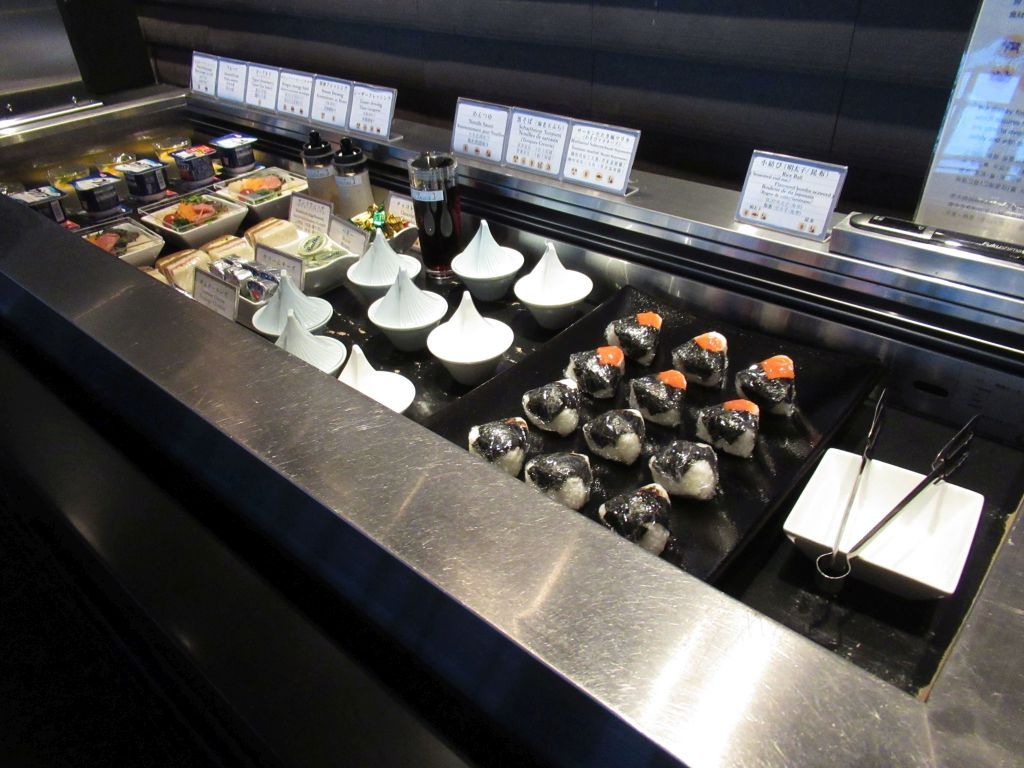
Fail for these chicken skewers, not for taste reasons
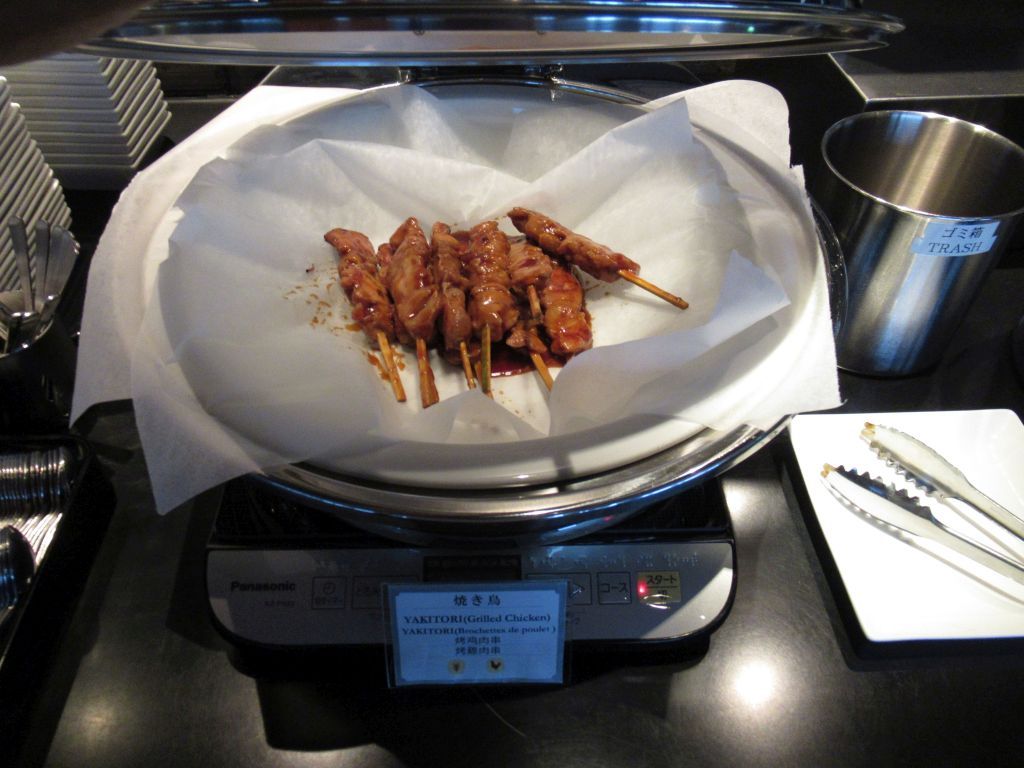
But because the end of the skewers was covered with sauce, requiring tissue to wipe your fingers after eating them.
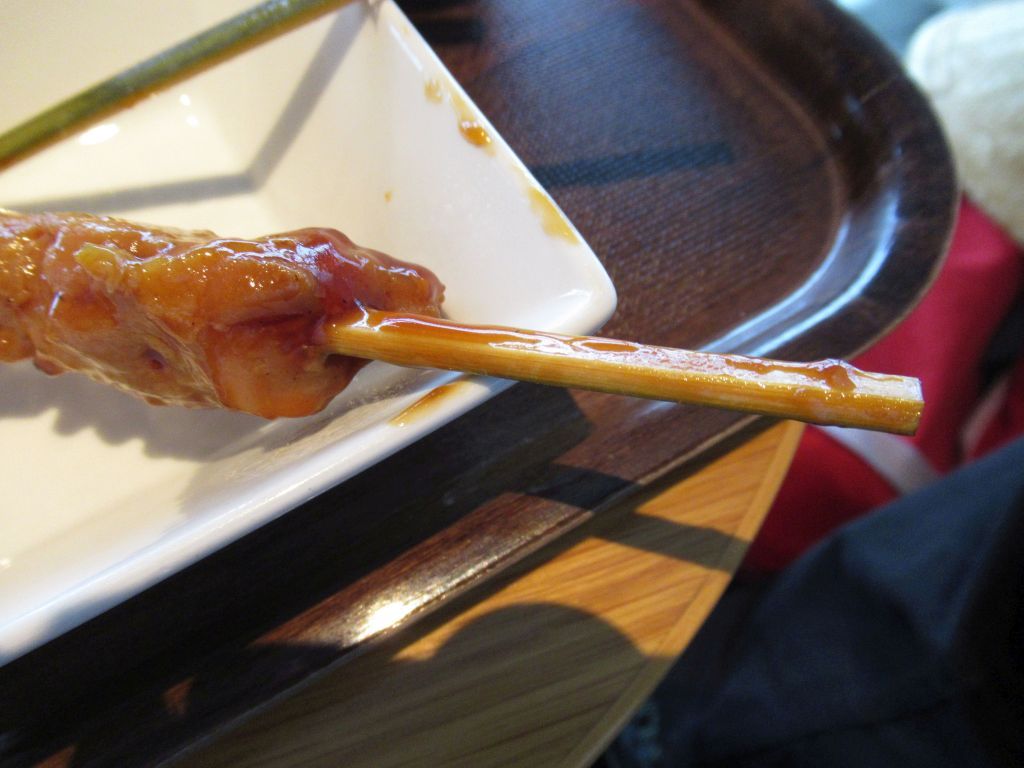
No need to lift for you the lid of the onion soup
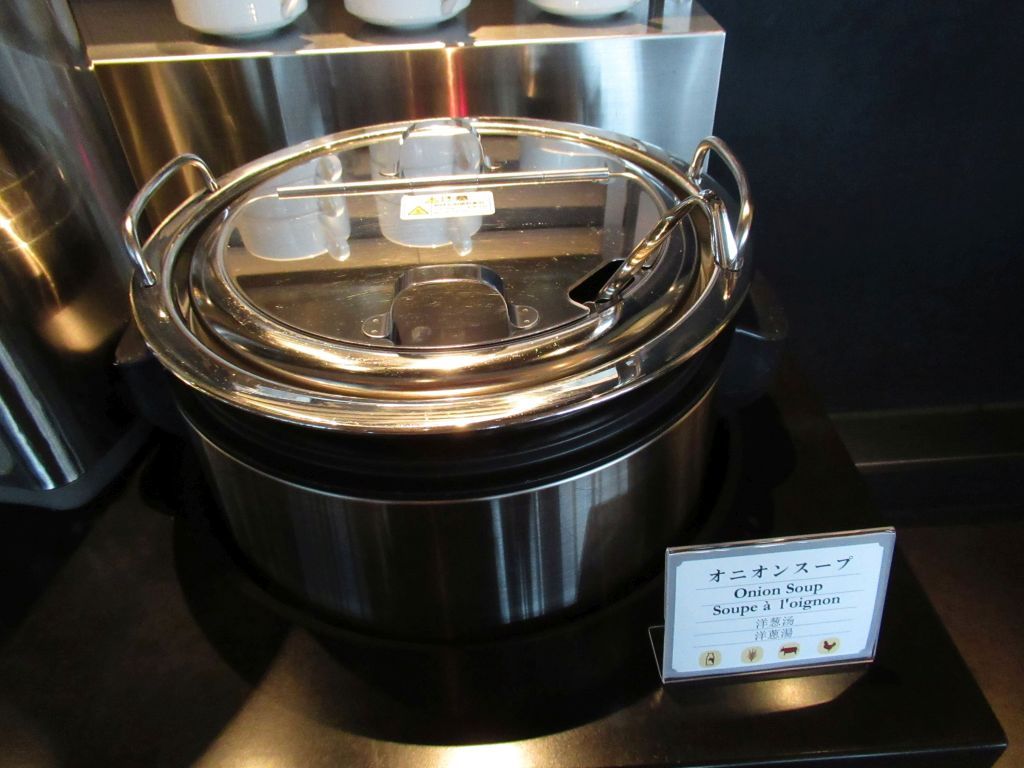
Salmon flavored Japanese risotto. « Do not take out from the lounge » was written in Japanese only: because only they would break this kind of rule, or because no European would be interested by them?
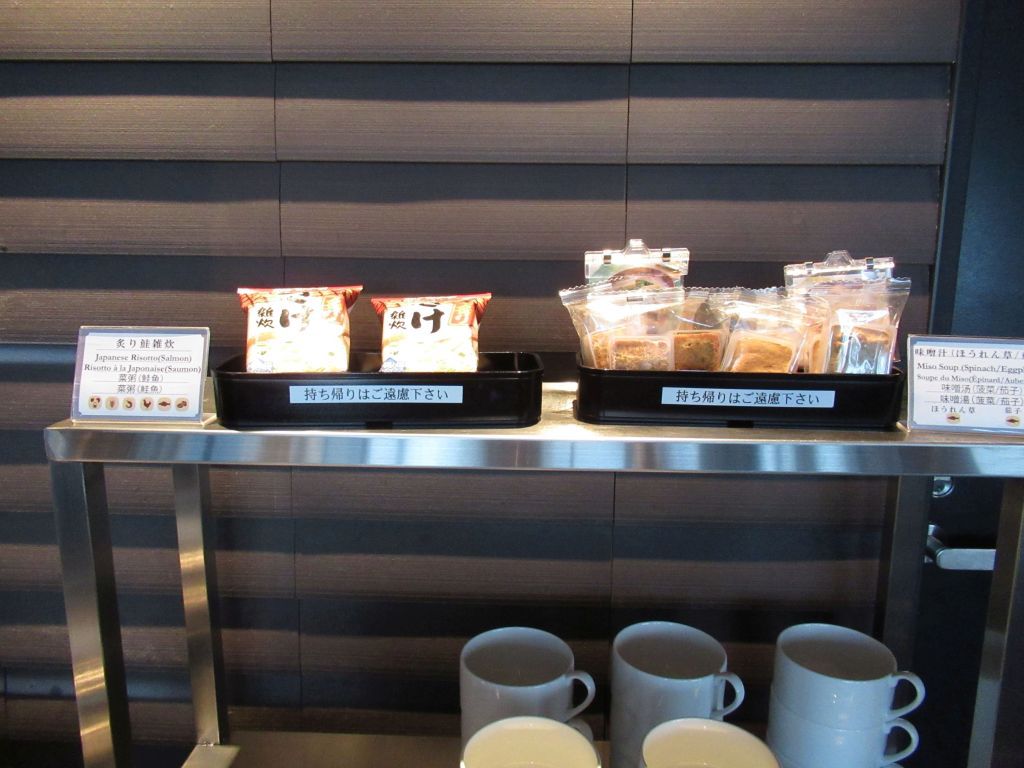
Very small onigiri
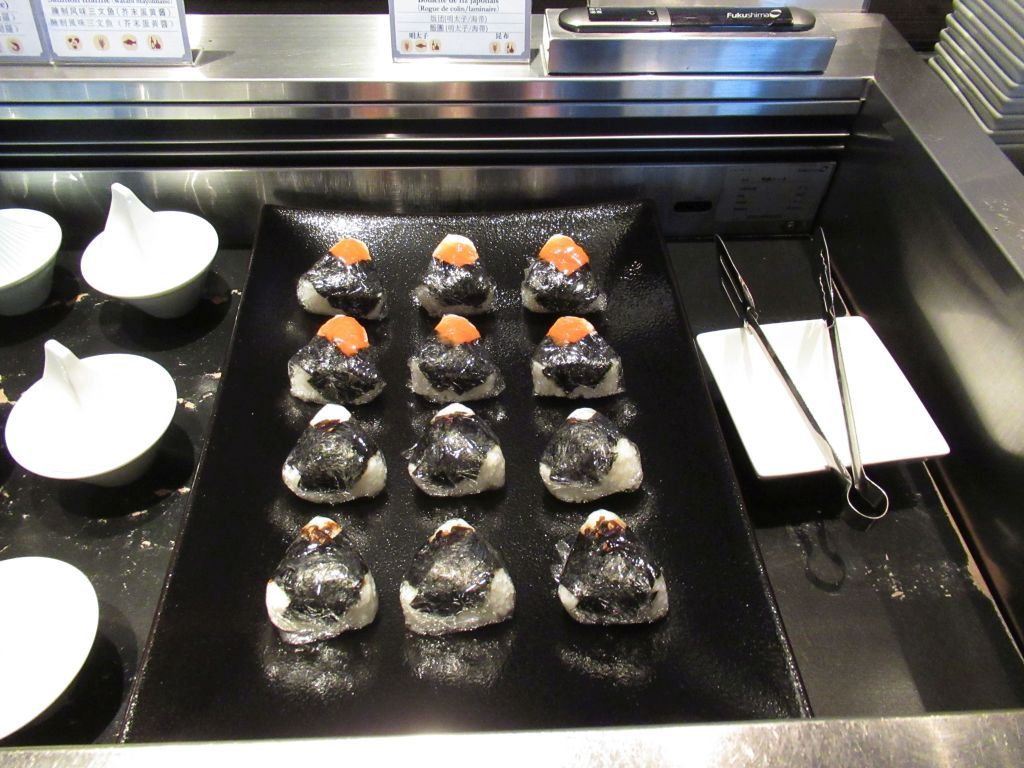
These bowls with quasi-conical covers contained micro-portions of soup (hot water to be added)
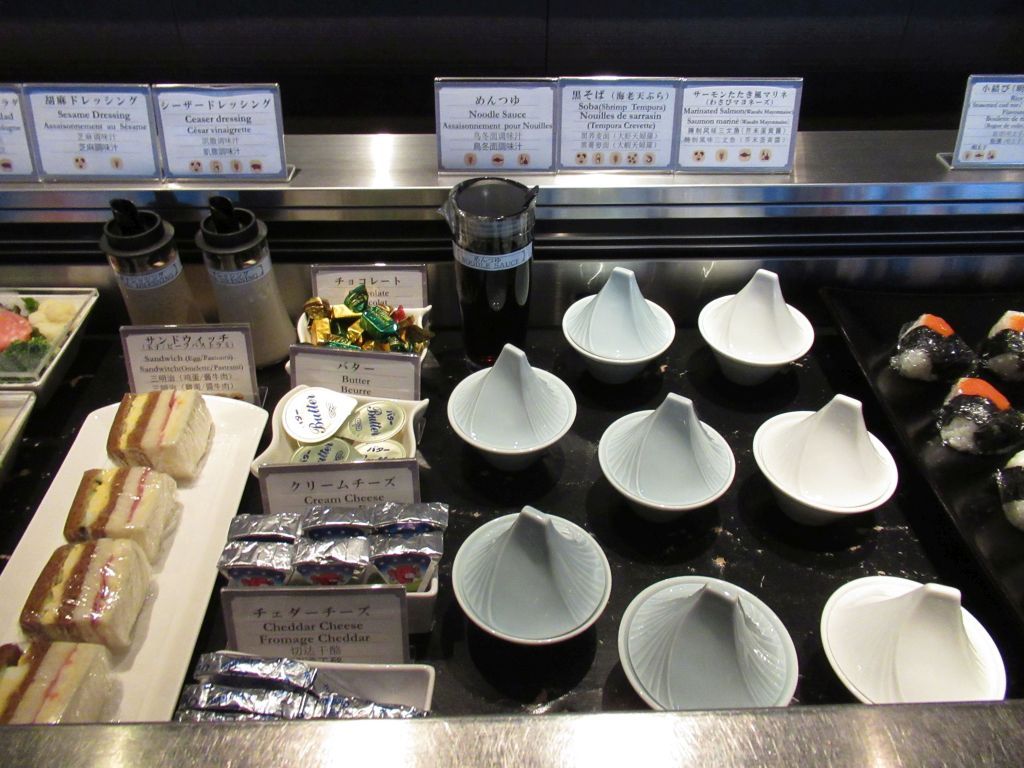
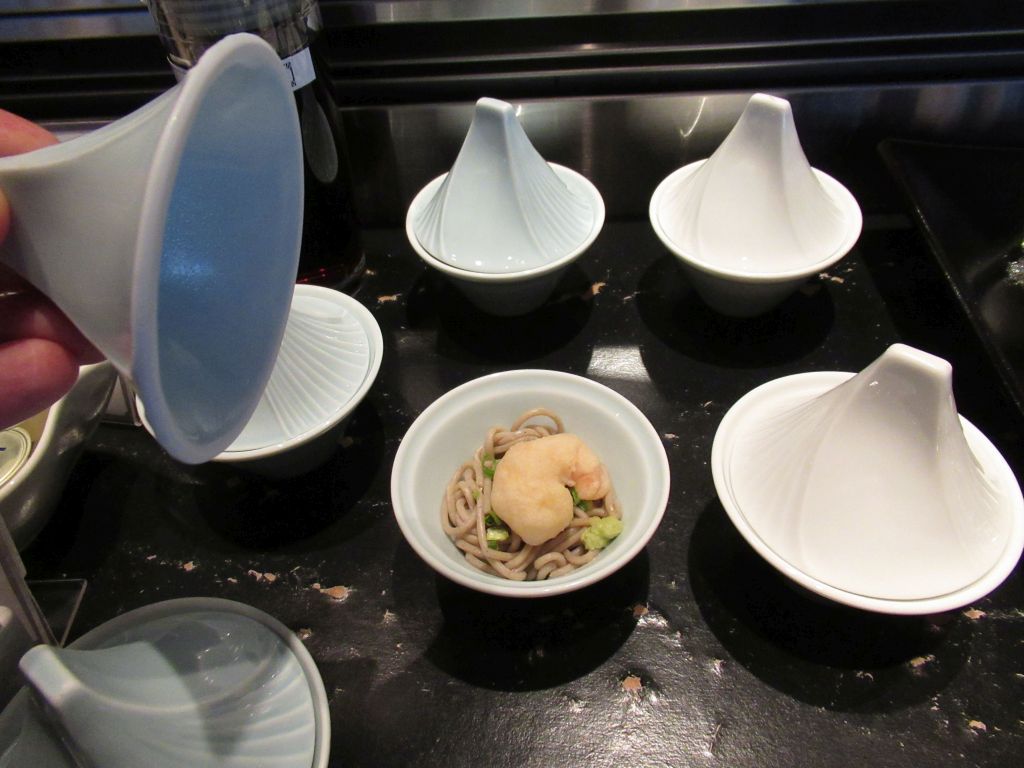
The dessert offering was minimal.
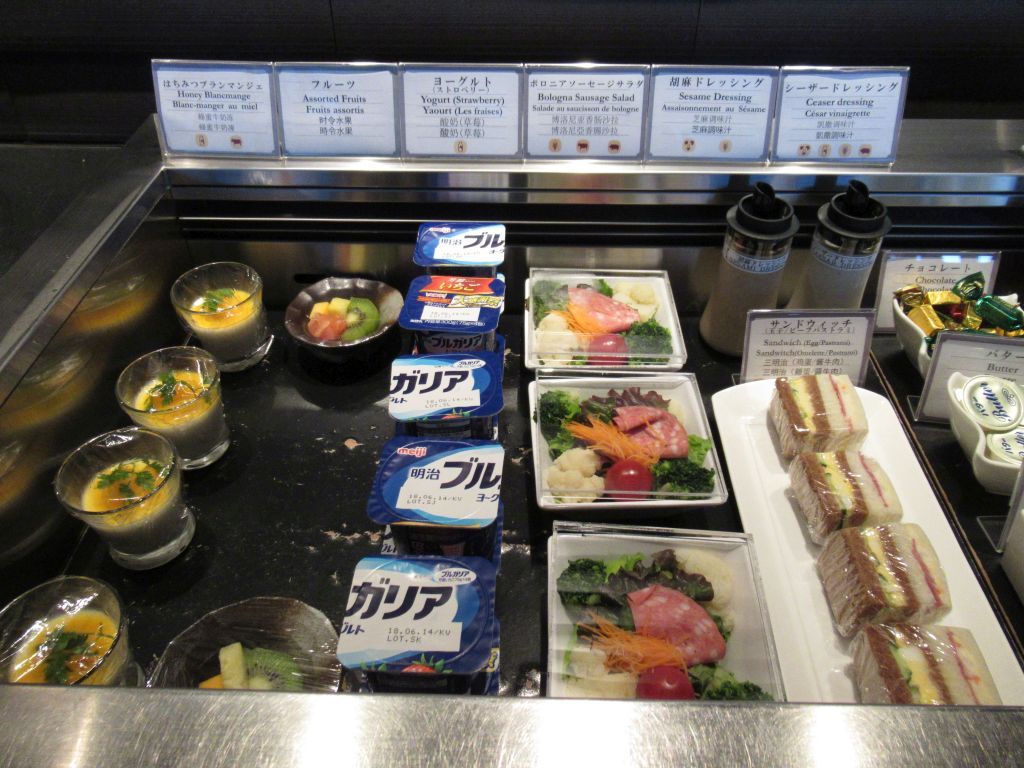
A staff resupplying the buffet politely asked me if I wanted seasoning in my salad . Good reaction from her: I had not paid attention to the fact that it was provided separately.

With regards to drinks, apart from the standard coffee and tea offering, there was milk and fruit juice.
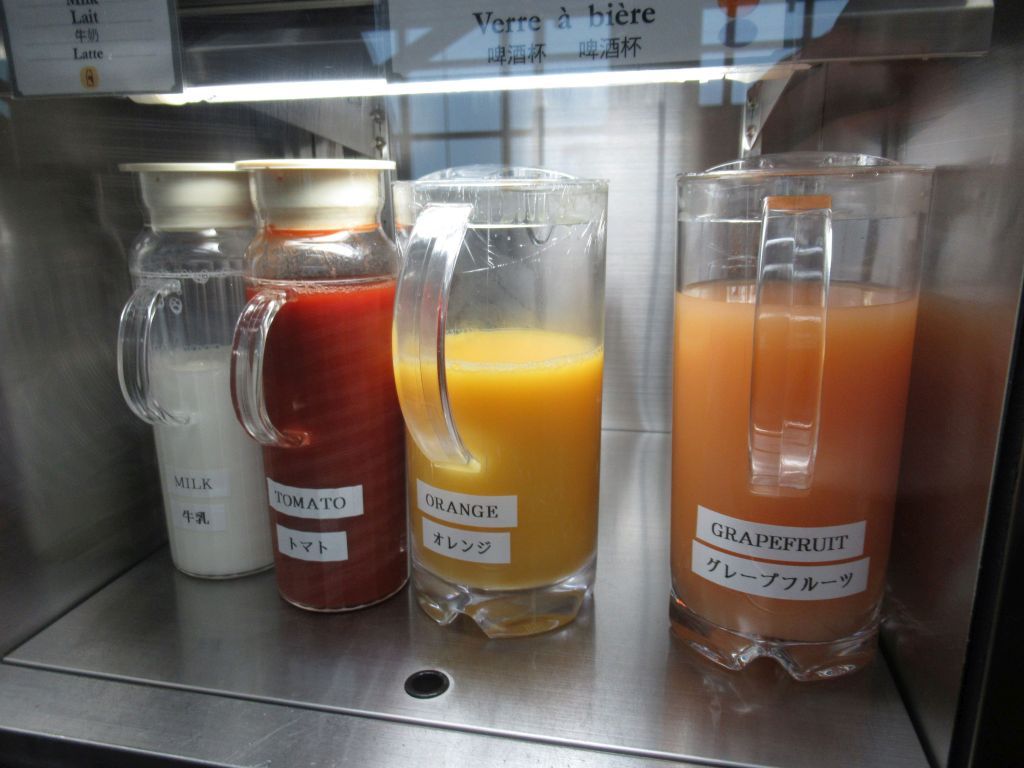
I’m no expert and let readers comment on these alcoholic drinks.
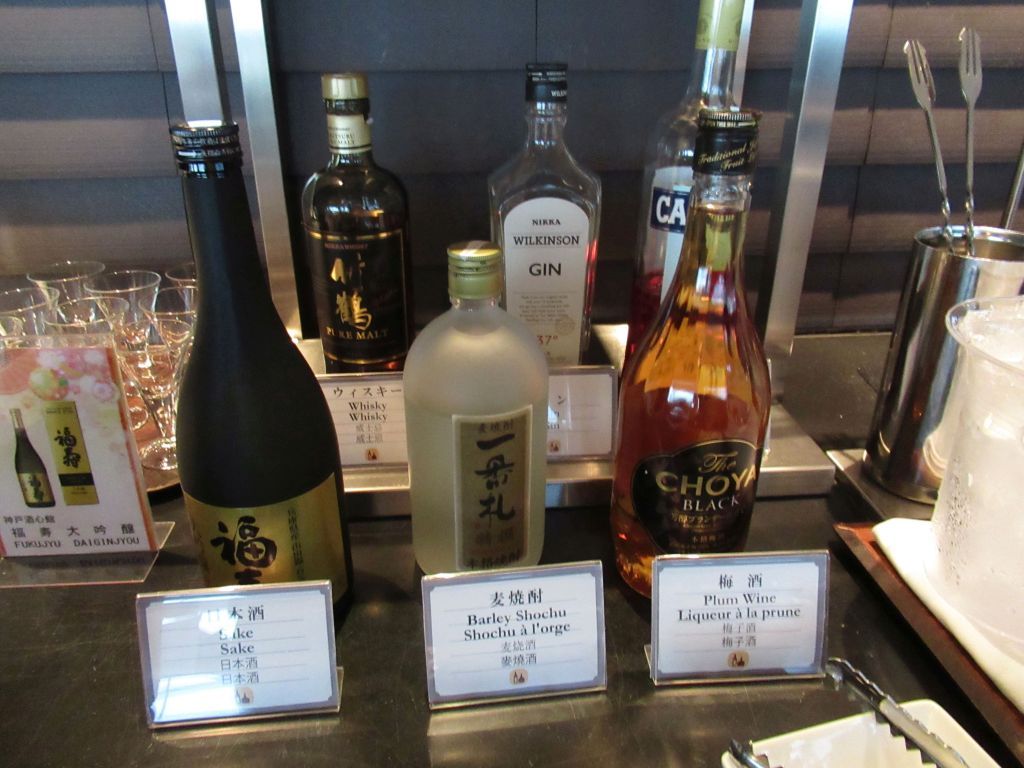
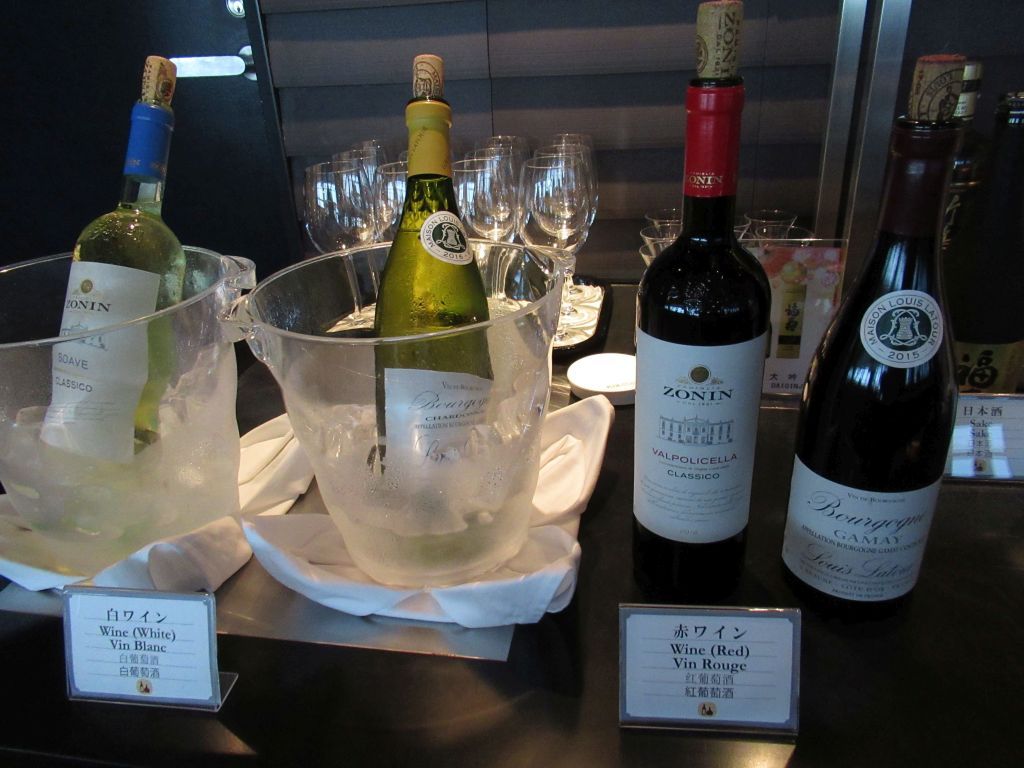
This was my choice.
(I had asked my friend to not bother waking up earlier and prepare any breakfast for me. Driving me to the station was already kind enough from her – she had been adamant to spare me “walking all the way to the station with my heavy backpack”… the same that I had been carrying on a 1,200 km pilgrimage route !

After a late-ish breakfast, after obtaining internet access without any cumbersome registration process, and still protected by Kōbō Daishi because my pilgrim’s hat reminded that he was still with me (同行二人: we are two on the same way)…
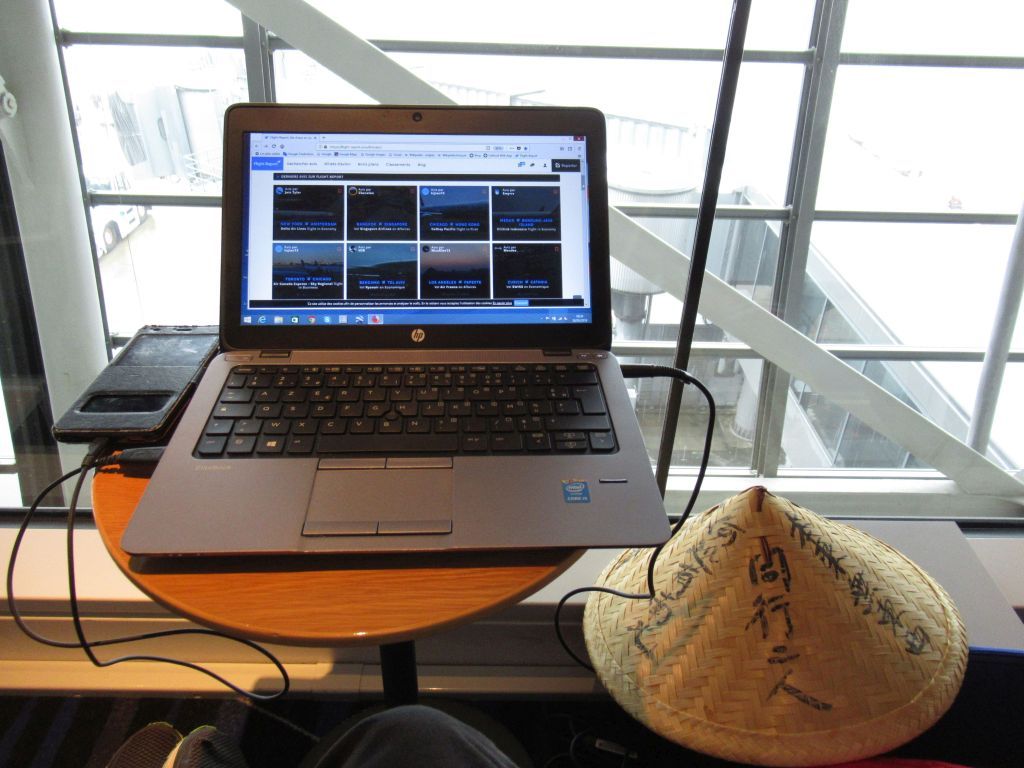
… time had come for same plane-spotting through the windows. The awful weather was not going to make me regret having cancelled two days of tourism in Kansai to have two more days with my wife. It was next to impossible to have decent pictures of planes taking off from the runway in the background.
Garuda A330-300 (PK-GPU)
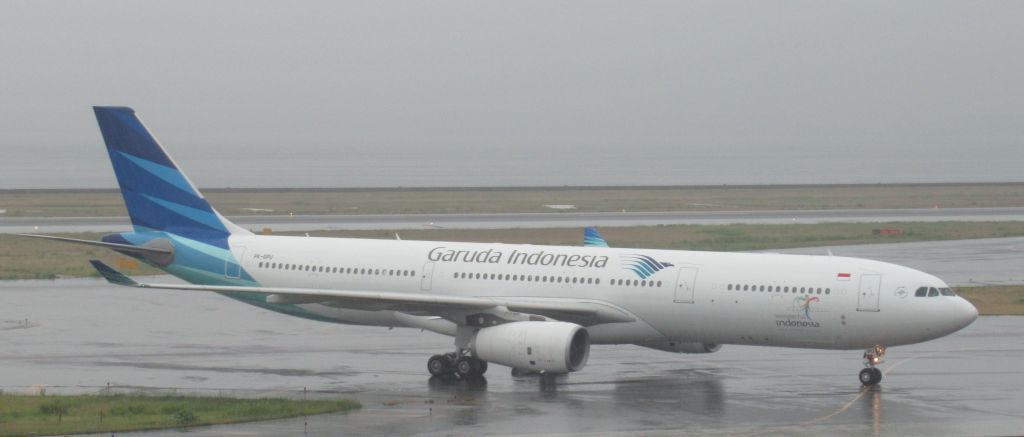
ANA 777-200ER, in Star Wars livery (JA749A)
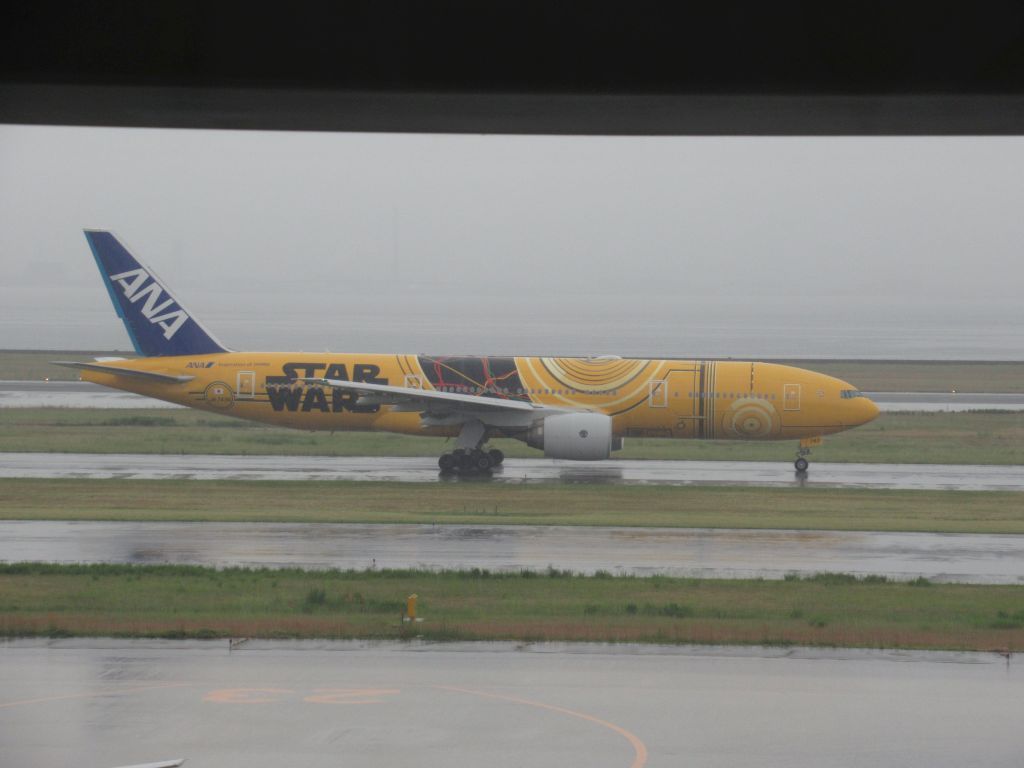
Taking off the drenched runway, with the bridge connecting KIX to the mainland behind.

ANA 777-200ER, in standard livery (JA707A)

ANA 737-700 (JA05AN)
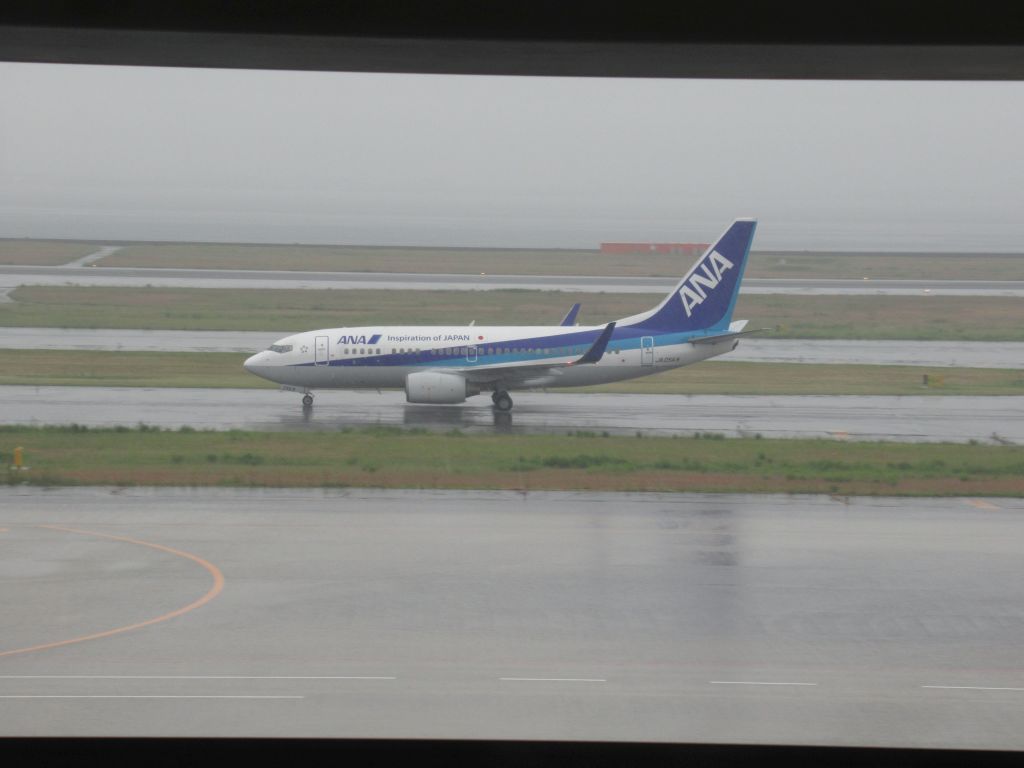
Vanilla Air A320

Air Seoul A321
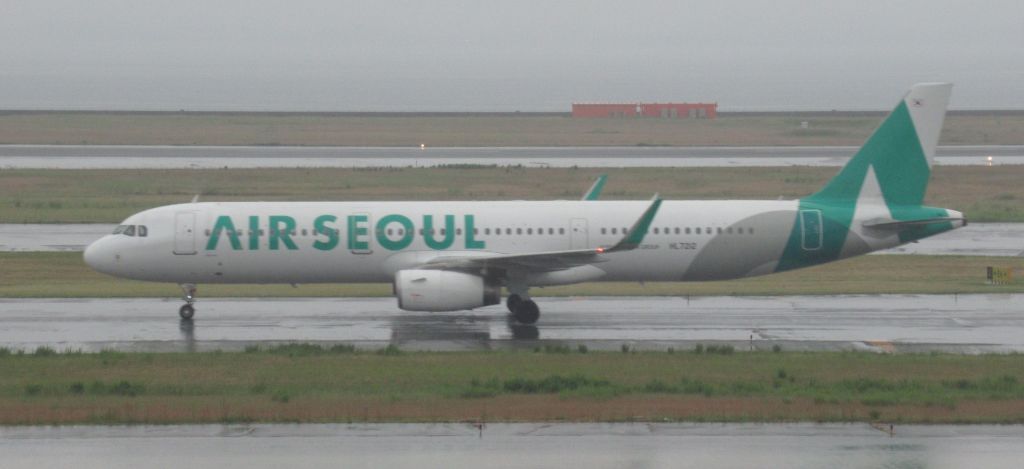
Jin Air 737-800 (HL7562)
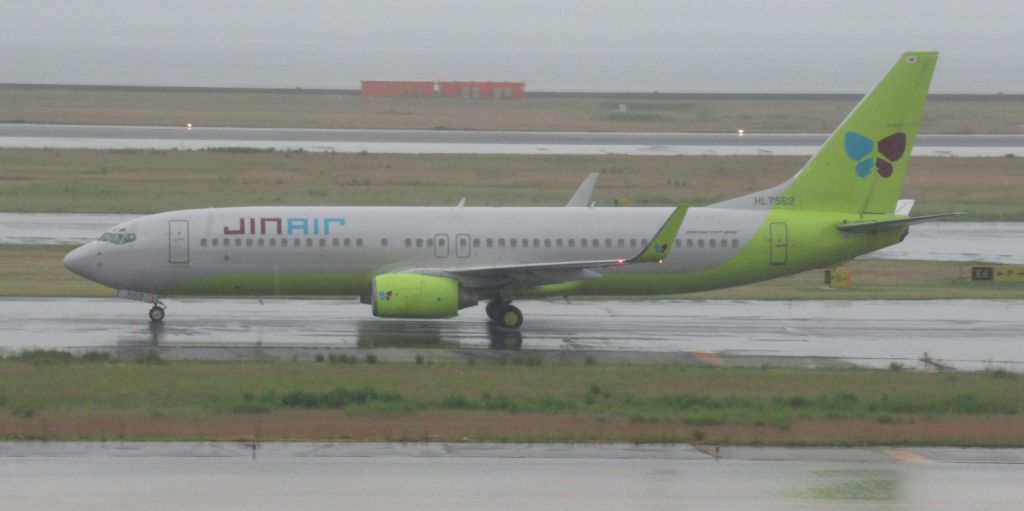
Jeju Air 737-800 (HL8064)
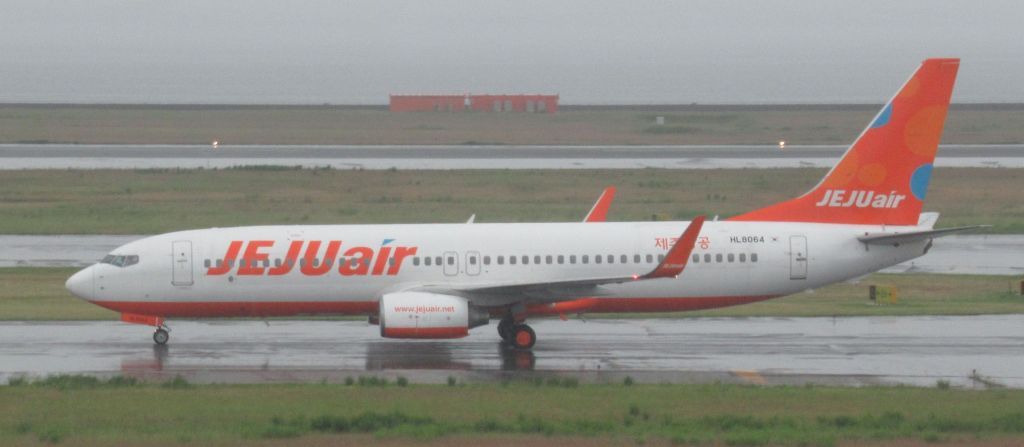
A 737-400 of Japan Transocean Air, a subsidiary of Japan Airlines (JA8999)

"The wings of Okinawa" うちなの翼

Water splashing take-off of a Peach Airlines A320

Asiana Airlines 767-300 (HL7248)
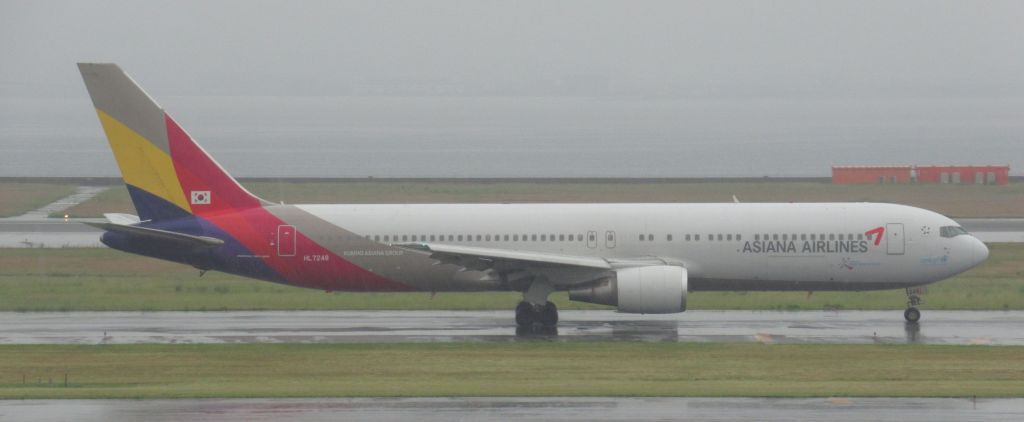
Go to gate, and getting to Gate 38 will be much faster than I had expected. I had an overview of the domestic gates just after leaving the lounge.
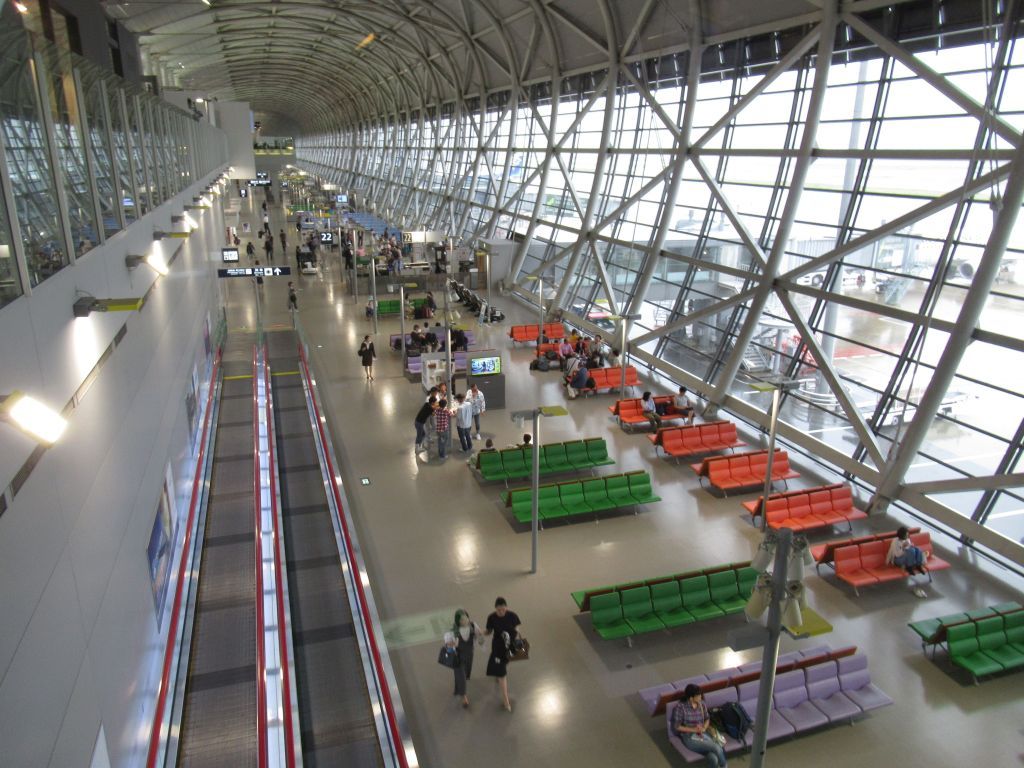
After a very short people mover ride, I reached the South international departures gates concourse which is quite plane spotter friendly.
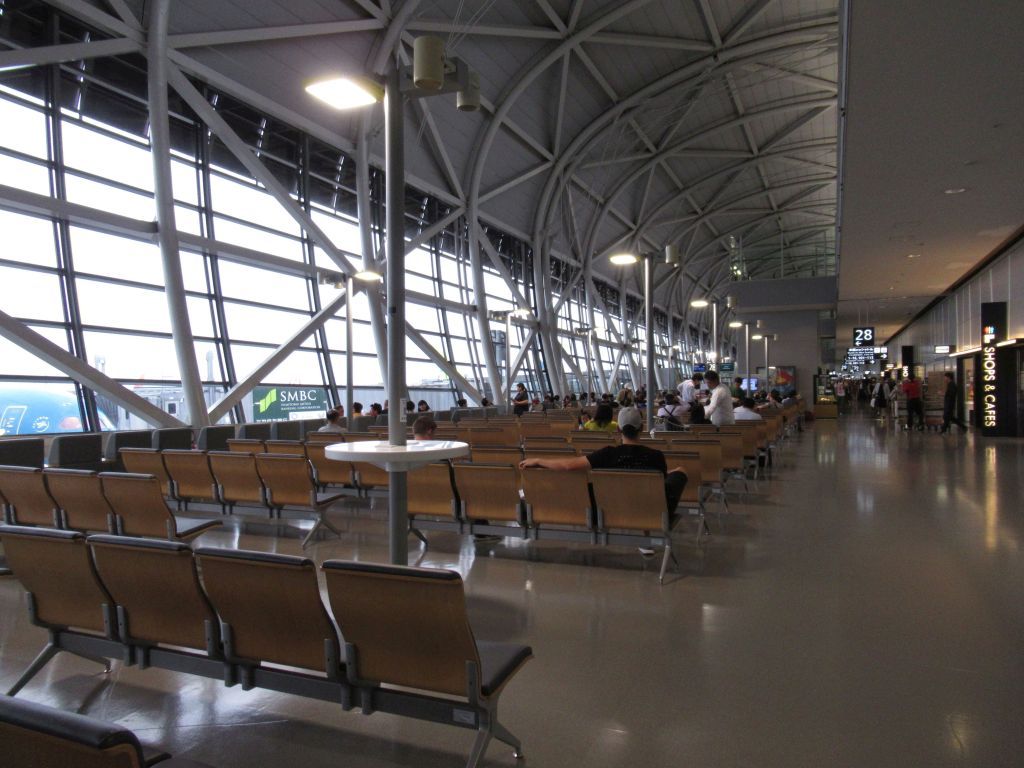
A brief overview of the planes at the gates: China Airlines, Philippine Airlines, Air France et KLM, from left to right.
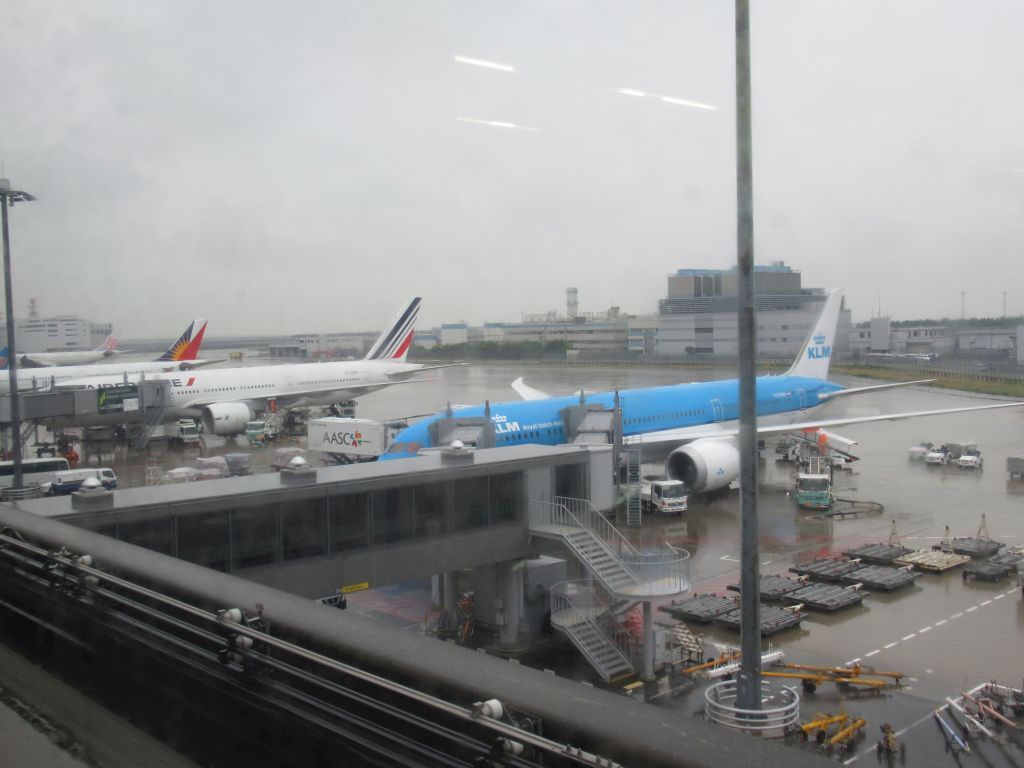
Garuda A330
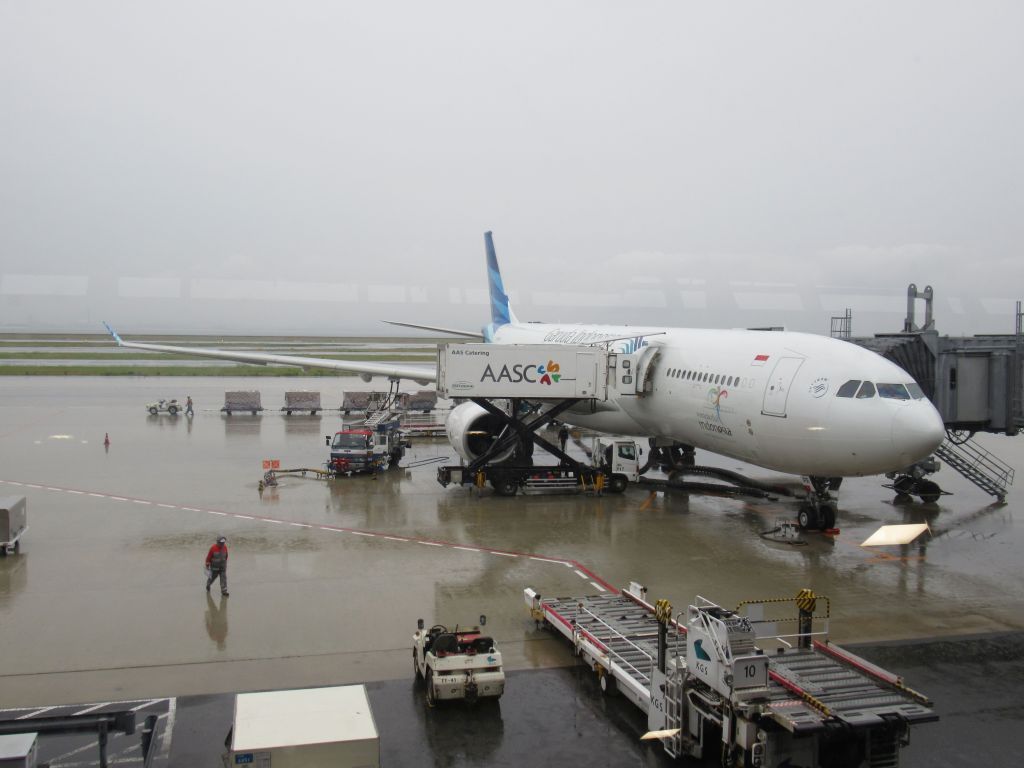
The carpeting in the part of the terminal would not change the habits of frequent flyers on this airline.
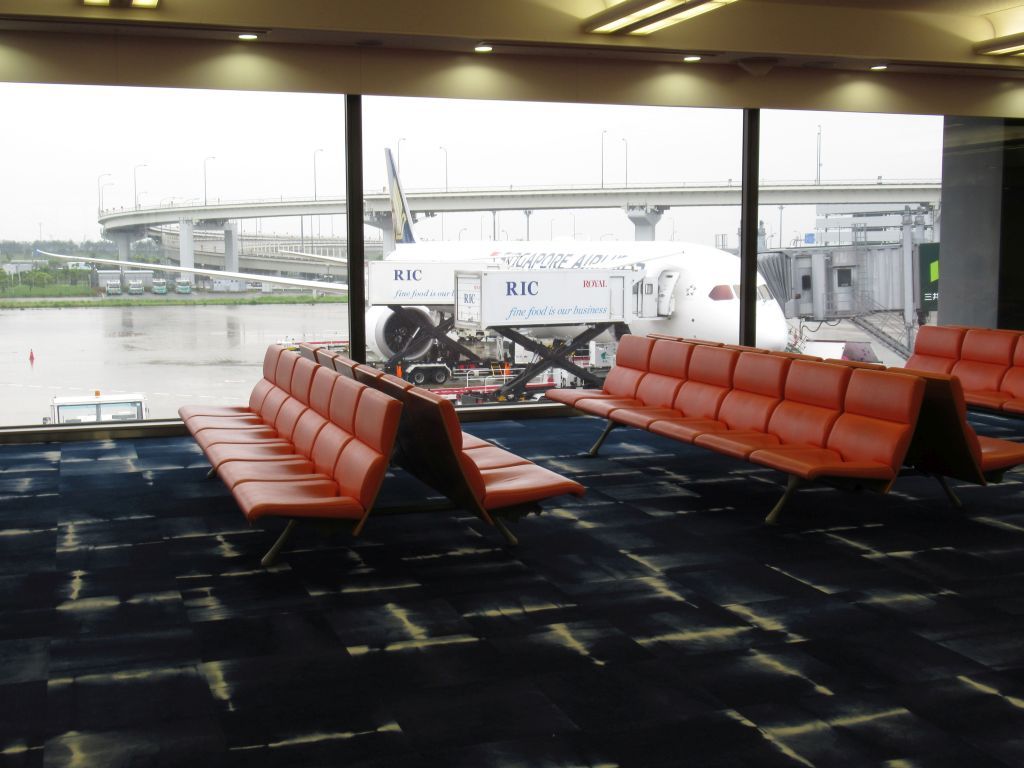
It was no way as deep as that in SIN (Singapore Airlines 787)
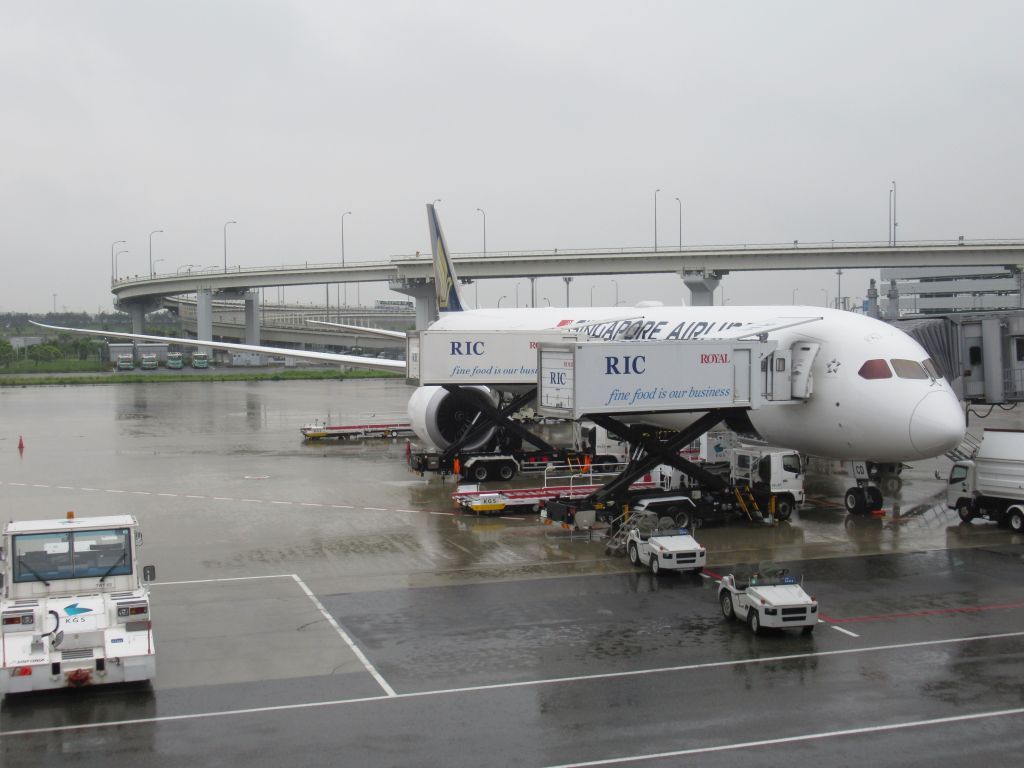
KLM 787-9 (PH-BHM)
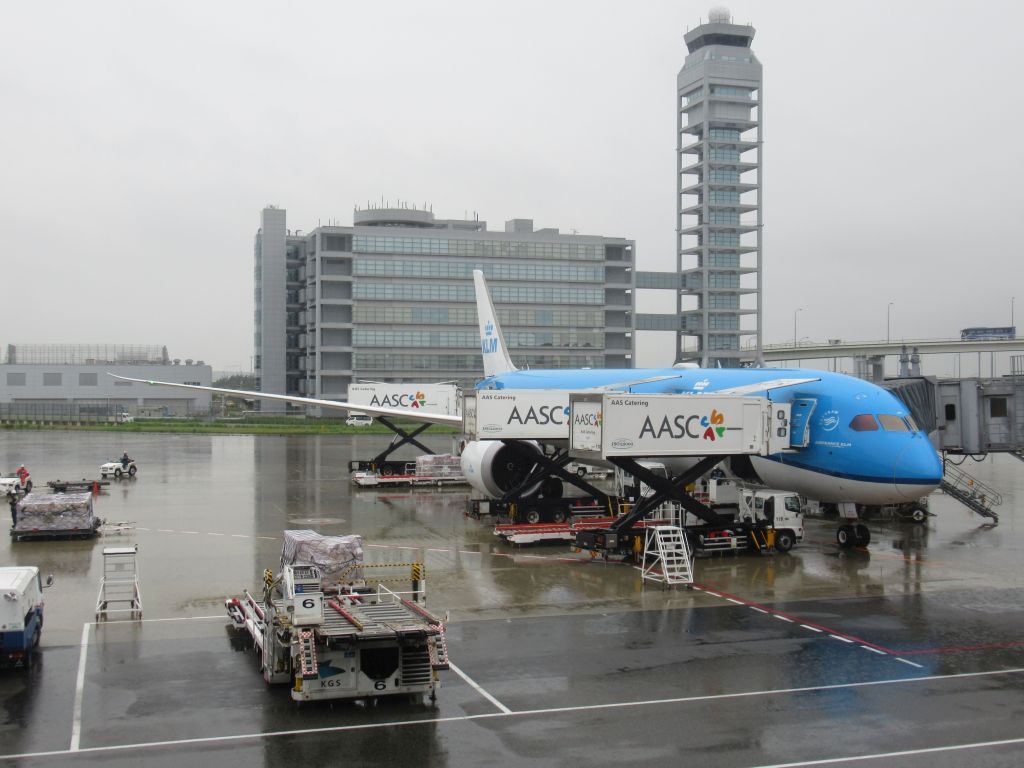
Arrival of a Korean Air 737-900 (HL7708)
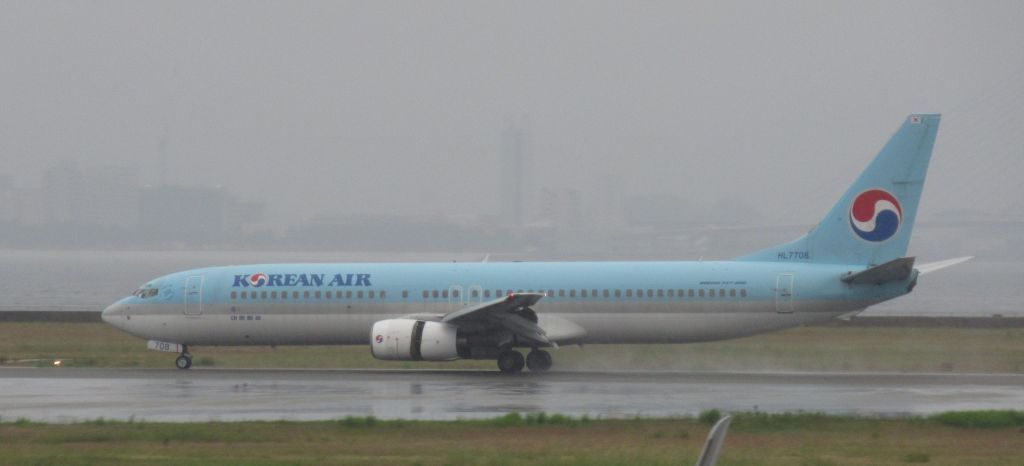
Jin Air 777-200ER (HL7734)
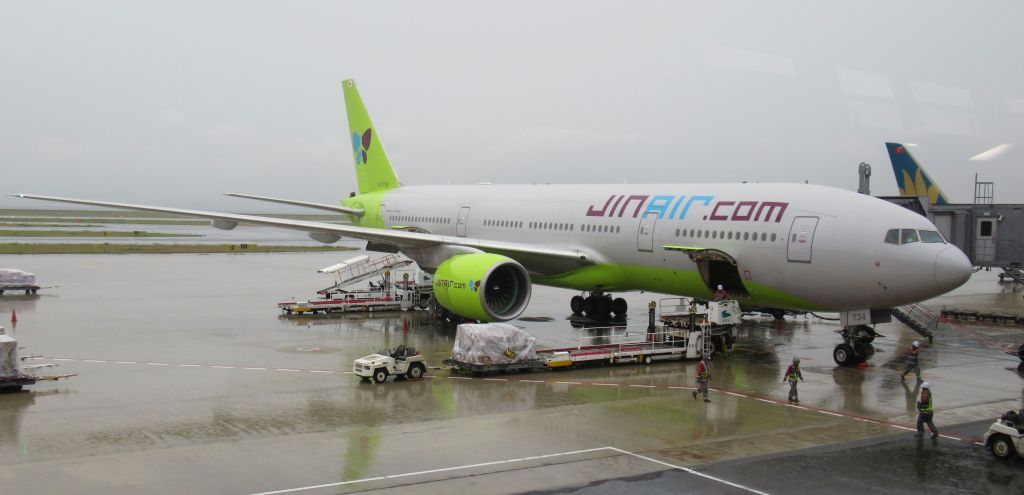
Vietnam Airlines 787-9 (VN-A869)

T’way 737-800 (HL8070)

And last, the AF 777-200ER which is going to fly me home (F-GSPQ)

I saw this deserted children play area on the way
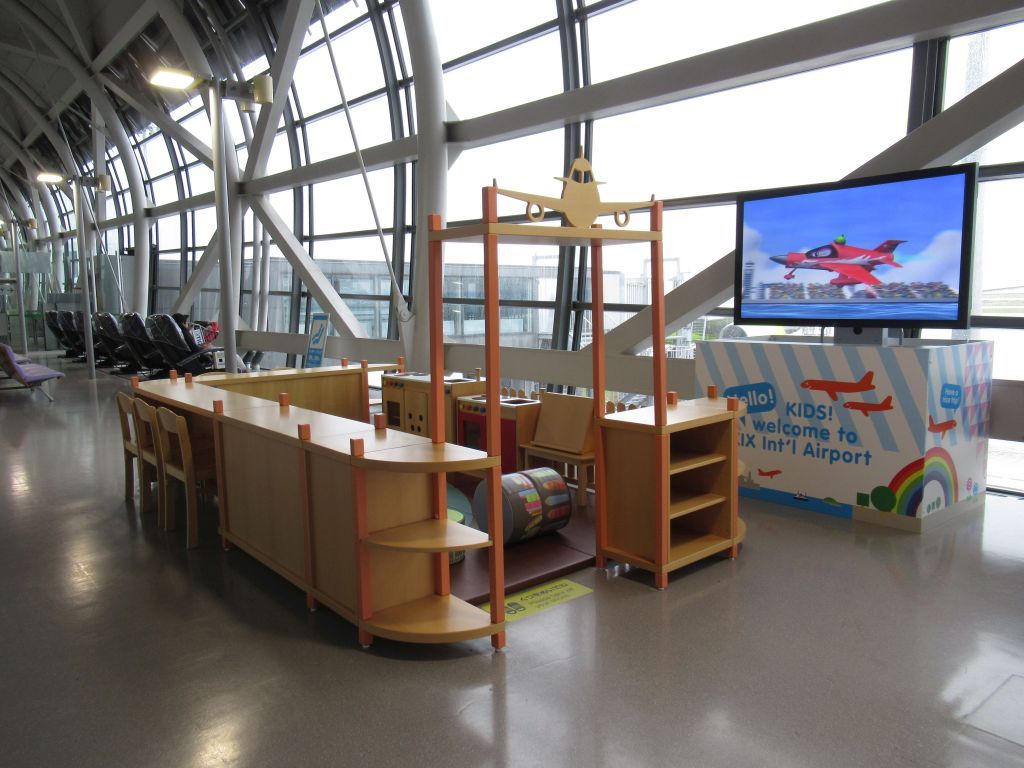
Boarding was by zone: Business class first, then Economy Premium and Elite status passengers, then the other Economy passengers in three zones.

The jetbridge had wide windows overlooking the apron where the rain was not abating.
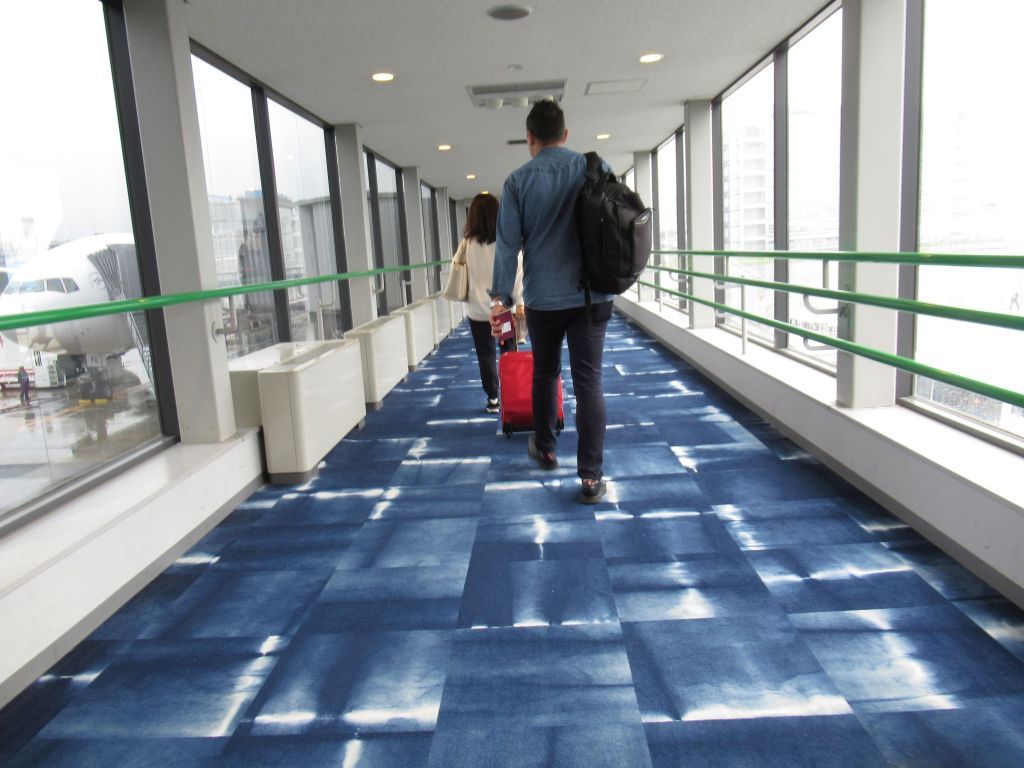
Door shot
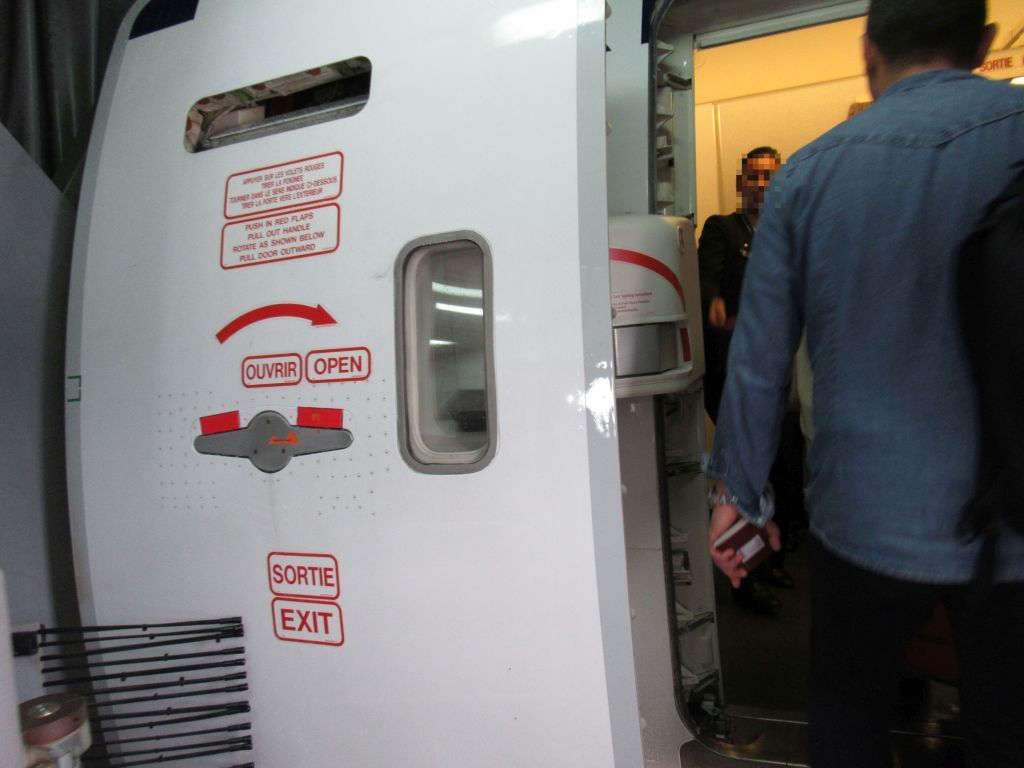
This is what I did not want to pay 319 EUR extra, or possibly more
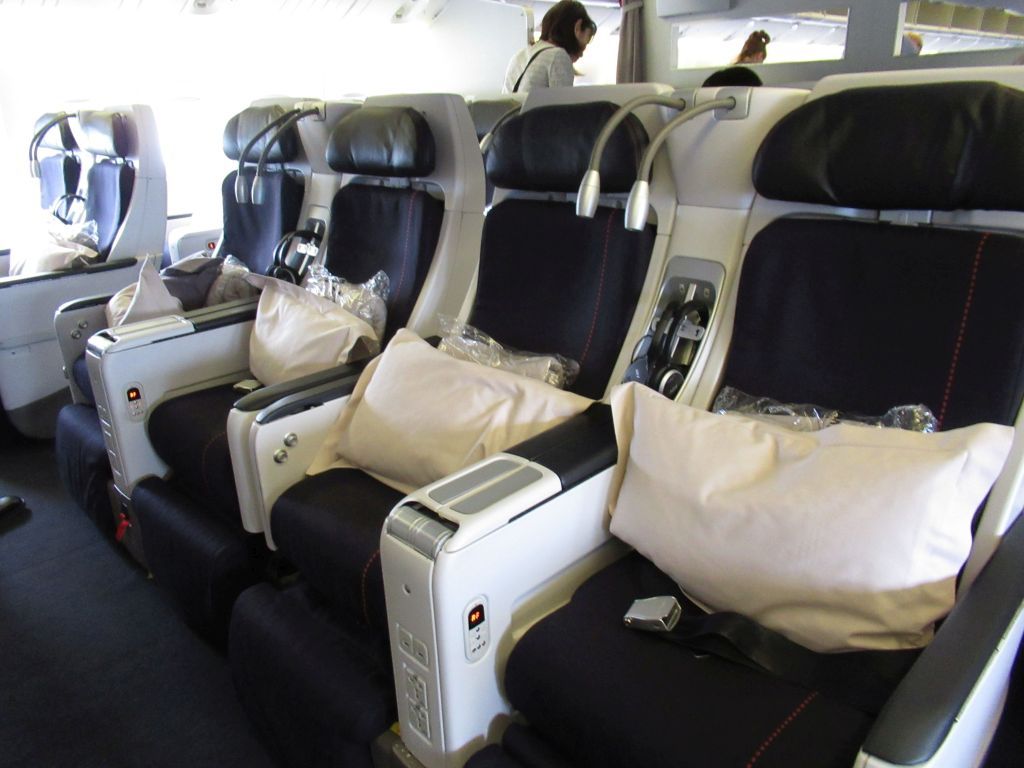
First Economy cabin
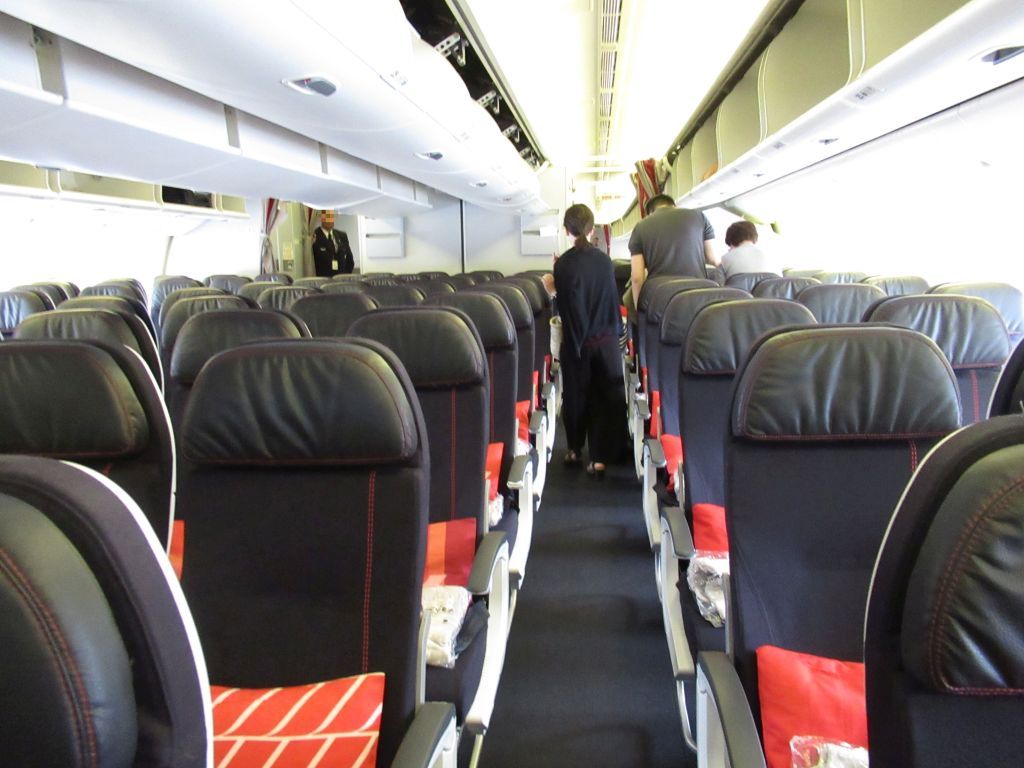
The still empty second Y cabin from the rear

A multistandard power port is now part of the equipment of a decent recent Economy cabin and this one had them.

The carpet was clean

On the other hand this was high density sitting: the backrests had a bad case of anorexia and the cramped 3-4-3 layout was perfect ground for armrest warfare.
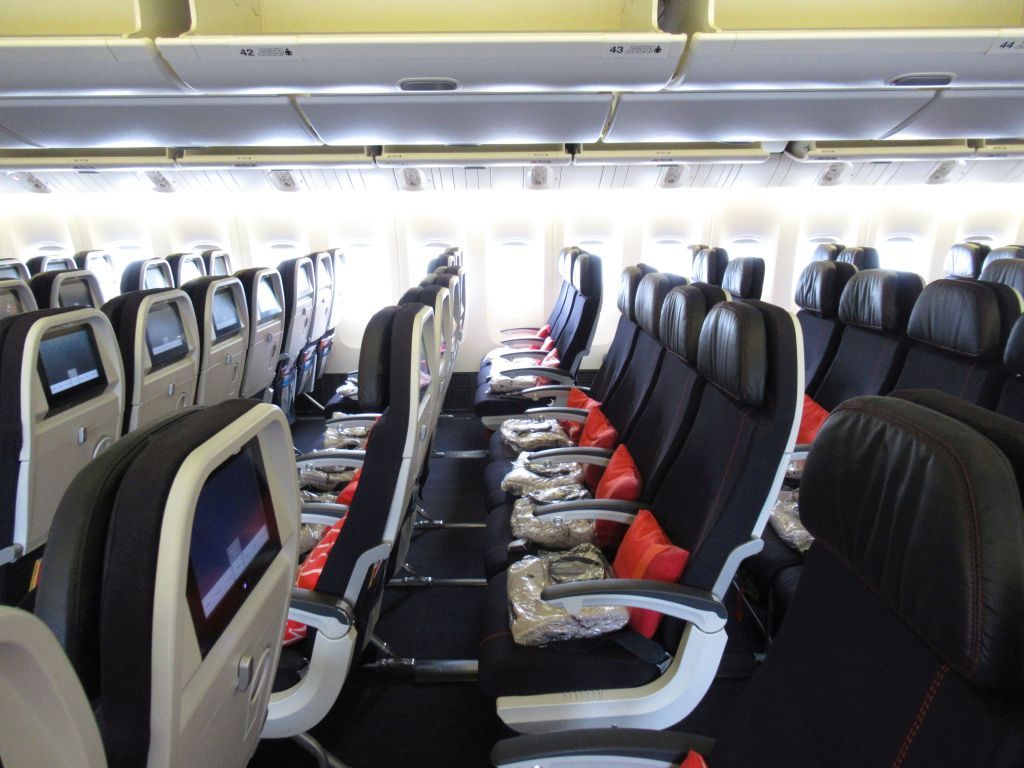
My safety information card (the one on the left) had suffered some damage

The headphones are of course low quality. I had not taken my measuring tape to save weight, so I wouldn’t have taken a noise cancelling headphone, all the more that I don’t own one.
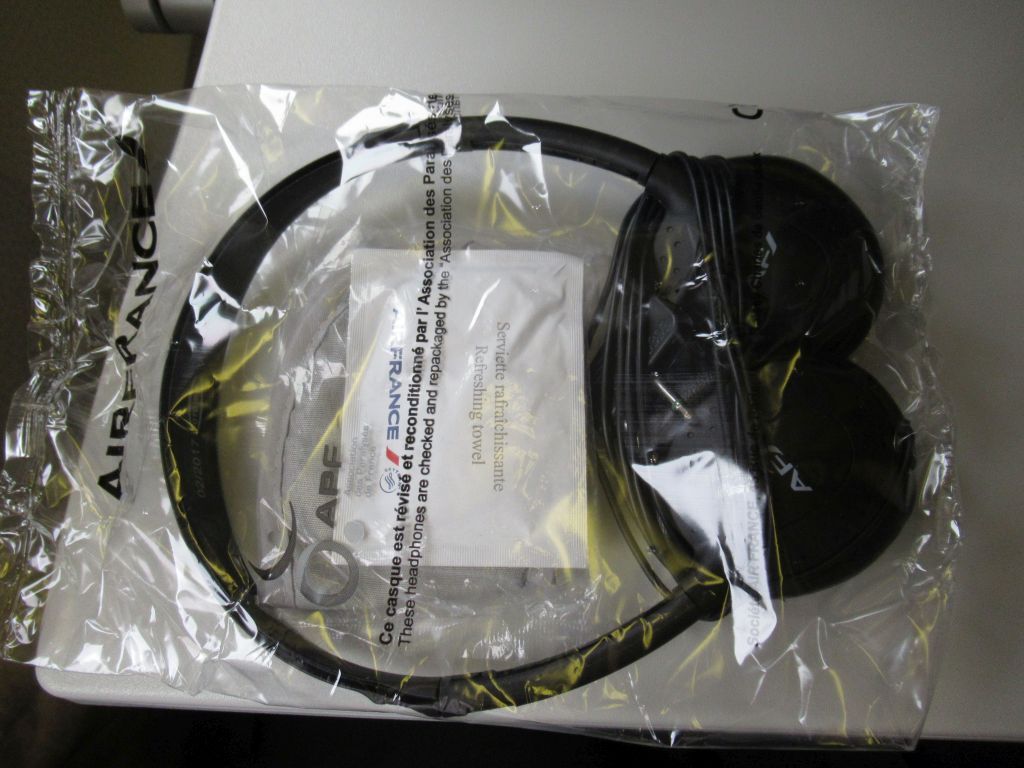
In the absence of a measuring tape, I saw that the distance from the seat edge to the magazine pocket (with its standard magazine supply) was exactly the length of AF’s in-flight magazine.

Pushback was on time
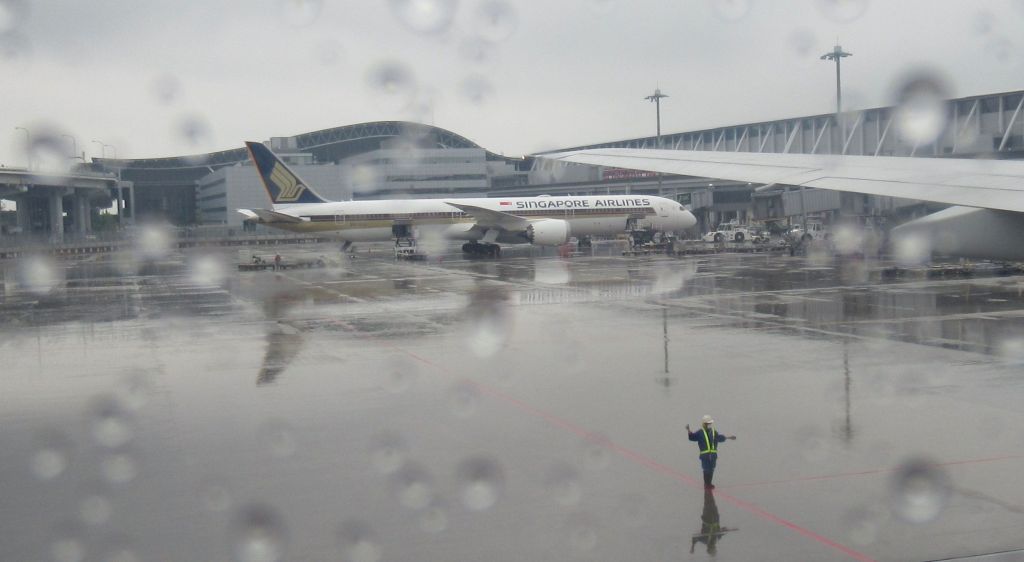
I already mentioned several times that I do not like the current AF safety presentation that I find too fussy.
(No, AF, flights did not become non-smoking some twenty years ago because that was chic (quote), but out of concerns for the passengers and FAs’ health)
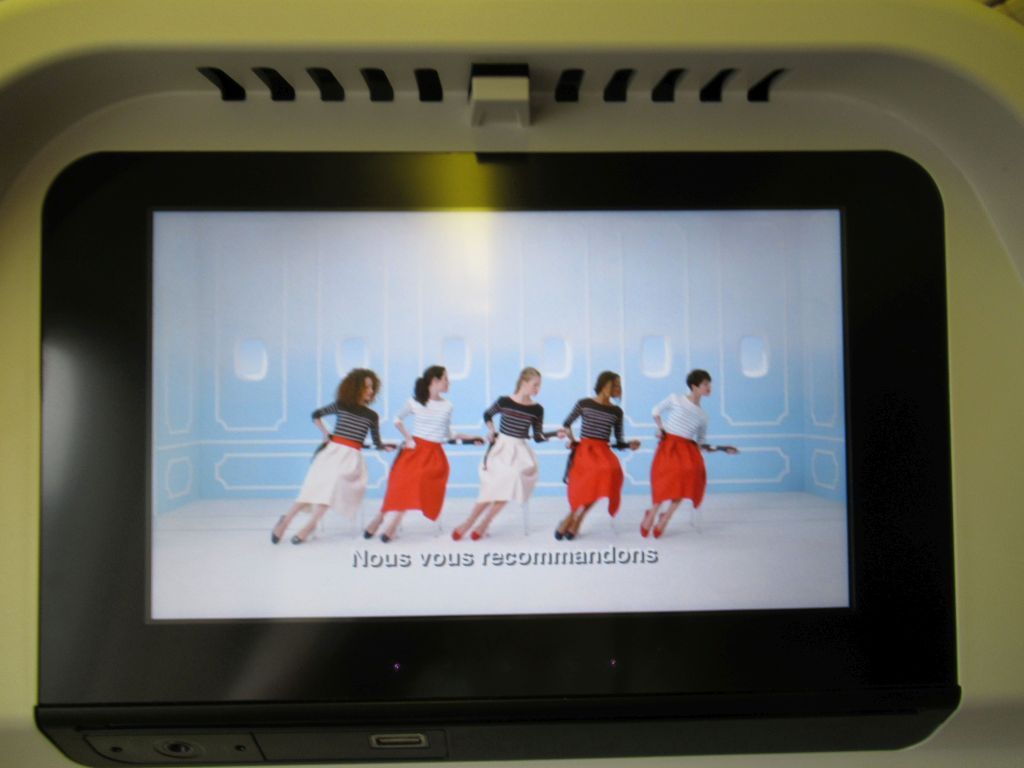
The south end of the terminal is obviously dedicated to LCCs: Jetstar A320

Eastar Jet 737-800 (HL8035)
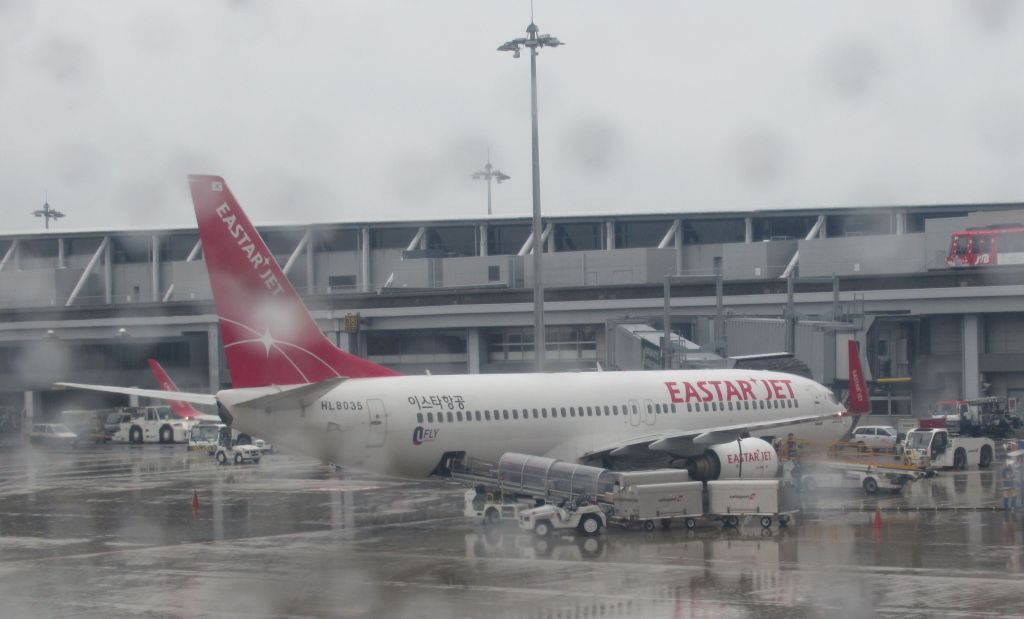
T’way 737-800 (HL8036). These two registrations are coincidentally sequential !
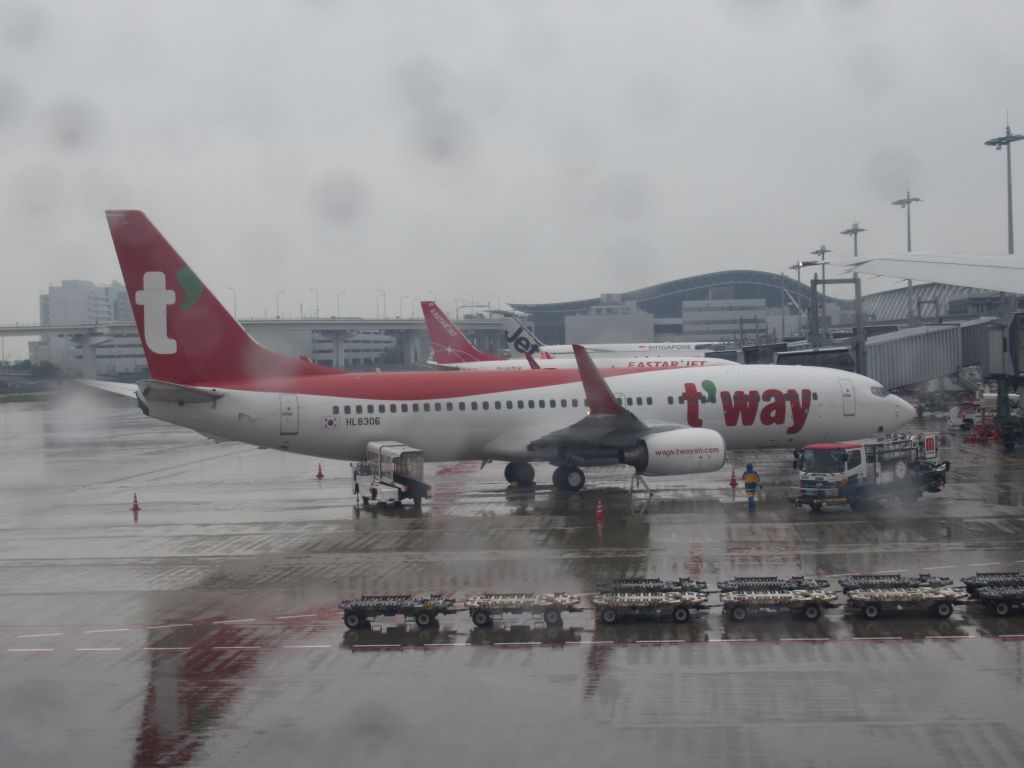
Tiger Air Taiwan A320
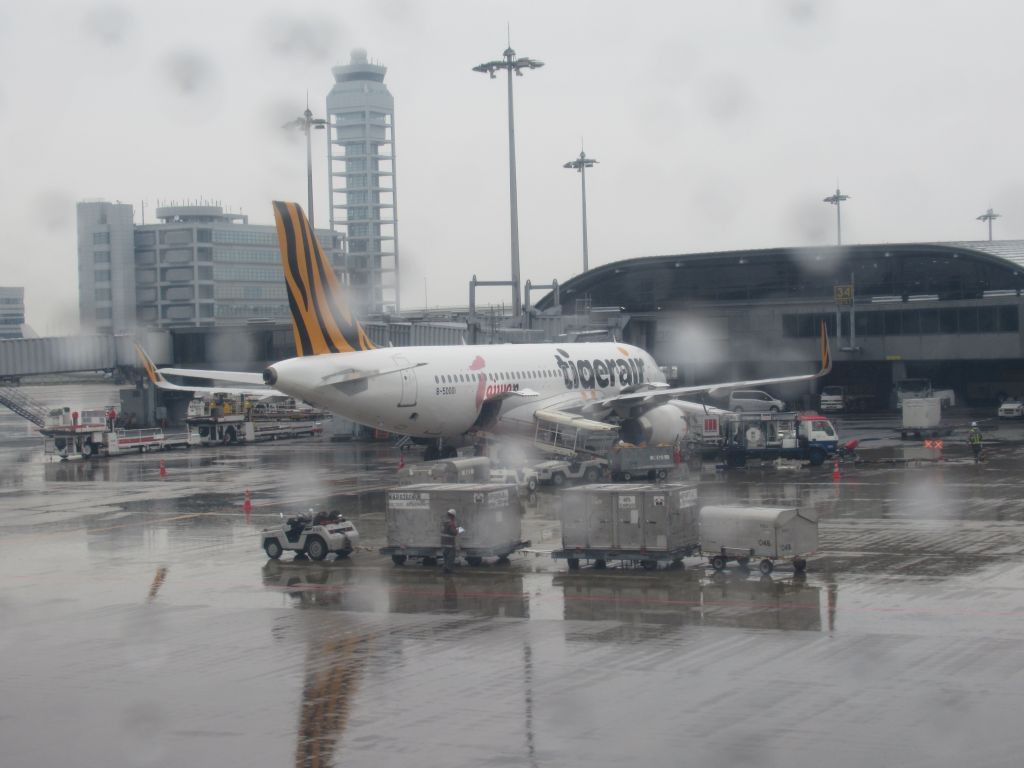
T’way 737-800, in special livery (HL8294)

There was some taxiing traffic ahead of us: Vietnam Airlines 787-9 (VN-A866)
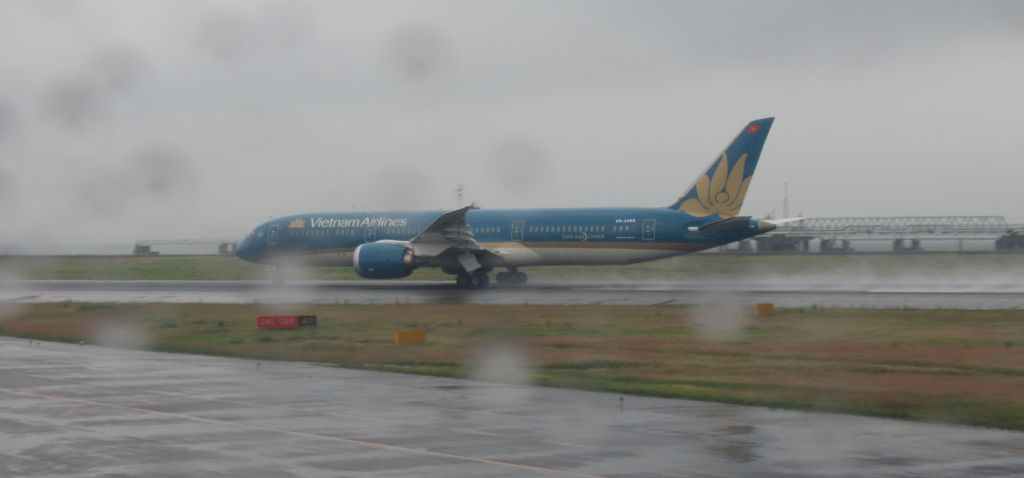
Jeju Air 737-800 (HL8234)
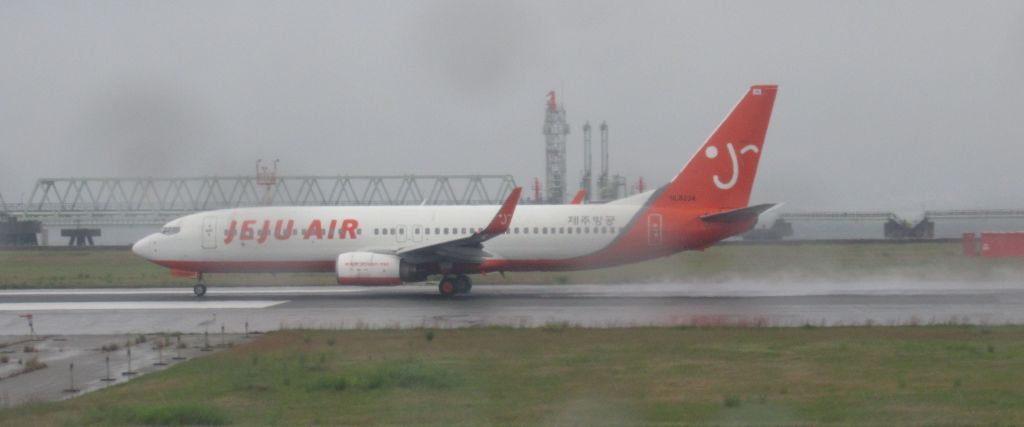
The KLM 787-9

ANA 737-800 (JA82AN)
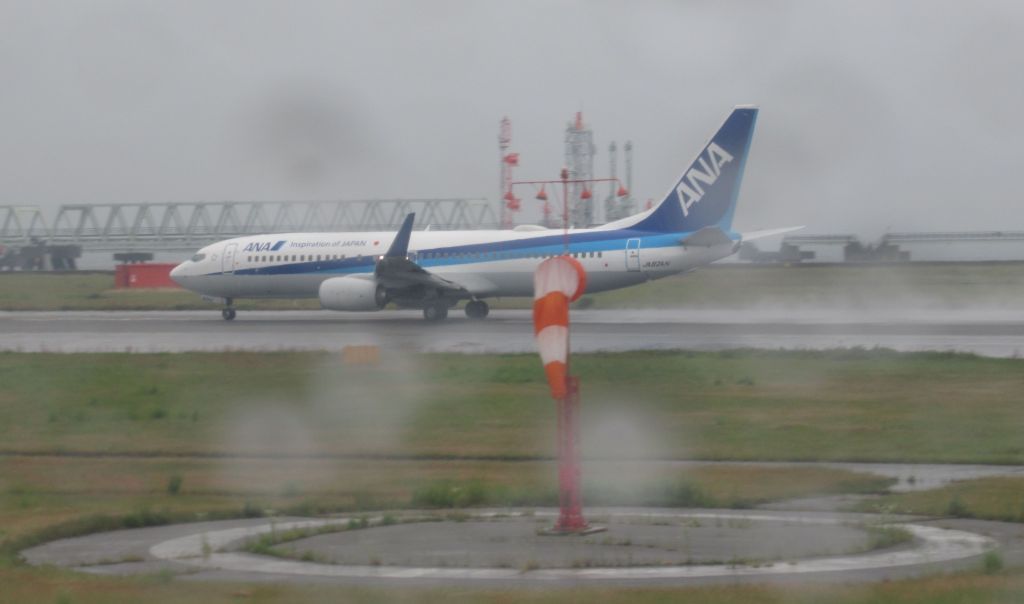
Peach Airlines A320
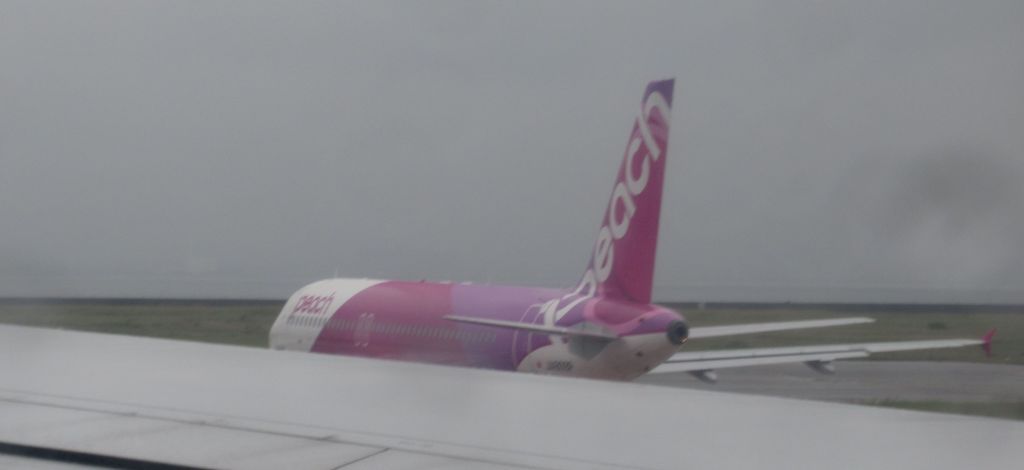
ANA and FedEx freighters parked close to the runway threshold.
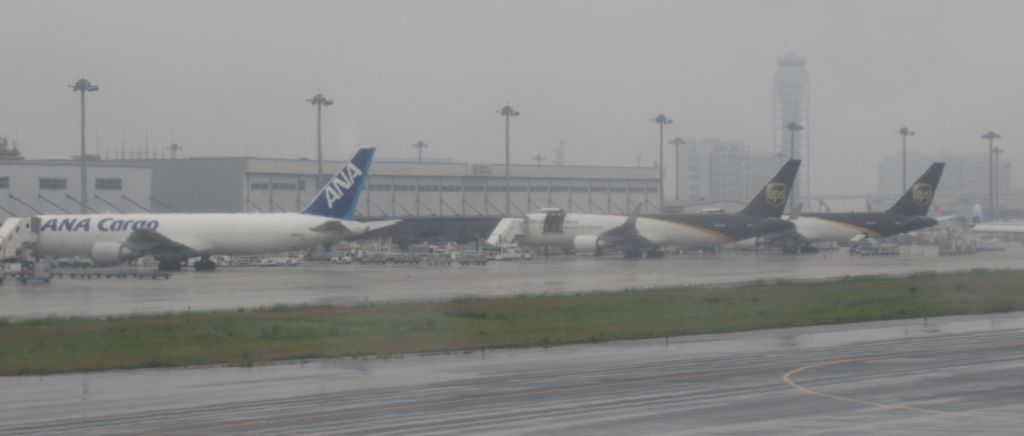
It was crowded too behind us: a China Airlines 747 freighter
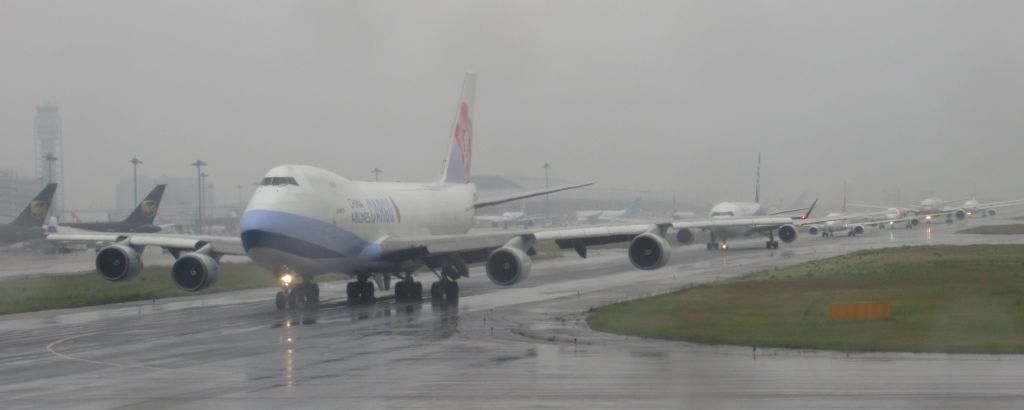
ANA 767
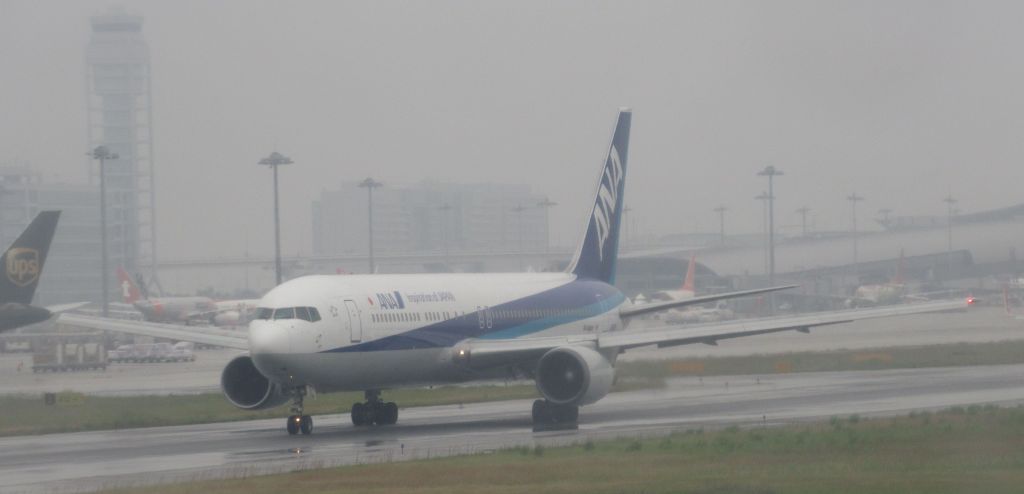
T’way 737

There were still a Jin Air 777 and a Garuda A330 behind, but our plane was already going too fast and there was too little light for an acceptable picture. This was a Finnair A350 shot just after takeoff.
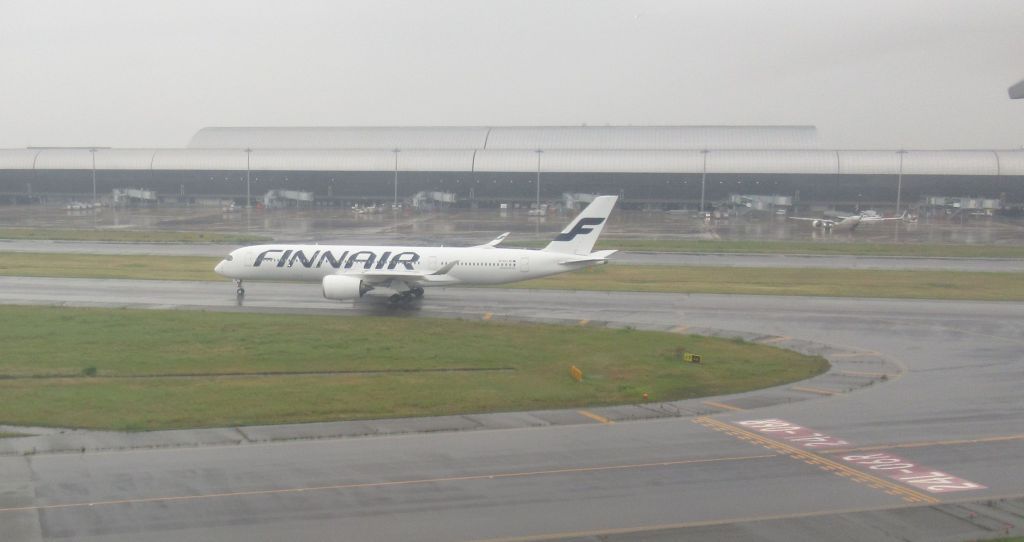
United 737 with scimitar winglets.
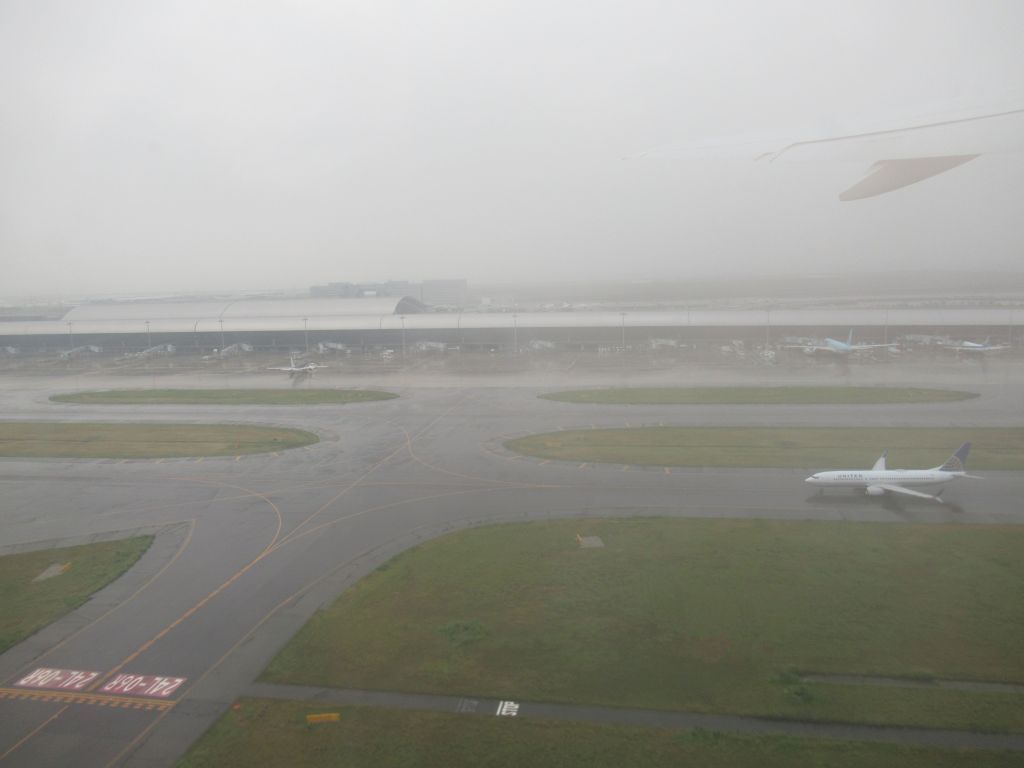
The end of the terminal, with an Eva Air aircraft in the foreground.

Interesting “flattened” interchange

And then we entered the cloud cover which was going to be quite continuous. Do not rely on the moving map to know precisely where you are.
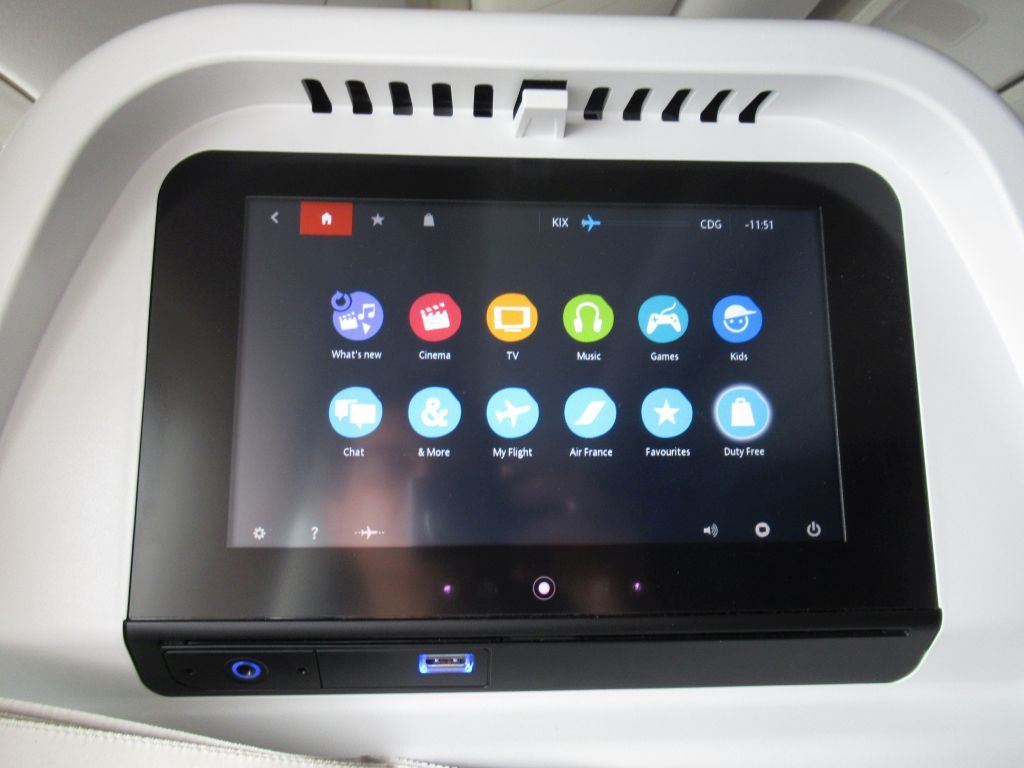
Like all airshows that I know, this one displays by default the great circle trajectory ahead of the present aircraft position: it is of course unrelated to its actual air route.
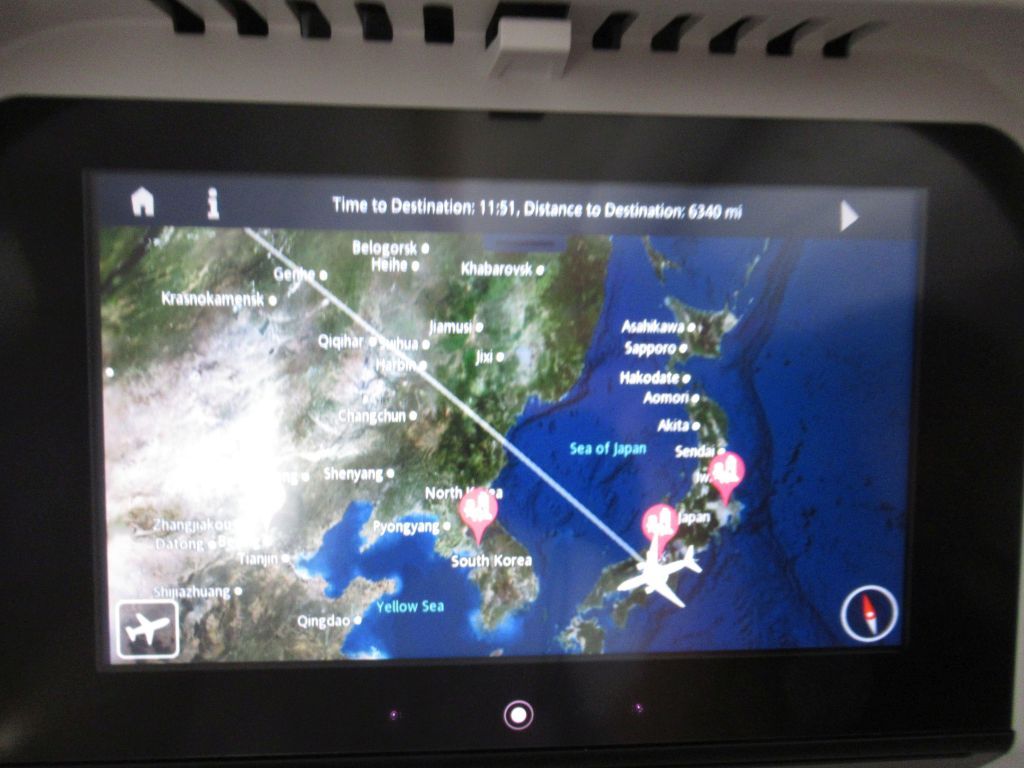
CDG –KIX flights pass close to Beijing and then wiggle their way between the military airspaces of Dalian and Yantai to South Korea. This route is maybe too narrow for bidirectional traffic: flights in the reverse direction first fly north above Japan before entering Russian airspace, passing close to the Chinese border near Khabarovsk, never entering Chinese or Korean airspace. Or maybe it is related to prevailing winds at cruising altitudes.

I started to work on this FR as soon as it was possible to use my laptop which signaled that it was on battery power: would I need to save power (which meant an uncomfortable reducing screen backlight setting) until the beginning of the descent to CDG ?

No, the indicator changes to « charging » quite quickly..
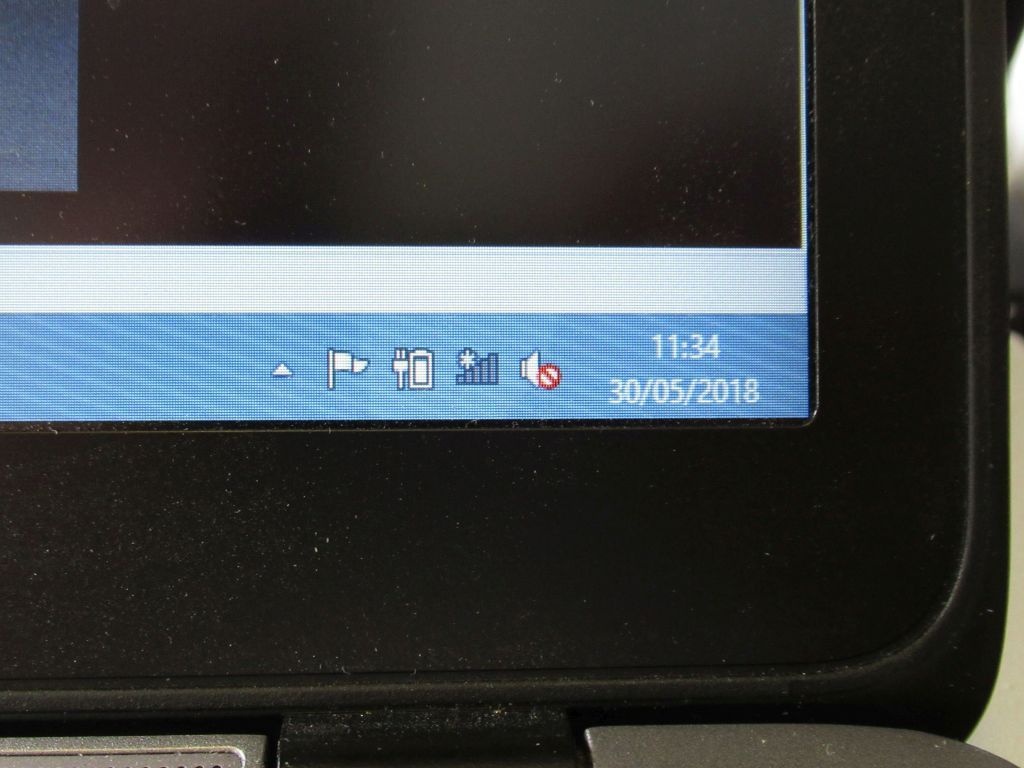
The menu was distributed on a small leaflet format. I was not offered to preselect my preferred dish (like on the way in, as an extra FB-Plat advantage which could not be taken for granted), but I turned out to be available.
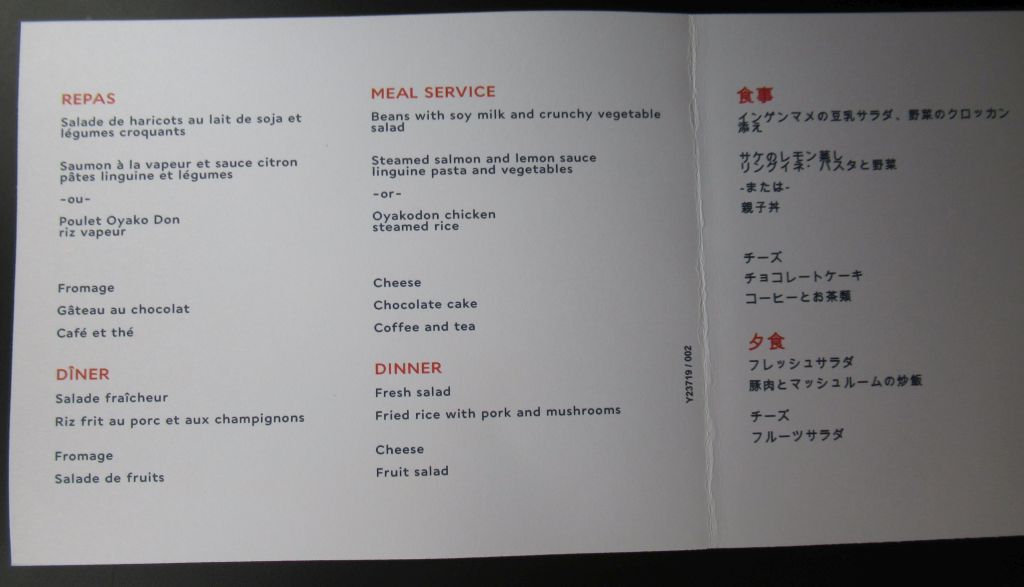

Distribution of a drink (apple juice for me) and a 10-gram pack of salty snacks.
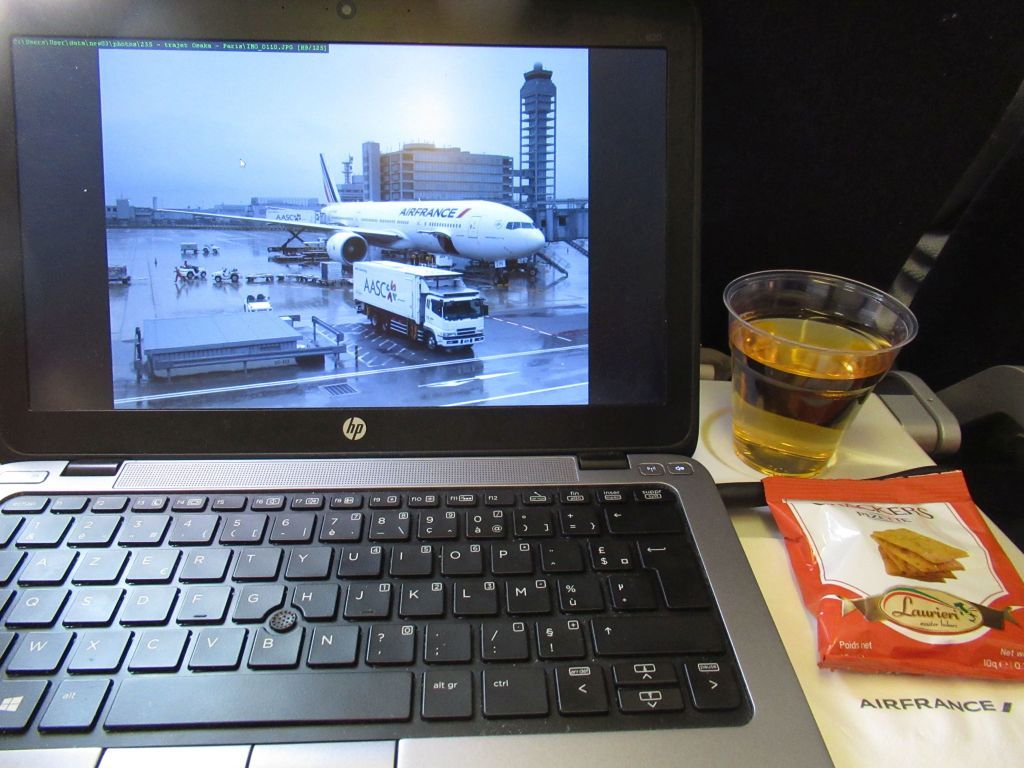
The plane then went through a long zone of significant turbulences ; the FAs had to remind three times to an Asian lady that this was definitely not the relevant time for leaving her seat (FA service was even temporarily halted).

Lunch was served this way. Either the Japanese employees of the catering company or the French FAs at AF should be taught that French etiquette dictates that bread should never be upside down, especially when served to somebody. My charitable guess is that they do not know the historic meaning.
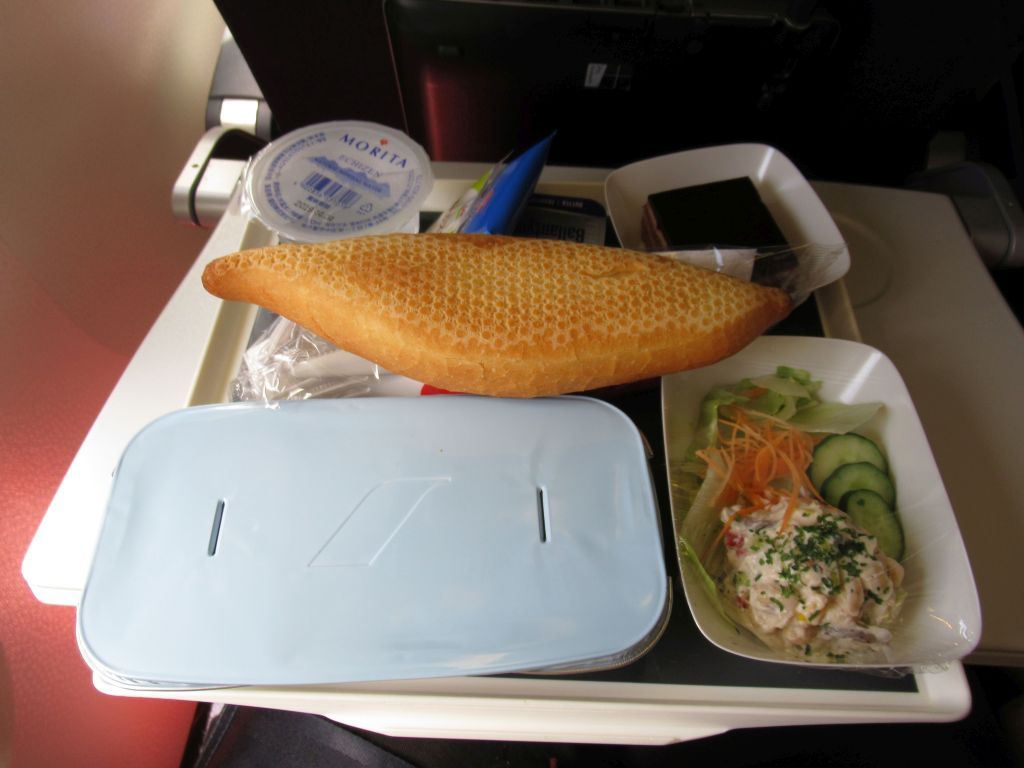
The same, after unwrapping. This was not refined gastronomy (who expects that in Economy), but I liked it.
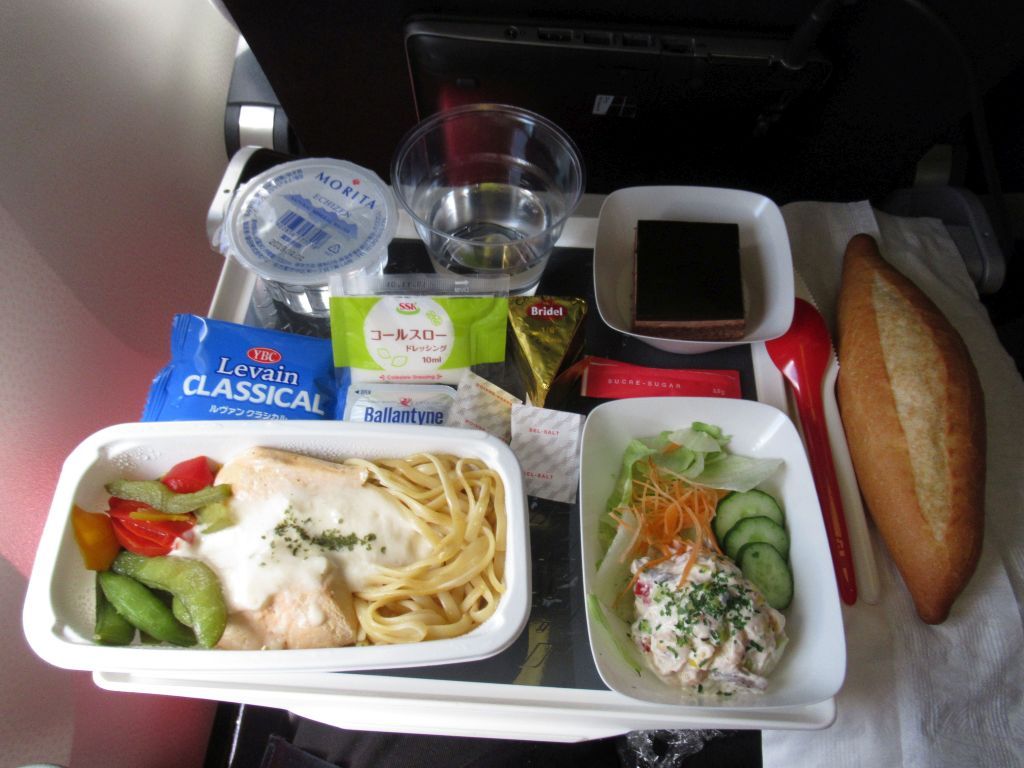
The hot meal container and its metal cover were ideal for receiving all leftovers after I had finished the meal, including the compressed capsule of water and the two other pieces of plasticware broken in three pieces each to reduce their length.
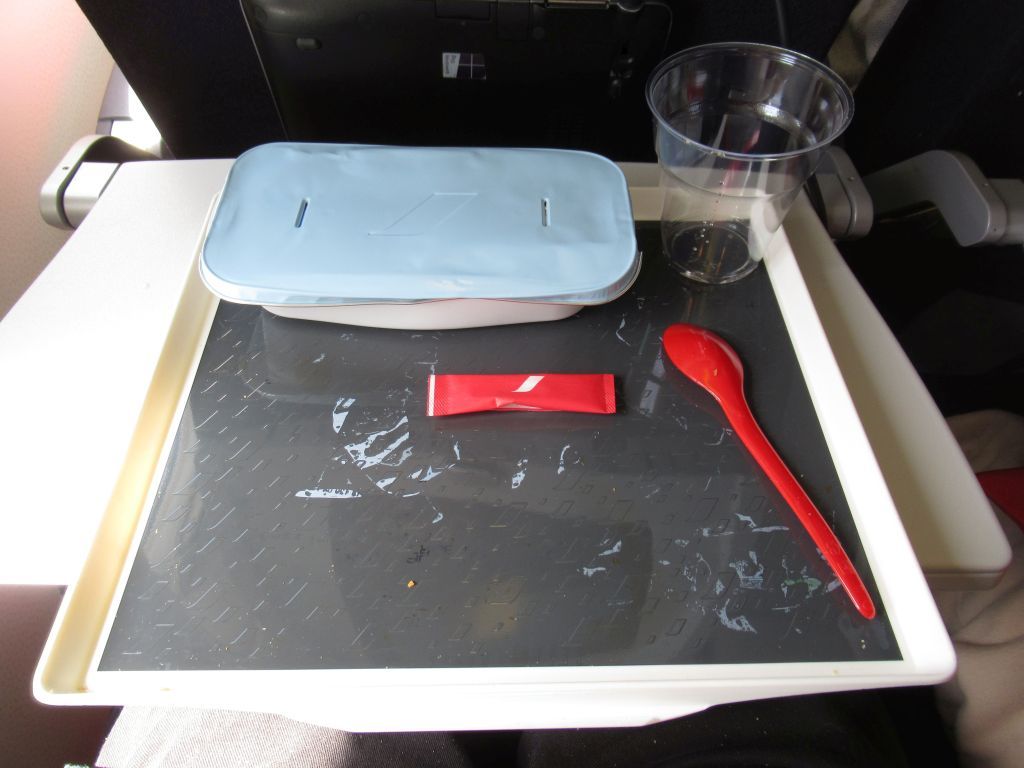
The whole thing was then slipped in the seat pocket before FA came for clearing the tray tables.
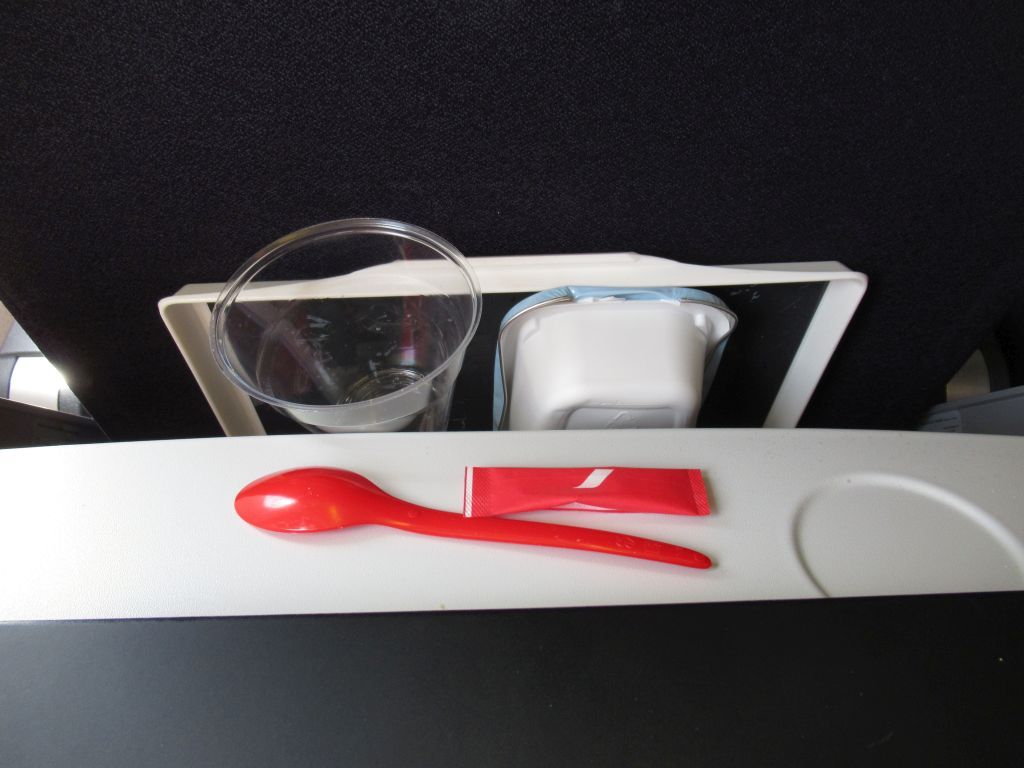
Until they came, I had a lot more space than my Japanese neighbors who apparently did not like Camembert cheese (Kiri cream cheese for dinner fared better with them). The empty middle seat gamble had been lost, but a Japanese neighbor was a guarantee of an armrest truce for the entire flight, and more generally trouble-free behavior.
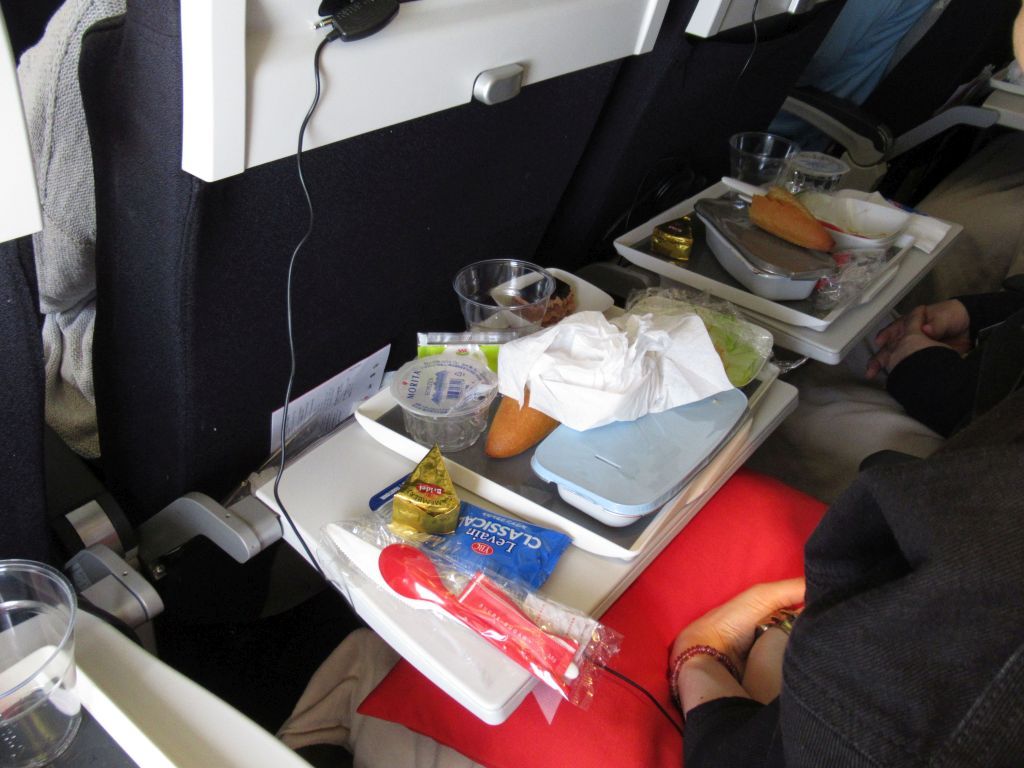
Coffee arrived later – I had kept my spoon and sugar ration for that.
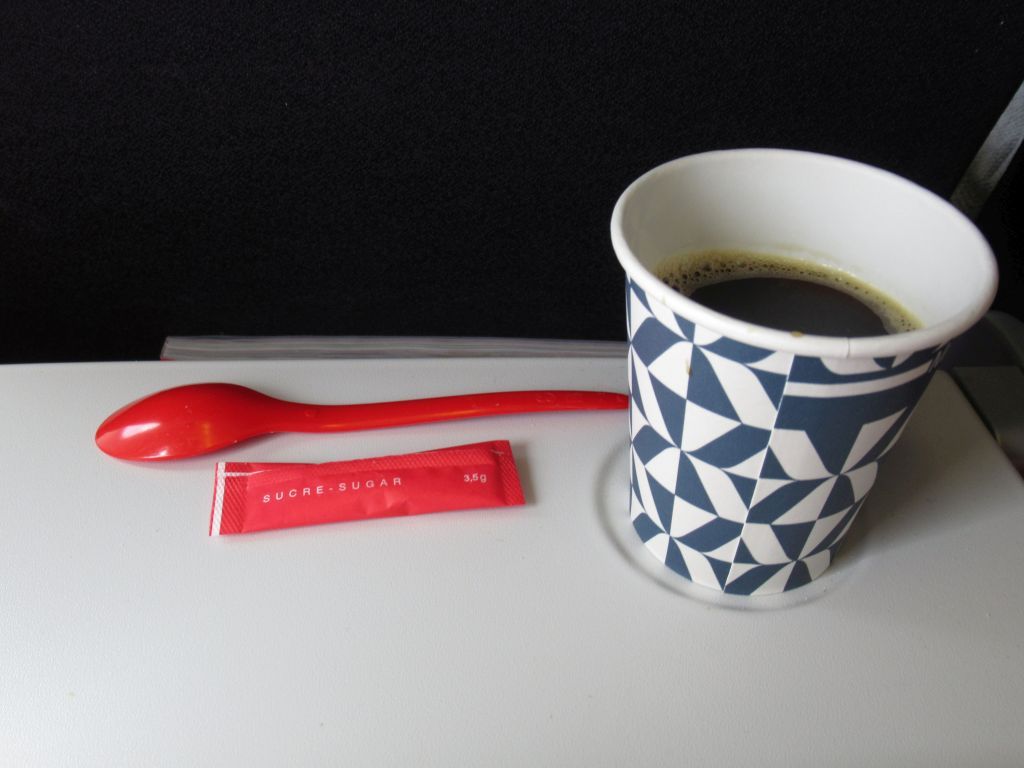
- Is everything all right, Sir ?
- Much better than on the way in, since the flight has not been cancelled!
- In that case, we can be sure to be better!
It was unclear if this was a discreet FB-Platinum recognition sign from the FA who had come to me, but my smiling allusion to the cancellation of my inbound flight due to an AF crew strike had been understood and deftly answered.
As for the landscape, it had yet to be better, because the cloud cover had been continuous up to there (not that AF could do anything about this), and all the long way above Siberia afterwards.
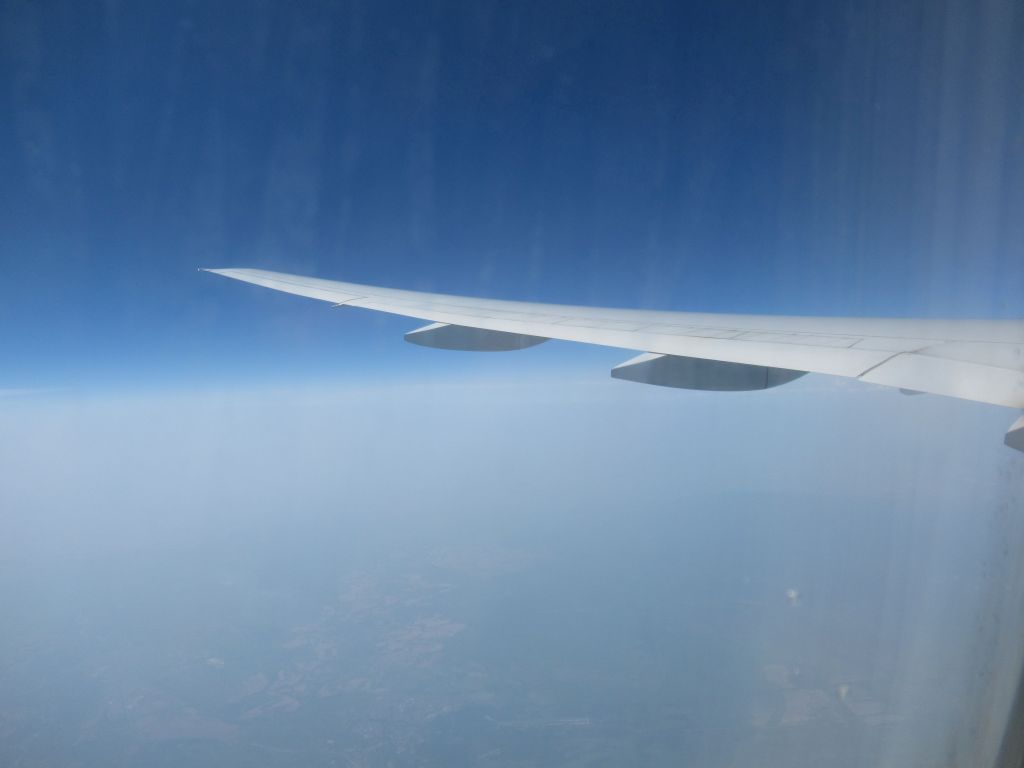
The sky cleared up a little there. Left of the route, Birobidzhan (Биробиджа́н) is the administrative center of the Jewish Autonomous oblast, a curiosity created in the early 1930s which supported the Soviet Union’s claims of protecting minorities, while persecuting Jews who had generally not chosen to come to that place whose climate is as bad as its isolation.
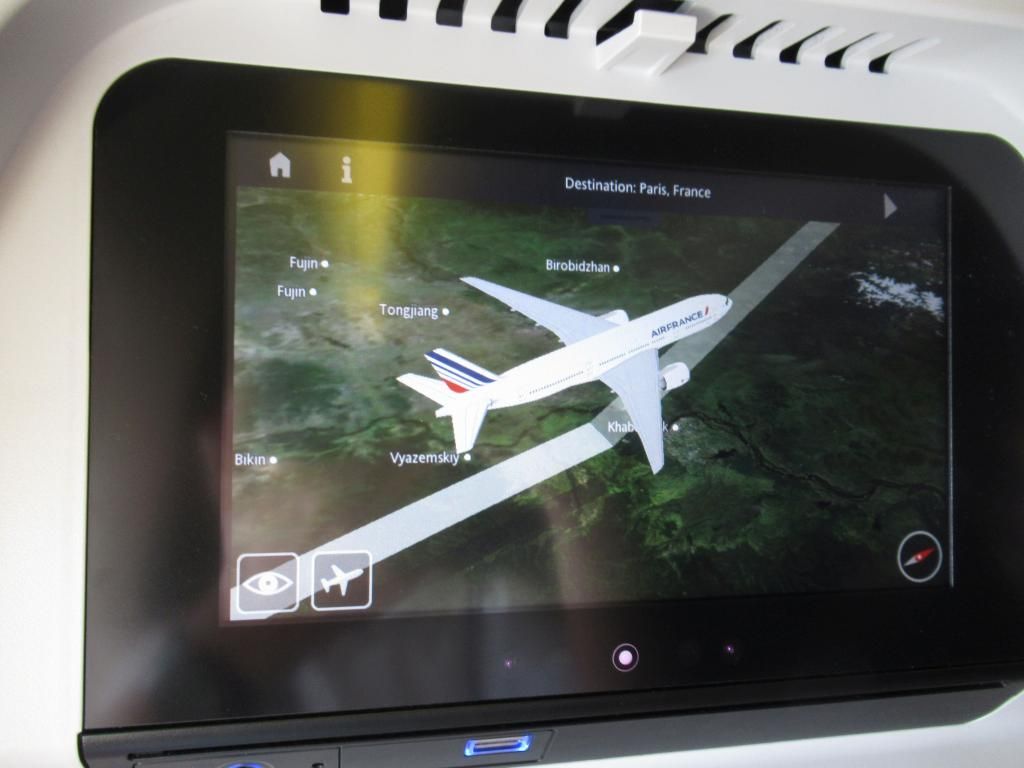
This was not an airbase, but a long storage of large diameter tubes for pipelines, in the immediate south-west vicinity of Khabarovsk. Only passengers sitting on the right hand side window seats got to see the city and its airbase.

A river whose meanders were outlined by light colored banks (sand ?).
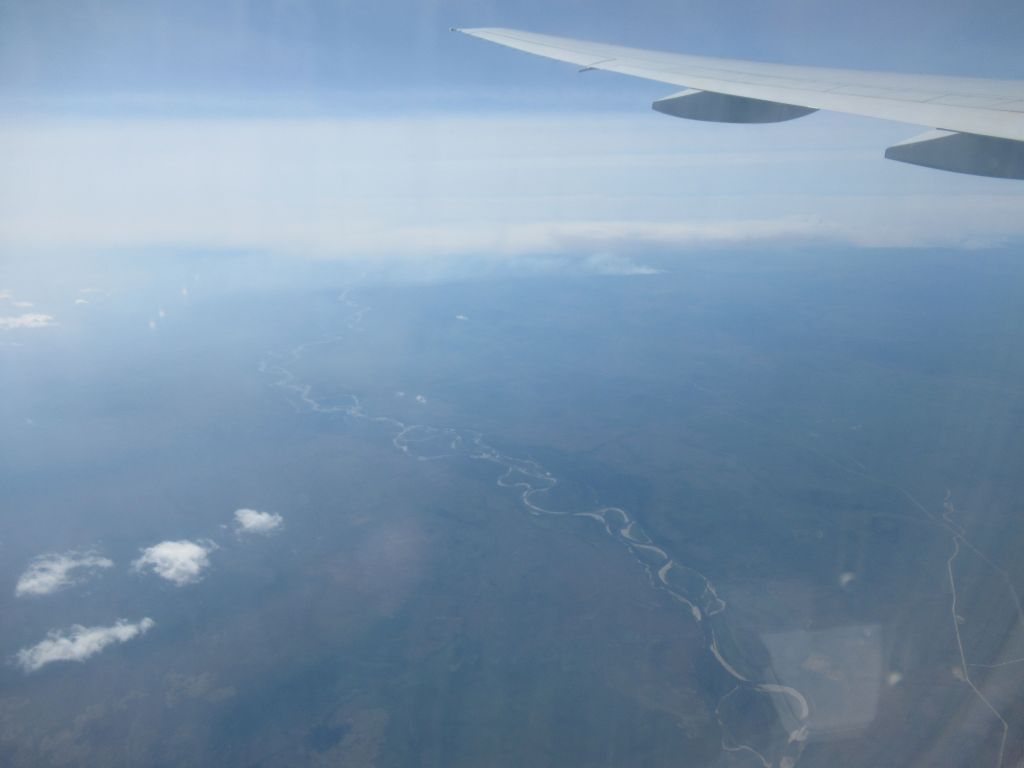
Snow covered summits, later
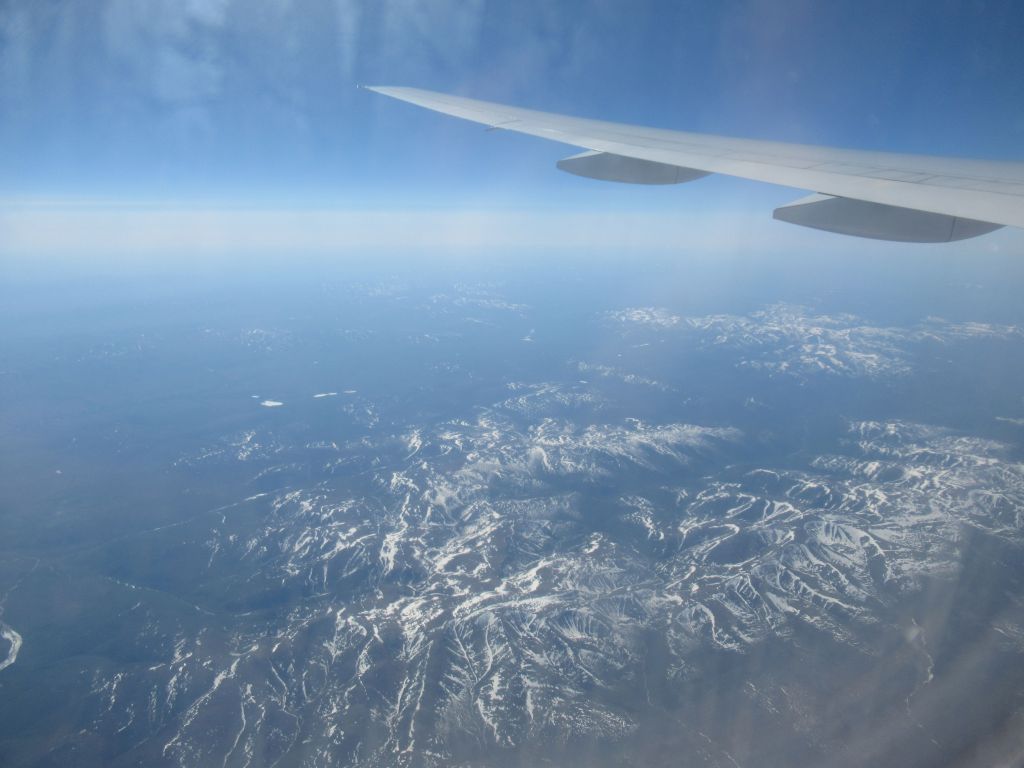
I took advantage of my neighbors going to the toilets to do the same. Nothing special to report about them:
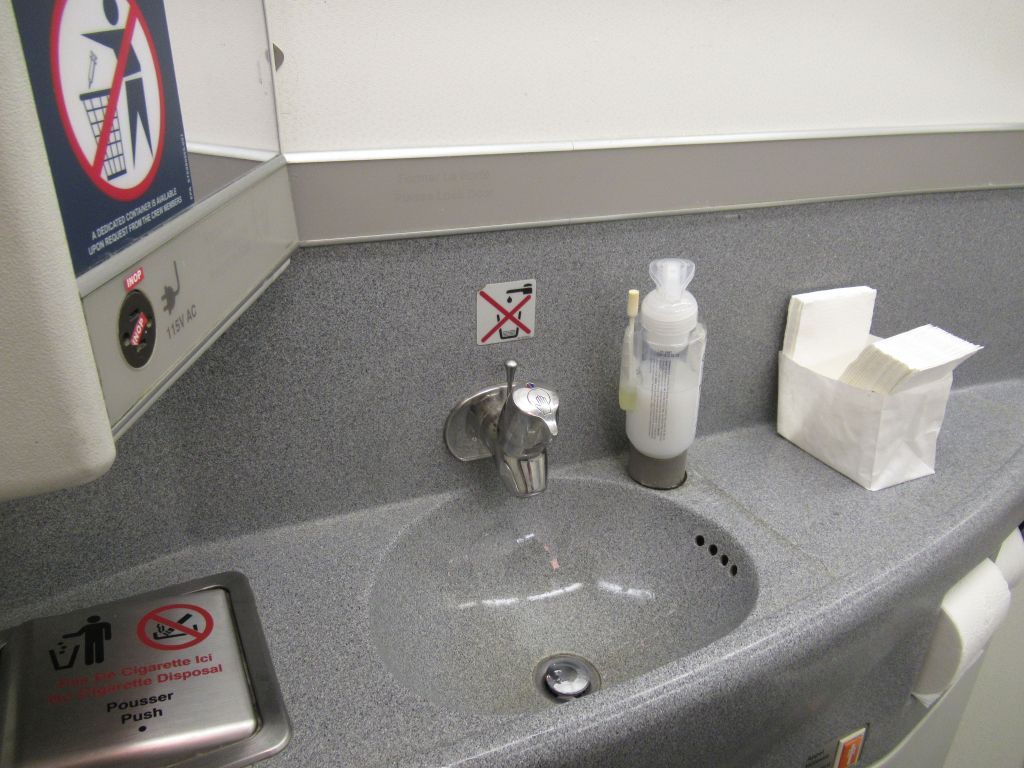
This folding seat is for use by the FAs for eating their meals in the rear of the galley, and for taking some rest.
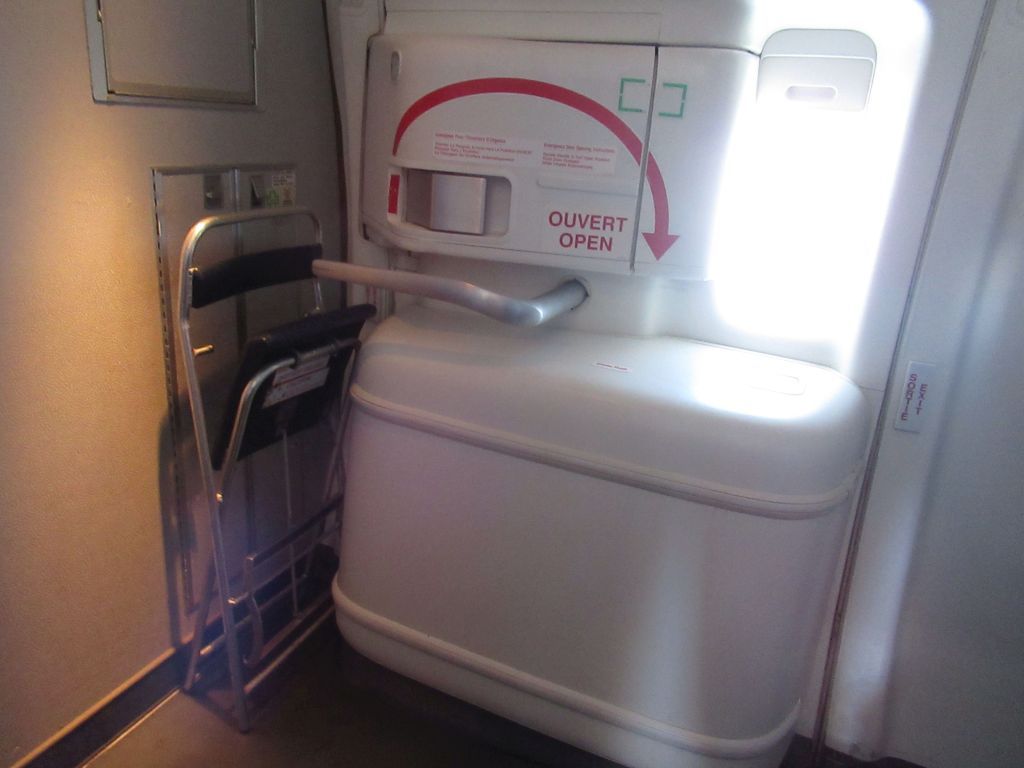
Self-serve drinks in the galley

A FA had the passengers lower the window blinds after the meal: was AF taking the wrong track of KE that I now boycott due to their non-negotiable policy of darkening the cabin during day long haul flights, in both Economy and Business class ? I lowered the shade halfway and no FA came to object about this. What was the point of having a dark cabin when the amenity kit contained a blindfold in Economy too ? (but KE does not provide any on day flights…).
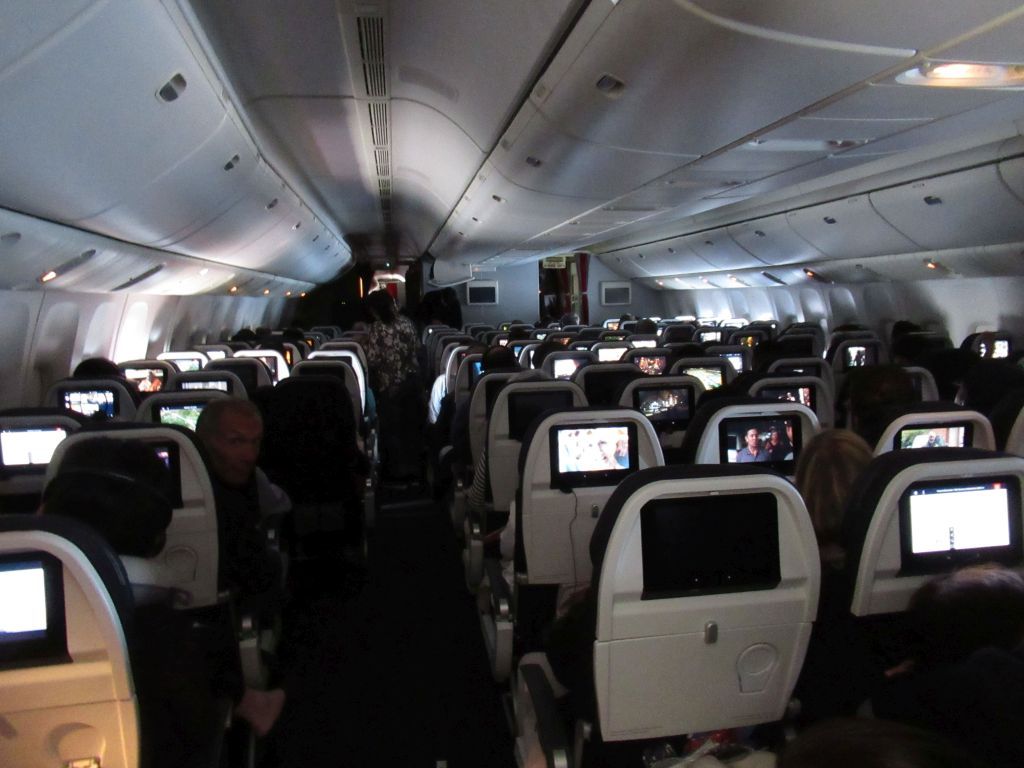
The same FA came back five hours later, while I was still working on this flight report.
- Monsieur Marathon, is everything OK ? Do you need anything ? Do not hesitate!
Much like the somewhat insistent proposal for a tiny bottle of alcohol at the end of the meal (it was well meaning, but I never drink alcohol), this concern looked very much like an attempt at Platinum passenger care that the presence of two Japanese passengers between the aisle and myself did not facilitate. I did not need anything, actually, apart from not being forced to lower my window blind, and that was never requested.
What I did notice was that the FAs managing my area in the aircraft only smiled when they addressed a passenger directly: the smiles disappeared as soon as they looked back to the trolley or whatever else. It was a stark contrast with my experience on Finnair six months earlier: on all four flights connecting in HEL, the FAs smiled at all times.
Let’s take a break with a look at the IFE:
The games menu is identified by a game handle pictogram, but there is none: the only interface is the touchscreen, which in my opinion is not a good design, because this is likely to be a nuisance for passengers sitting resting on the other side of such thin seats

The graphics of the airshow are neatly detailed and the touchscreen very reactive.
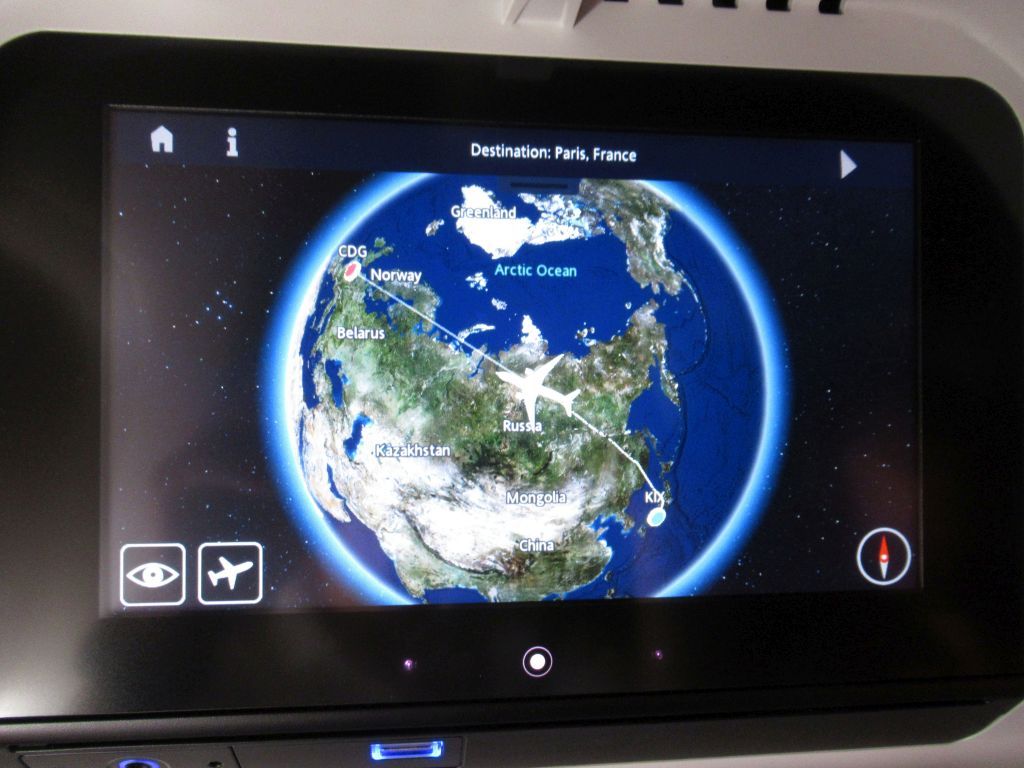
The touchscreen is fortunately very reactive, because it reverts to cycling between the various display modes as soon as you stop using it and you must return to the relevant display if you want to know where you are approximately.

« Approximately », because you can "turn around the plane" at will, which is initial fun, but the plane is especially imprecise. In this regard, this airshow is really frustrating if you want to identify a place that you do not know.

A funny software bug gradually obliterates the plane and her trajectory if you zoom in enough.

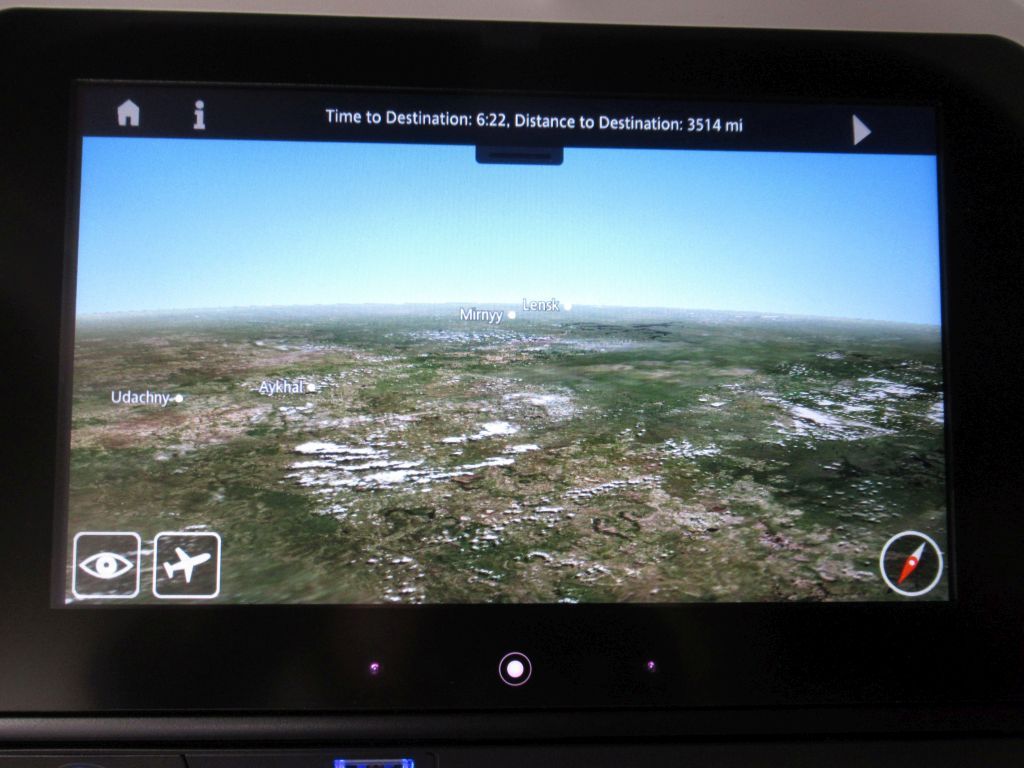
For the record, the « cockpit style display » which I find rather useless.
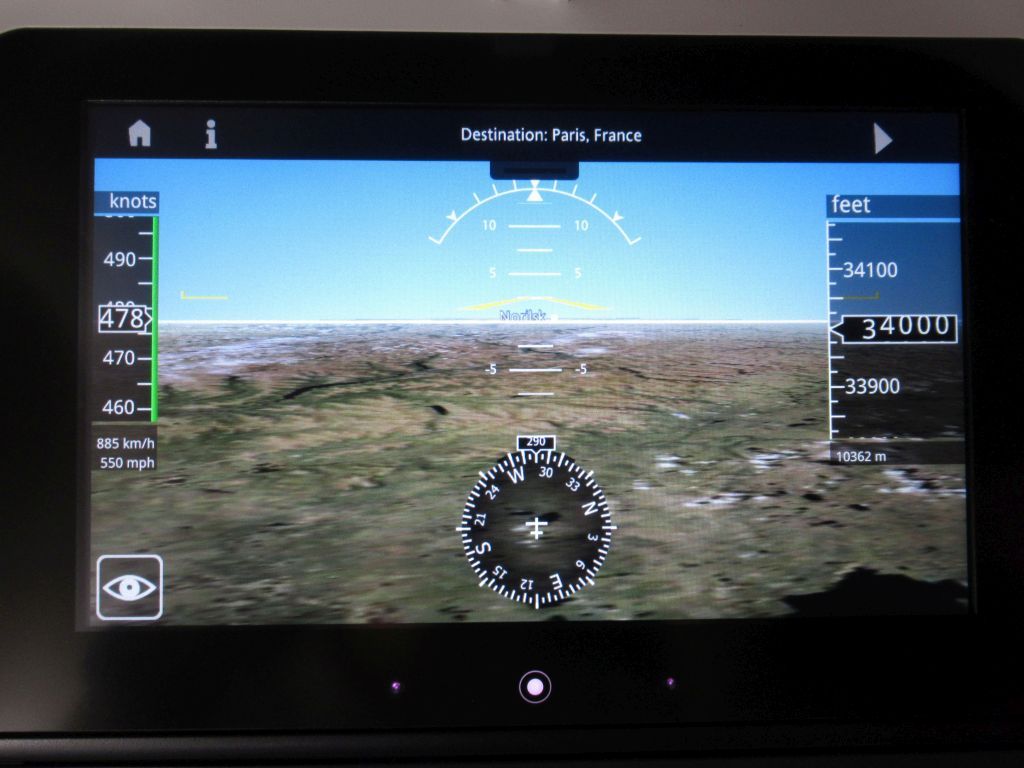
A meditation program ? No thanks, I have had ample time to meditate while in Japan !
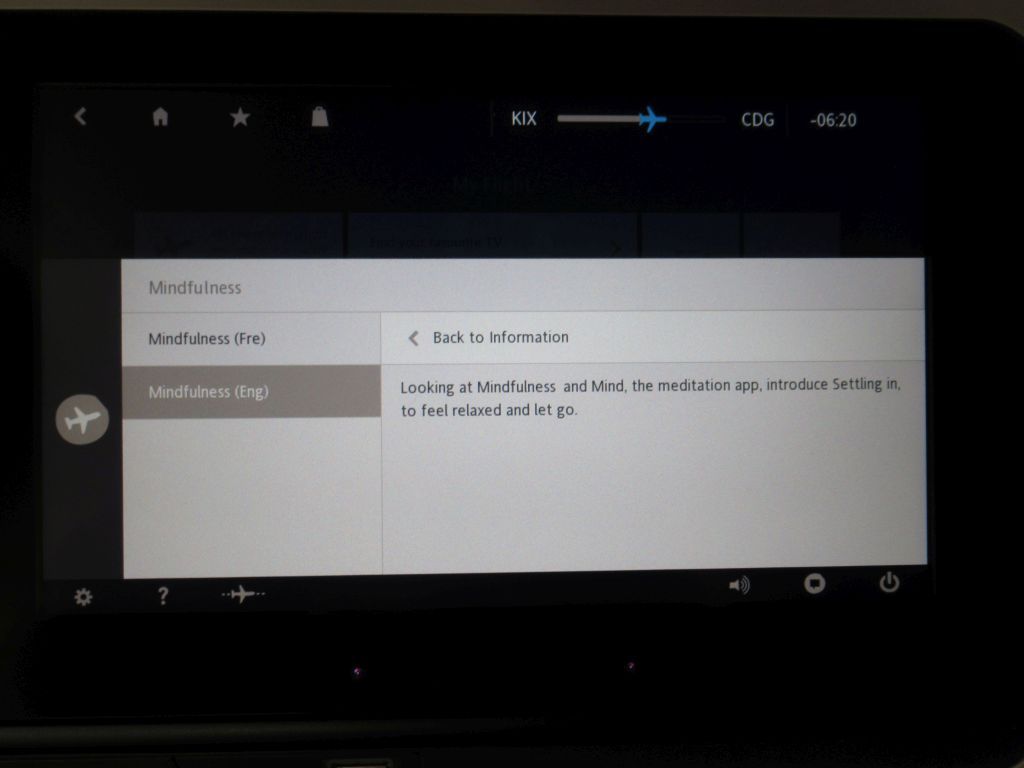
The selection of classical music was decent. I am always annoyed that the record labelling focusing on the interpreter, not the works themselves, identified by the composer’s name only if it appears at all: you need to select the recording to know more about it. Readers can object that the precise works of Haendel were less important to me than the voice of Philippe Jaroussky when I selected this program.
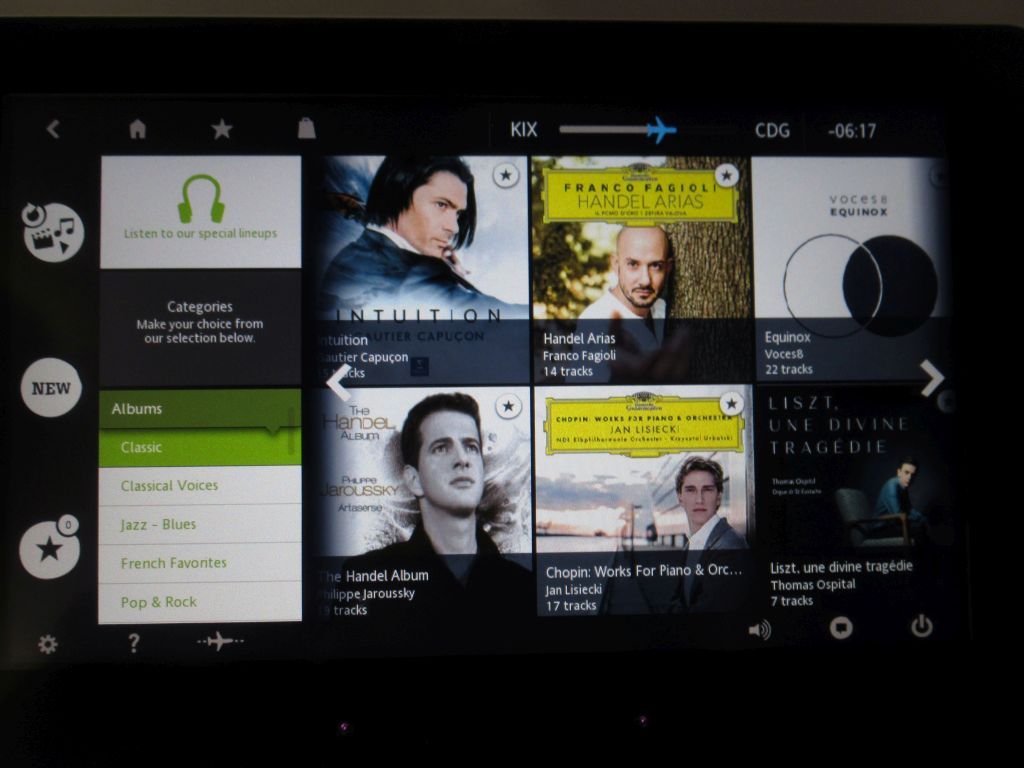
A very small ice cream was distributed halfway into the flight.
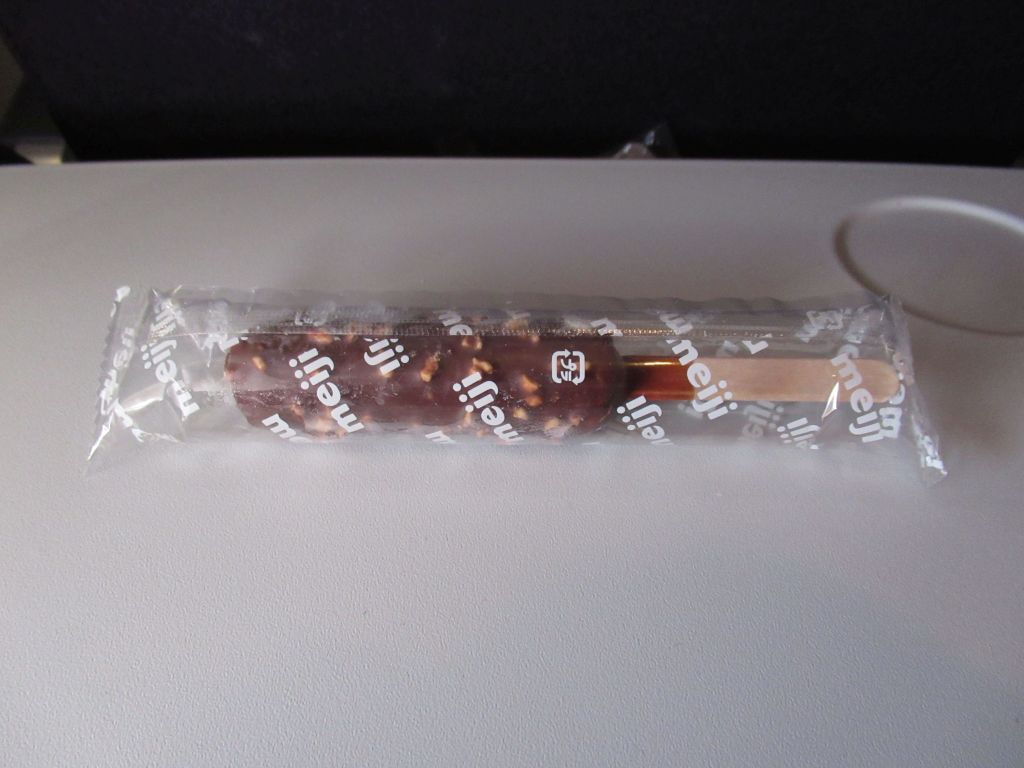
My neighbors went to the galley and brought back these small sandwiches which were probably for self-service. I missed this opportunity and did not want to disturb them to go and get some.
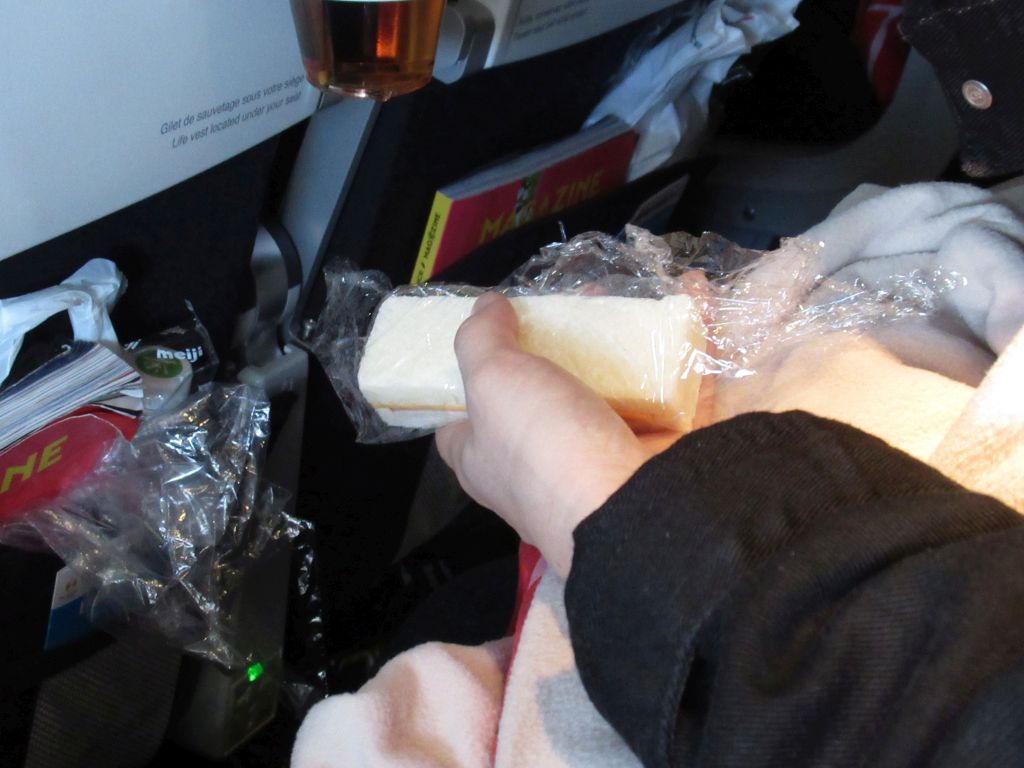
A brief view of the frozen Sea of Barents

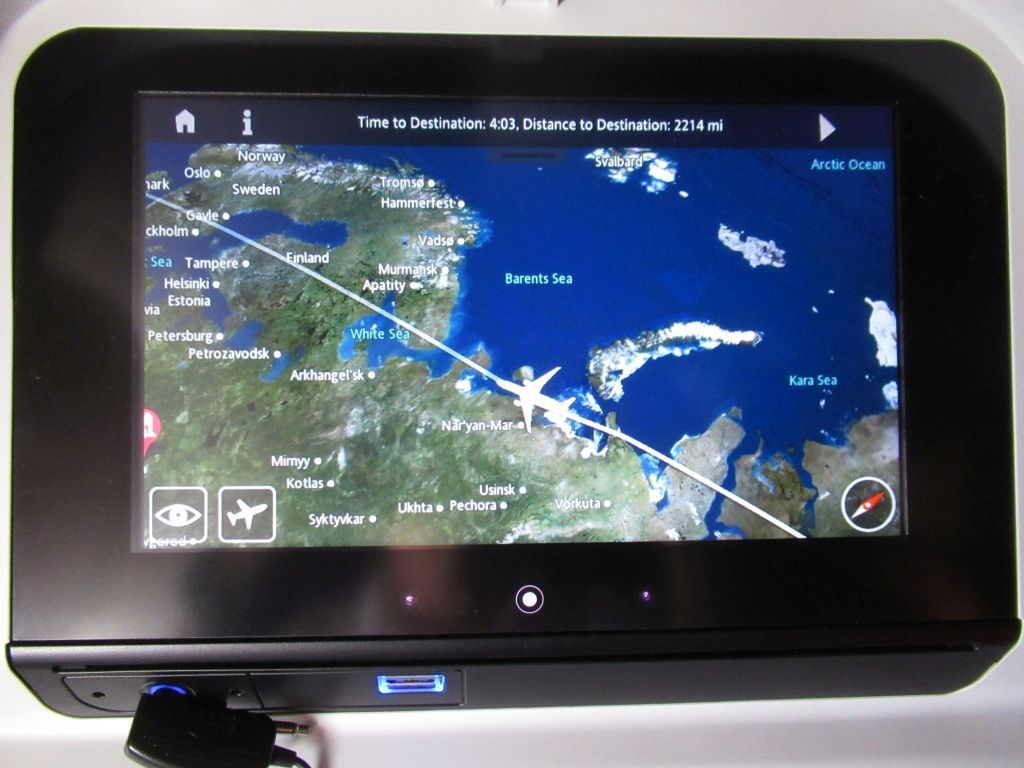
Distribution of a "refreshing wet towel" which was hardly either, no less than an hour and a half before dinner was served.
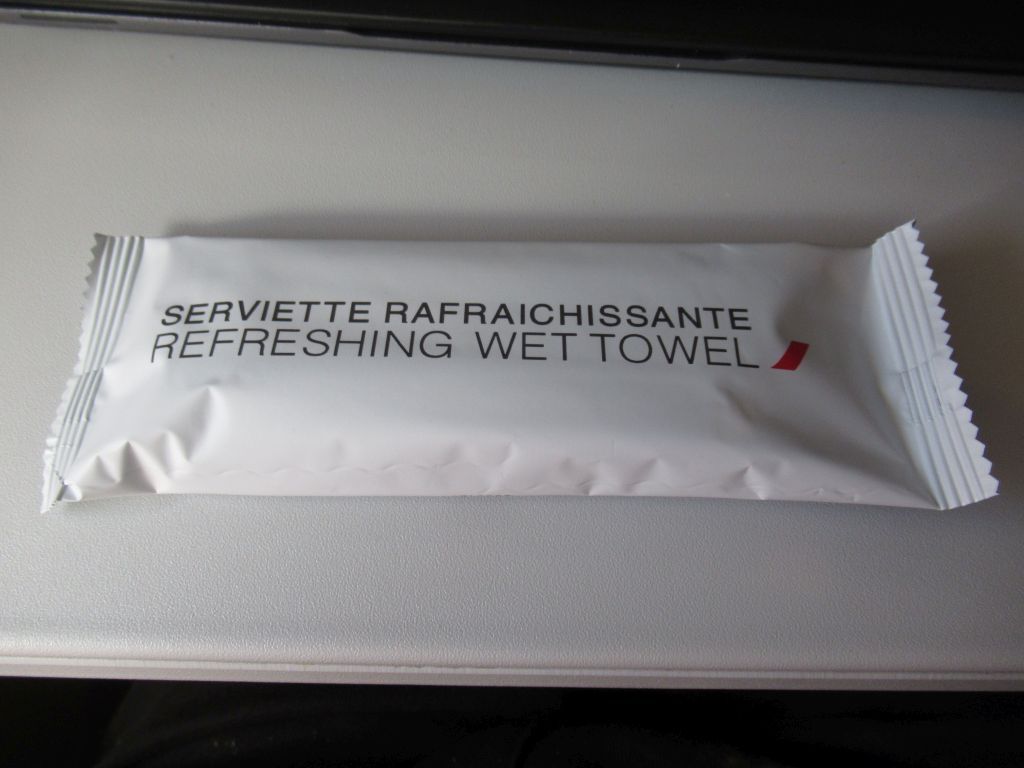
The sky cleared up, but these scattered clouds did not help localization.
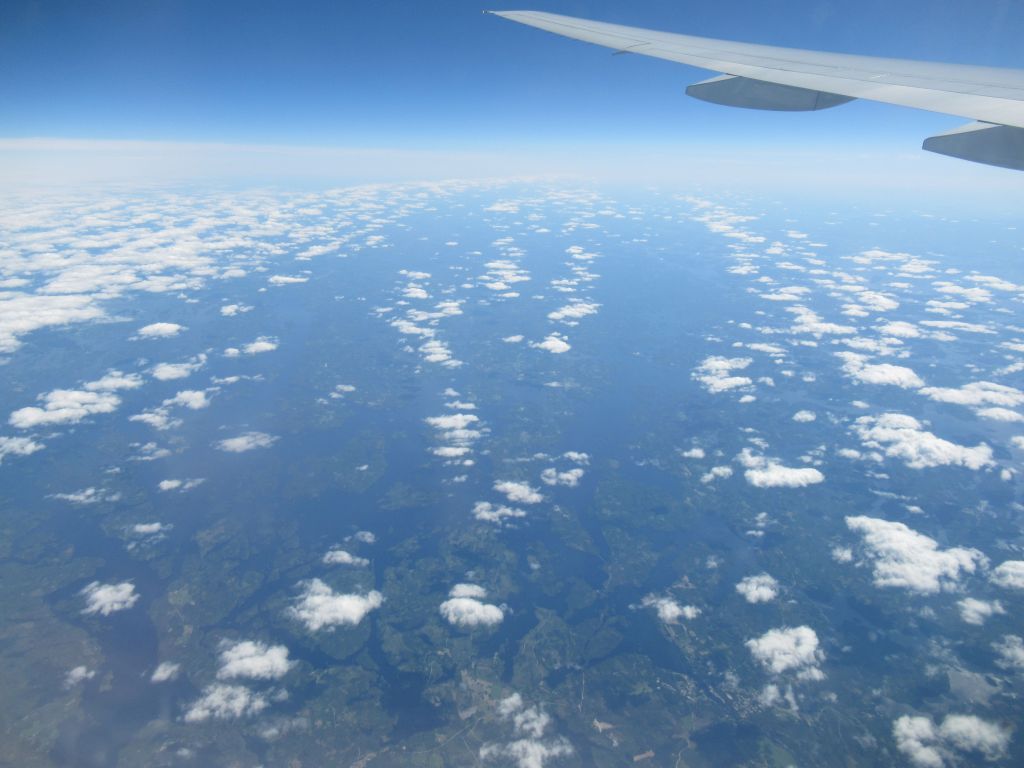
Where are we now, actually ?
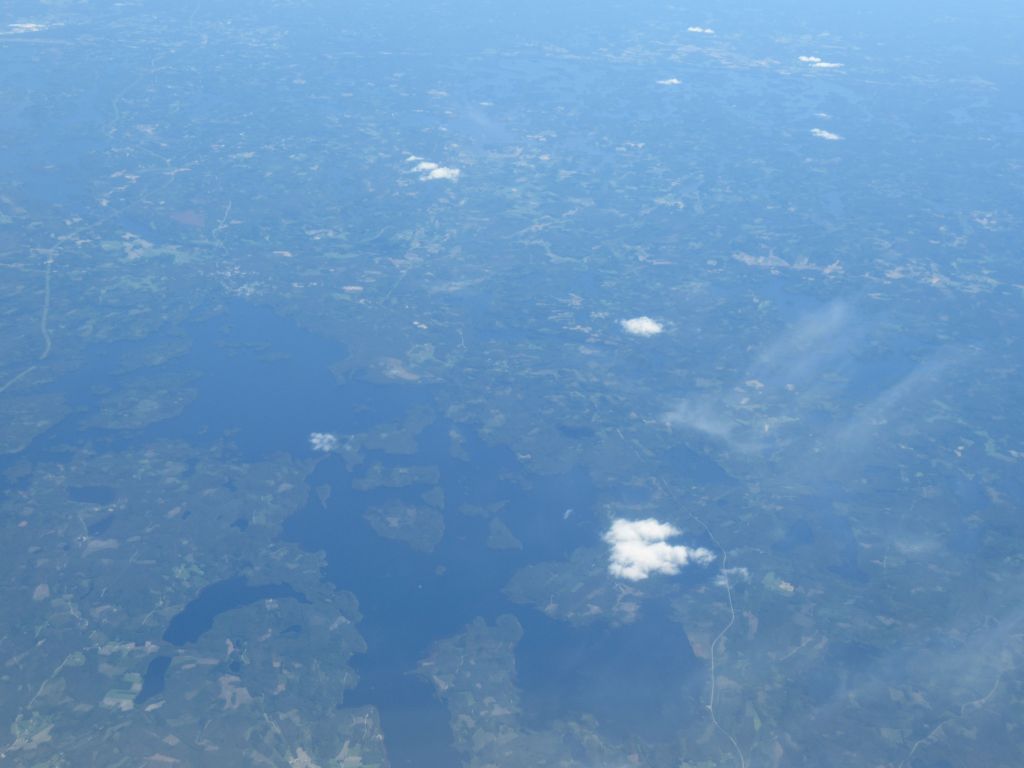
I could not rely on the moving map to have an answer to this question: it was unfortunately not designed for that.

Only after I was at home did I identify the airport of Lappeenranta (LPP).
(Readers will easily tell the difference between raw pictures and pictures with enhanced contrast, it what follows.)

Same issue in this Finnish landscape:
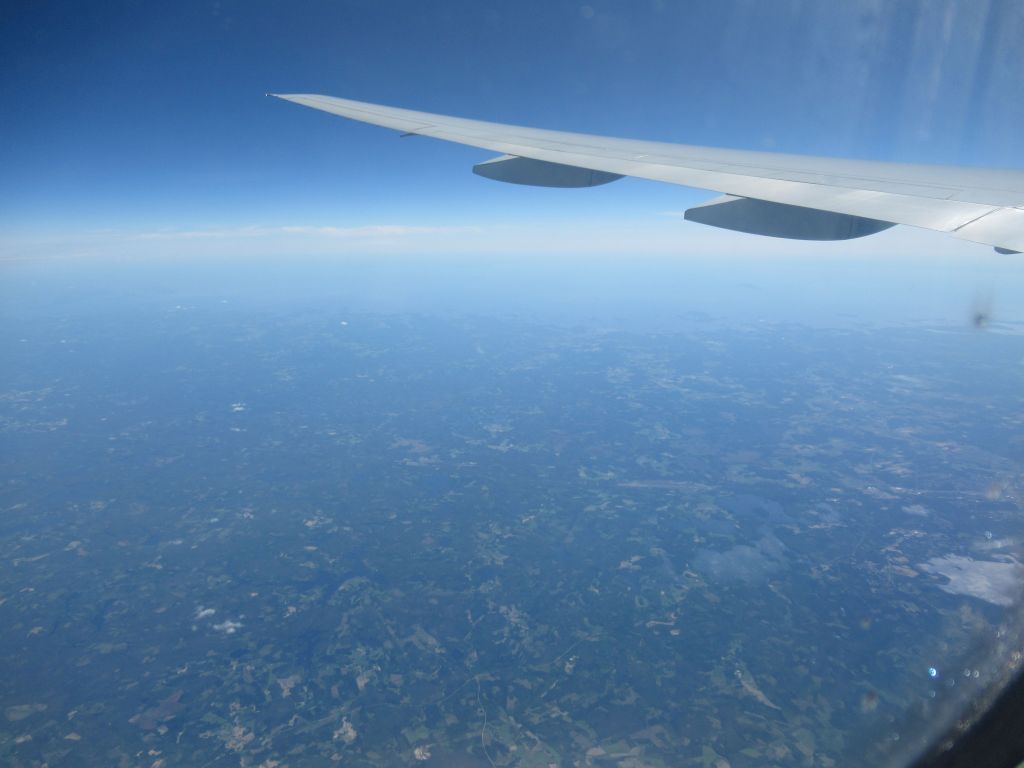
The eye is attracted by this airport, but the moving does not help.

This was the city of Kovoula (right) and the military airport of Utti (UTI) on the left.
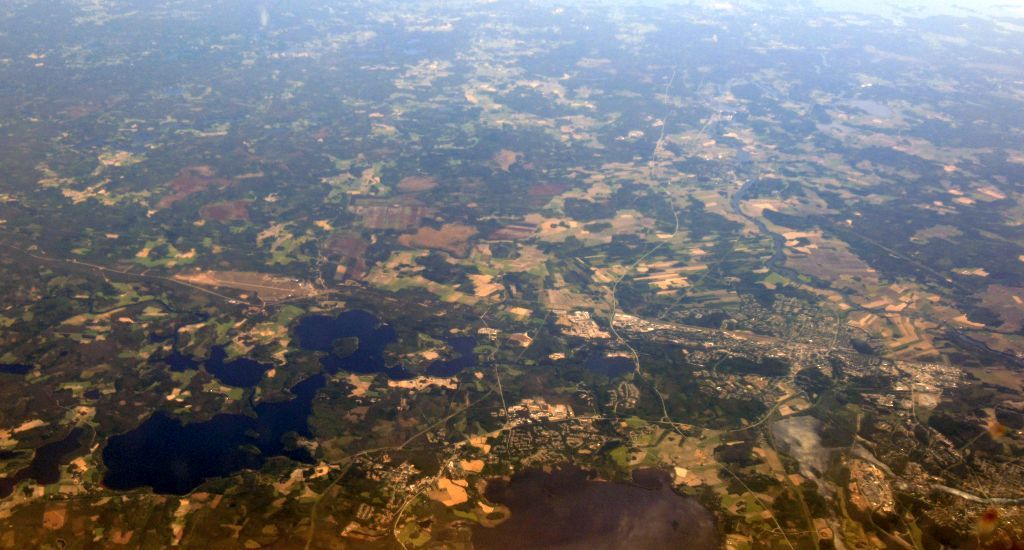
Zoom on UTI
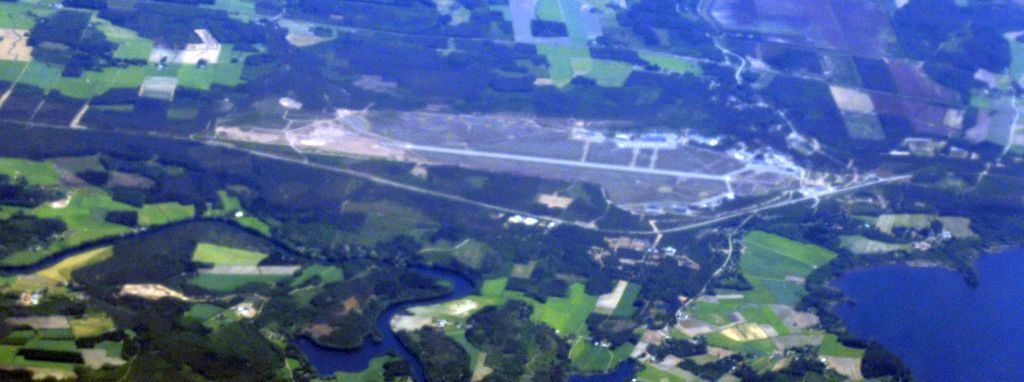
And on Kovoula
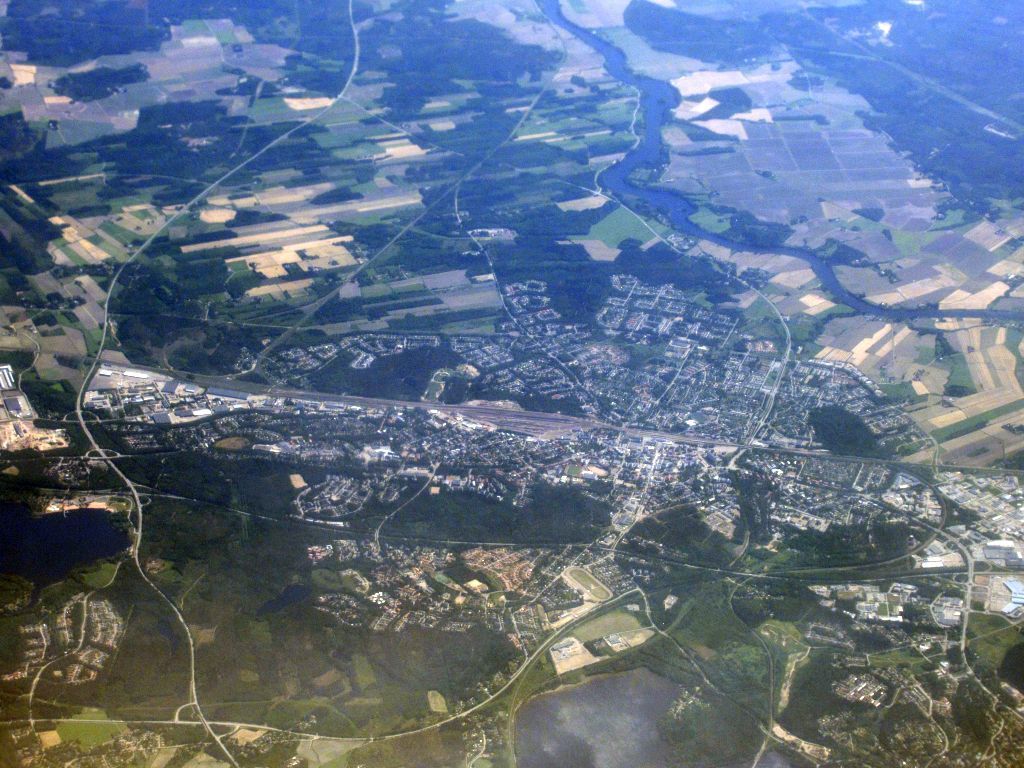
Now reaching the Baltic Sea
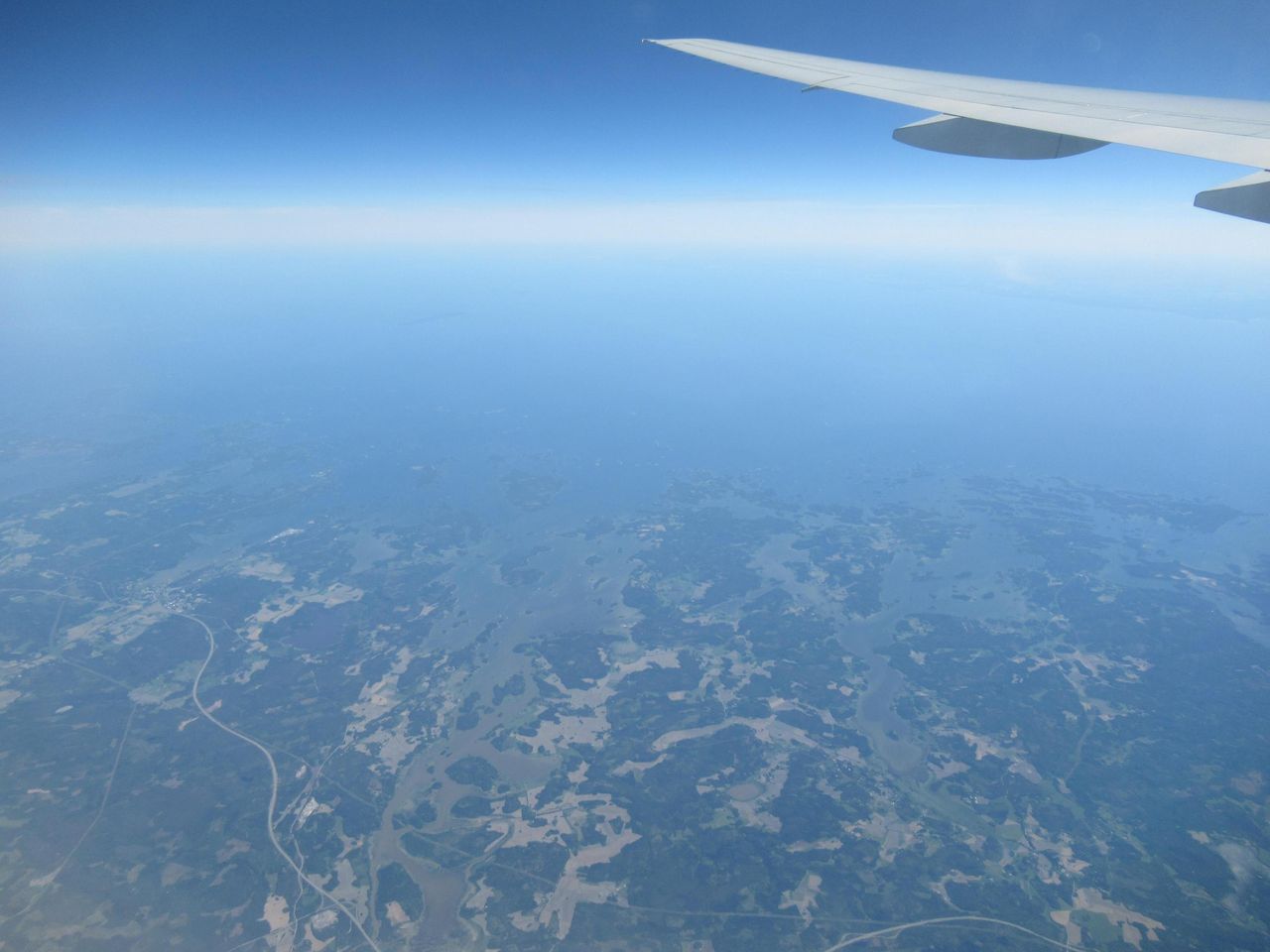
The plane was actually much further south than the moving map was showing so I could not see Helsinki (I wonder why the trajectory was this wrong ?).
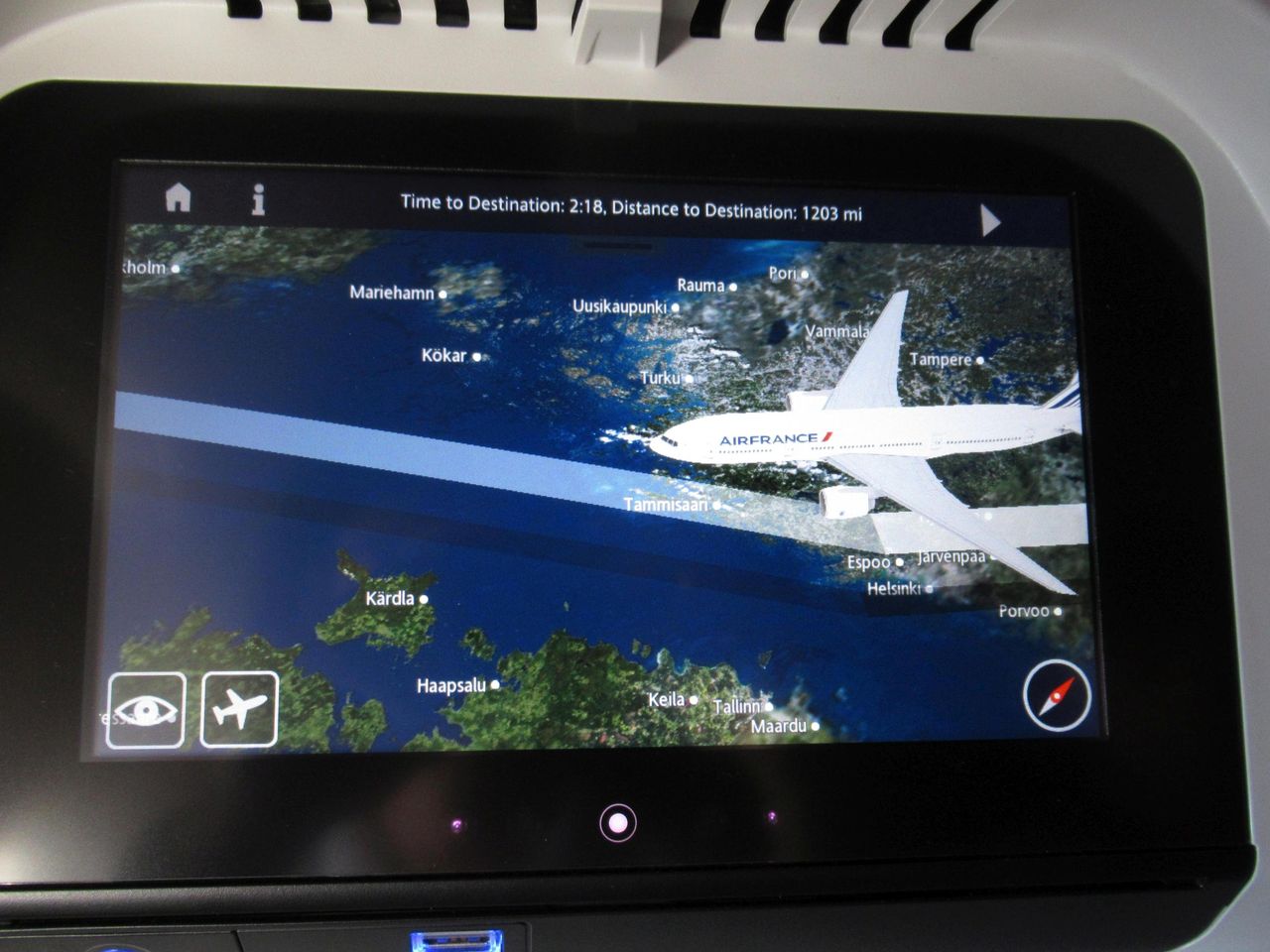
This very good view of Tallinn on the south shore of the Baltic Sea was proof for it.
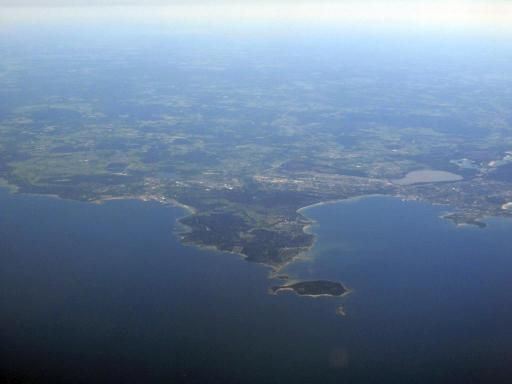
Tallinn Airport (TLL)
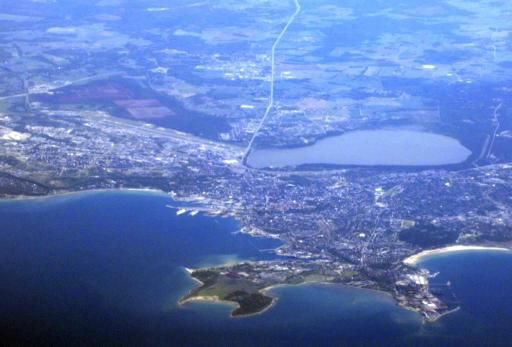
Ämari Air Base (EEEI)


The small Kiltsi airbase which was abandoned after Latvia declared independence from the crumbling Soviet Union.
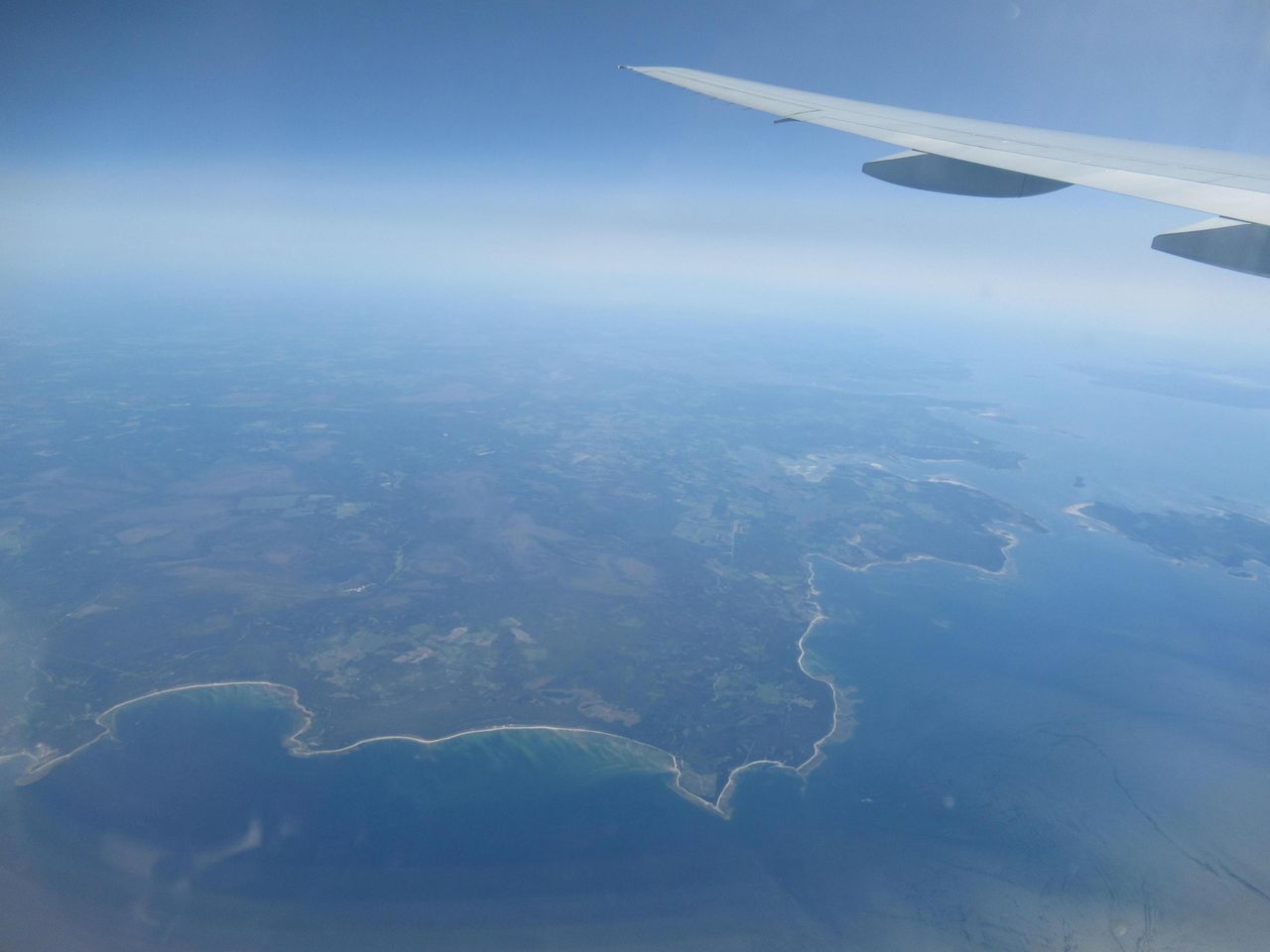

Hiiumaa Island
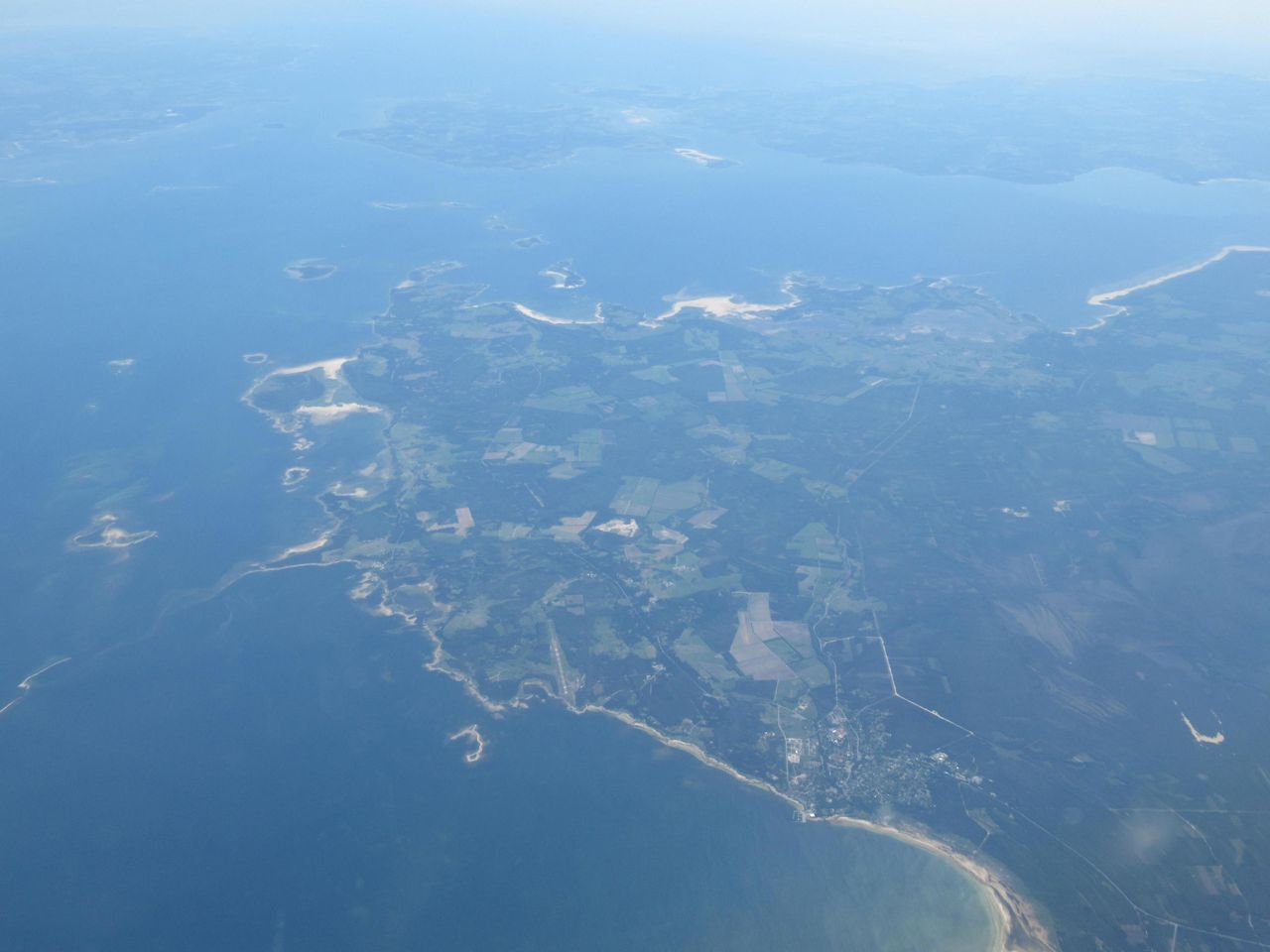
Zoom on Kärdla Airport (KDL) which now has flights to TLL only.
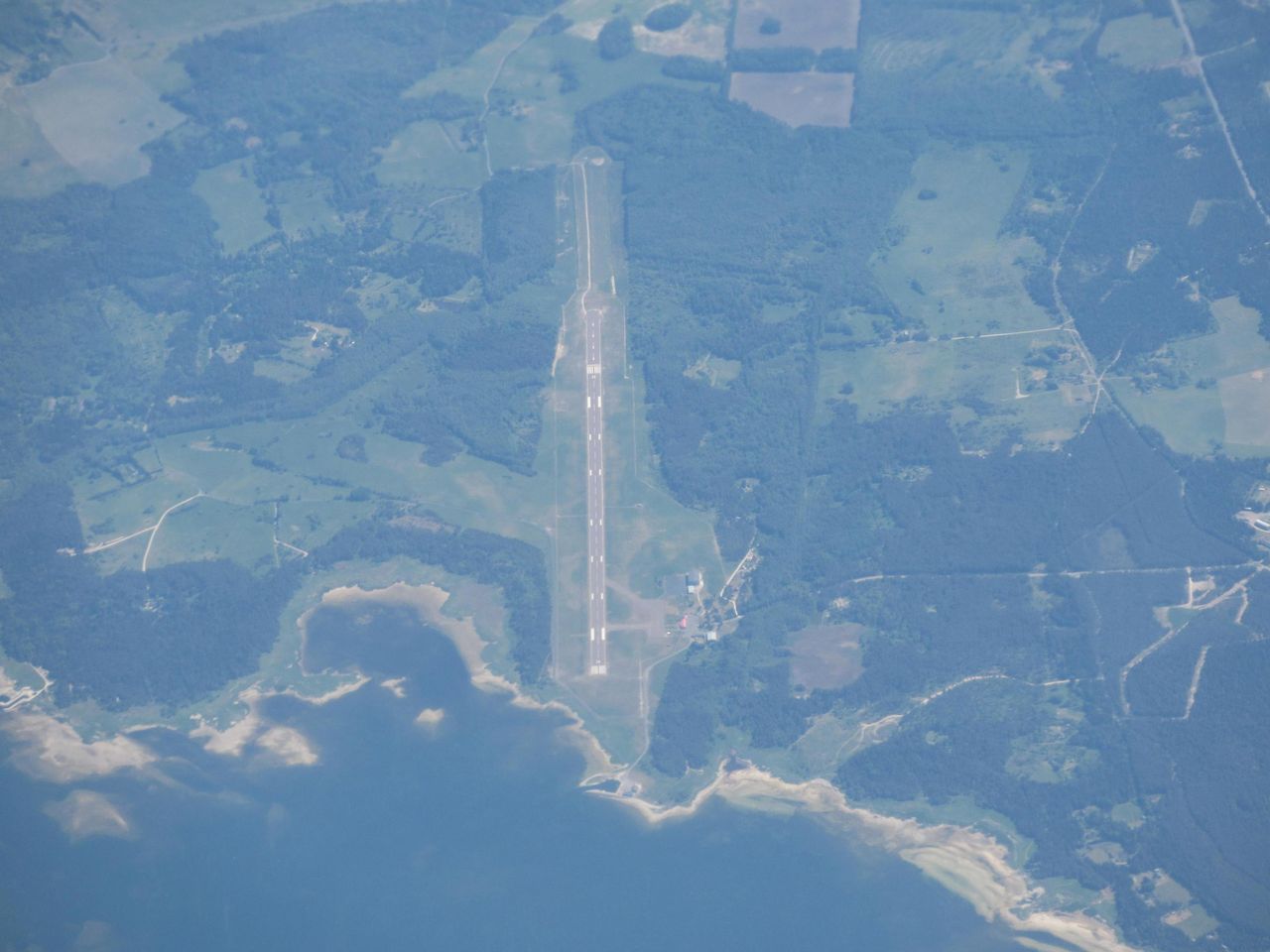
Gotland Island is a favorite vacationing location in Sweden. Bad luck: the plane flew just on top of Visby and its airport (VBY), a medieval town which has been included by Unesco in its list of World Heritage sites.

The southern end of the very long and narrow Öland Island
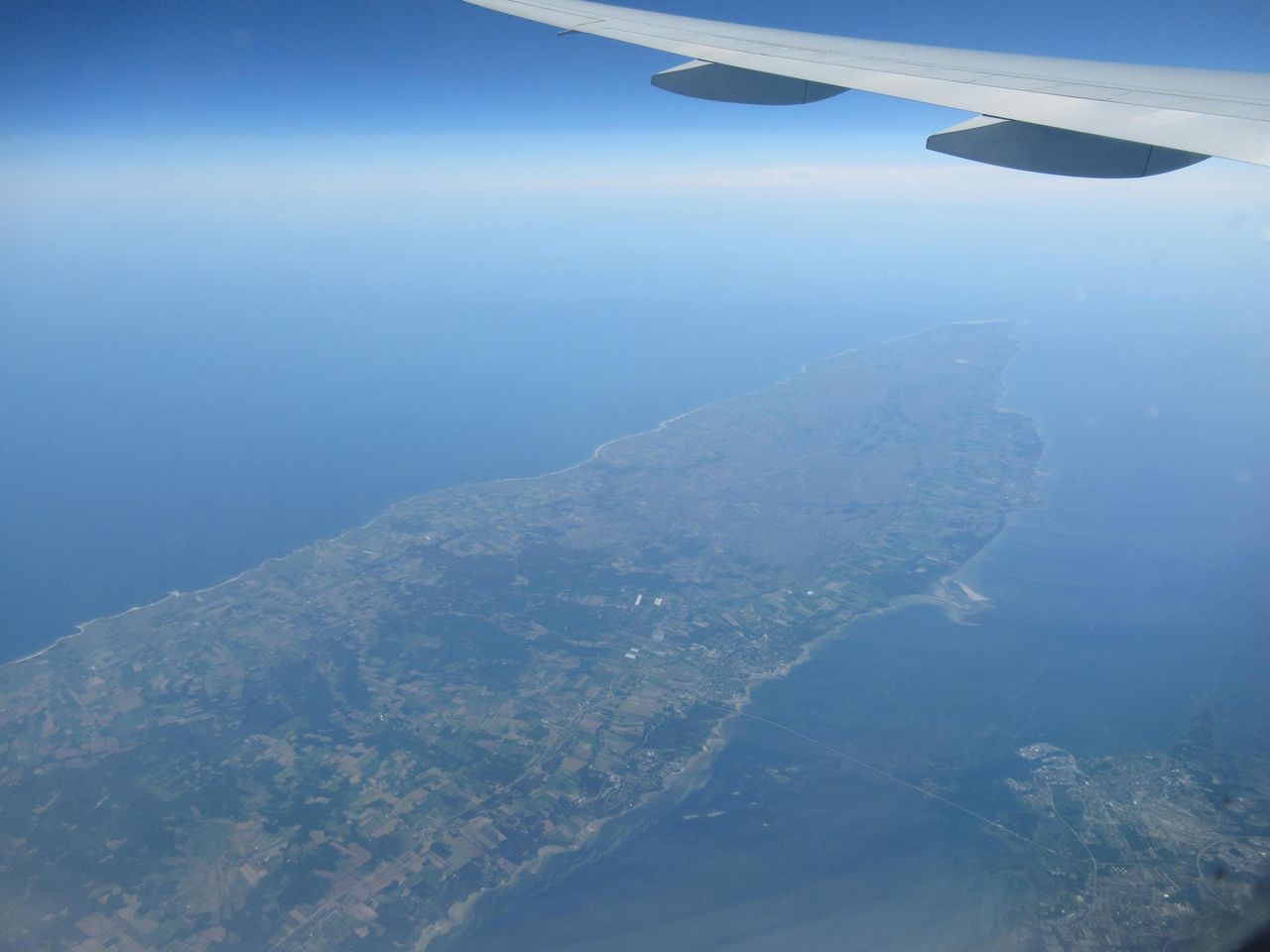
Öland Bridge which links it to the city of Kalmar on the mainland

Only by sticking my camera to the window did I manage to take a picture of KLR, Kalmar’s airport.
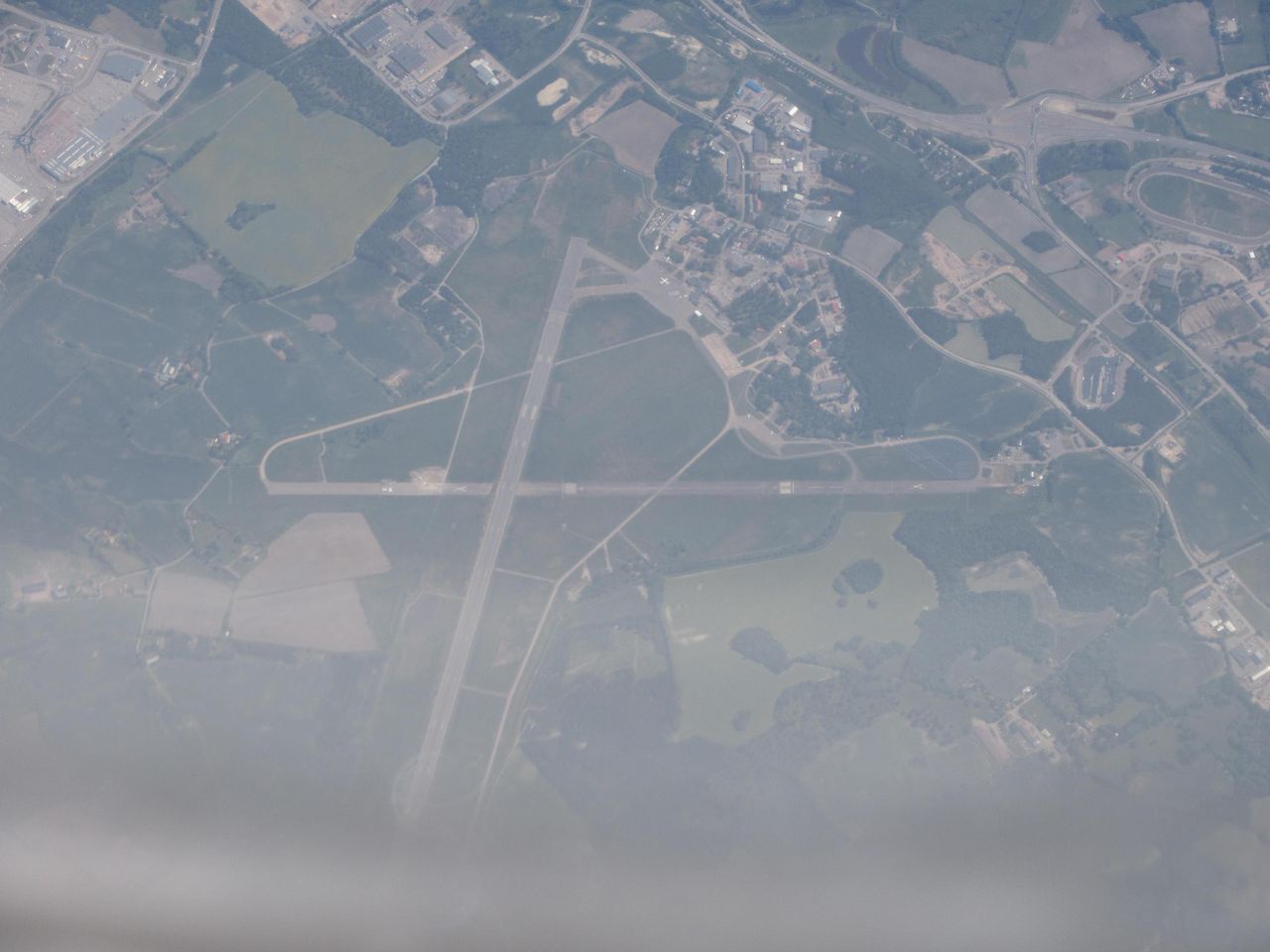
As always keen on culture, the Soviets were so fascinated by the Naval Port of Karlskrona, listed by Unesco on the World Heritage List that they tried visiting it with a submarine in 1981. Forked tongues hint that they were interested in the modern navy base too.
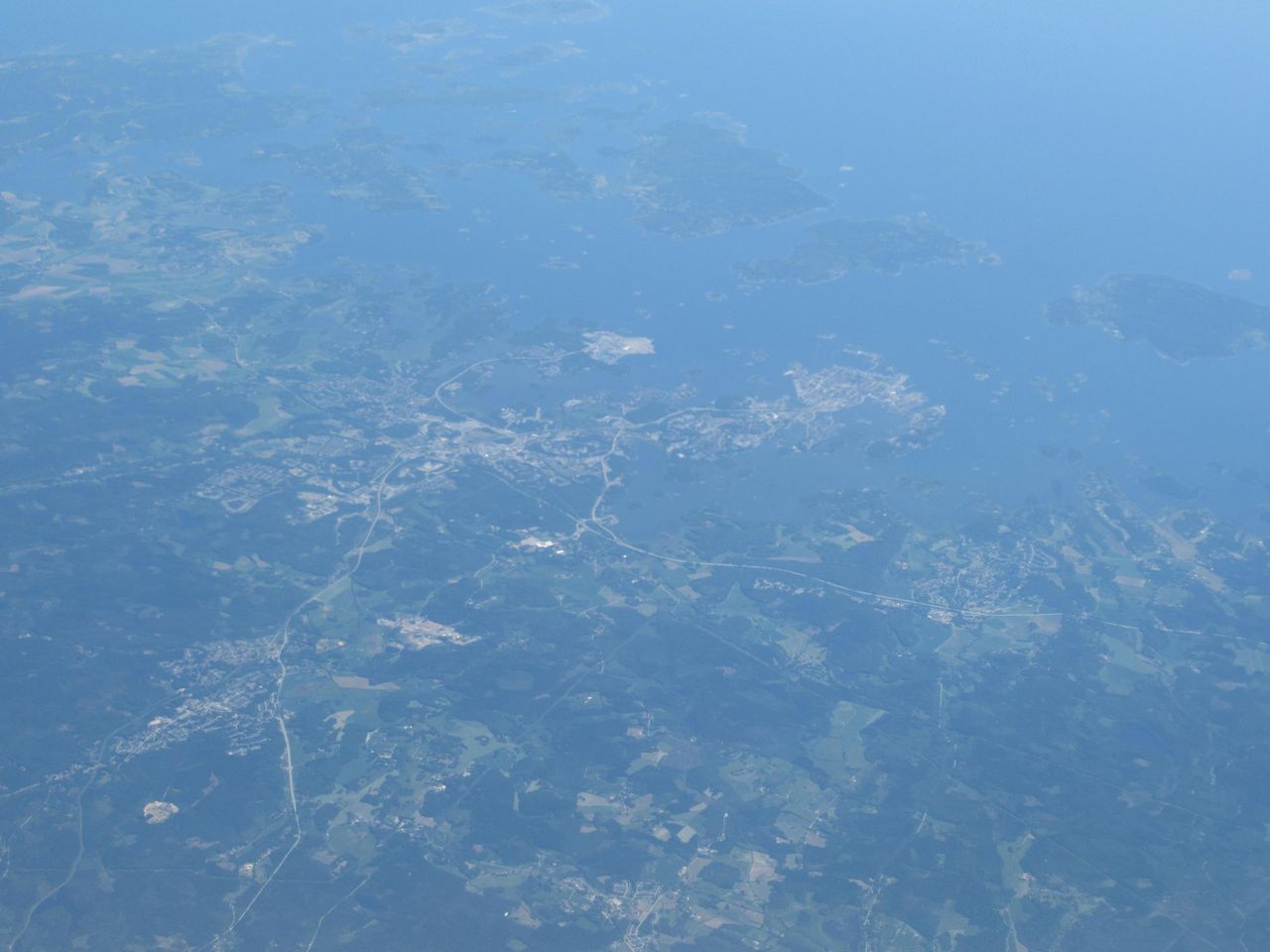
The last Swedish towns I saw, in Scania: Tomelilla
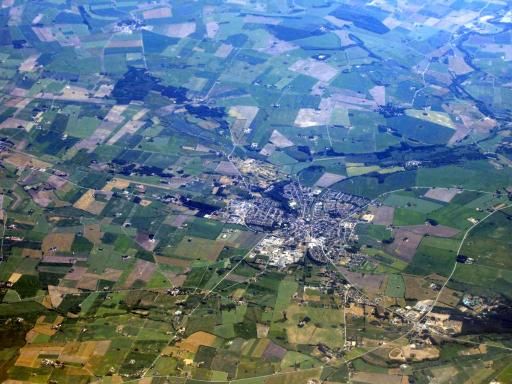
And Ystad, made famous by Kurt Wallander, the main character in a series of police novels
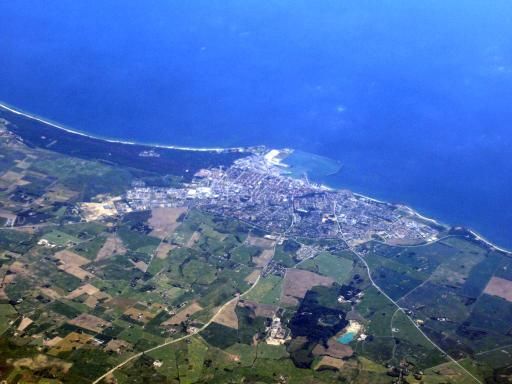
The dinner (same for all passengers), as served
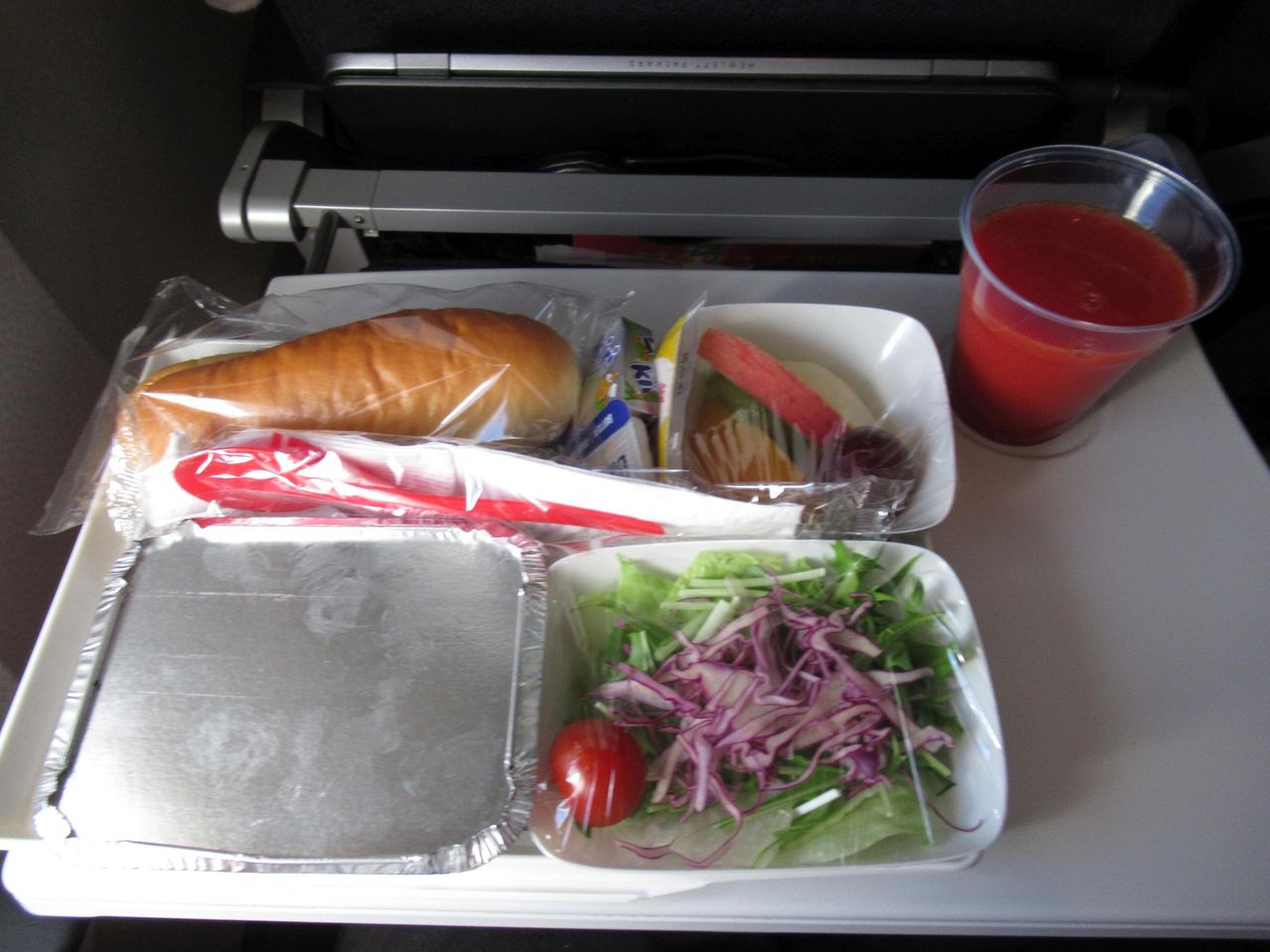
The same after unwrapping. There wasn’t much to eat: I was hungry when I made it to home ; maybe I was used to have very hearty meals in Japan, compensating the significant daily exercise.
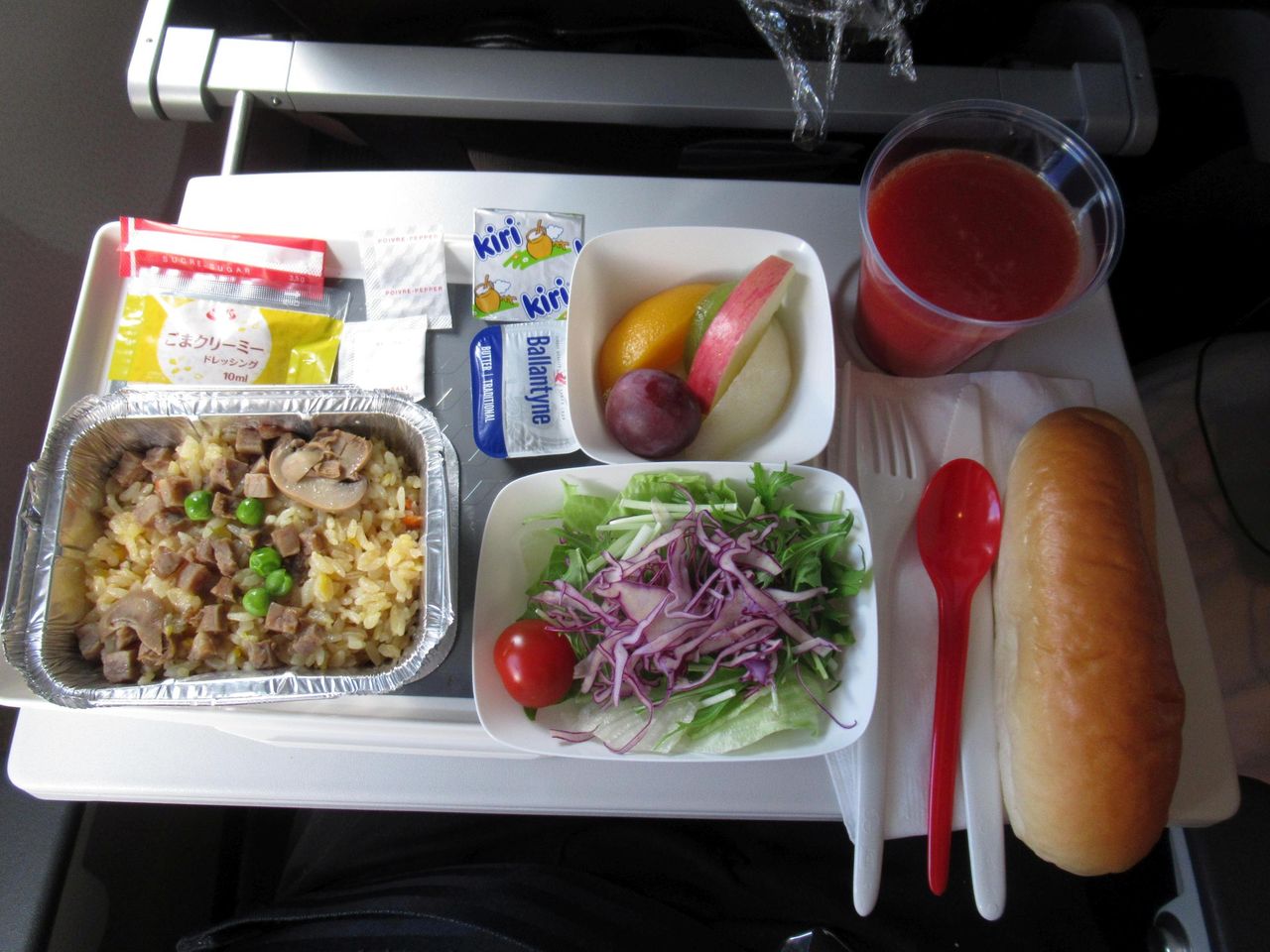
Compacting the wrappings was easy; they were collected before I had really finished this favorite game of mine.
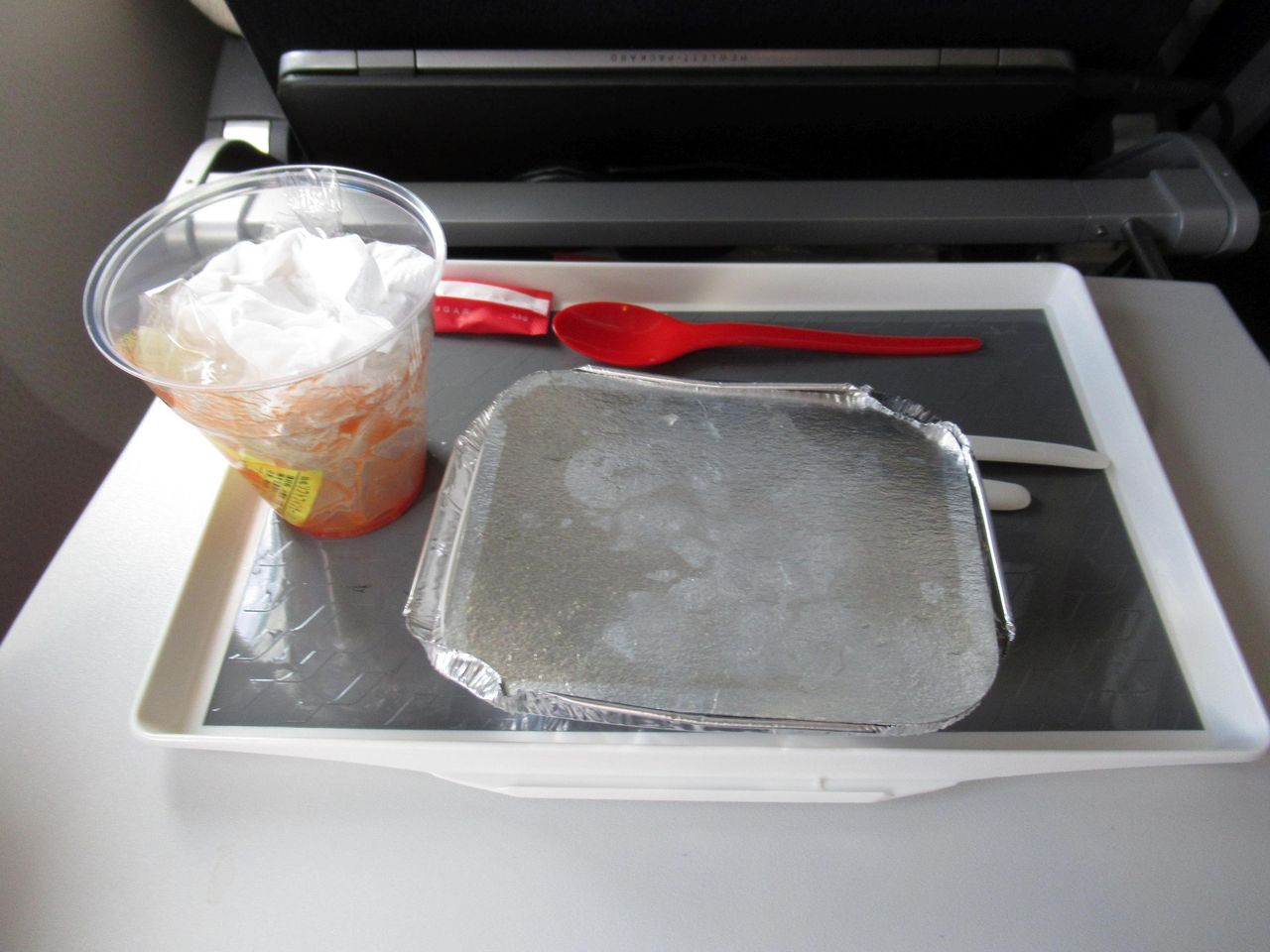
A cup of coffee or tea was served afterwards
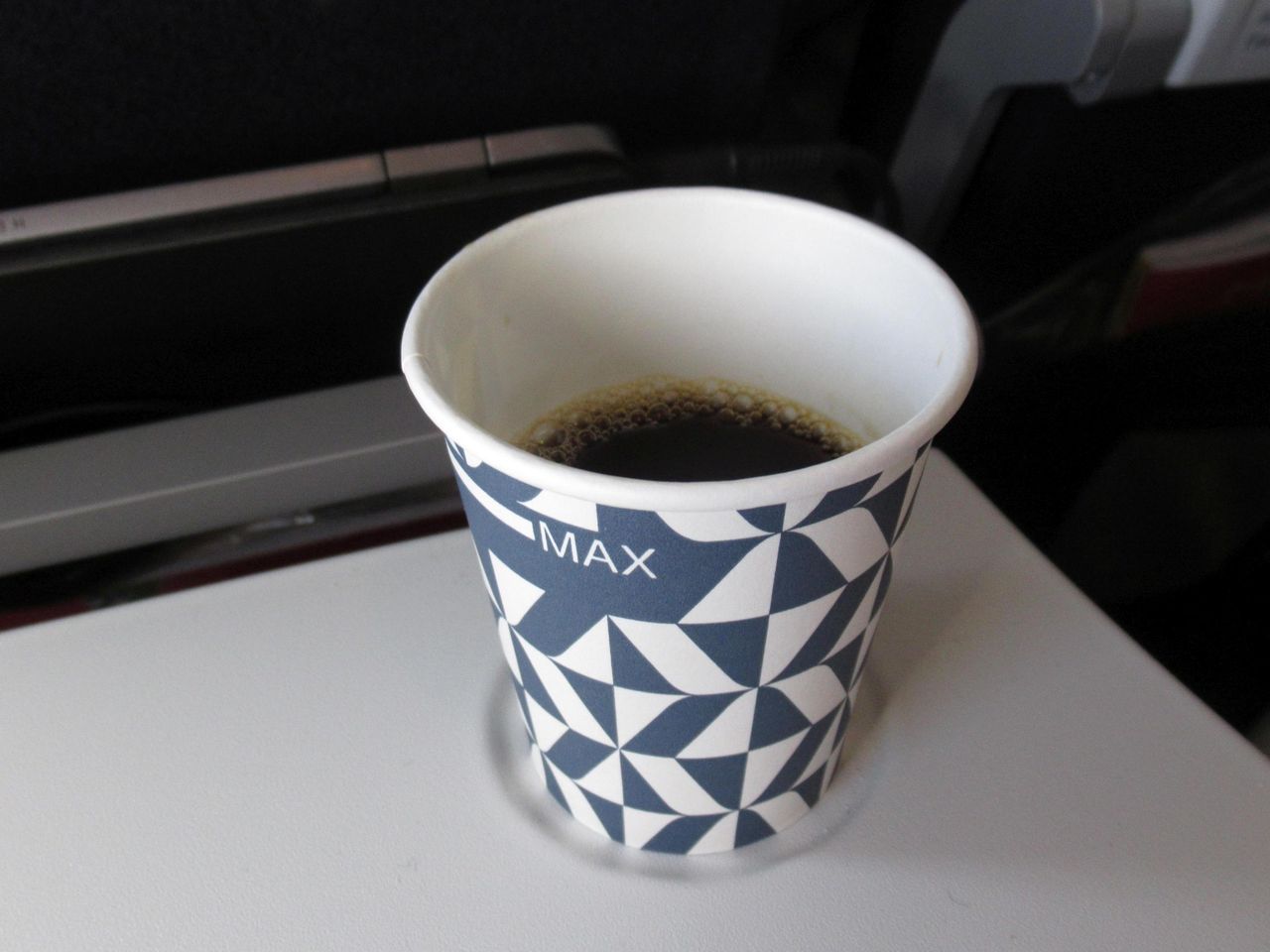
The harbor cities on the German Baltic coast: Rostock
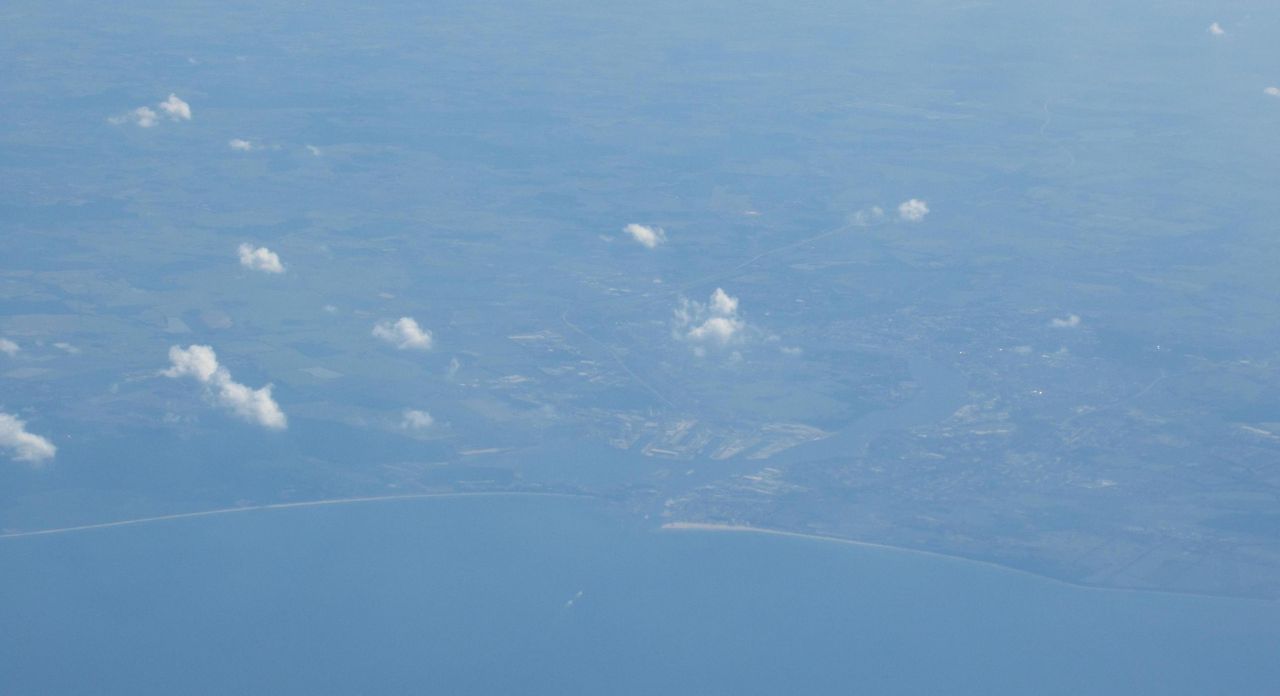
And Wismar

The cloud cover closes again
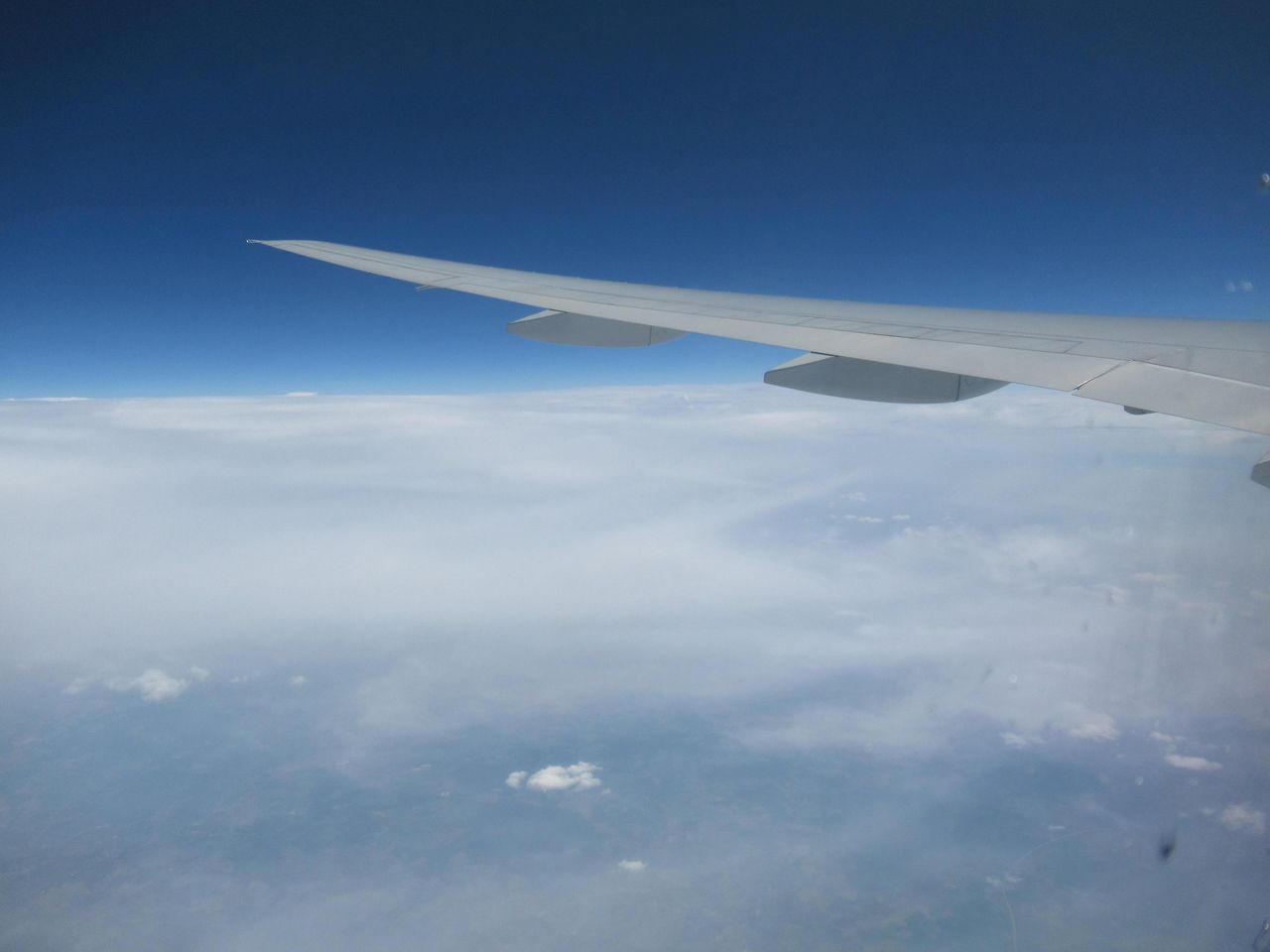
Munster (not to be confused with Münster), spotted through the clouds

Herford, just north of Bielefeld
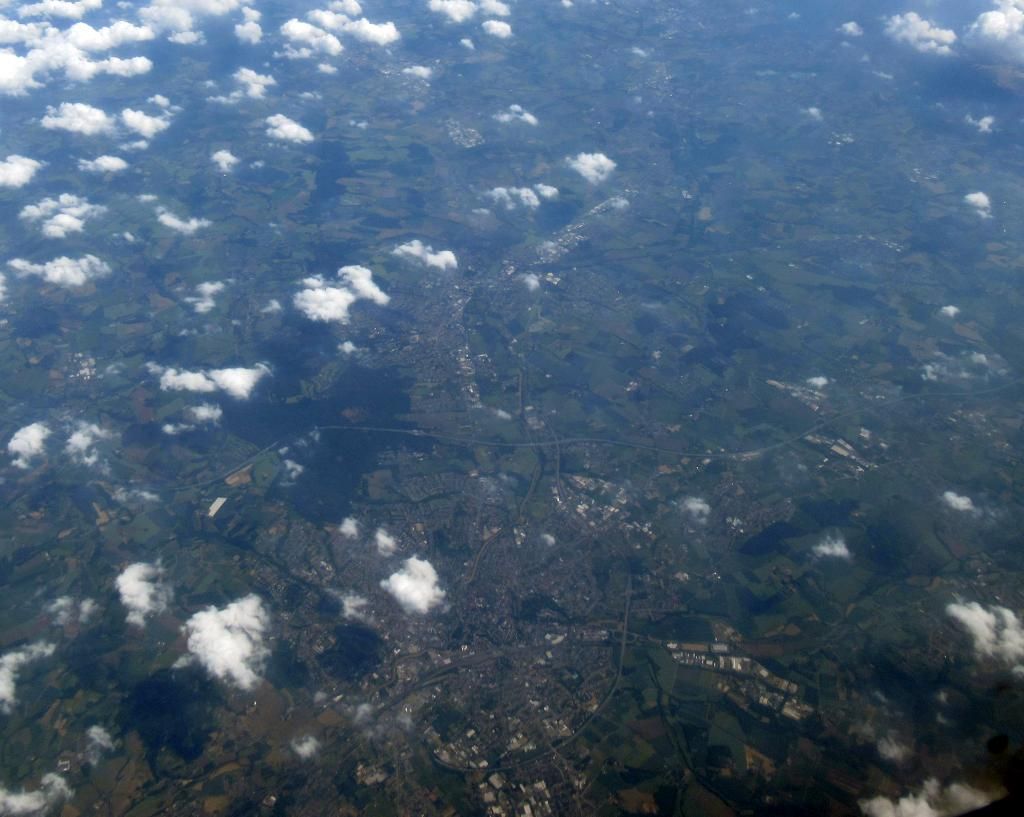
When the skies cleared up again, I did not focus on the charming historic center of Soest, carefully restored after the bombings and ground fighting at the end of WWII. It took me some time to identify it because the trajectories on Flightradar24 appeared to have been shifted dozen kilometers south-east.

This was Flight TK9 (IST-LAX), operated by TC-JJJ (interesting number, by the way), a 777-300ER

The meanders of the Ruhr River in Neheim. This tributary of the Rhine River is mostly known for having given its name to the homonymous industrial region.
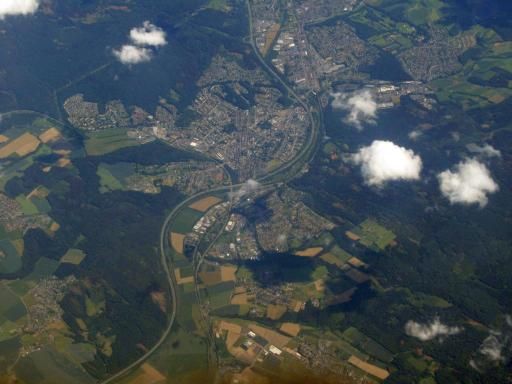
Unlike the Möhne and Edersee dams, and despite taking a hit, the Sorpe dam resisted to the British bombing in the night of May 16th, 1943 aimed at flooding the Ruhr, and a later attempt in October 1944.
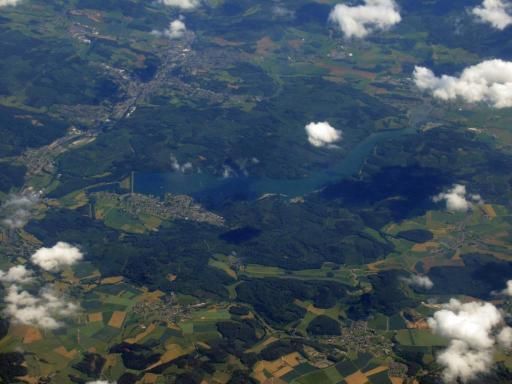
The Rhine River in Bonn, through the clouds
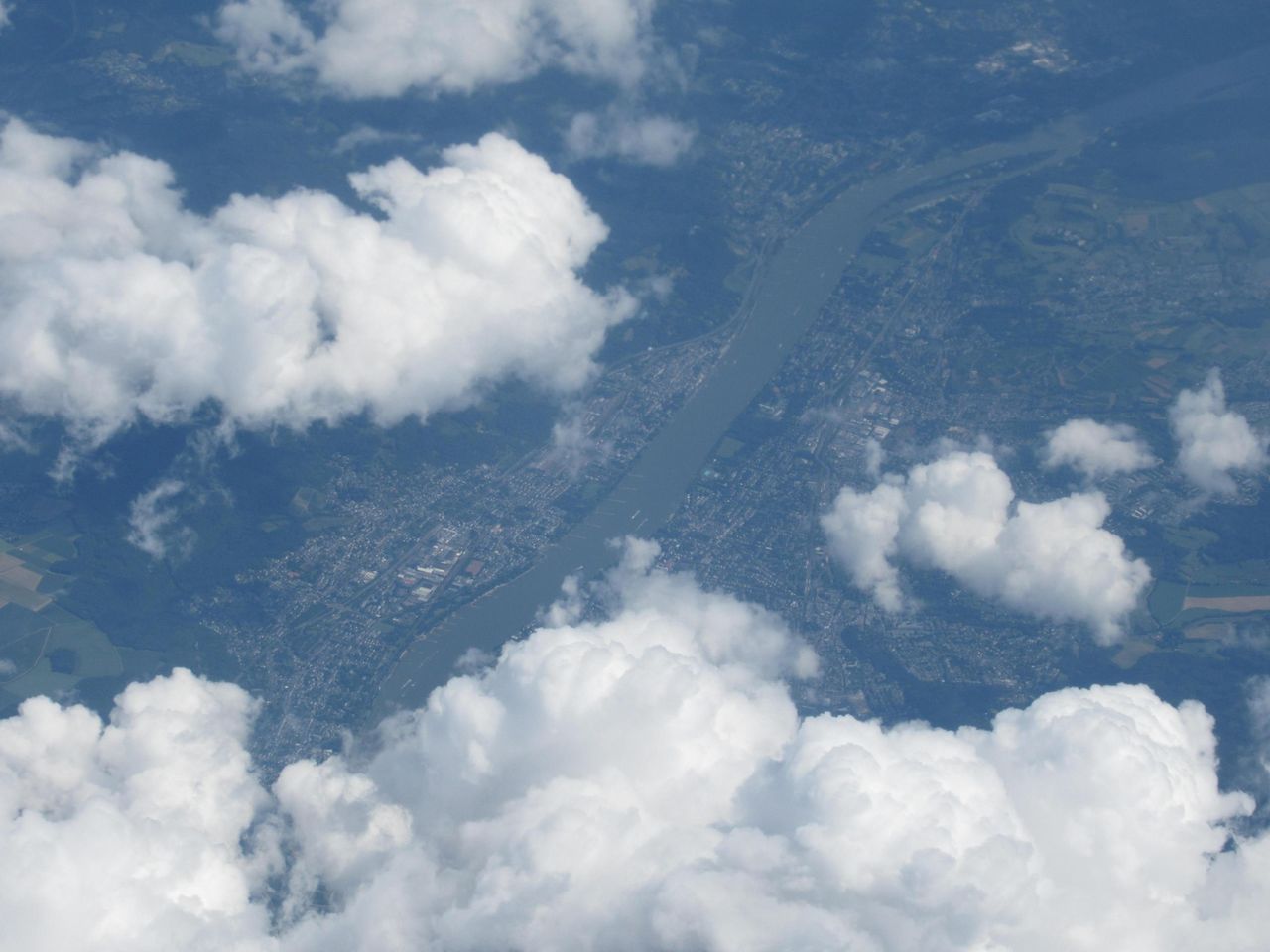
Information by the captain at STA-30’: the crew would be required to stop the engine power before reaching the gate because of excessive engine blow, and please remain seated until we are pushed to the gate. The captain also apologized for the welcome speech which had not been broadcasted in the cabins “due to a technical problem” (I suspect that he simply forgot to press on the relevant key).
Distribution of a sweet to all passengers shortly thereafter, presumably to help manage the pressure change (it worked well with me).
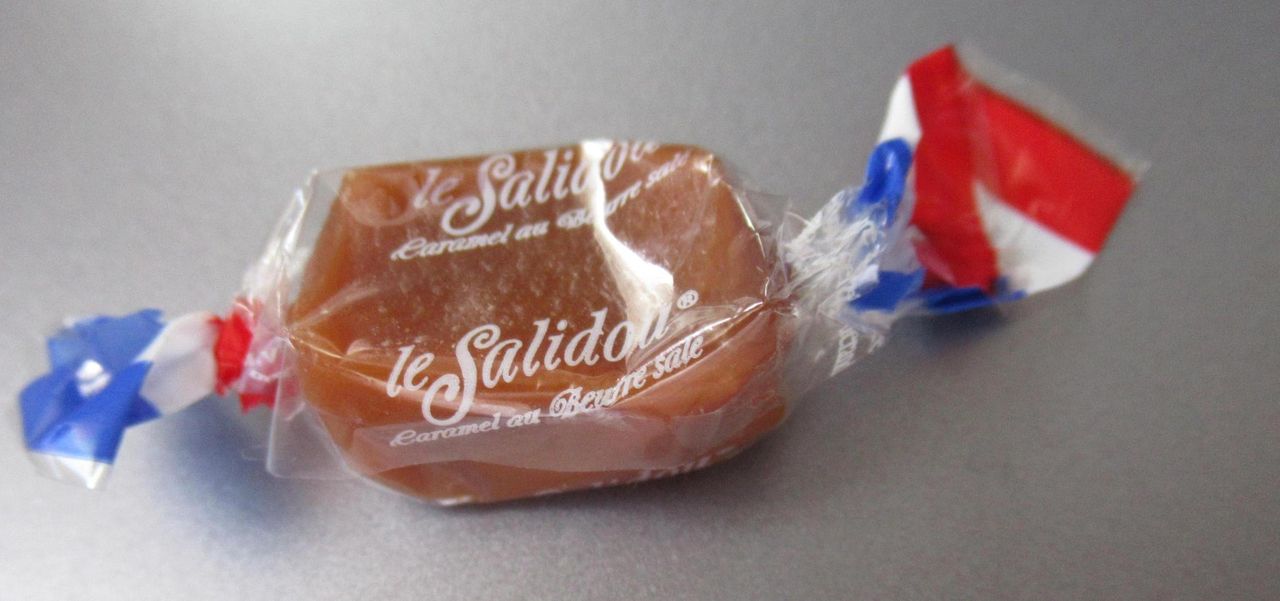
The sparse cloud cover gave an impression of good weather to people on the ground but it was a disaster for localizing oneself in flight, with a checkered sunlit / under cloud shadow / hidden by cloud landscape.

Turn to align due east
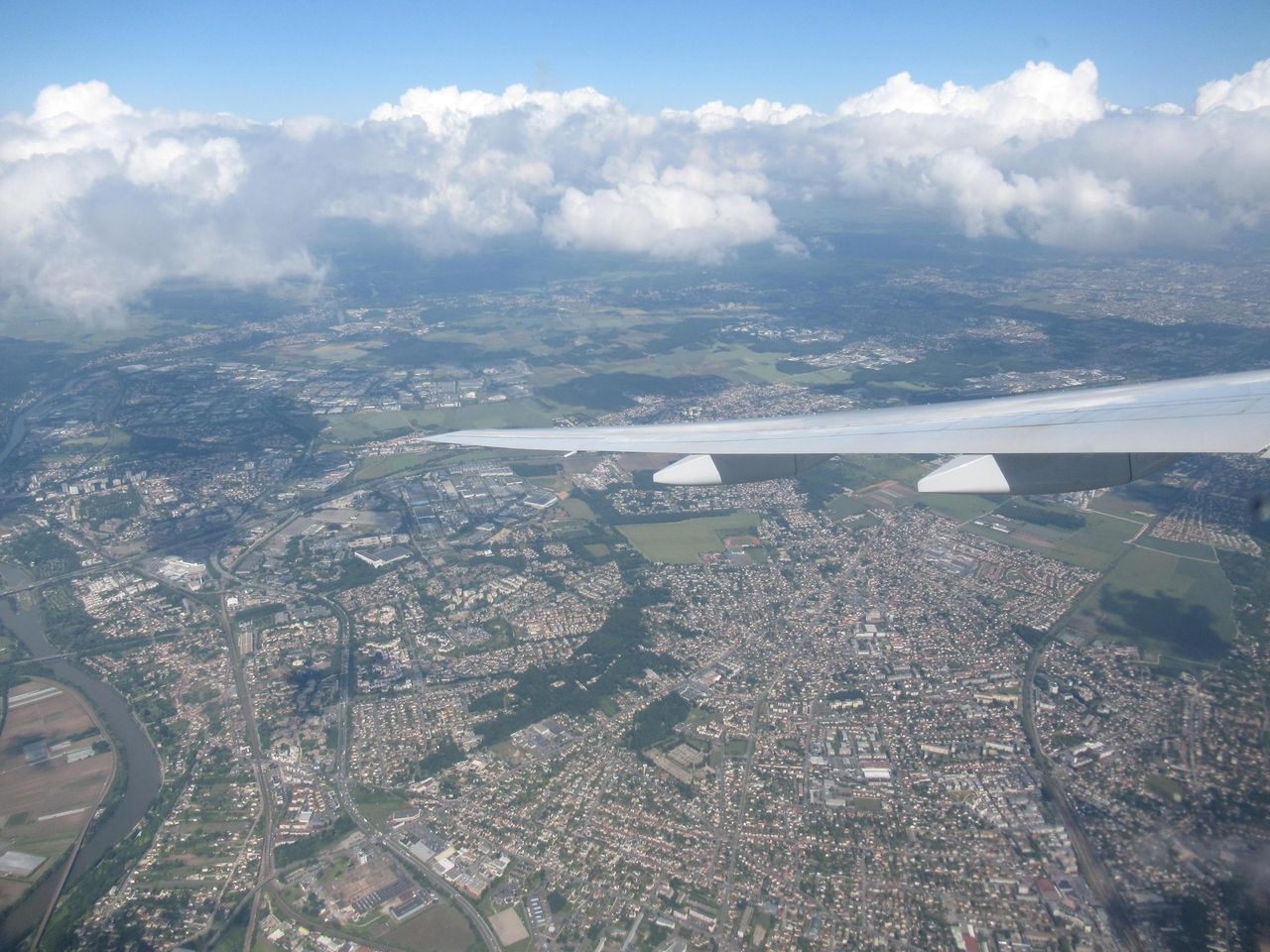
The Oise River, between Cergy-Pontoise on the left and Eragny on the right

Telecommunication tower in Montlignon Forest
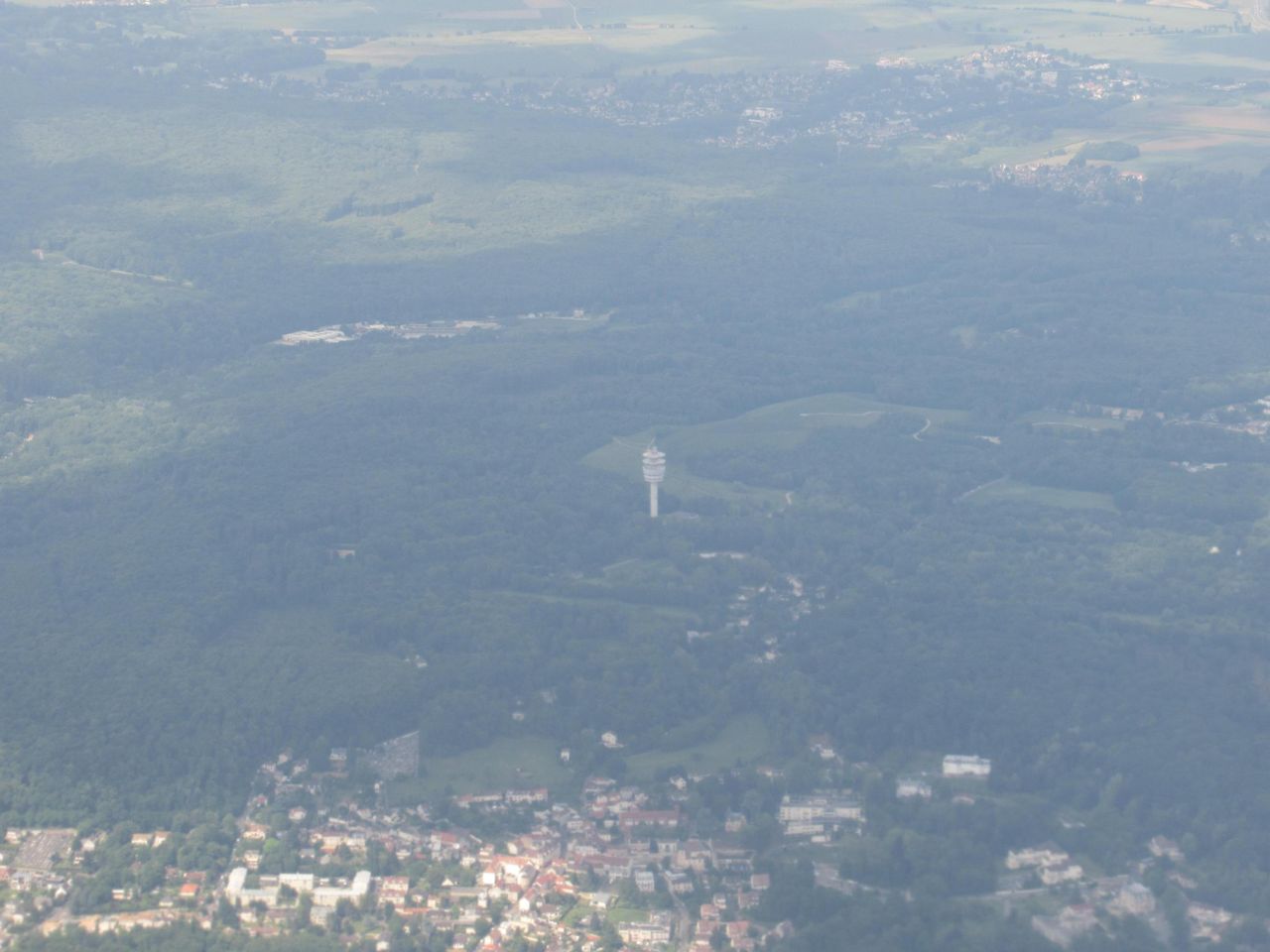
A housing project in Gonesse

The hospital complex of Gonesse

The limit of CDG appeared: we would land on the south runway pair
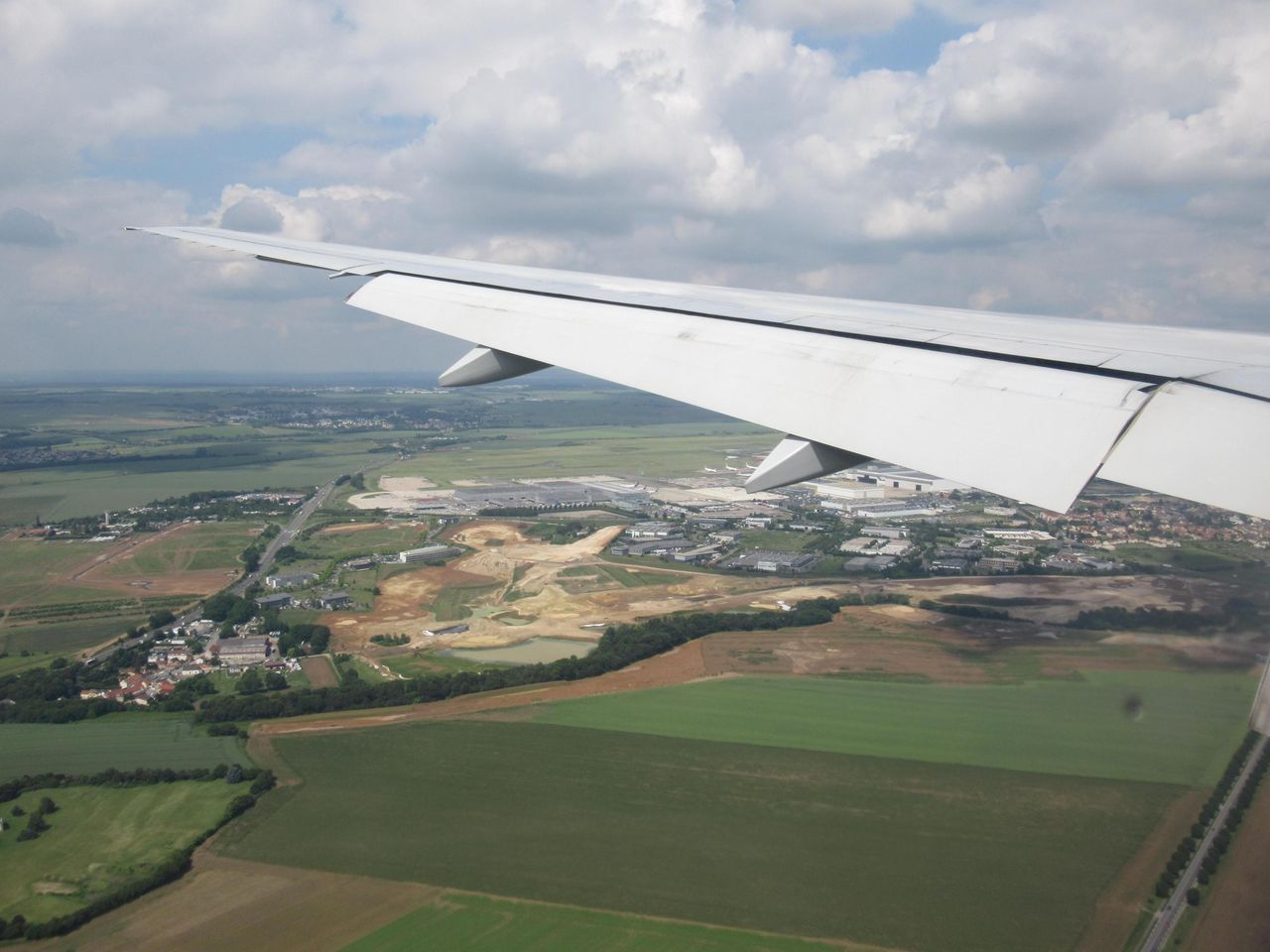
Twin aisle AF aircraft parked remotely; the A320 with a blue tail in the background is used for training ground airport staff.
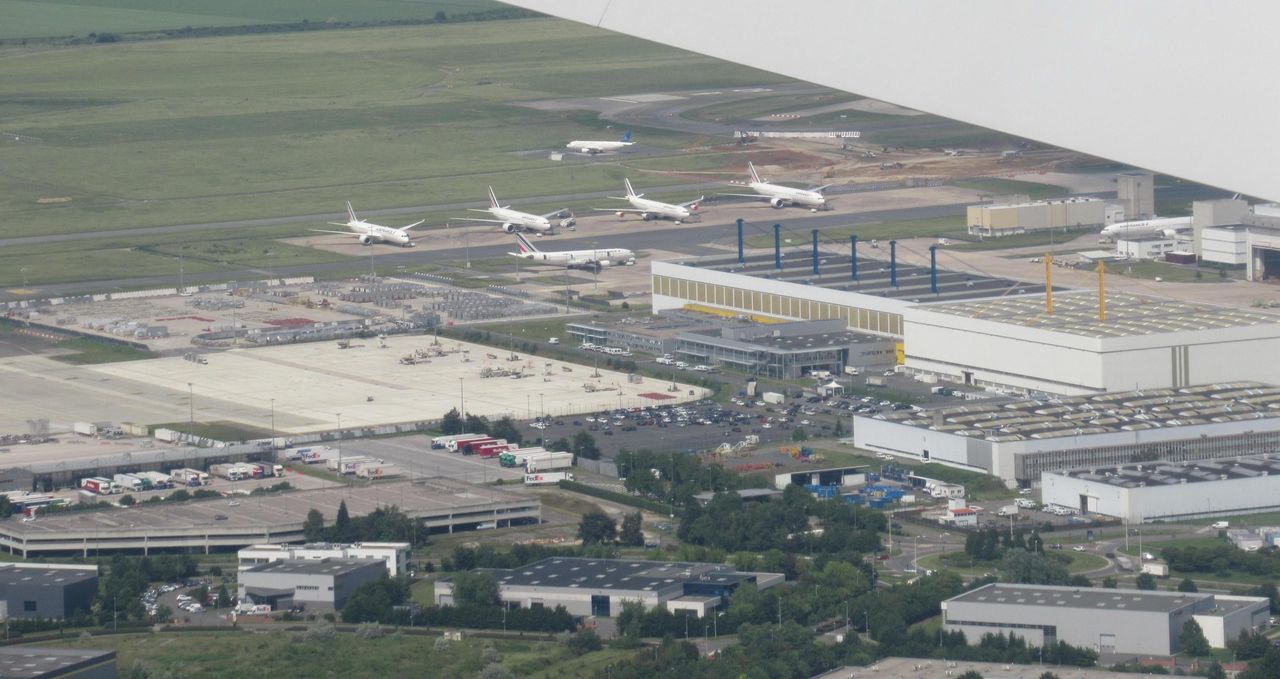
Two Fedex 757s and an MD-11

CDG’s Terminal 1 appeared under the wing
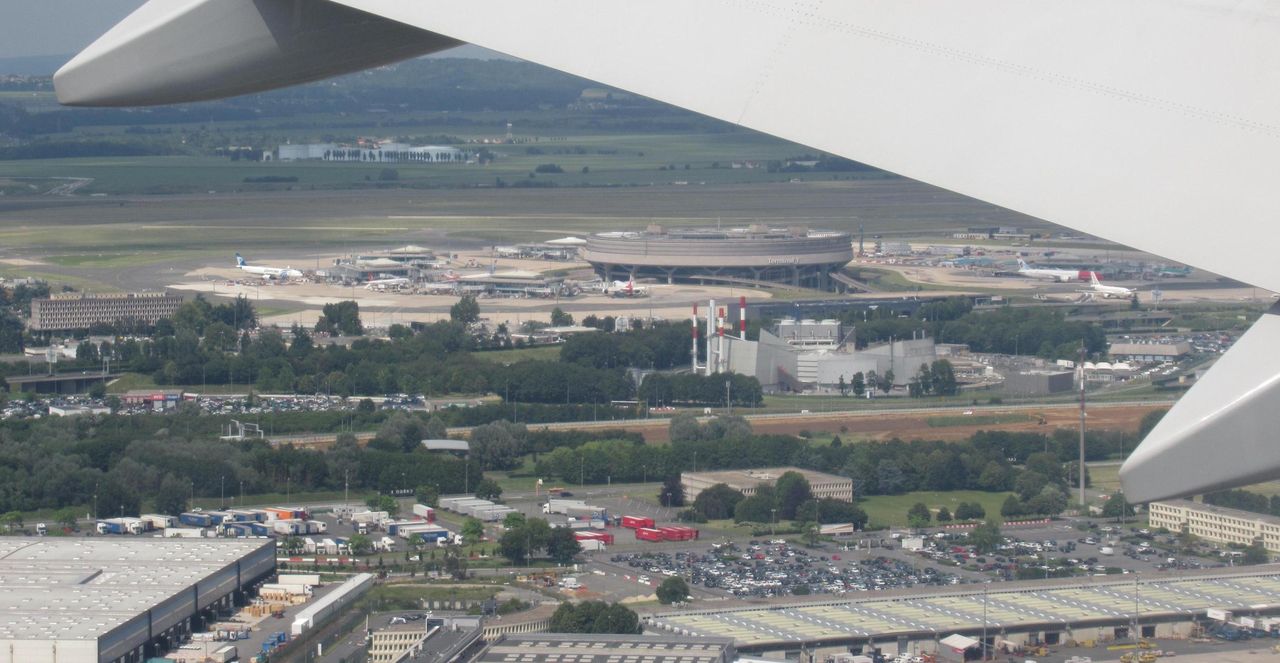
Air Austral 787 and 777 in the freight area,
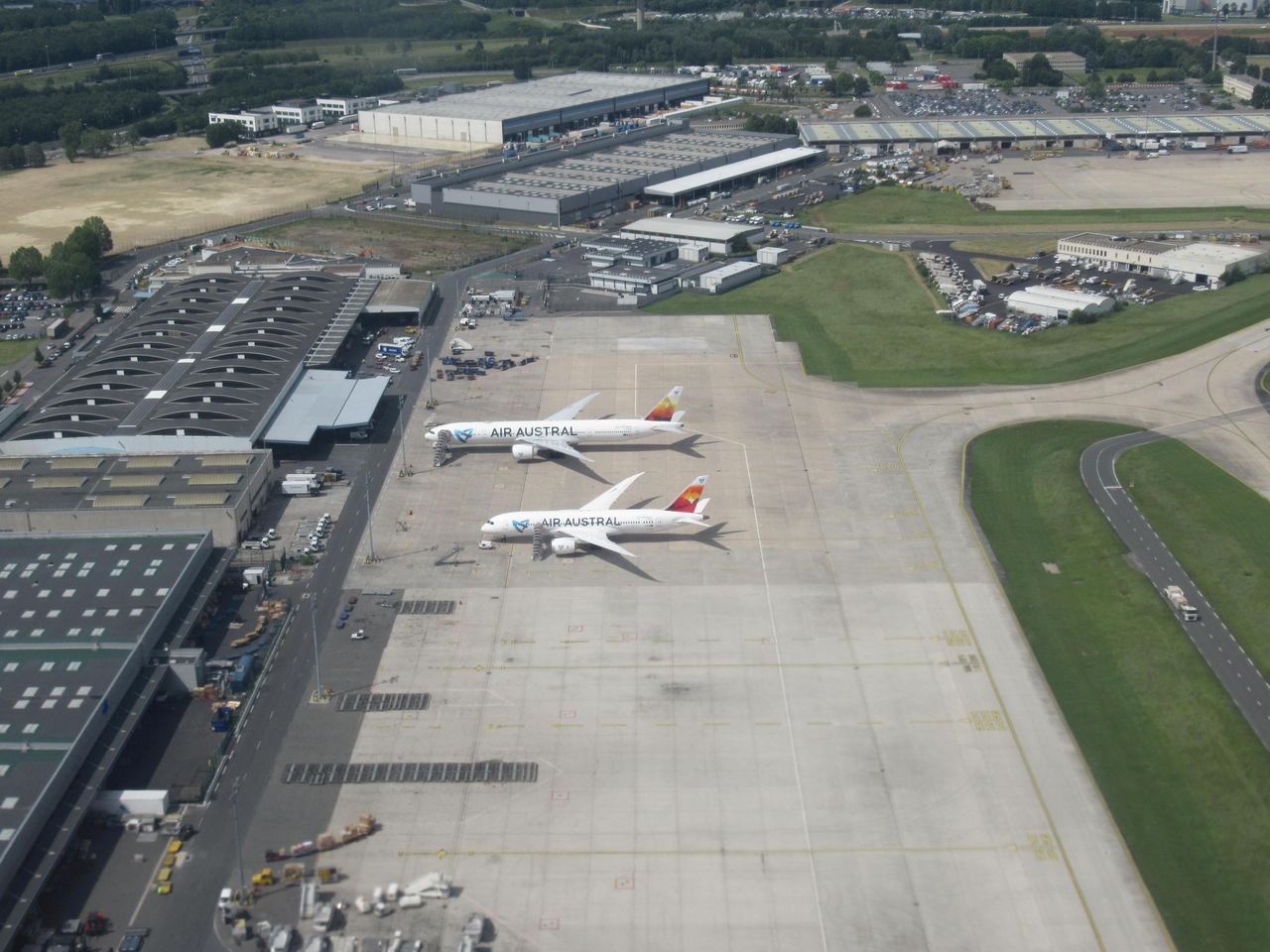
An AF 777 and an Air Tahiti Nui A340
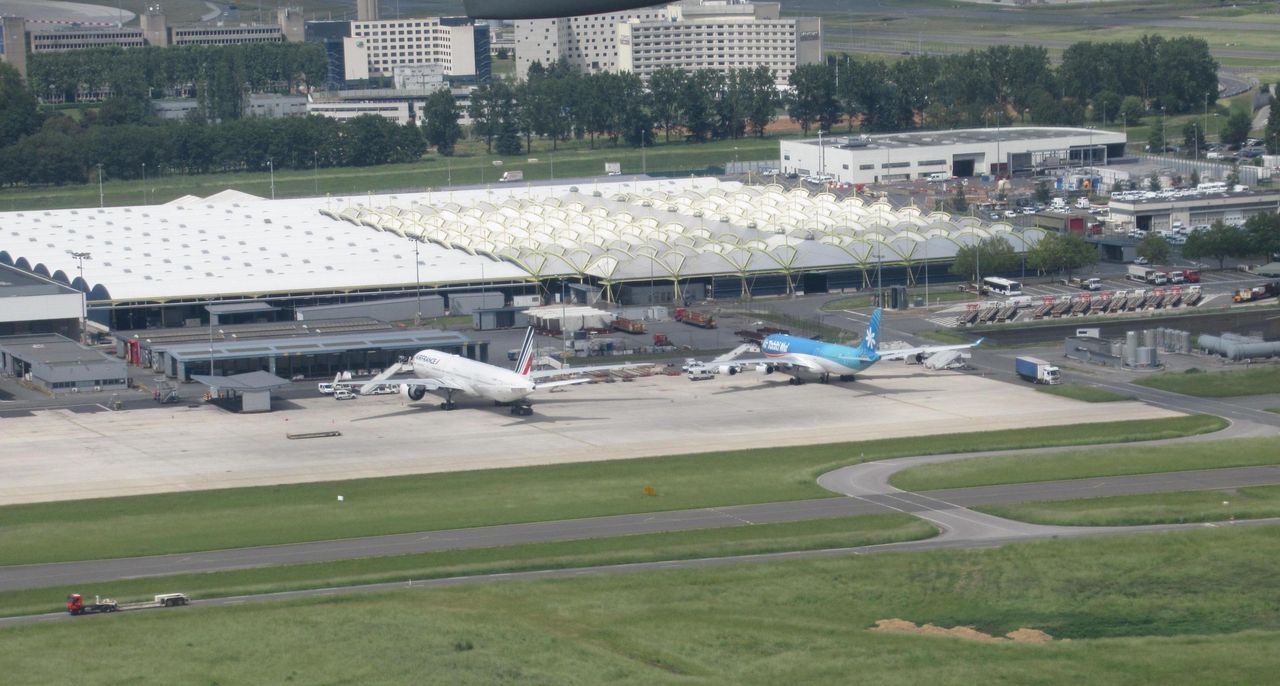
Terminal 1
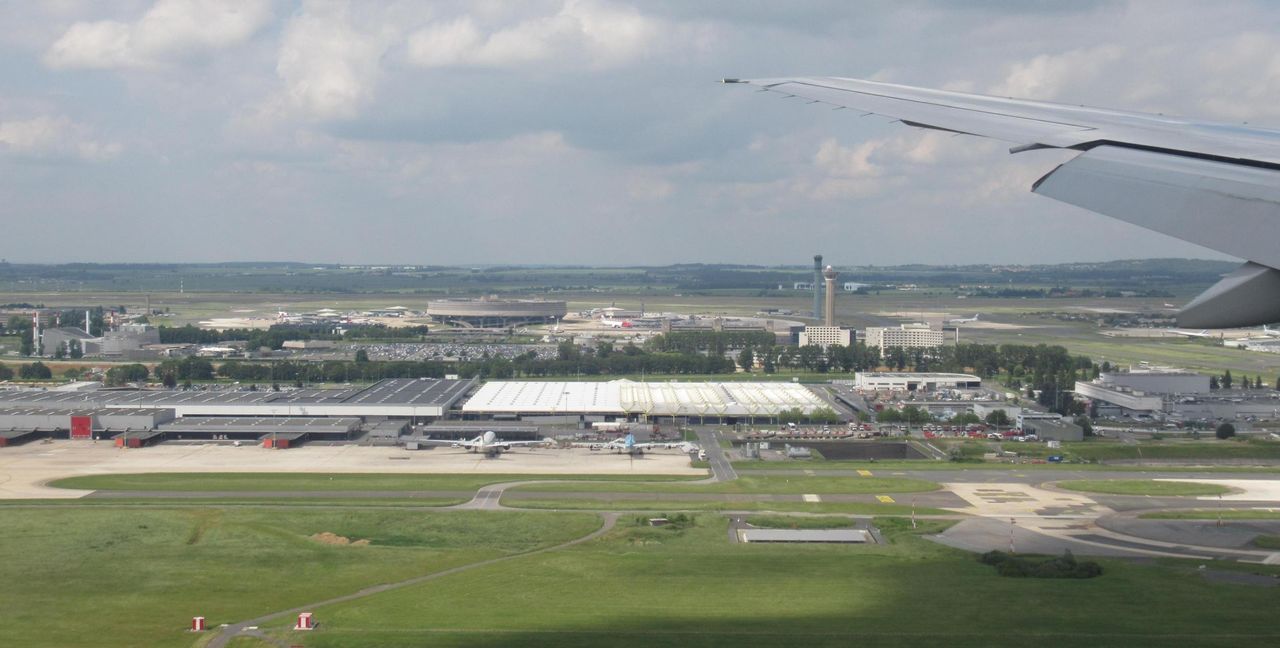
AF was the Concorde yesterday and Joon today. What about tomorrow?
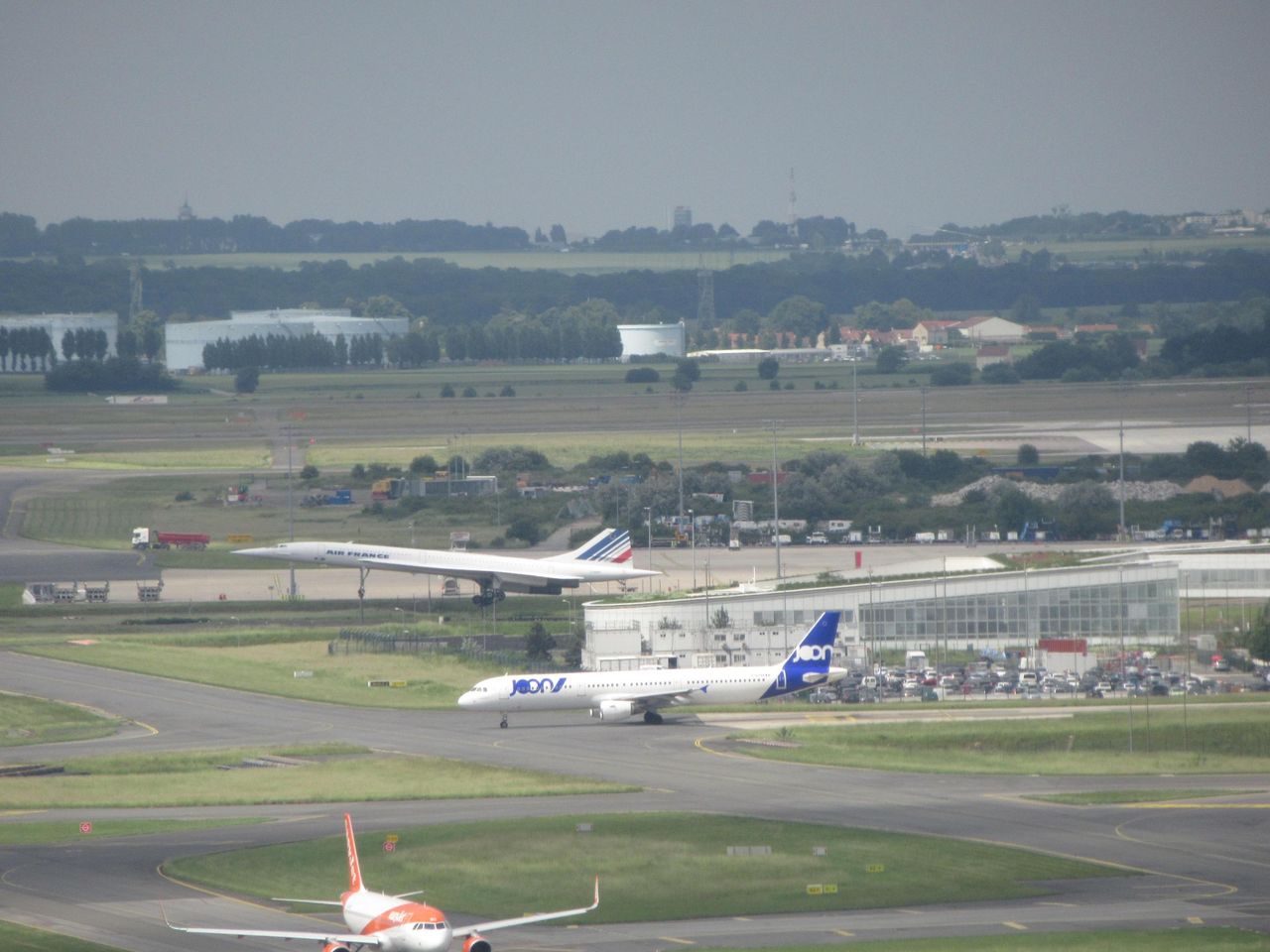
Touchdown and heavy braking
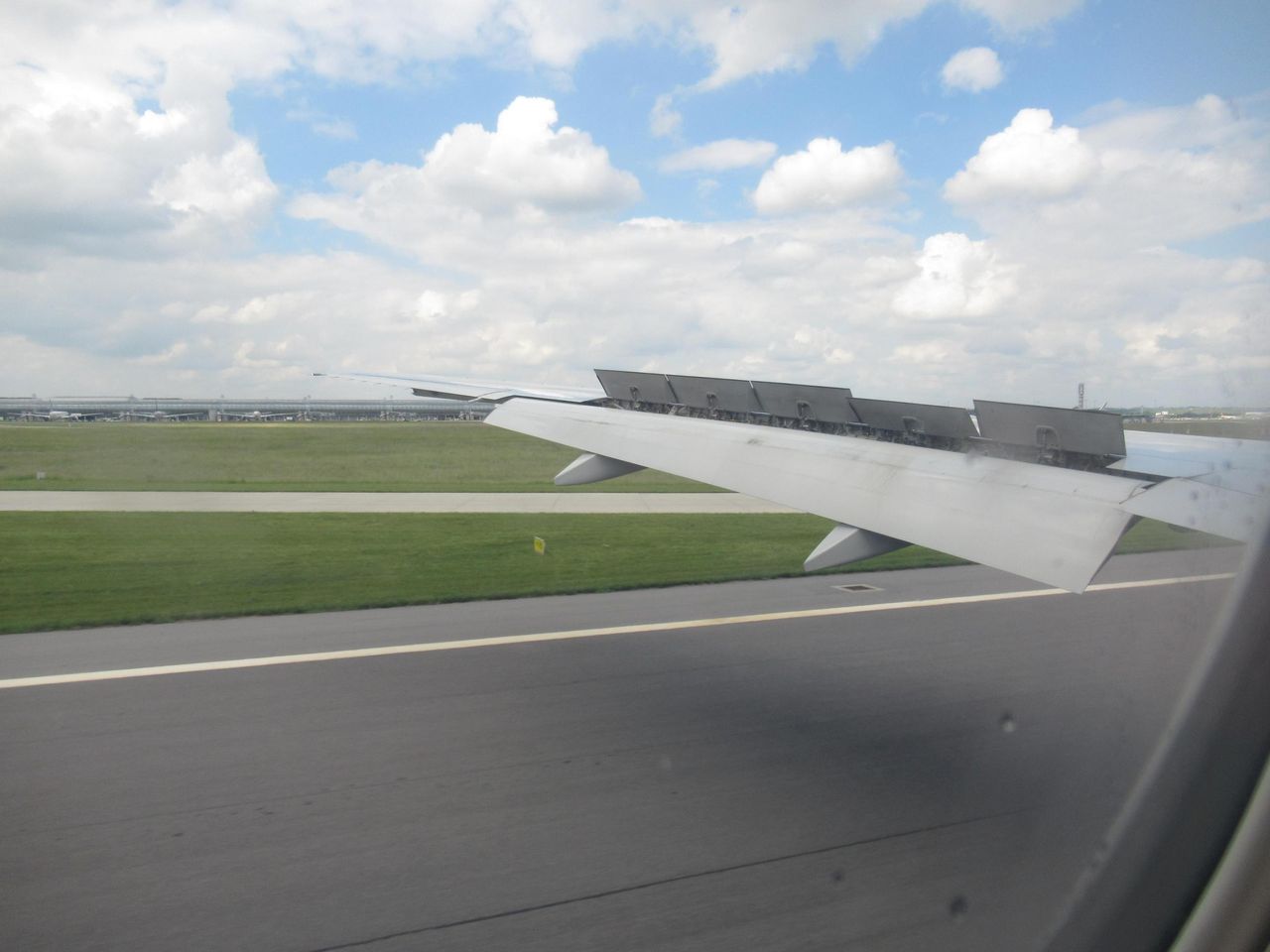
Arrival of a competitor on the Japan routes, coming in from HND
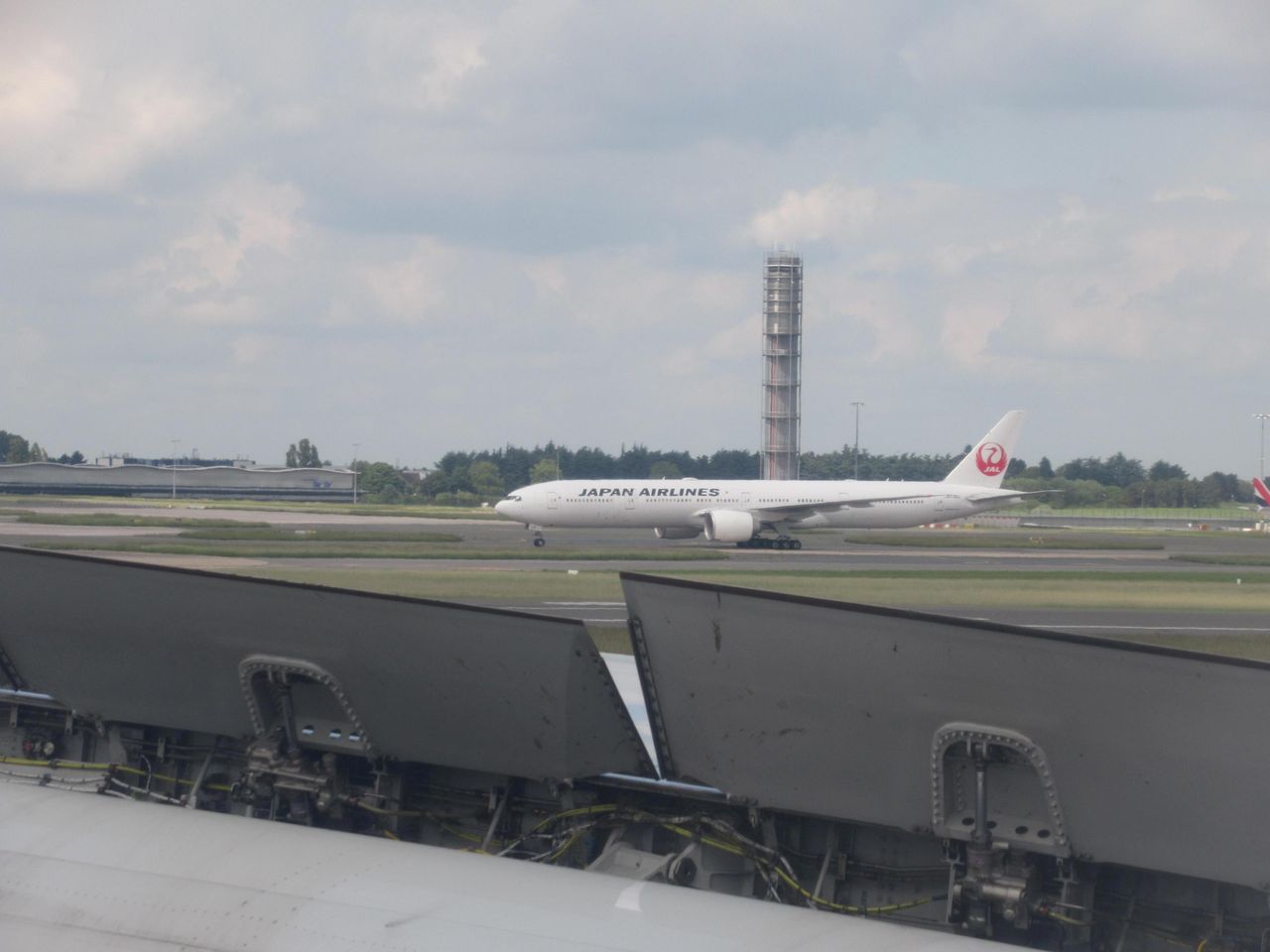
Crossing Runway 09L after the take-off of this XL Airways A330

Arrival of a Joon A320 lit by the sun through a break in the cloud cover.
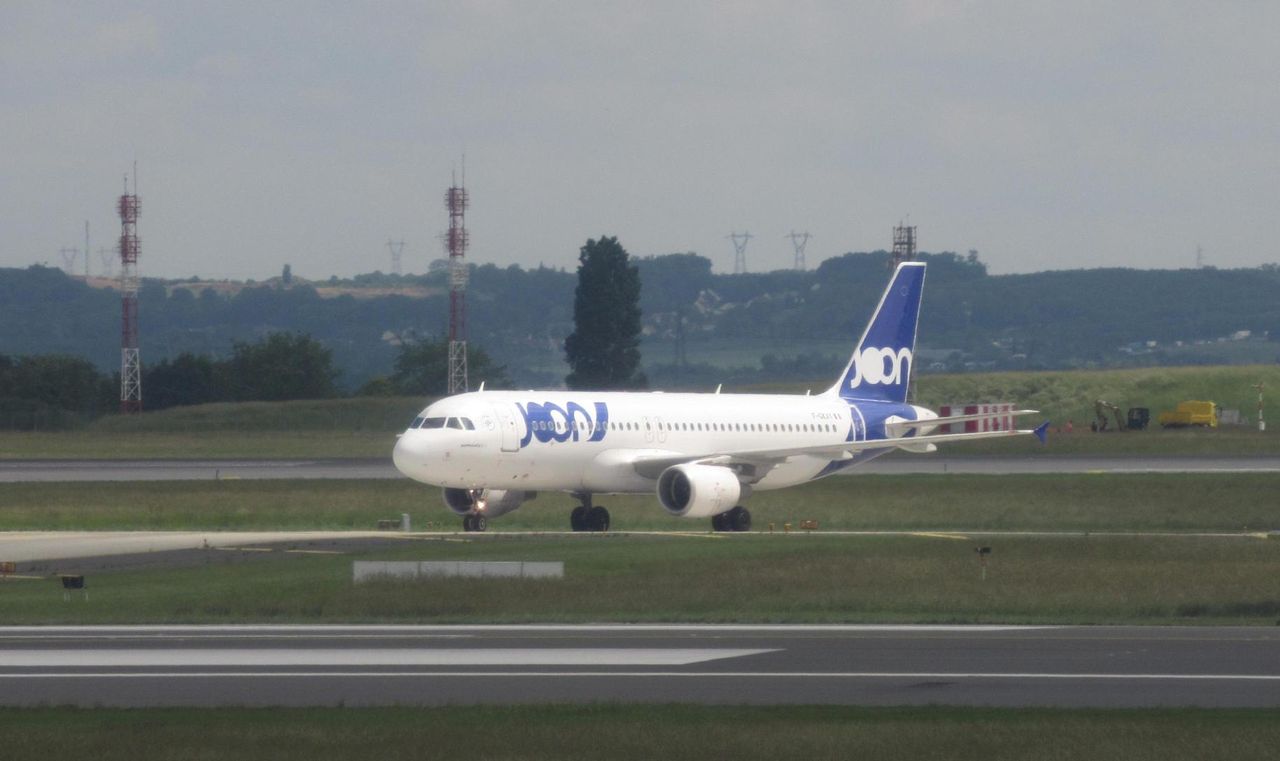
G-EZRS, an Easyjet A320, taking off
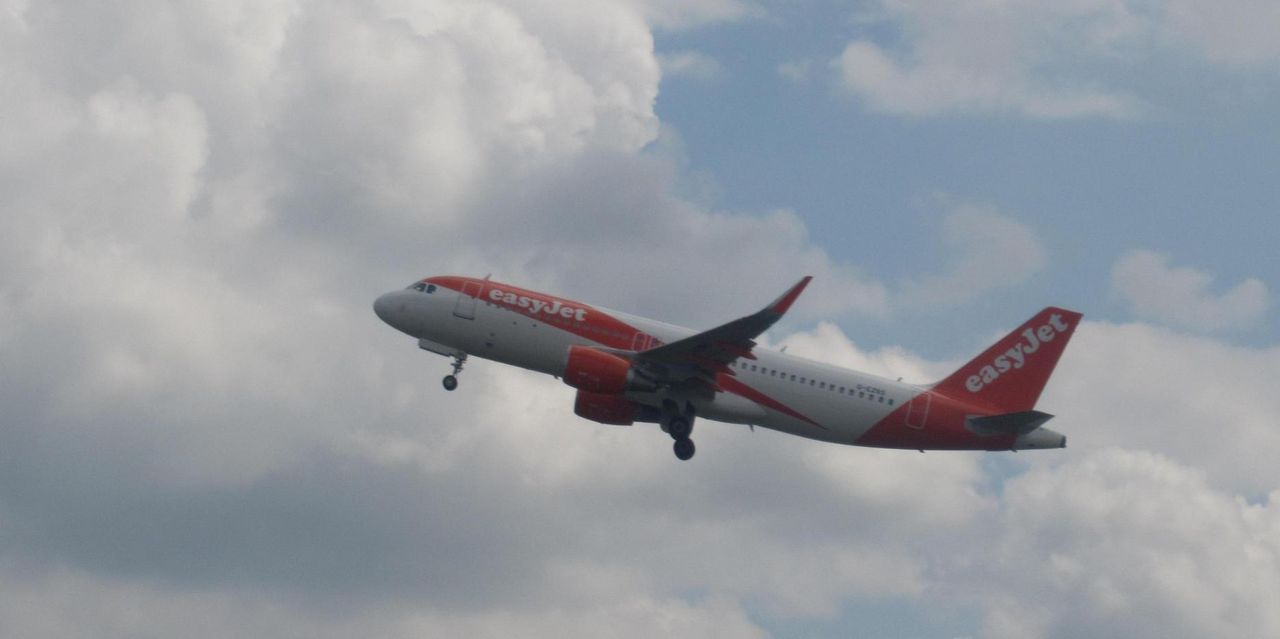
AF 777 in Skyteam livery
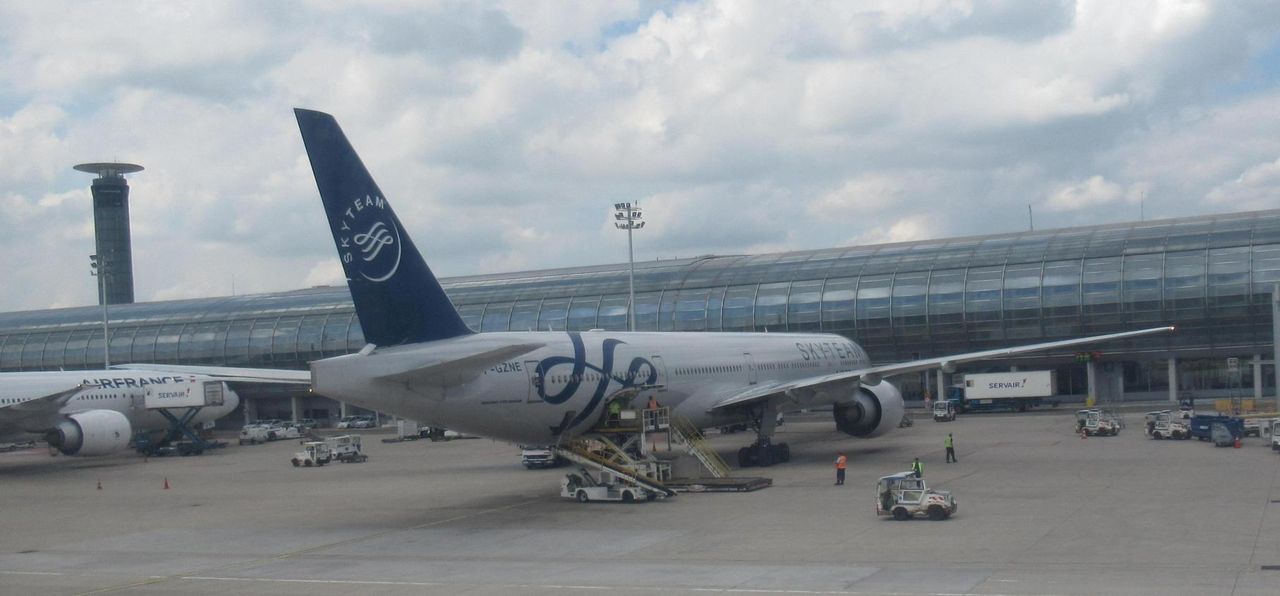
And JAL in standard livery
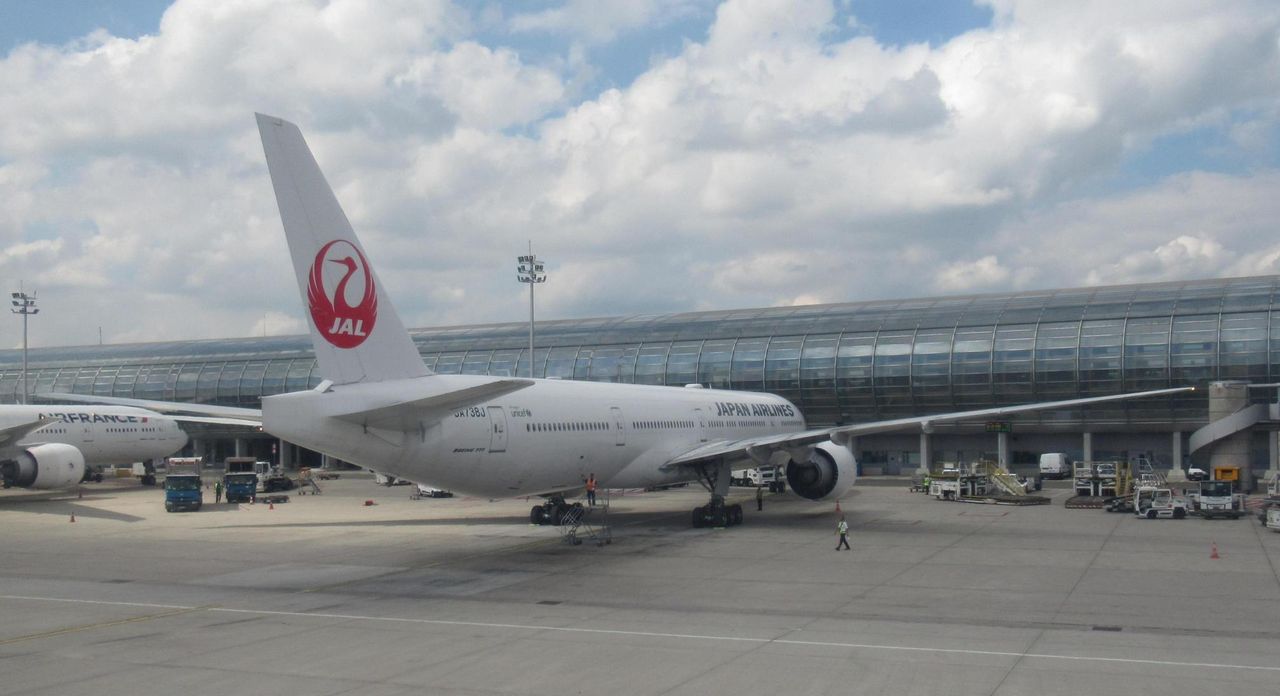
The row of long haul planes parked at Terminal 2E Hall K
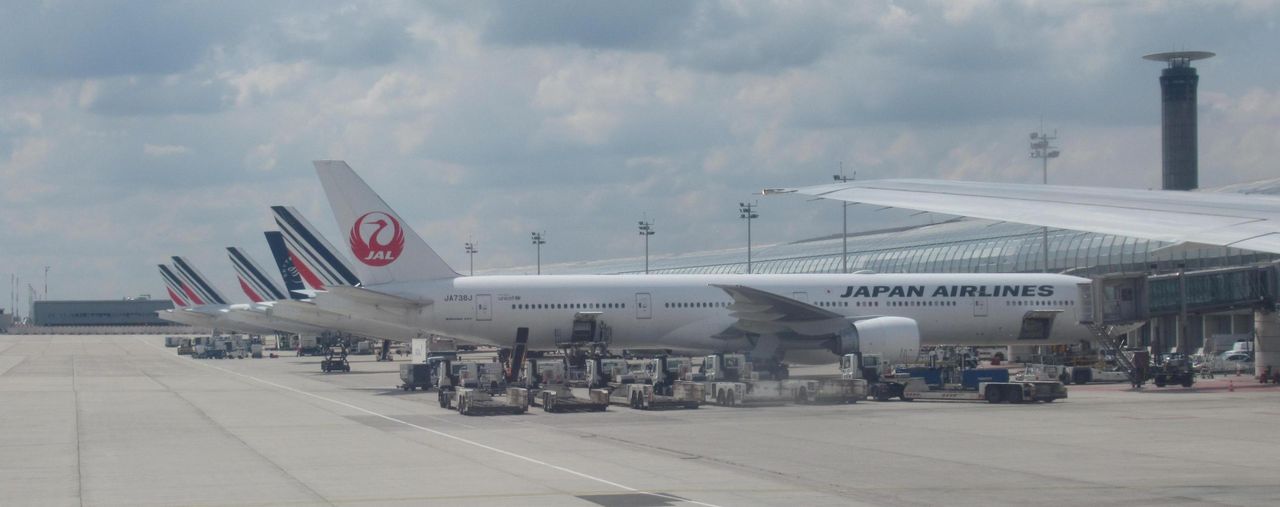
The end of Hall K

The plane taxied between Halls K and L to reach a gate on the other side of Hall K: Hall L is probably too close on the right to allow a plane to taxi on her own reactors power all the way to the gate.
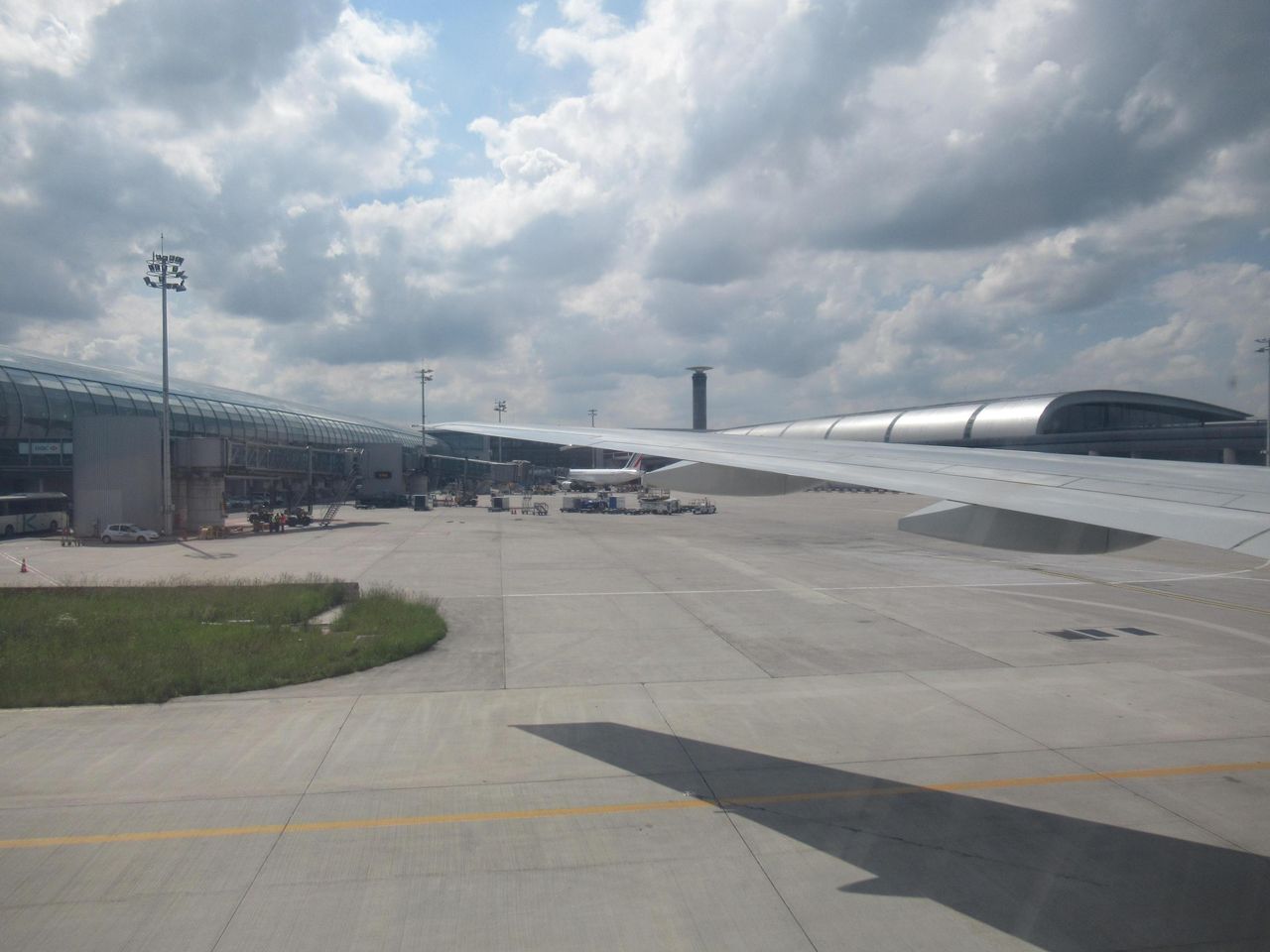
The last passengers started deplaning ten minutes after the picture above: the advantage of being in the front rows is significant only when the immigration control is not fluid.
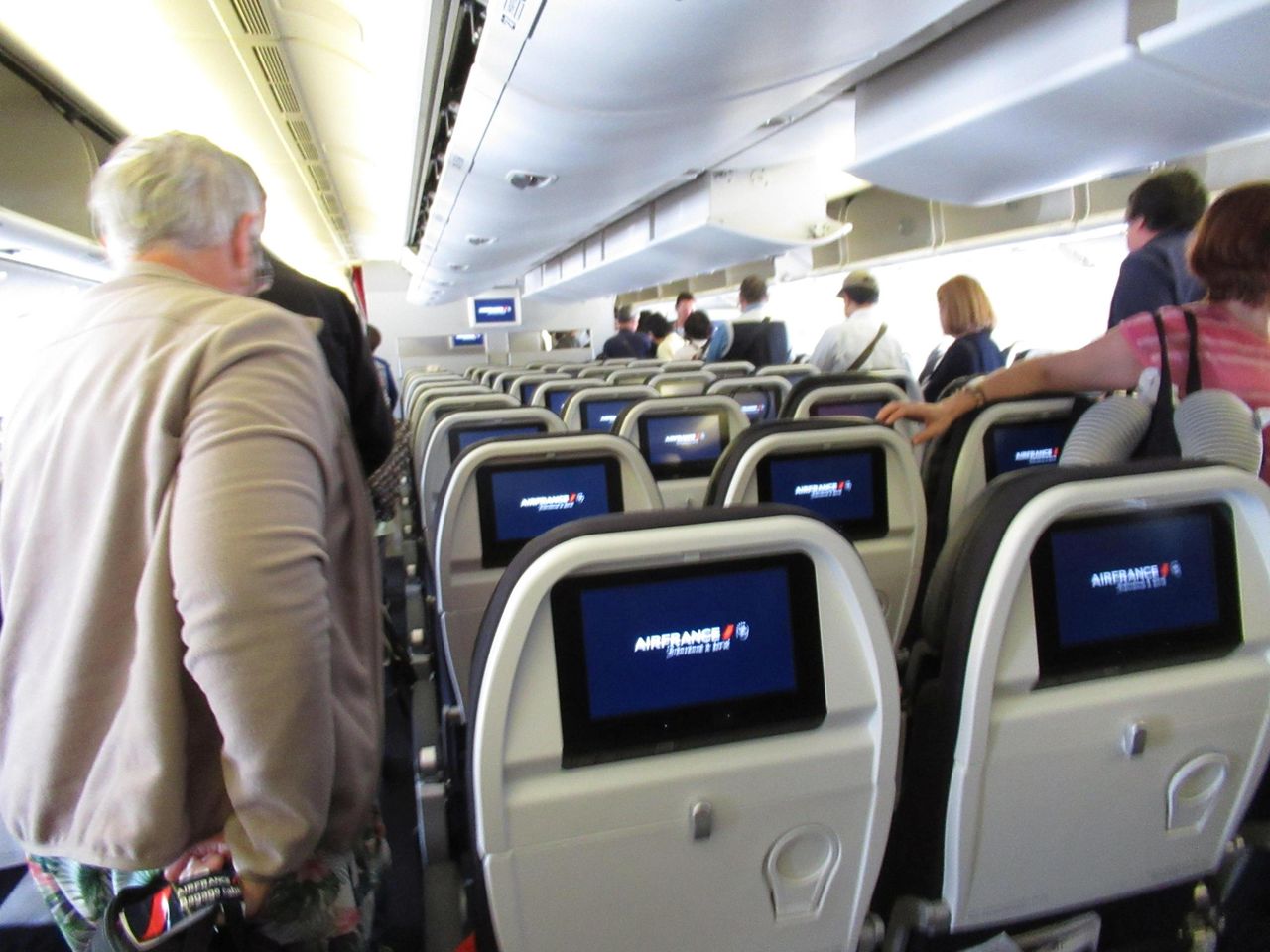
Tarom A318 seen from the jetbridge
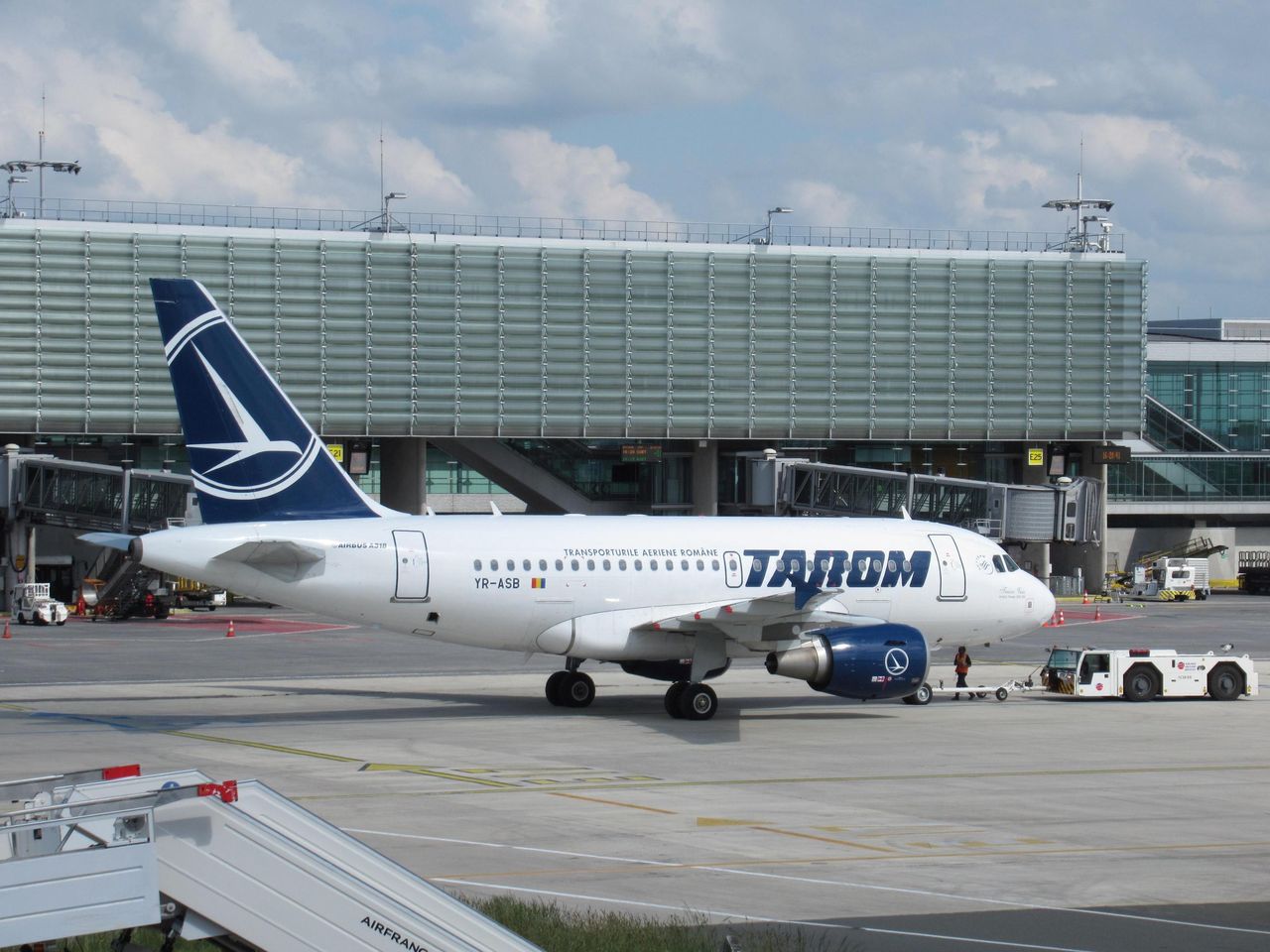
I doubt that Paris was waiting for me, but a Parisian woman was. There were too few PARAFE passport and fingerprint scanning booths to handle the many passengers who did not know how to handle them and slowed the line behind them, but this was not on the critical path to leave the terminal since I also needed to reclaim my checked luggage.

The luggage delivery began much later than the announced target time, but mine arrived quickly: my backpack was among the first items on the standard luggage carousel, and my walking stick at the oversize luggage delivery counter. The staff (facing back, below) was surprised, to say the least, by the arrival of a piece of luggage which was that thin and lightweight.

I took Elite+ status to be able to check in for free that specific pieces of luggage !
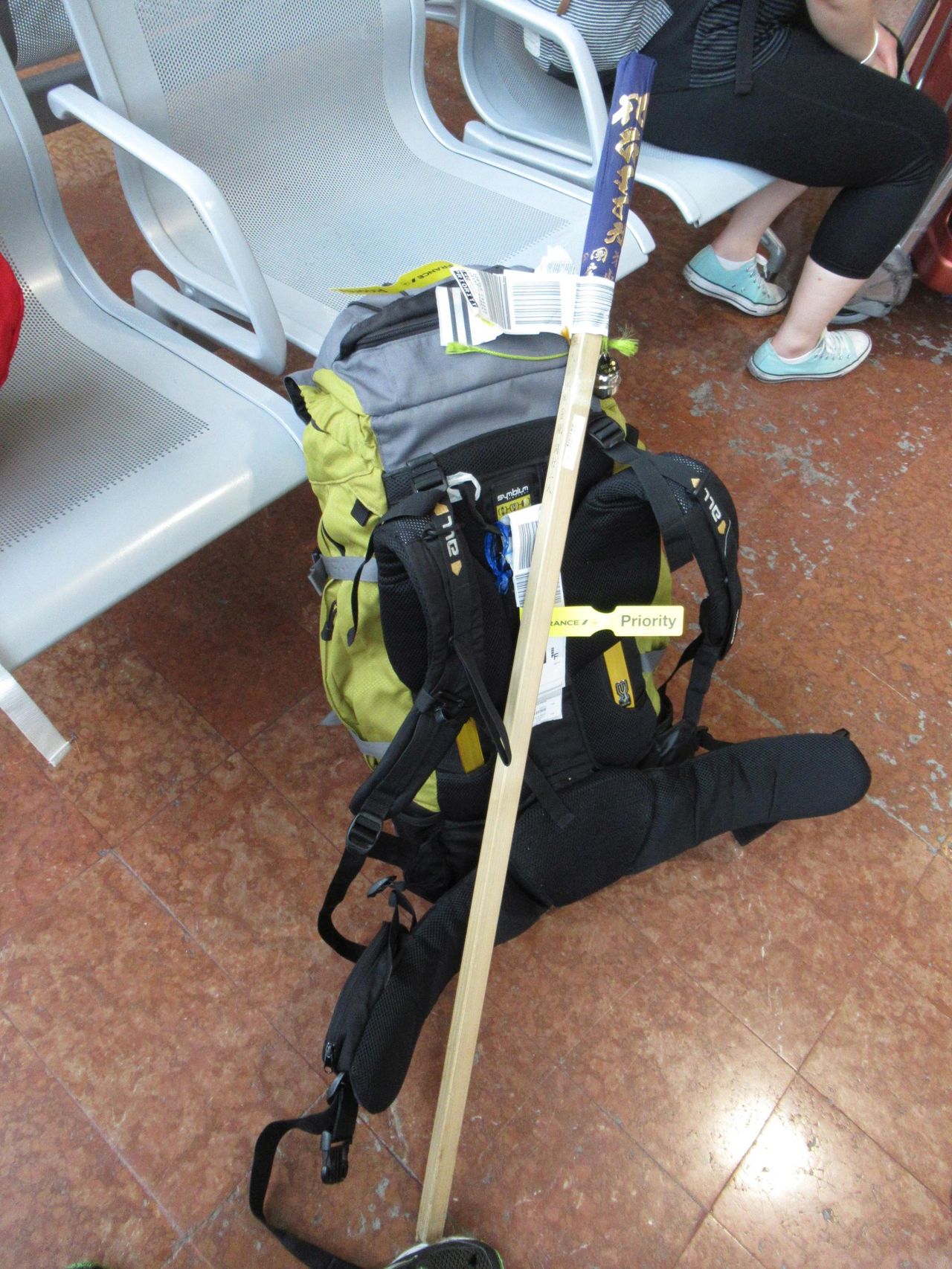
My friends had warned me against the culture shock when coming back to Paris, and it was indeed a severe one, with this 21 minute line to buy a train ticket to Paris at CDG’s station. I had already complained in a previous FR about the absence of ticket machines in the luggage delivery rooms like in ARN. A reader had explained to me that state-owned Paris Aéroport, out of due concern of its finances and of the legitimate financial interest of its sole owner, presents a massive bill for the use of space and electric power for ticket machines in its premises, that state-owned French Railways, out of due concern of its finances and of the legitimate financial interest of its sole owner, righteously rejects. The interest of the passengers is not part of the rules of this zero sum game, all the more that those who set the rules don’t take the train to CDG.

This is the end of this FR, and before you return to your daily routine, I offer you a bonus on a theme which is not quite daily routine: the Shikoku 88 Temples pilgrimage, continued.
Where do the pilgrims spend the 40 to 60 nights needed to complete it?
The most barebones solution is wild camping which is widely accepted in rural areas, and in suburban areas too (in a bus stop, for instance), as long as you leave at dawn and of course do not leave any rubbish. Note in the foreground the banner of a campaign promoting the listing of the trails and temples of this pilgrimage in Unesco’s World Heritage List.
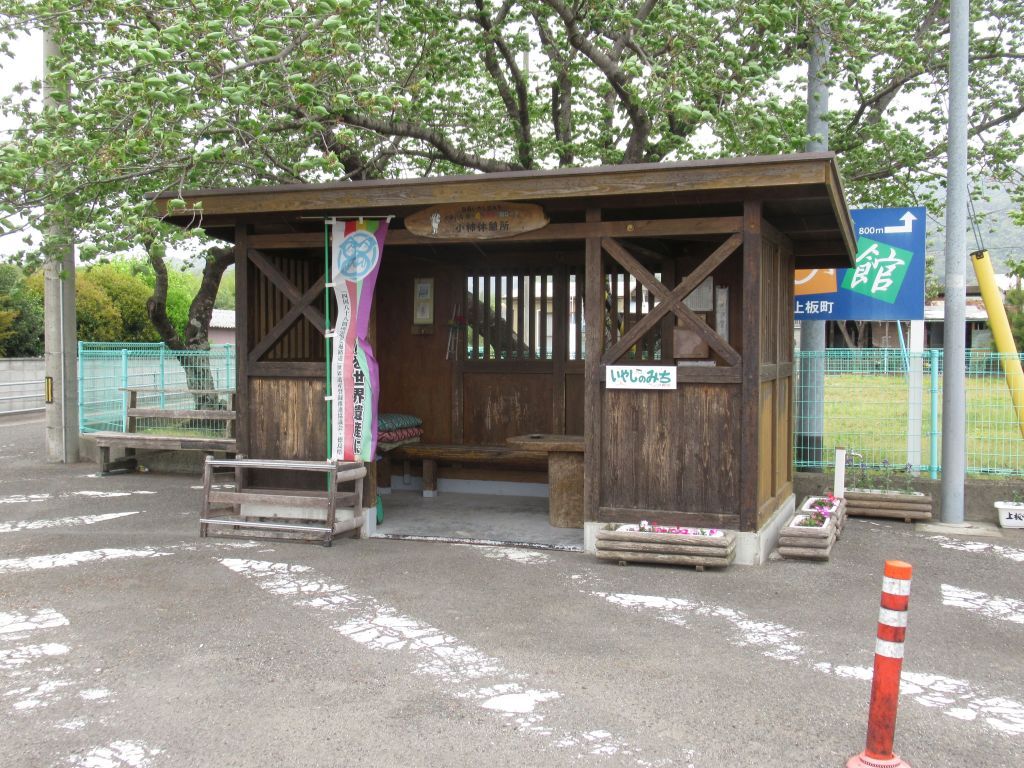
More comfortable, but also free, there is the zenkon yado 善根宿: a shelter of various comfort level installed by a local inhabitant for charitable purposes similar to settai: thanking walking pilgrims for doing the pilgrimage on behalf of him. It is often a wooden hut, sometimes professionally made and sometimes jury-rigged, with wooden berths and mats.
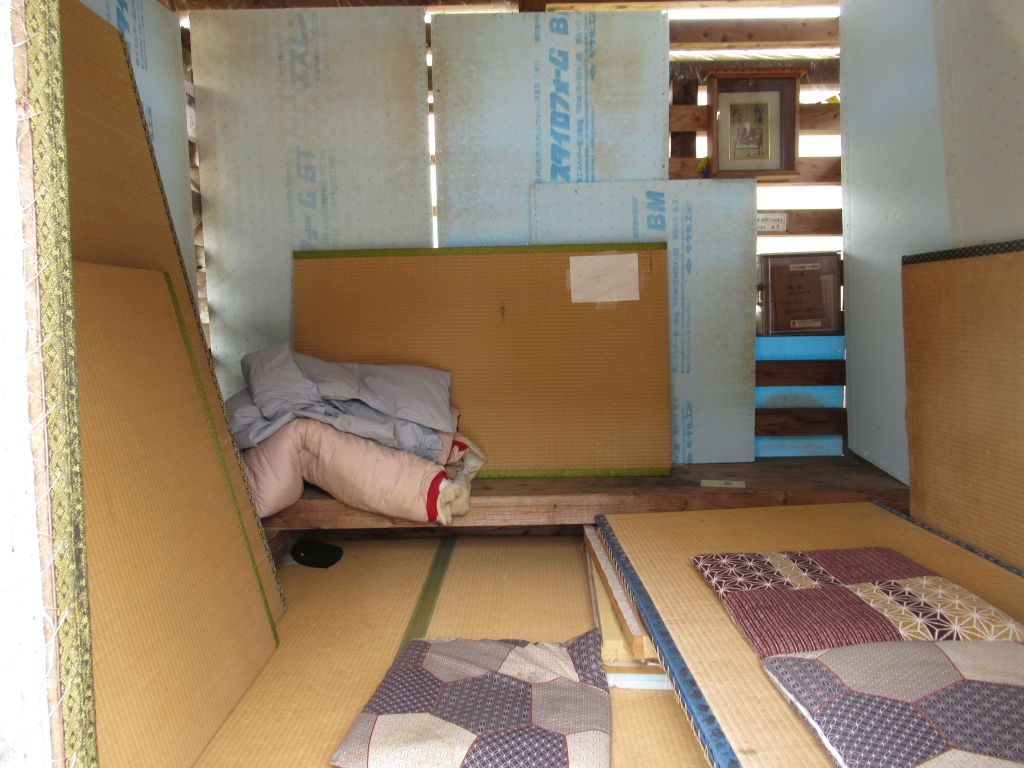
This one also had a wide concrete area for tents, which must of course be self-supporting: stakes do not belong to the equipment of a camping pilgrim.
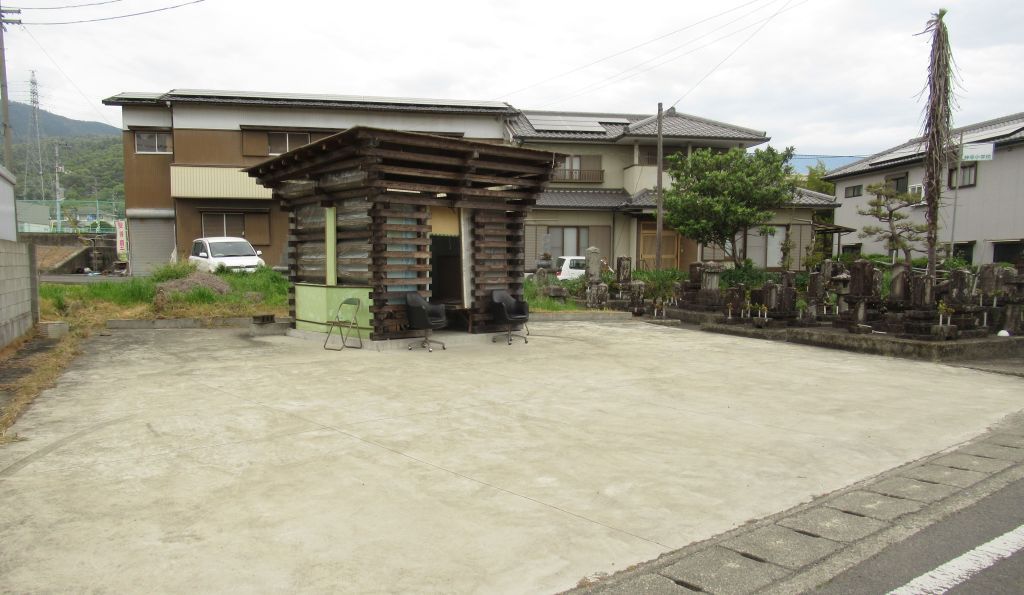
I can afford sleeping more comfortably than that and my preferred choice was a minshuku 民宿, i.e. a guest house. It is usually a small establishment with half a dozen rooms, managed by a couple. The rooms are traditional Japanese style ; they are wider in rural areas where space is a lot cheaper. The building usually does not look fancy from the outside but you can have nice surprises, like here with an 8 tatami room behind a 3 tatami antechamber and a 2 tatami loggia: downright luxury for a single traveler. (Housing surfaces are always measured in tatami mats of a standard 1.80 x 0.90 m size.)
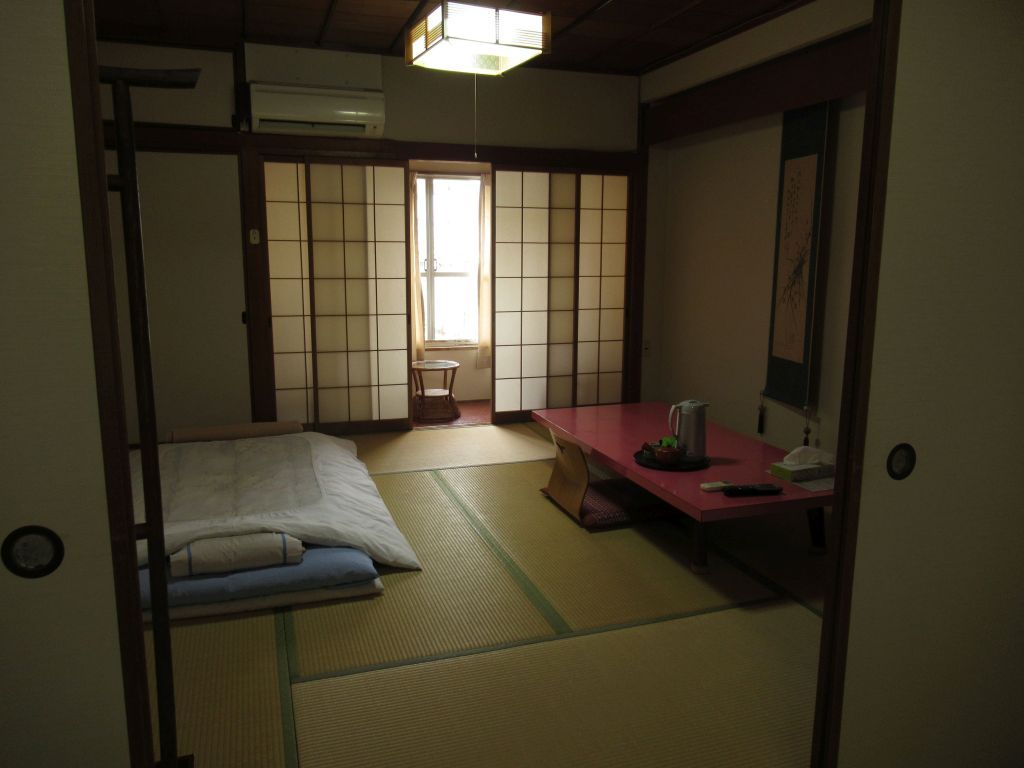
This other minshuku had a traditional wooden bath placed on a river pebble floor: the most traditional kind you could think of.

Half board is always available in a minshuku: the dinner and the breakfast are collective and generous, so much so that with the addition of some settai here and there, I never had ate lunch. The meals in a minshuku are privileged moments for exchanges between pilgrims.
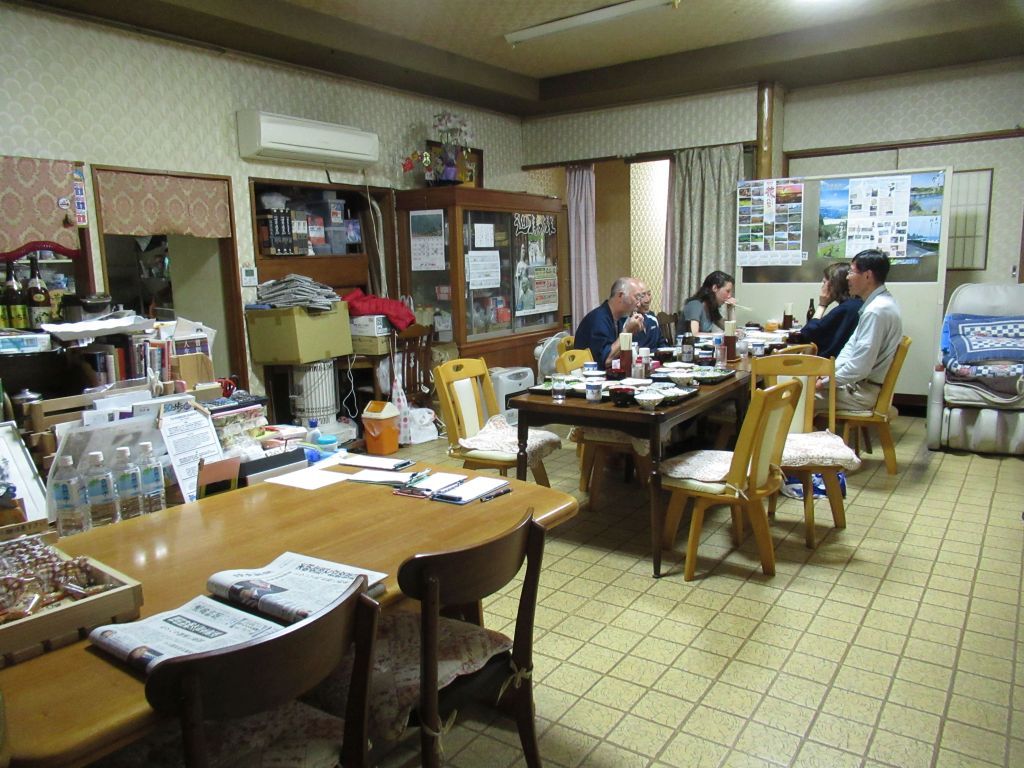
This is a typical dinner:
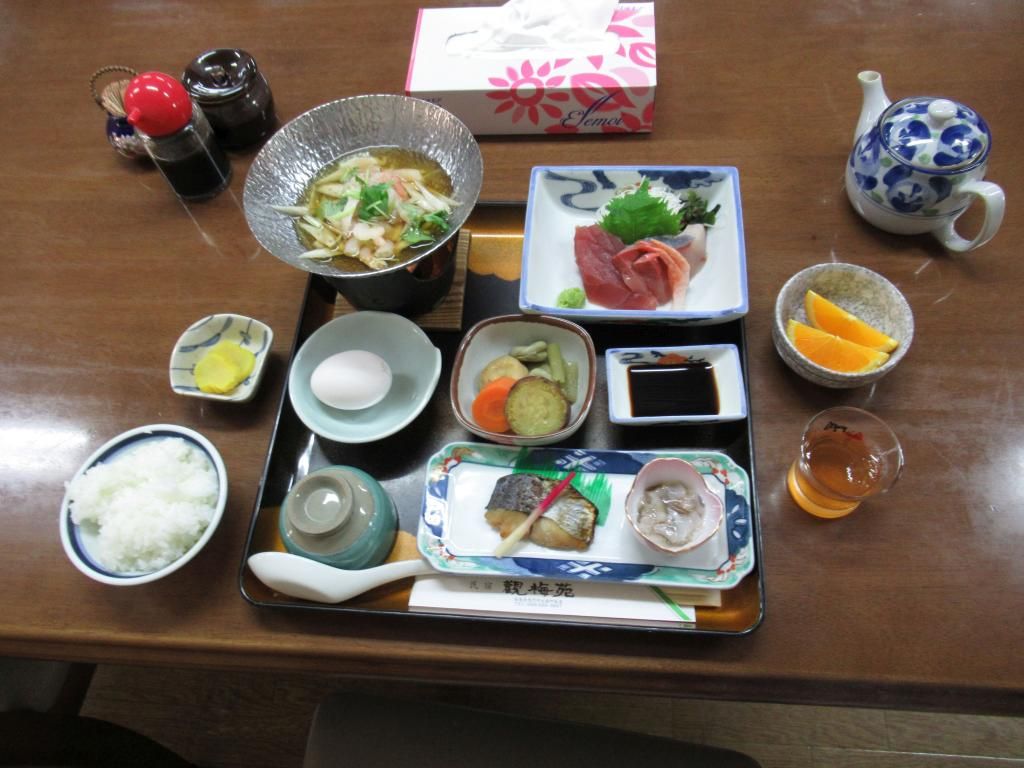
And an equally typical breakfast.
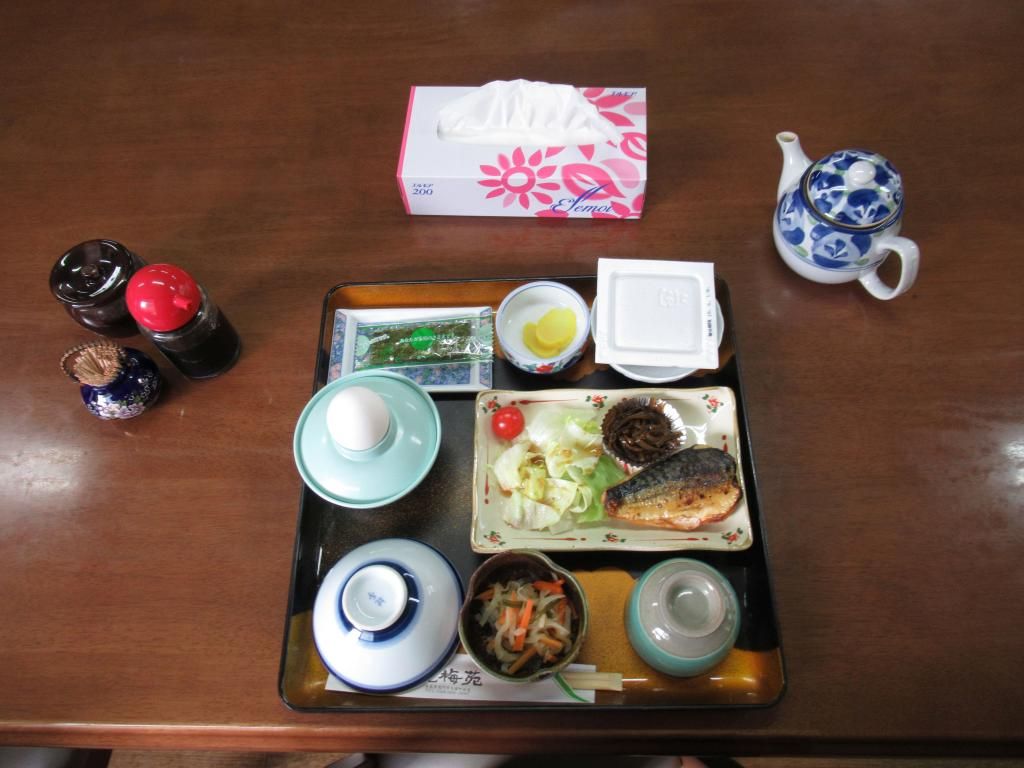
In the above picture, the square expanded polystyrene on the right contains nattō. The French have stinky cheeses, the Chinese and the Taiwanese have stinky tofu 臭豆腐, the Swedes have surströmming and the Japanese have nattō 納豆.
These are soybeans fermented by a bacteria (Bacillus subtilis natto), served usually for breakfast. You whip them with chopsticks together with some sweet soy sauce and mustard: that is when you realize that these beans are gooey and have a smell… of nattō, two features which are quite dissuasive for beginners.
You then pour it on rice (a rare case when rice is mixed with something else), a raw egg (another standard breakfast fare) being optional. I jokingly said to Japanese pilgrims who were surprised to see me eat this that adapting to nattō was part of my pilgrimage oaths.

Let’s go back to accommodations:
Fifteen of the 88 temples provide pilgrim hosting, called shukubō 宿坊. Unlike the minshuku, the offerings vary a lot: a religious service after dinner, or before breakfast, or not at all, meals available or not, very comfortable or minimal rooms. They are often big structures well adapted to groups, where individual pilgrims are somewhat marginalized.
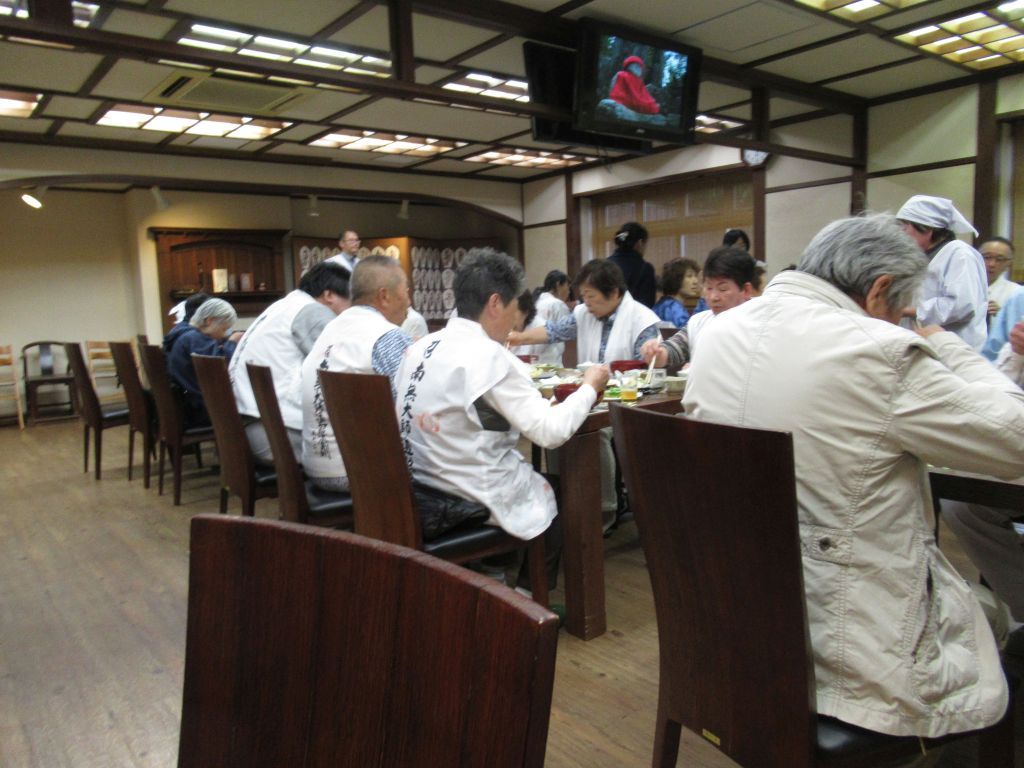
Further upscale, you have the ryokan 旅館: these traditional hotels can reach top luxury settings and prices in Japan, but those which are listed in the pilgrims’ guide books are hardly more expensive than a minshuku. The room is wider (14 tatamis here, adding the room and the antechamber, not counting the niches), a neater decoration, a wooden building with character and much more refined meals.

Another example:
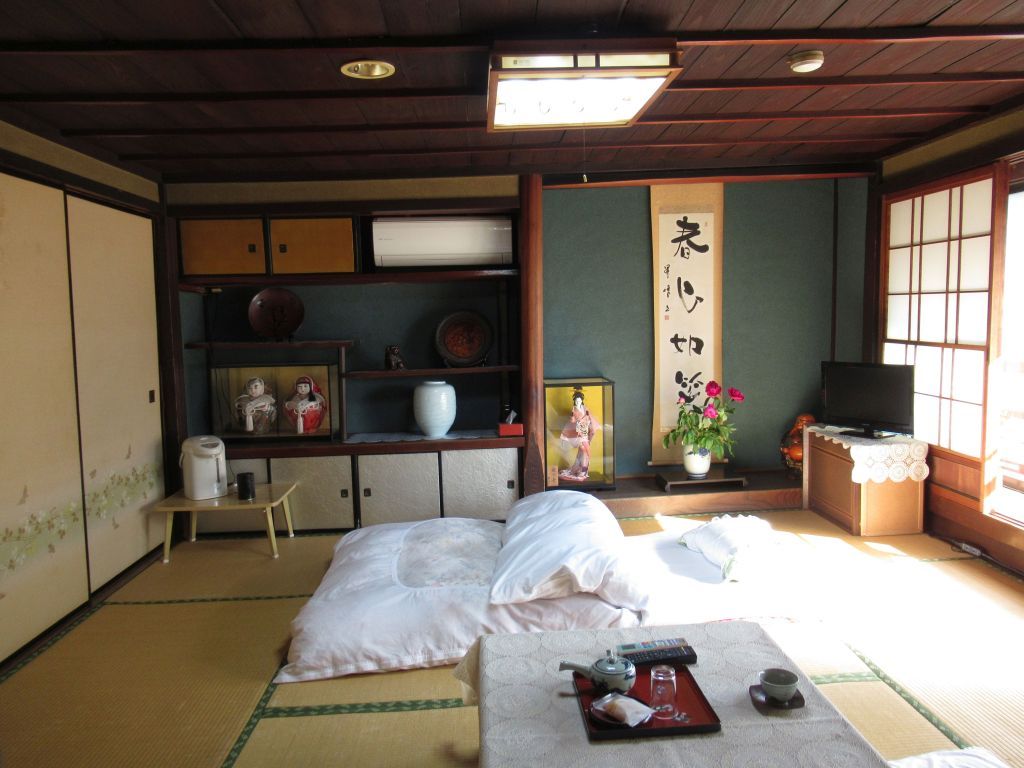
What is the same in all of the above is that dinner is always at 6pm and breakfast at 6am or 6:30 am: Japan is on solar time, especially in rural areas. And no matter if you are in a minshuku, a ryokan or a shukubō, you wash your face and shave with cold water using sinks in a corridor, because the shower and bath rooms are closed in the morning.
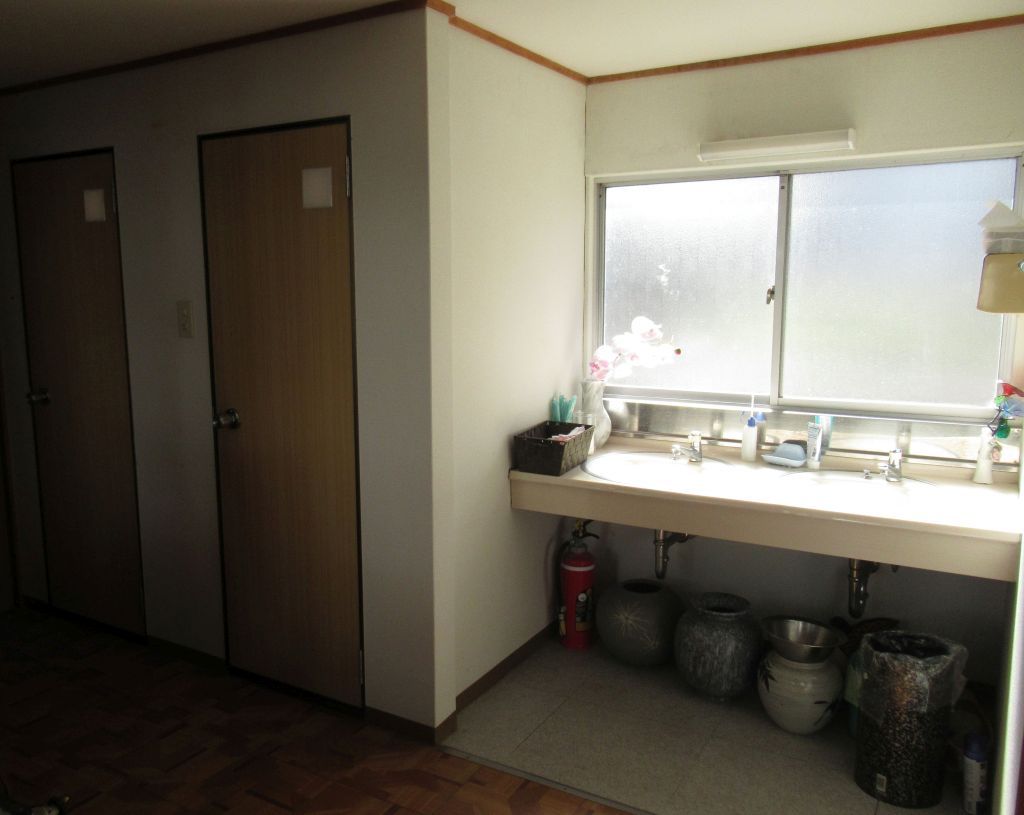
Another peculiarity of rural Japan is that credit cards are still seldom used: the only means of payment is still cash only. Better have correctly evaluated your budget with regards to your weekly cash withdrawal limits in ATMs which for a foreigner can only be those of the Post Office or of the 7-Eleven outlets: all other ATMs in Japan are incompatible with cards issued by foreign banks.
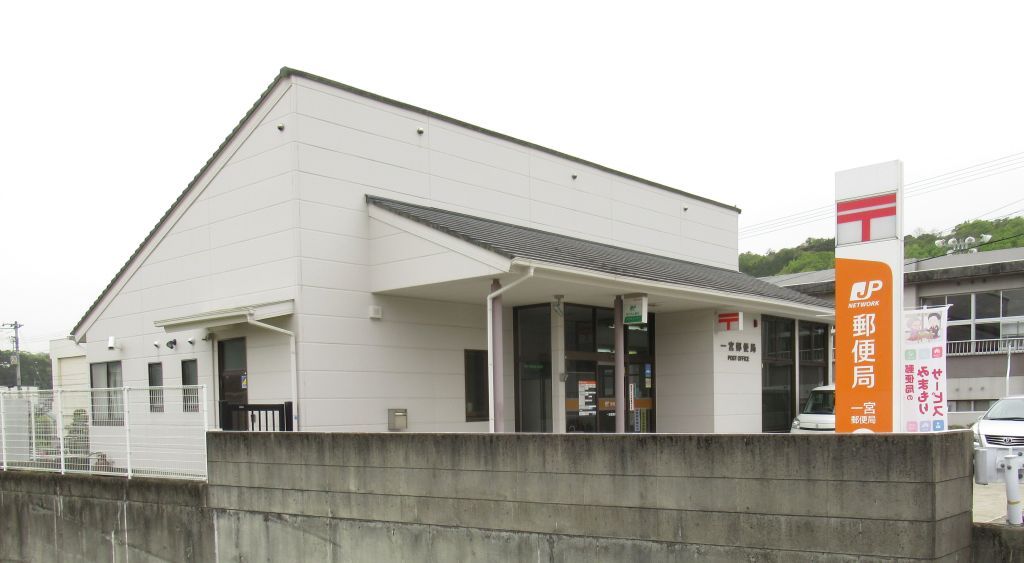
Post Office 郵便局, identifiable by the T with a double red horizontal bar and the logo on an orange background.
If the minshuku and ryokan are all booked full, or if you are desperately short of cash despite a healthy bank account balance, you still have the solution of the business hotel where you can generally pay with a credit card. This category of hotel is actually tailored for low-cost business trips. There is no dinner offering and often no breakfast either. In a rural area, you would rather call it a motel, with small Western style rooms having their own compact bathroom.
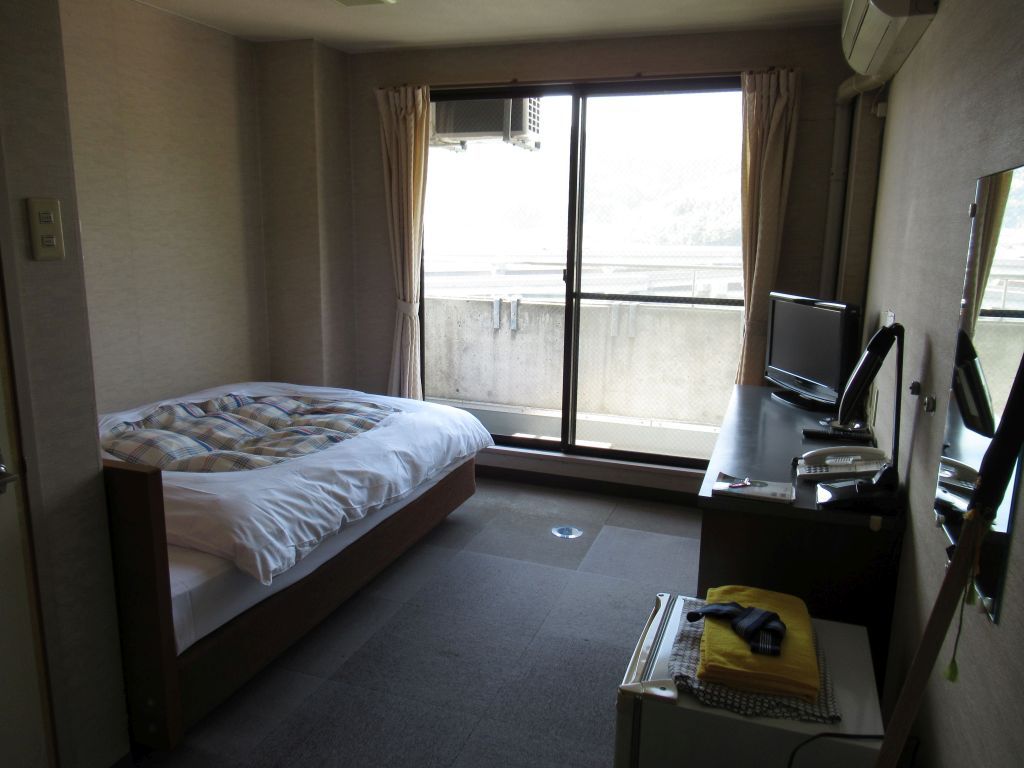
This one was easy to find, with this giant sign providing the access information when reaching the outskirts of the town.

There was of course nobody waiting at the reception, and better have booked in advance, with this sign 漫室 (“Full”) on the counter. And then what ? It was simple: just read the hand written memo on a Post It Note on the phone: “To call the reception staff, please dial 7 on this phone”.
Once I called and specified that I indeed had a reservation, a young staff promptly arrived and handed me my room key. (This business hotel happened to be the only one where I had to pay cash.)
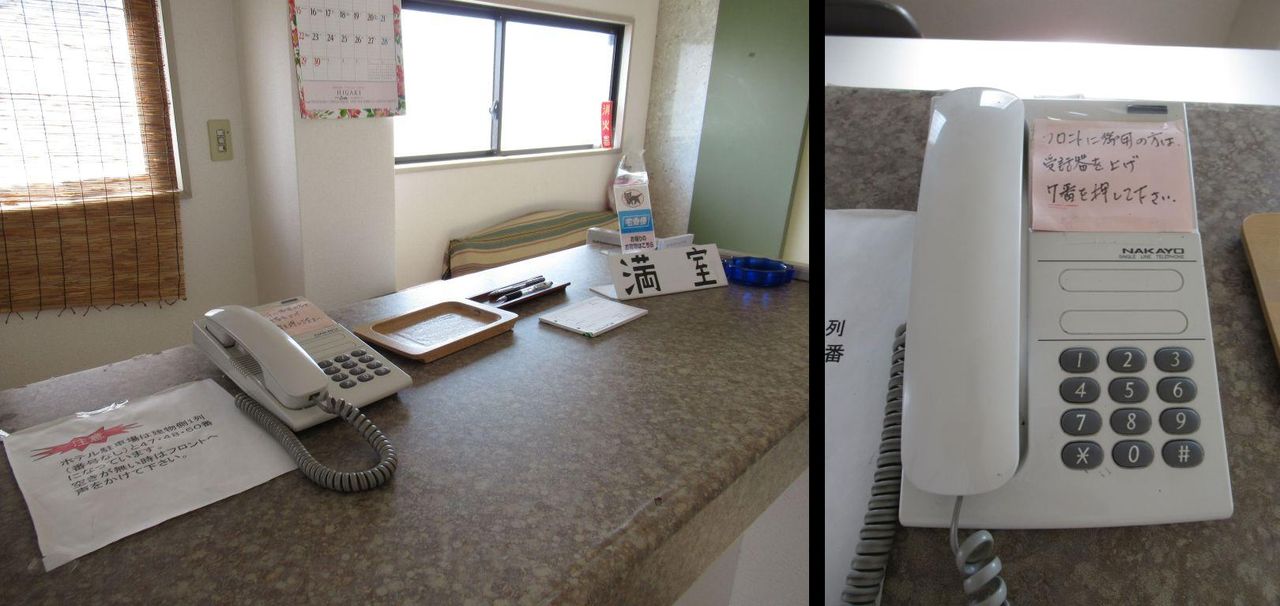
There are other facilities dedicated for pilgrims: there are open shelters at irregular intervals for taking rests, sheltered from the rain or the sun.
These shelters were listed on the map, in this one which was at the edge of a michi no eki 道の駅, an untranslatable name which designates a kind of pit stop without a gas station alongside a major road instead of an expressway.
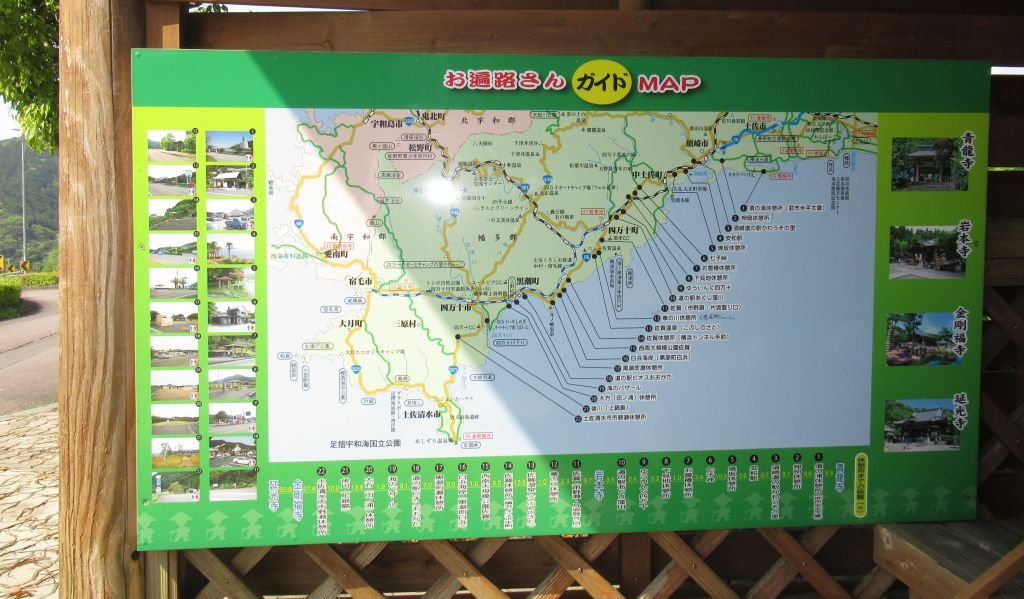
These shelters are sometimes an opportunity for pilgrims walking at a similar pace for meeting: within a quarter of an hour, this one filled with ten pilgrims (seven Japanese, a permanent resident Indian, an Australian and myself) who all had already met here and there in the preceding days and exchanged gossips on missing pilgrims:
- Have you seen again the French girl on a bicycle ?
- Yes, I saw her yesterday. How about the Spaniard ?
- The crazy guy with ruined shoes ? Yes, he is still walking with the Dutch girl. But the other Dutch girl has stopped.
(I had little doubt that I was identified as ‘The Frenchman with a 13 kg backpack”, an extravagant weight among pilgrims who usually carry at most half as much).
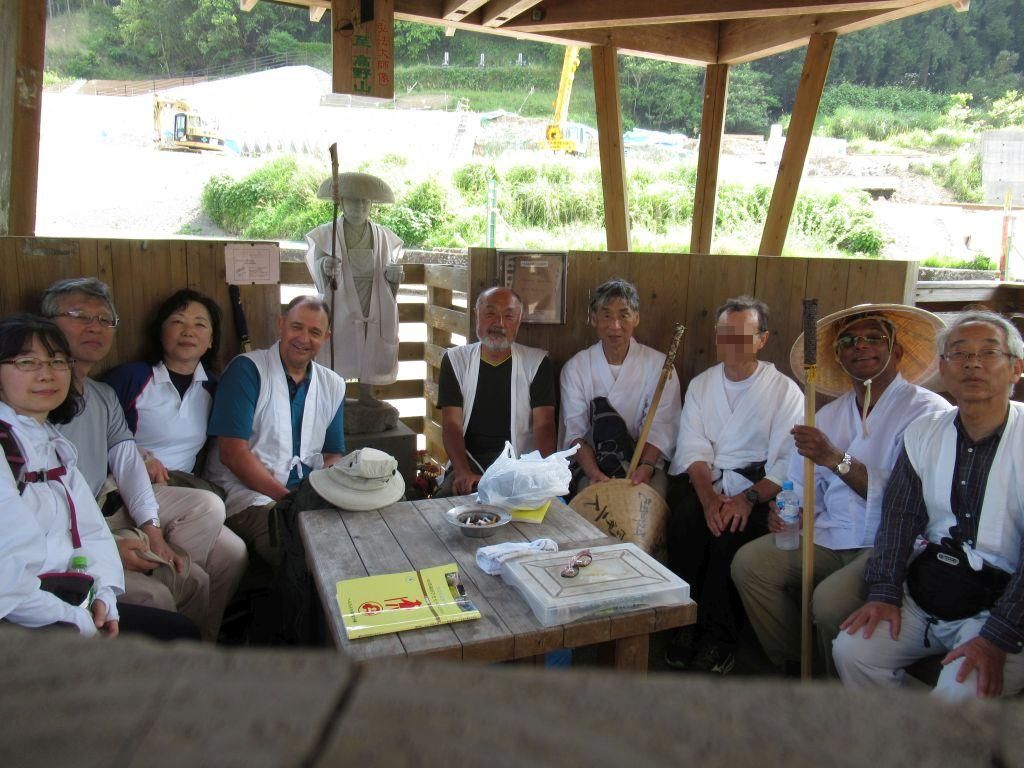
The “French girl on a bicycle”, reaching Temple #28
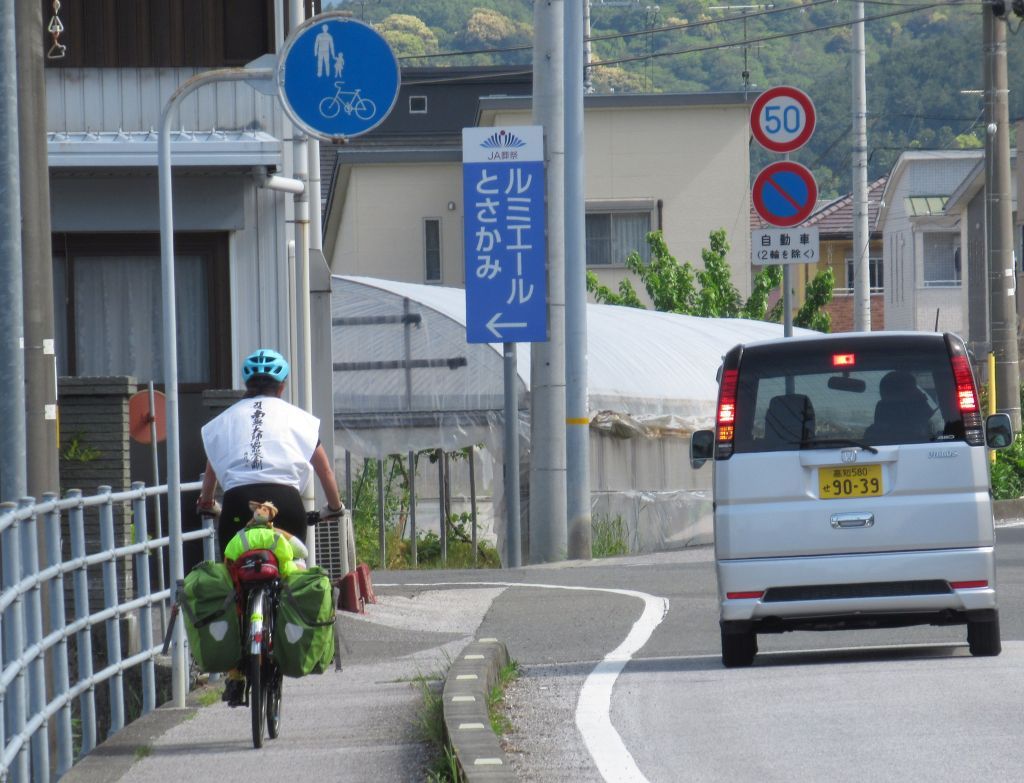
What kind of souvenir can you bring back from your pilgrimage ? The Japanese have a passion with travel diaries adorned with stamps from each location they have been too: tourist sites, stations, accommodations… there is often a stamp for self-use in order to record the fact that you have been there.
Nearly all pilgrims have a nōkyōchō 納経帳, i.e. a stamp book with at least 90 blank pages (you need 90, because many return to their starting point, and the tradition is also to start or finish the pilgrimage at Kōya-san 高野山, the monastery founded by Kūkai).
The calligraphy of temple #5 in my nōkyōchō, left, with the Sanskrit character designated Kūkai on top. On the right, the calligraphy of return to Temple #1, with the date of end of my pilgrimage on 26 May of Year 30 of Heisei Era, before a grand finale at Kōya-san.
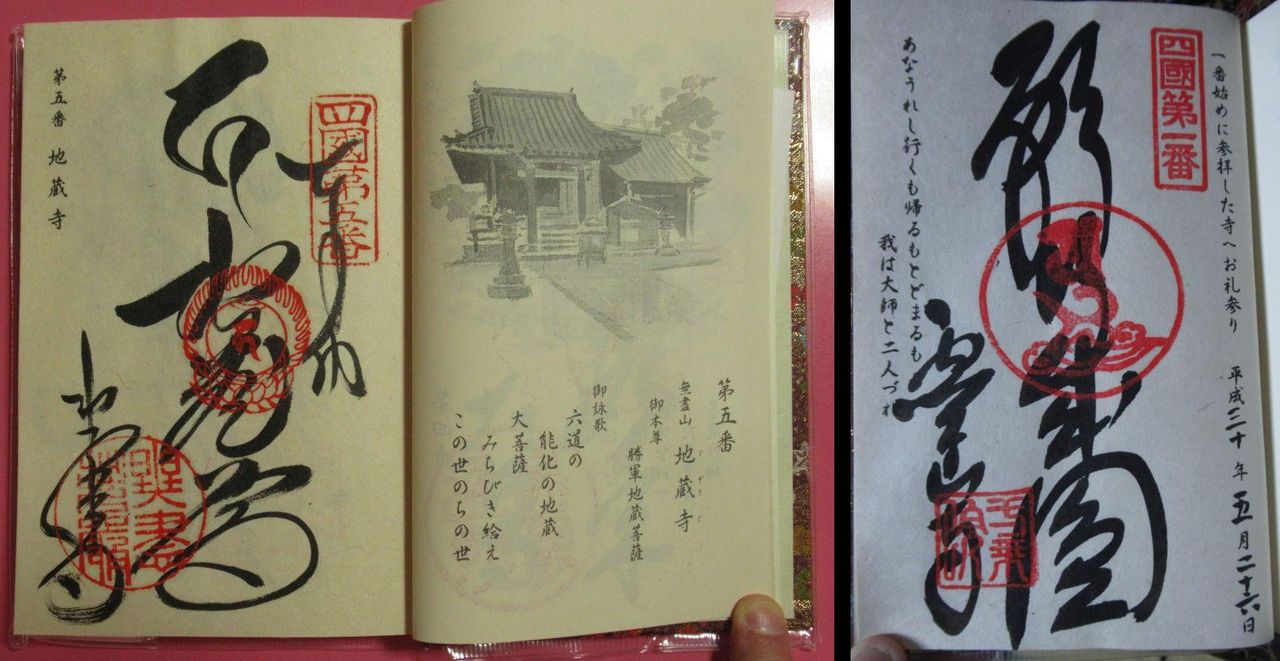
In each temple on the way, pilgrims go therefore to a specific counter, the nōkyōjo 納経所, where a monk or an employee stamps with red ink in diagonal on the page and writes in a few seconds a calligraphy (before or after stamping: it does not seem to matter). Unless you reached the temple shortly before the 5pm deadline, pilgrims go there after praying, because the stamps and calligraphy are also a symbolic acknowledgement of their prayers. (This symbol is debatable in the case of groups where a staff brings the whole pile of nōkyōchō to the nōkyōjo for stamping and calligraphies as soon as they reach the temple). There is a 300 yen fee for this calligraphy and stamping: not much per temple but it is multiplied by 90; it is lucrative for the temples given the little amount of time spent, but they need income to operate and maintain their premises.
This tradition is not a novelty: I found this one (below right) dated 1827 in the small museum which is halfway between Temples #87 and #88.
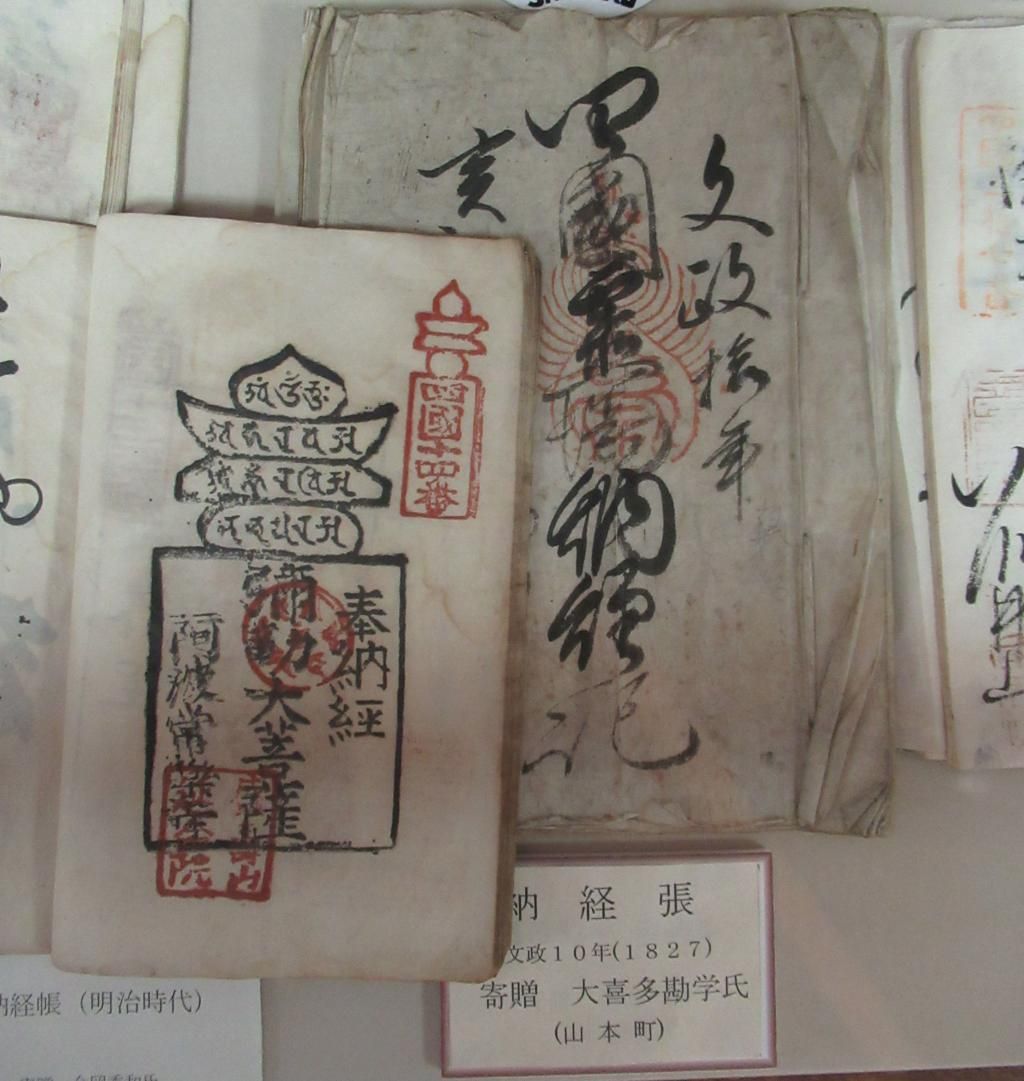
The tradition is that if you do the pilgrimage again, you reuse the same nōkyōchō which is stamped again three times on each page, without a new calligraphy. (There is less work, but the fee remains set at 300 yen!). Look at the nōkyōchō of this pilgrim who was doing his sixth pilgrimage: the pages are nearly entirely red, but the six aligned vertical stamps can be distinguished on the top of the pages. (The torn newspaper in his hand is a routine replacement for blotting paper. )
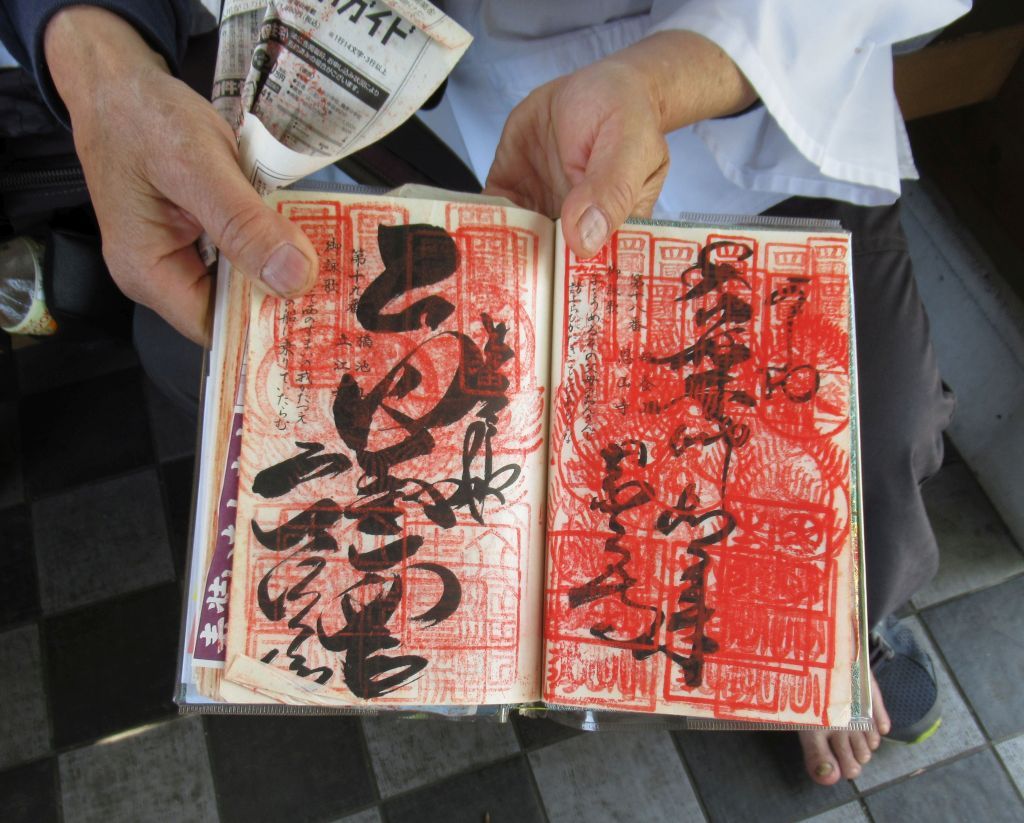
Many Japanese pilgrims don’t do the pilgrimage continuously like I did, but in successive stretches (pilgrims on the Way of St James do that too), and preciously keep their nōkyōchō to complete it progressively. This was the case of this adorable 60 year old pilgrim who was resuming with her husband the pilgrimage that they had stopped fifteen years earlier. One of them had a nōkyōchō, the other a kakejiku 掛軸, i.e. a hanging scroll which would eventually decorate the best room in their home.

The third option is to have a special hakui (the white cotton vest of the pilgrims) stamped and calligraphed. It is carried around with great care and never worn during the pilgrimage, because this will be the pilgrim’s funeral garment.
The fee for a kakejiku or for a hakui is set at 500 yen, possibly because they are more bulky and require more care, therefore a little more time.
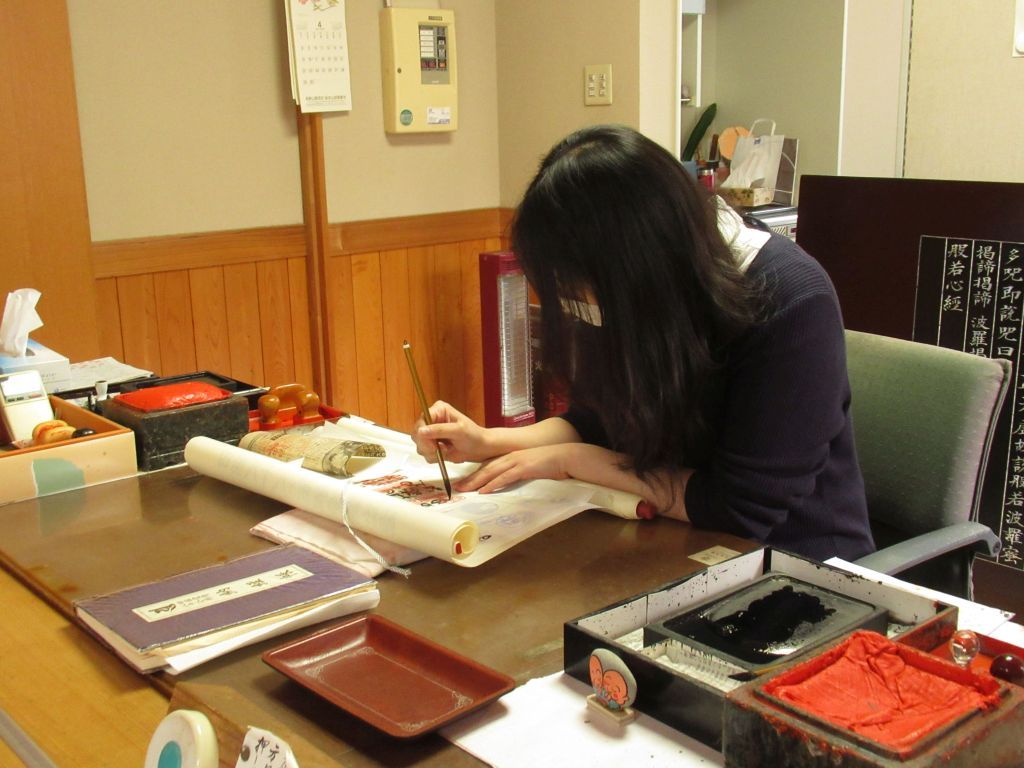
This is a completed scroll seen in a minshuku where I stayed. This item costs overall a minimum of 90 000 JPY, because the blank scroll is somewhat expensive, and after paying 500 JPY for each of the 90 calligraphies, you then need to have it framed for support and aesthetics. No small change overall; this is the only item about which I heard unsubstantiated rumors of theft (towards the end of the pilgrimage, when nearly all calligraphies are in).
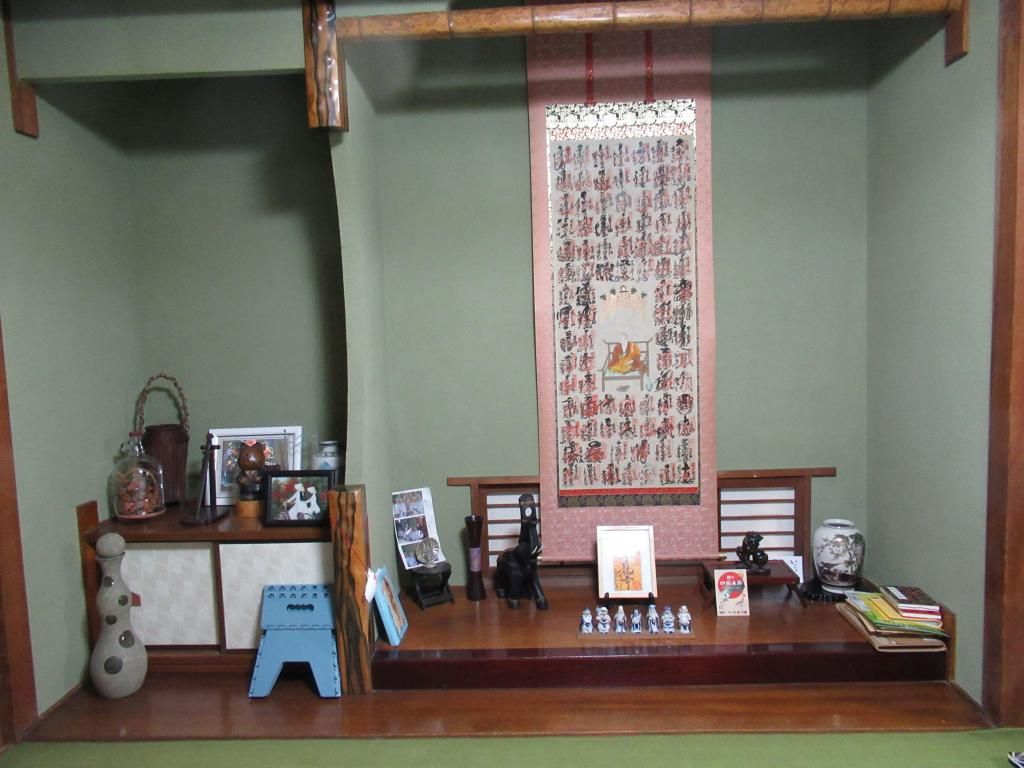
I would have liked a kakekuji, but the idea of carrying it around on a 1,200 km hike without damaging it, especially in rainy weather, was dissuasive, even though it comes with a dedicated sheath.
Pilgrims do not fear murderous highway robbers or catastrophic infections after a minor scratch; what about tsunamis ? They are actually both extremely rare and devastating in Japan: everybody remembers that of 2011 which made thousands of victims and caused the Fukushima disaster, but historical records list only eleven which resulted in a significant number of victims since the 9th century. No matter how small the probability of being hit by a tsunami, nobody can blame the local population to prepare themselves against the next one.
The first precaution consists in warning the local population and visitors against danger areas. Signs indicating the local elevation above the sea level are ubiquitous in coastal areas. The one below left mentions that you are 2.90 m above sea level and indicates the direction to a primary school 250 m away whose buildings could be used as a shelter. On the right, this section of the coastal road is signaled as a danger area in case of a tsunami because there is no refuge in the vicinity (the forests are usually so dense and steep that they are rightfully considered as impenetrable).
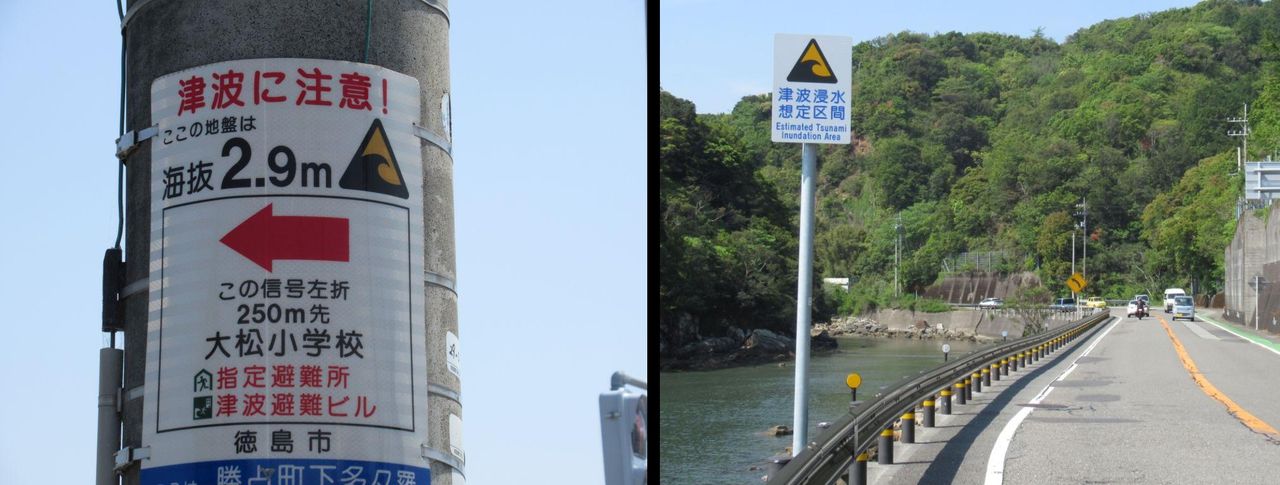
Time counts when a tsunami alert is issued, and in the minshuku where I spent the night in Muroto 室戸, I found this map of floodable areas depending on the height of the wave, together with the delay between the tsunami warning and its landfall for a 1m, 3m and 5m wave, respectively. The column on the left listed the worse recorded tsunami height; it was no surprised that all this was here because Muroto (second line in the table) had the worst parameters of the region: a record 24m high wave and a warning delay of 3-4 minutes only.

When high ground is too far away to be reached in case of an alert, and if there is no building which is both tall and strong enough to be used as a refuge, the Japanese built dedicated ones. This massive concrete structure next to a beach favored by surfers is not a failed real estate project. It is a tsunami tower: a structure strong enough to withstand the force of a tsunami wave, with stairs and a helicoidal ramp so that reduced mobility people can reach the top level.
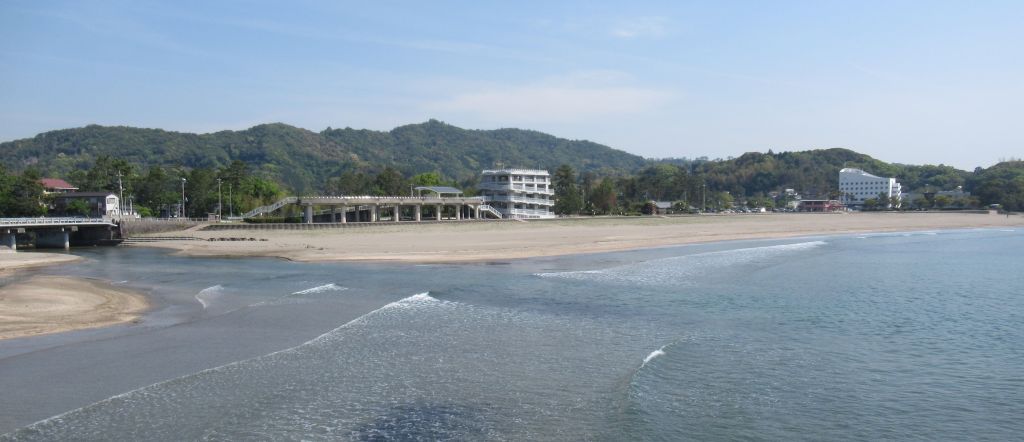

I have seen many with a metal structure, looking somewhat like multilevel bicycle parking lots, located of course in close vicinity of homes, with dubious results in terms of aesthetics.
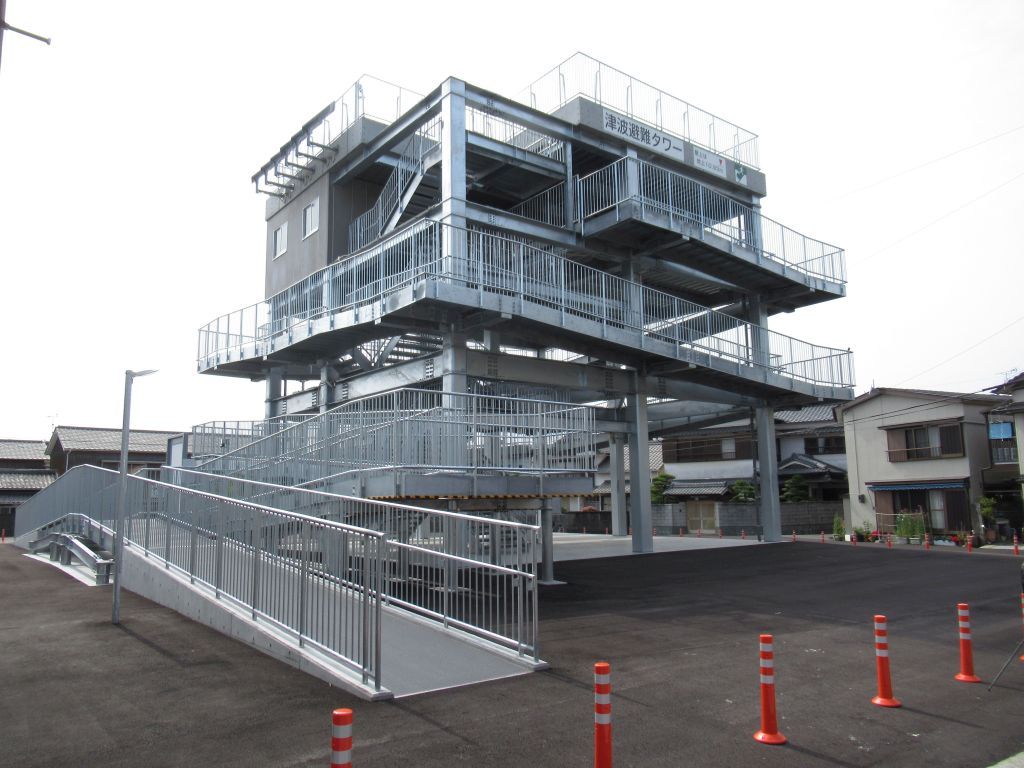
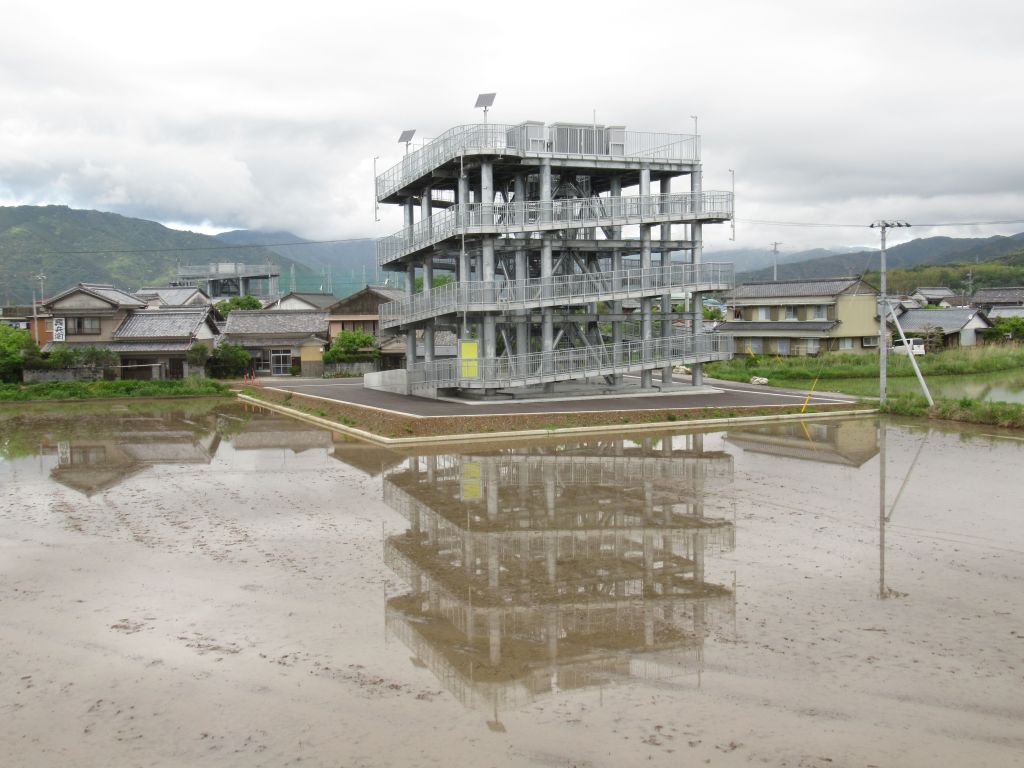
The other method for protection is a dyke high enough to stop the tsunami wave, on top of which the coastal road is often built. The drawback is evident: house which used to be on the seaside are now behind a concrete wall which blocks both the view and the sunshine.


Safety is also that of the pilgrims on a route which is at least 85% on roads, major ones and local ones: only in the mountains do they walk on trails. The sign just before the southern entrance of Tosaka Tunnel 鳥坂 warns the drivers against the presence of pedestrians with a typical silhouette inside the tunnel and tells them to check that their lights are on.

Safety befalls to all, and if the vehicles must be adequately lit, the pilgrims must be adequately equipped. I came upon this box, just after the sign for the drivers, with this explanation on top of it:
For tunnel crossing safety, please use a reflective sash.
Please return it to the box at the exit of the tunnel after use.
There was indeed a bundle of high visibility sashes inside, and a high visibility stick too for groups.
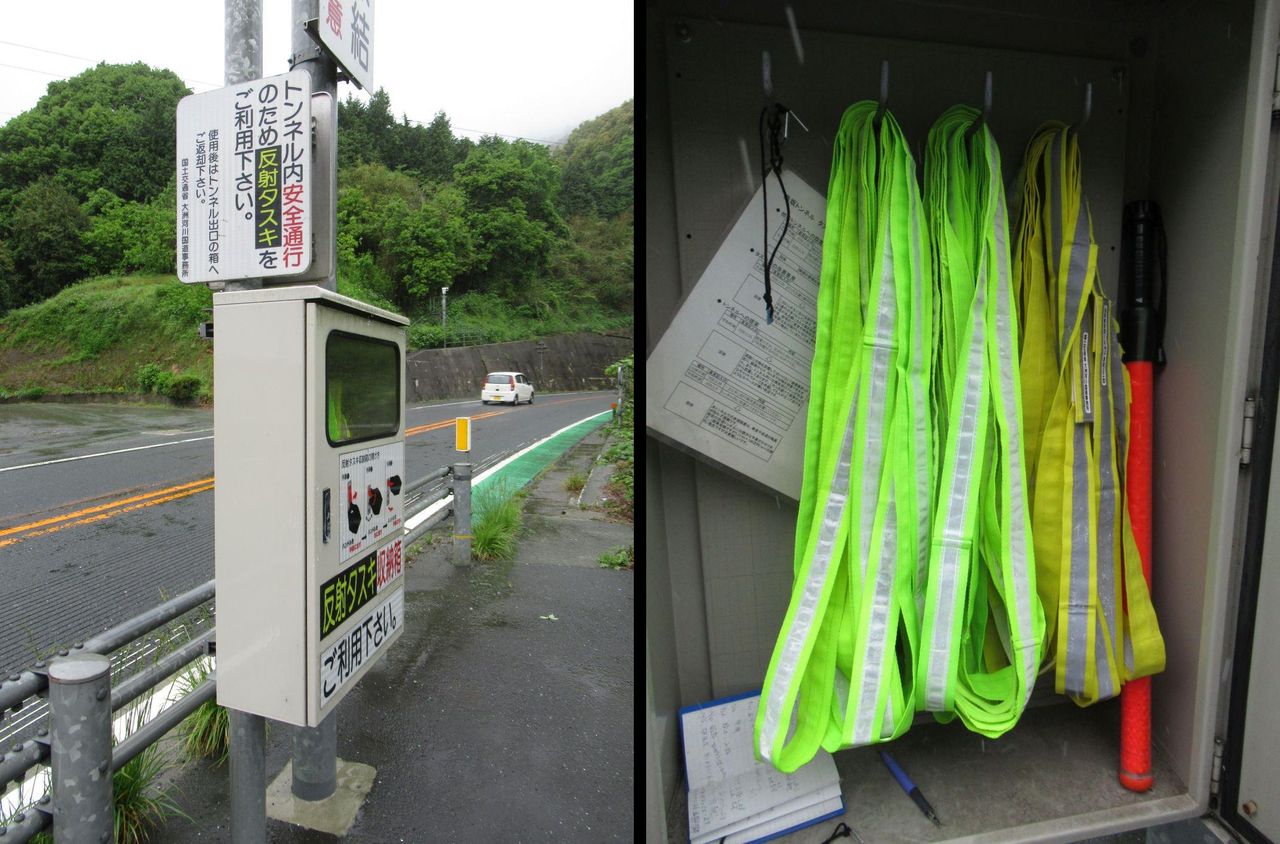
There was no reason to not wear one of these reflective sashes, all the more that the space for pedestrians in the tunnel was unusually narrow, narrower than my walking stick was long. The truck drivers were leaving as much separation distance as they could, which was not much because their lanes were not very wide either.
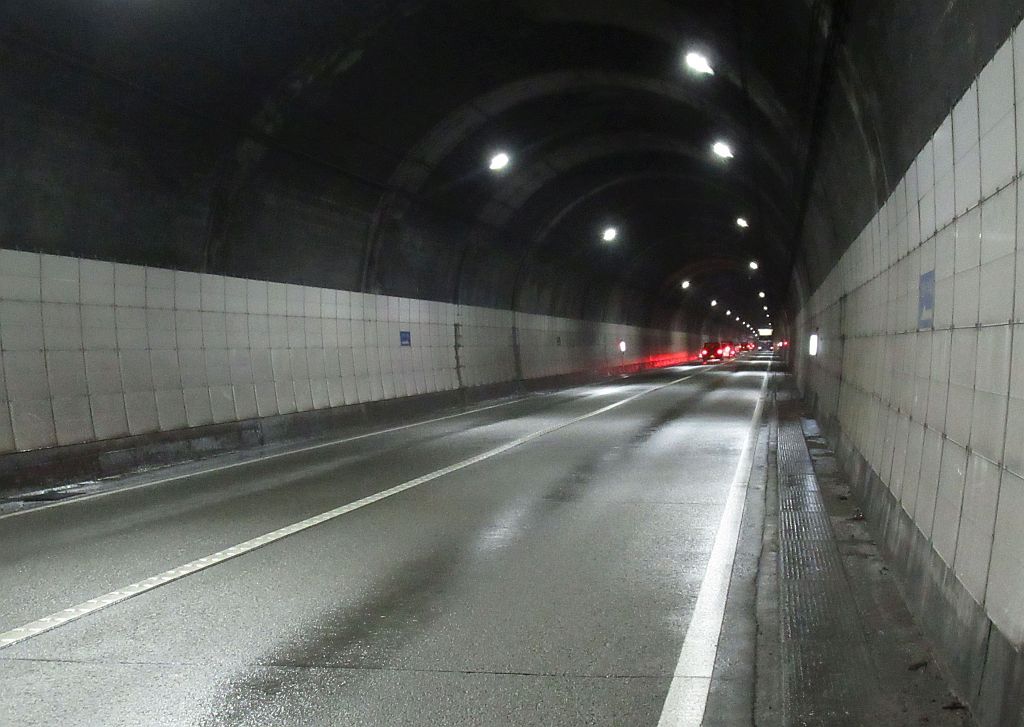
There was indeed an identical box on the other side of the tunnel. Since there are much fewer pilgrims walking in the reverse direction, I guess that a staff transfers everyday sashes back to the south tunnel exit. In what other countries would this kind of equipment be placed at the disposal of all in a self-serve manner?
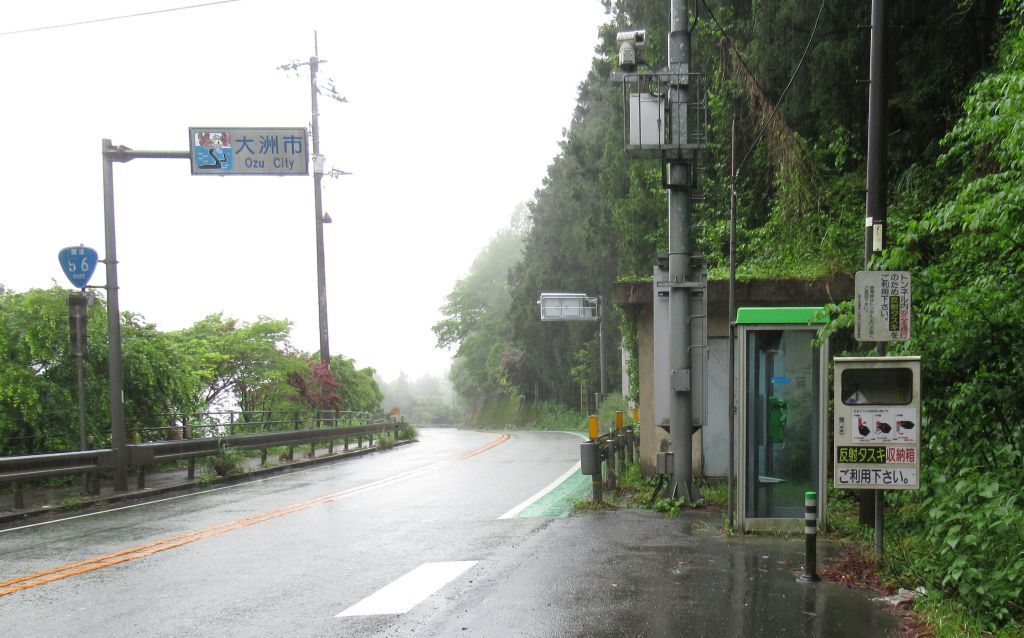
You may have noticed that the road above was very wet. There were days when nobody would want to venture outside, but pilgrims did.
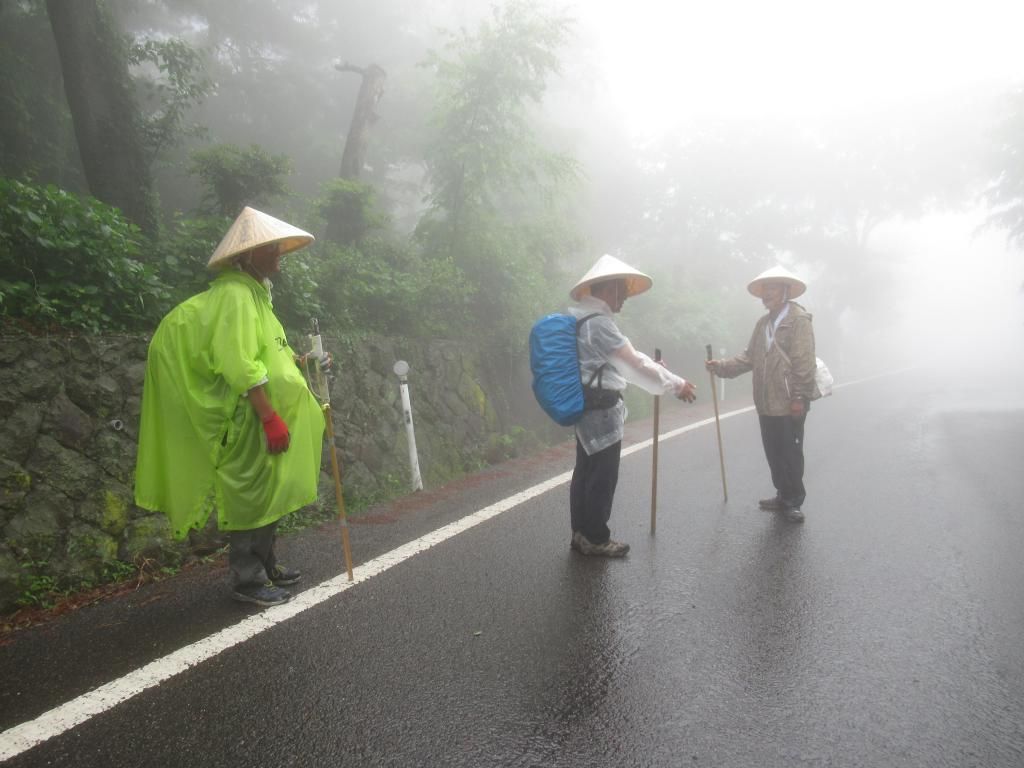
The day before and after a pouring rain, there could bright sunshine and Japanese women often protect each square inch of skin from the sun: tanning is definitely not the fashion there.
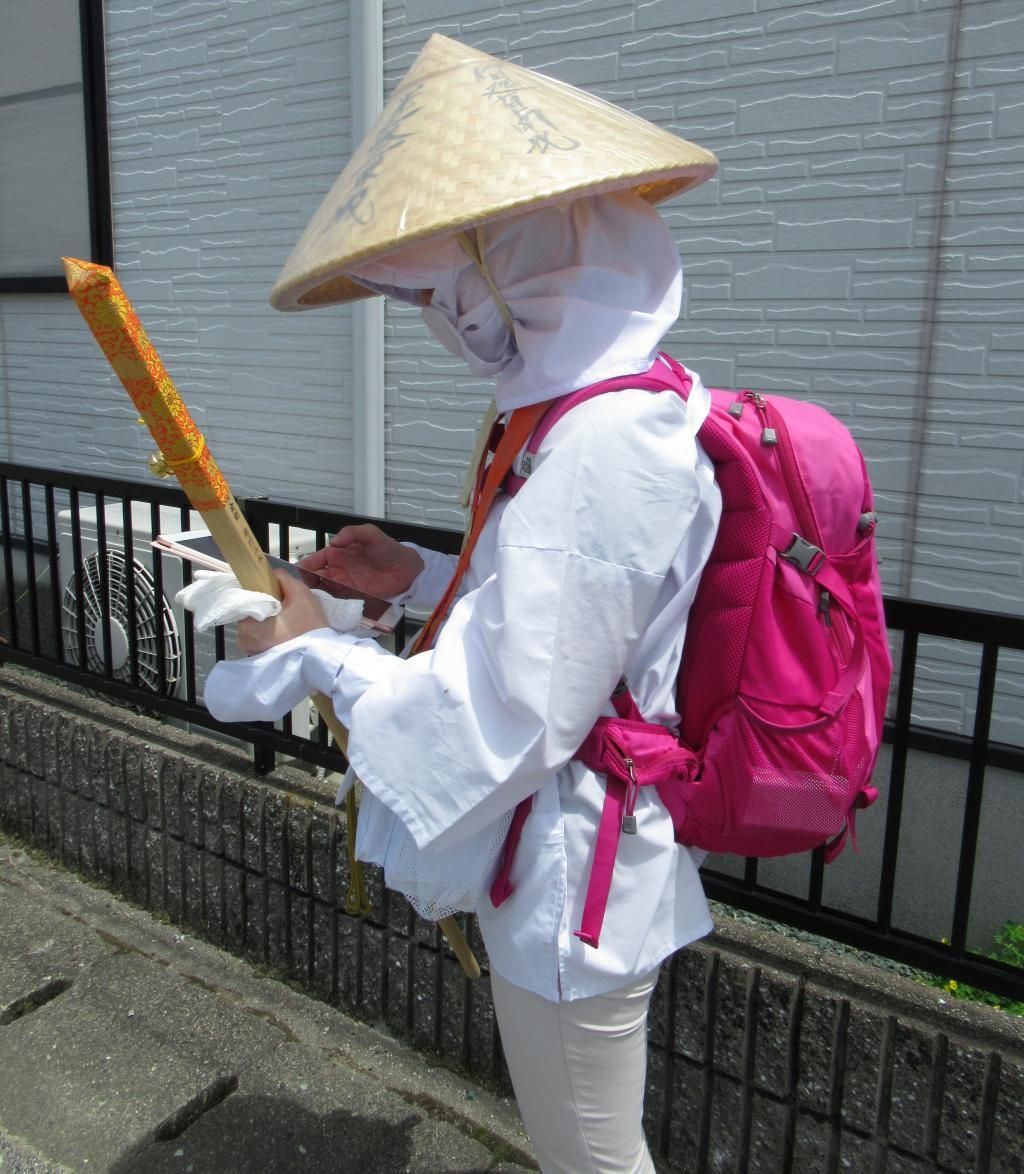
Apart from tanning (but all convenience stores have an ample supply of sun blocking creams), the Shikoku pilgrimage is not dangerous (it was another matter two centuries ago). In Japan like in other countries where they roam, boars are dangerous for cars, not pedestrians.
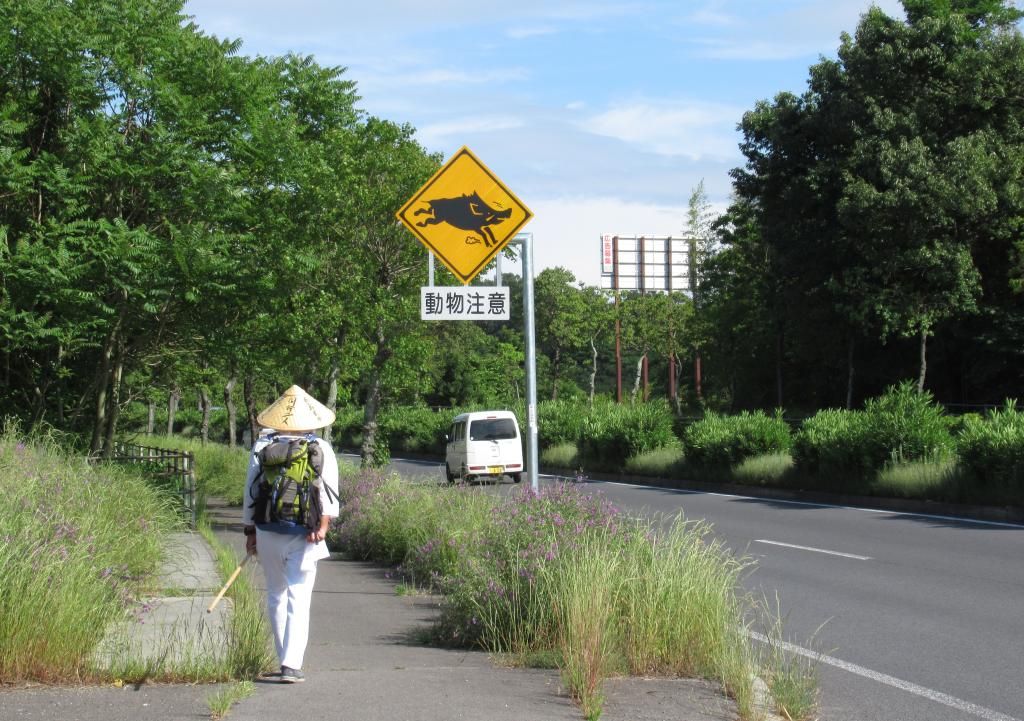
Apart from spiritual goals, doing the Shikoku pilgrimage is also an opportunity for discovering places and landscapes that ordinary tourist see little or not at all.
For instance the Niōmon Gate 仁王門) at Daihōji Temple大宝寺 , a.k.a Temple #44. Nearly each temple in the pilgrimage has a Niōmon Gate, with two fierce looking giants; the one on the right has an open mouth symbolizing birth (the baby cries at birth) and the one on the left has the mouth shut (the man becomes silent forever upon death).
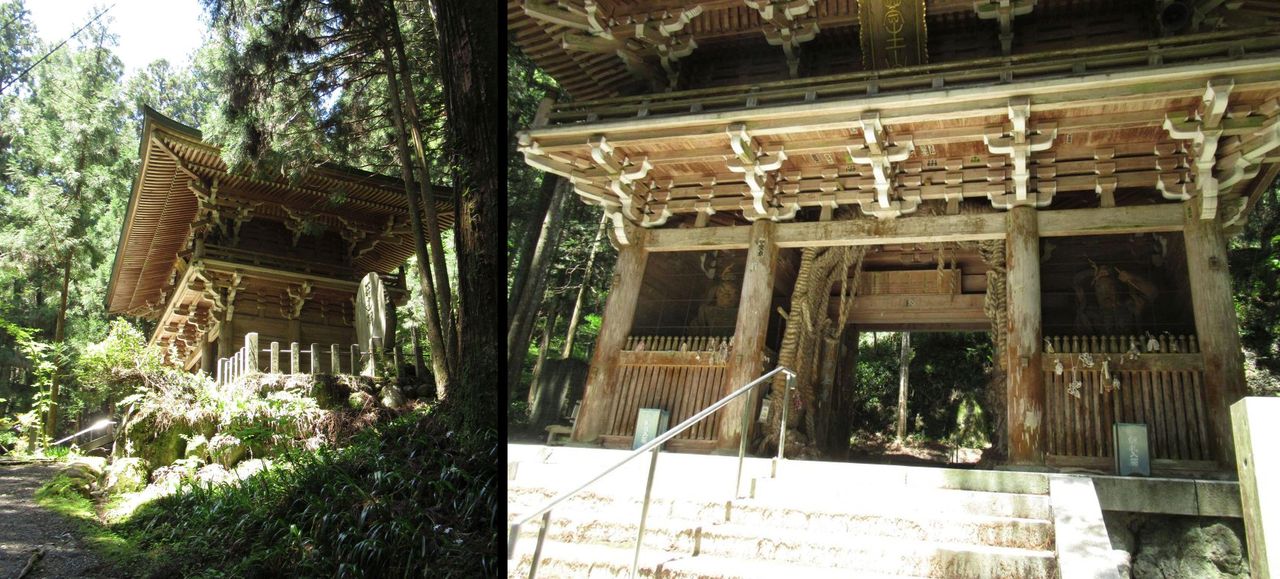
The curiosity there (and in a small number of other temples) is the pair of giant straw sandals placed on both sides of the gate. These are votive offerings for protecting pilgrims in their perilous journey, from the time when they would wear rice straw sandals on difficult trails. They probably did not last long at that time; on the other hand, those of the Daihōji are traditionally made again every one hundred years. The tradition of offering straw sandals as a protective rite remains: miniature or regular straw sandals are sometimes attached at the Niōmon Gate or placed as offerings at the main temple.
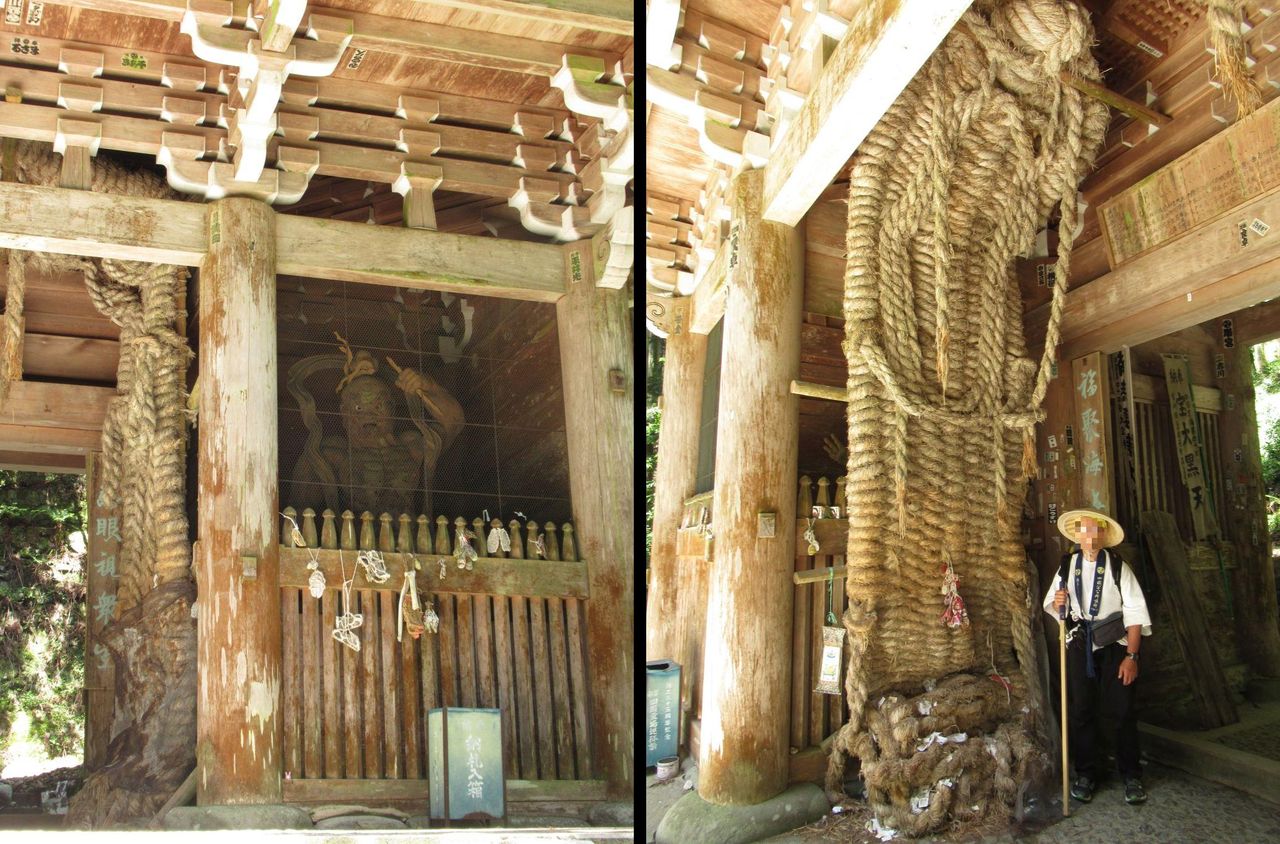
This magnificent rose garden along the local road on the pilgrimage route ? This was another king of offering for pilgrims: the owner had simply placed a sign with a neatly handwritten invitation:
“Please!! Feel free to take some rest.”
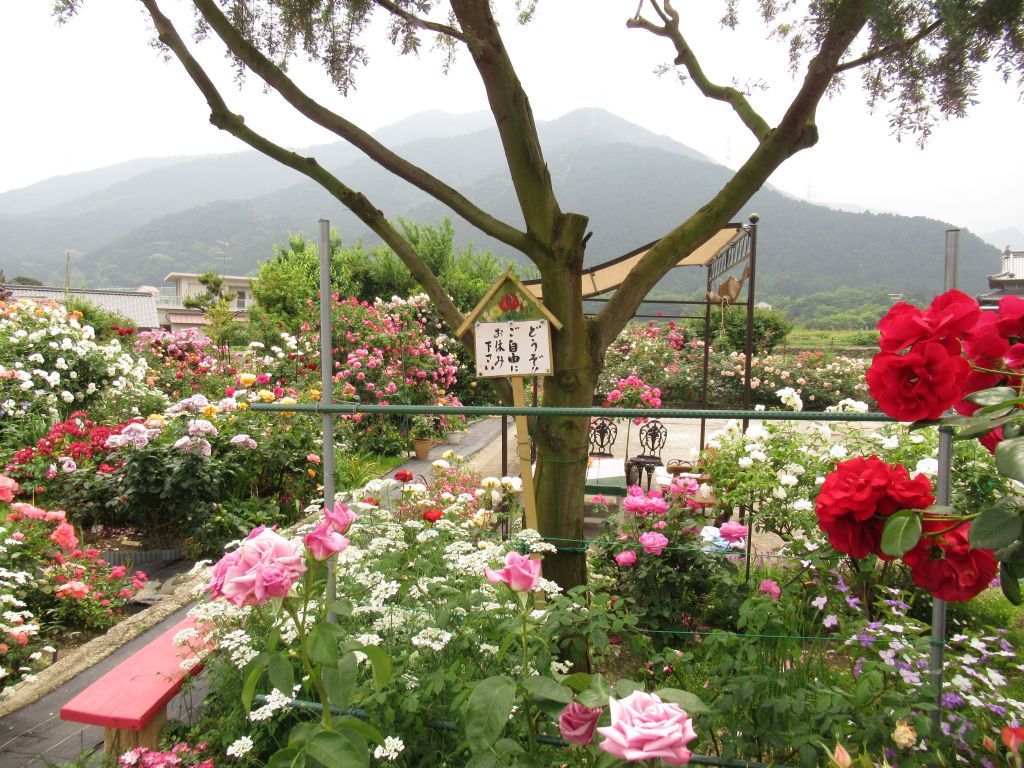
There were seats under a small sun shade to be protected from the blazing sun, and grapefruit ostensibly offered to pilgrims stopping here, with even paper towels to wipe hands and a plastic bag for collecting the peels.

Zentsūji Temple 善通寺 (temple #75) would be nothing out of the ordinary if it did not provide a sweeping view on the city of Marugame 丸亀 and on Minami Bisan Seto Viaduct 南備讃瀬戸大橋, the southernmost bridge in the succession of viaducts linking Shikoku to Honshū. What would Kūkai have thought about it – he has been an engineer in the modern meaning of the word too?
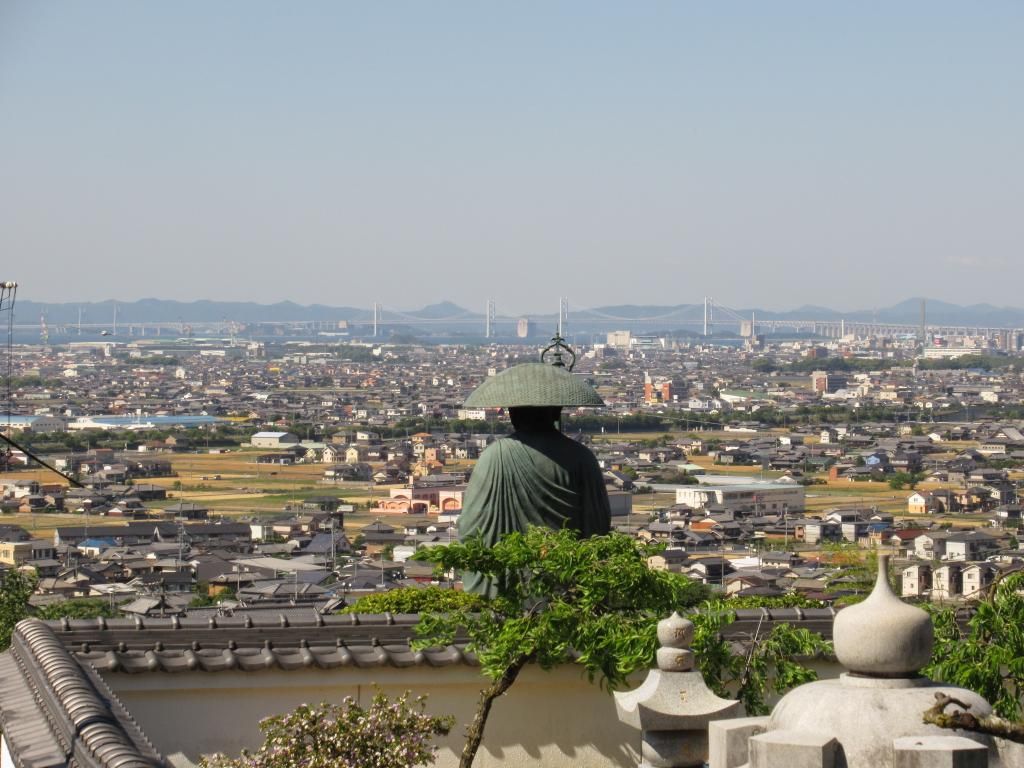
Shikoku’s airports are few and the island is outside usual air routes: I hardly ever saw any contrails anywhere, even though I had many days of blue skies. Better not be too demanding in terms of plane-spotting.
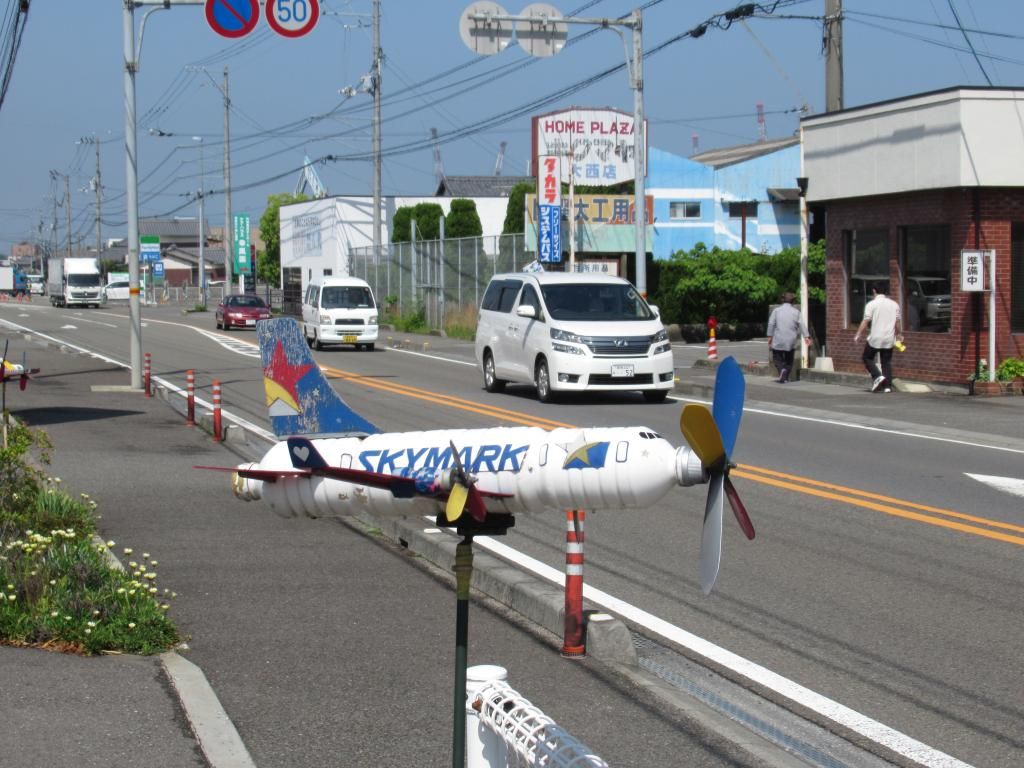

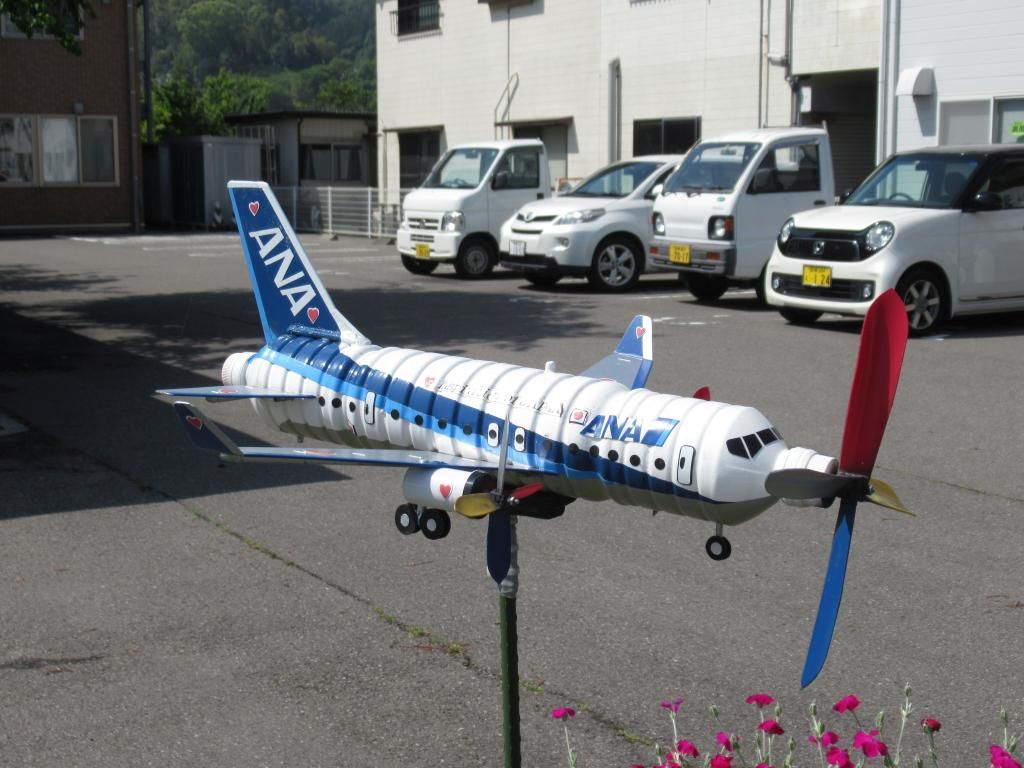
Now, seriously, pilgrims have nevertheless a beautiful panorama of Matsuyama from the trail just after Misaka Pass 三坂峠.
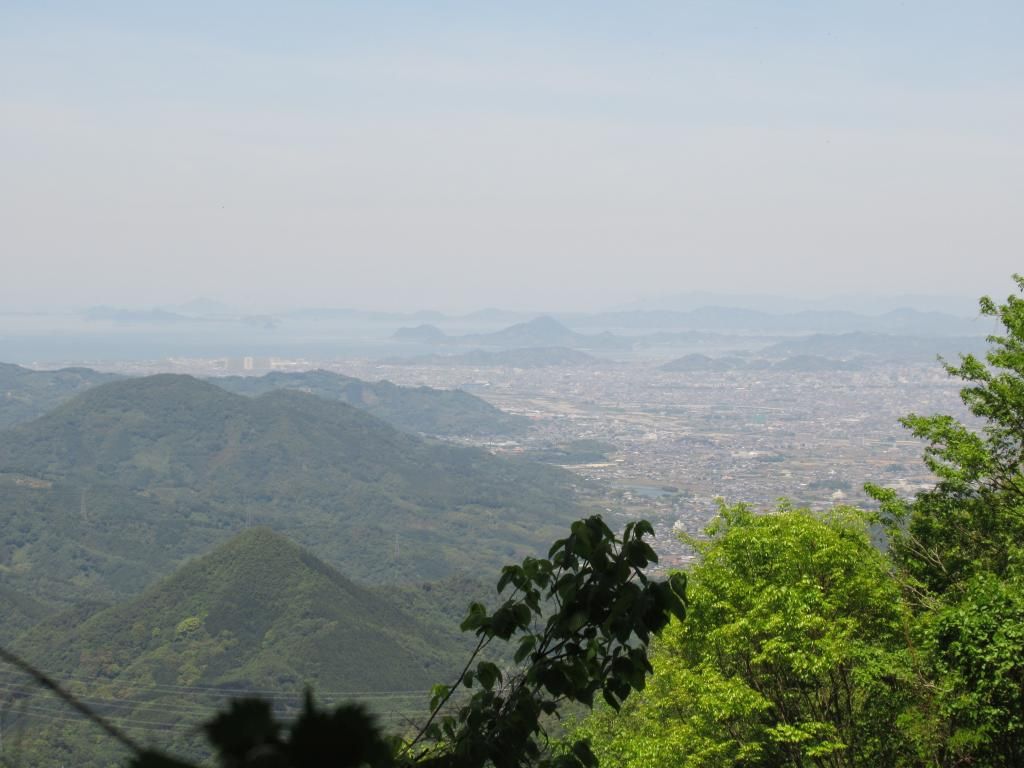
And on its airport (on the left above), nearly the way pilots landing on MYJ’s Runway 32 see it.
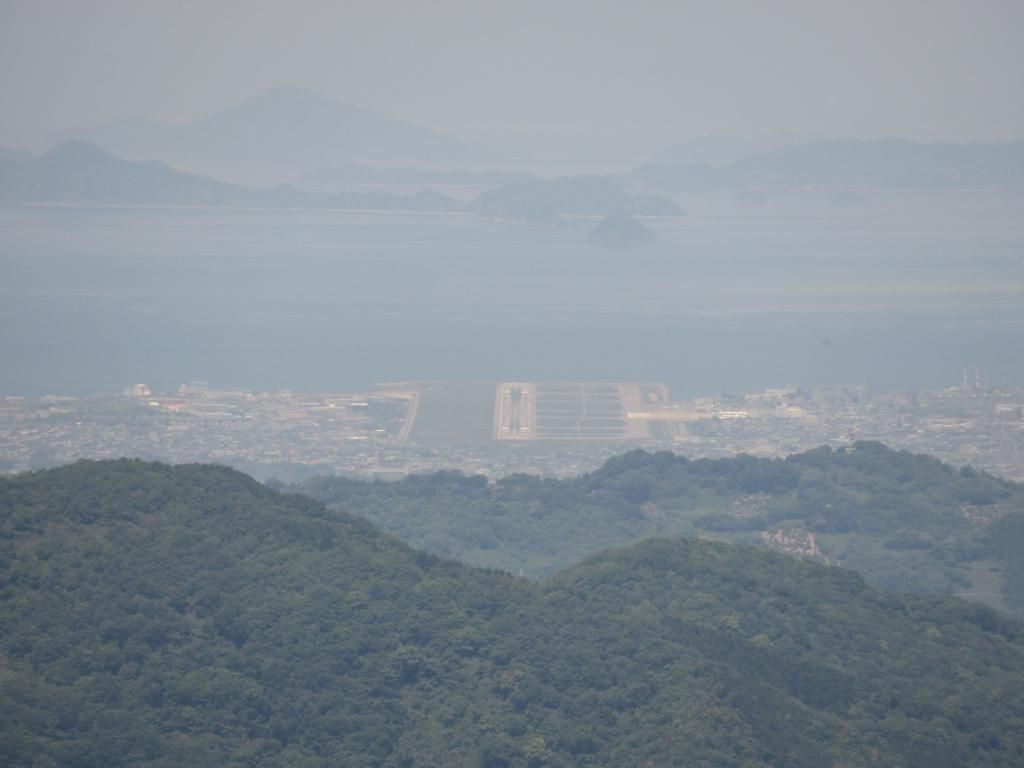
It is impossible to summarize in a satisfactory manner six weeks of pilgrimage: my two bonuses are similar to this self-portrait with a young Buddhist nun left (note her longer monastic stick with a specific decoration) and a middle-aged Japanese man in search for a new meaning for his life, right: you only have the outlines.
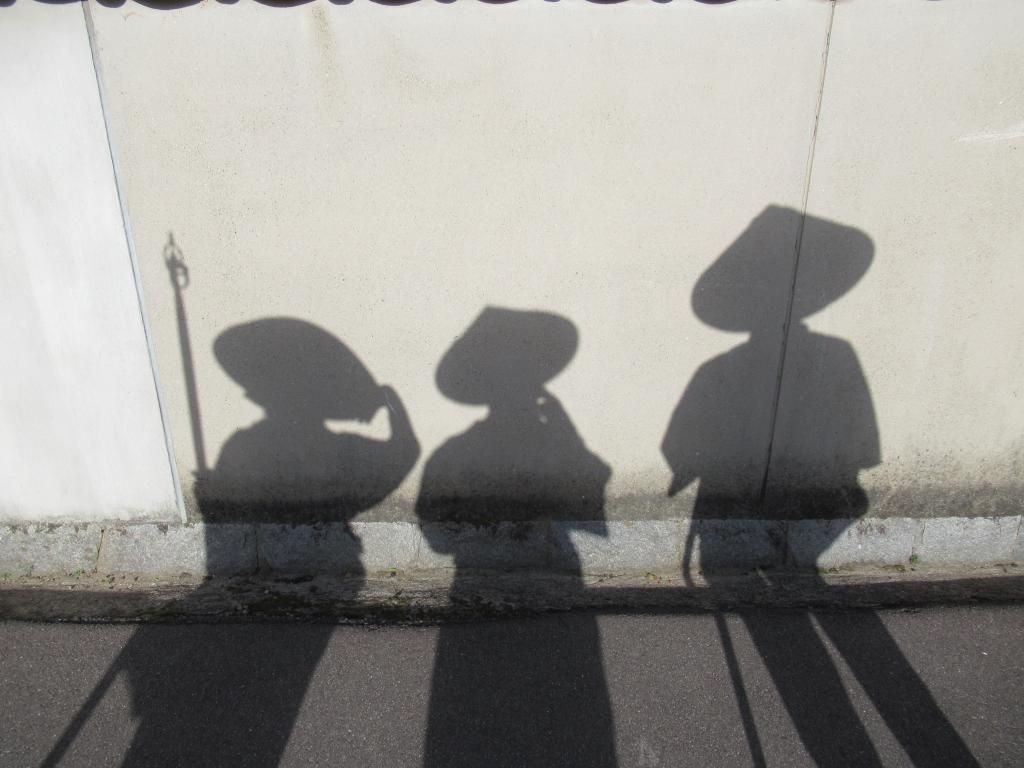
Thanks for reading me !



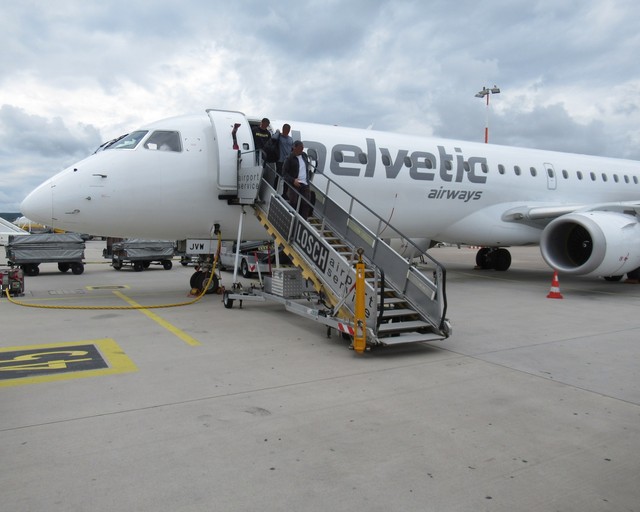

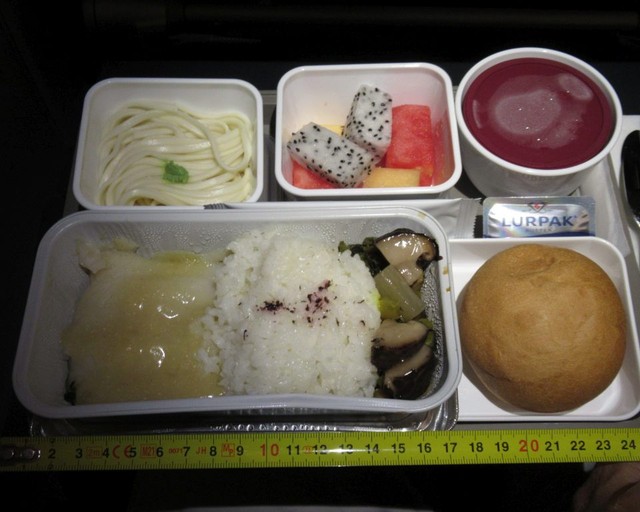

Thank you for sharing - yet another lovely report as always.
Spend “upwards from” 319 EUR or 53,200 miles to travel in Premium Economy? No, thanks.
- You should check how much they would actually charge you, but it's good that at least award tickets are still upgradeable - on GA (and perhaps many other carriers as well) they wouldn't even allow it at the first place.
... spare me “walking all the way to the station with my heavy backpack”
- What makes your backpack heavier than the other pilgrims? 13 kg is a lot, and even at only 8 or 9 kg I would have already thought of it as too heavy for me to bring.
My charitable guess is that they do not know the historic meaning.
- I wonder what does that mean? But still, the bread looked way more substantial than what you could have in many carriers' economy class so let's say of it as a perk of flying AF?
The empty middle seat gamble had been lost, but a Japanese neighbor was a guarantee of an armrest truce for the entire flight, and more generally trouble-free behavior.
- Do you happen to know how was the load for that day in economy?
The selection of classical music was decent. I am always annoyed that the record labelling focusing on the interpreter, not the works themselves, identified by the composer’s name only if it appears at all: you need to select the recording to know more about it.
- Perhaps time to put it like Spotify where everything was displayed (e.g. the composer, conductor, and orchestra)? But then, that would amount to more computational power needed and IFE isn't exactly known for being as fast as a PC.
I especially loved the unique bonus which seemed to be a very interesting experience - once again thank you for sharing for us!
“It's good that at least award tickets are still upgradeable - on GA (and perhaps many other carriers as well) they wouldn't even allow it at the first place.”
- I remember the time when AF did not provide upgrade offers either. Historians would know when they changed their minds about it. It may only be a matter of time until all airlines do the same.
“What makes your backpack heavier than the other pilgrims?”
- Many Japanese are doing the pilgrimage one week at a time, traveling light. They know best which supplies could be procured on the way if needed, where and how. All accommodations have cheap coin-operated laundries : I knew it, but I did not optimize my clothing as well as the Japanese pilgrims do.
On the other hand, I did not invest into new equipment for a one shot use : I had a very old backpack (new ones are much lighter). Because of the super-peak Golden Week, I had a sleeping bag and some other camping supplies in case all accommodations would be full - I eventually never used them because I walked much longer distances on a single day than most other pilgrims could, when needed.
Last, not least, for both work and private reasons, I was carrying a 12” laptop that I did use every day.
“I wonder what does (bread upside down) mean.”
- I should have explained that in the English version of this report. There are variations in the stories around it, but in the Middle Ages, the upside down bread in the baker’s shop was reserved for the town’s executioner. To present ostensibly an upside down bread to somebody meant that he is ostracized / that he is the Devil / that he will die today / whatever other bad omen. I accept upside down bread on a foreign airline, but Air France should know better.
(What is tradition to some is superstition to others: I am amused by Air France not having a row 13 in any of its aircraft and never mind about this bad omen number.)
"The bread looked way more substantial than what you could have in many carriers' economy class"
- The consumption of bread dropped precipitously in France, but it is still considered a quintessential part of French food.
“Do you happen to know how was the load for that day in economy?”
- I did not inquire, but it was extremely close to being 100% full; small wonder since the flight of the day before had been cancelled.
“I especially loved the unique bonus which seemed to be a very interesting experience - once again thank you for sharing for us!”
- Thanks for your appreciation; it was indeed a unique experience !